7.1: Defining Stock
7.1.1: Ownership Nature of Stock
The stock of a company represents the original capital paid into the business by its founders and can be purchased in the form of shares.
Learning Objective
Describe the ownership nature of stock
Key Points
- The stock (capital stock) of a company or business entity is equal to the original capital paid into the business by its founders.
- Stock serves as a security for creditors and investors in the business. While it may fluctuate in value, it is different from the assets and property of a business.
- A shareholder legally owns share of a stock in a public or private corporation, and has certain rights with regards to the company because of share ownership.
Key Terms
- Stock
-
The stock of a company represents the original capital paid into the business by its founders. It serves as a security for investors.
- shareholder
-
A shareholder legally owns at least one share of stock in a company and has rights with regards to the company because of this.
The Ownership Nature of Stock
The capital stock (or stock) of a business entity represents the original capital paid into or invested in the business by its founders. It serves as a security for the creditors of a business since it cannot be withdrawn to the detriment of the creditors. Stock is different from the property and assets of a business, both of which may fluctuate in quantity and value. Stock of a company is valued according to market demand and overall business health and this value will fluctuate over time. Ownership of stock represents a stake of ownership in the business entity. The stock is a security that represents equity in the company.
Ownership of shares is documented by issuance of a stock certificate . A stock certificate is a legal document that specifies the amount of shares owned by the shareholder, It also specifies other aspects of the shares like the par value or class of the shares. Other documents will specify what rights come with ownership of certain classes of stock.

1903 stock certificate of the Baltimore and Ohio Railroad
Ownership of shares is documented by the issuance of a stock certificate and represents the shareholder’s rights with regards to the business entity.
Stakeholders
A shareholder or stockholder is an individual or institution (including a corporation) that legally owns a share of stock in a public or private corporation. Stockholders or shareholders are considered by some to be a subset of stakeholders, which may include anyone who has a direct or indirect interest in the business entity. For example, labor, suppliers, customers and the community are typically considered stakeholders because they contribute value and/or are impacted by the corporation.
7.1.2: Control and Preemption
Shareholders have the right of preemption, meaning they have the first chance at buying newly issued shares of stock before the general public.
Learning Objective
Explain a shareholders’ control and preemption rights
Key Points
- Shareholders gain certain rights with regards to a business entity when purchasing stock. These include being able to sell shares, voting rights and dividends.
- Shareholders have the right of preemption, meaning they have the first chance at buying newly issued shares of stock before the general public.
- Even if shareholders do have the option of using their preemptive right, they do not have to exercise it.
Key Terms
- preemptive right
-
a contractual ability to acquire certain property newly coming into existence before it can be offered to any other person or entity
- Preemption
-
The right of a shareholder to purchase newly issued shares of a business entity before they are available to the general public so as to protect individual ownership from dilution.
Rights of Stockholders
A shareholder or stockholder is an individual or institution (including a corporation) that legally owns a share of stock in a public or private corporation. Stockholders are granted special privileges depending on the class of stock. These rights may include:
- The right to sell shares
- The right to vote on directors nominated by the board,
- The right to nominate directors (although this is very difficult in practice because of minority protections) and propose shareholder resolutions
- The right to dividends if they are declared
- The right to purchase new shares issued by the company
- The right to what assets remain after a liquidation
Owners of common and preferred stock generally have to wait until debt-holders receive assets after bankruptcy to see any assets after liquidation.
Control and Preemption
Control and preemption are particular stockholder rights.
A preemption right, or right of preemption, is a contractual right to acquire certain property coming into existence before it can be offered to any other person or entity. This right is frequently applied for shareholders of a business entity as they are usually offered the first chance to buy newly issued shares of stock before it becomes available to the general public. While shareholders are offered the option of early purchase, they do not necessarily have to take it. The incentive to exercise this option is based on the desire to protect individual ownership or stake in a company from dilution. The conditions of preemptive rights will vary from company to company and share type to share type.

Shareholder Meeting
This scene from “The Office” humorously illustrates a shareholder meeting, where the shareholder can exercise their right to vote on company issues or question company directors.
7.2: Types of Stock
7.2.1: Common Stock
Common stock is a form of ownership and equity, different from preferred stock, that still earns rights of ownership for its shareholders.
Learning Objective
Describe what benefits a common shareholder receives
Key Points
- Common stock is a form of equity ownership. It is a type of security that is also known as a voting share or an ordinary share.
- Common stock shareholders will not receive assets after bankruptcy unless the bondholders, other creditors, and preferred shareholders are paid first. Common shareholders also do not get dividends unless preferred shareholders receive them first.
- Common shareholders do receive voting rights. Some shareholders may also be able to exercise preemptive rights.
Key Terms
- Common stock
-
Common stock is a form of equity and type of security. Common stock shareholders are at the bottom of the line when it comes to dividends and receiving compensation in the case of bankruptcy.
- equity
-
The residual claim or interest to investors in assets after all liabilities are paid. If liability exceeds assets, negative equity exists and can be purchased through stock.
- dividend
-
Dividends are payments made by a corporation to its shareholder members.
Common stock is a form of corporate equity ownership, which is a type of security . The terms “voting share” or “ordinary share” are also used in other parts of the world. “Common stock” is used primarily in the United States. It is called “common” to distinguish it from preferred stock. If both types of stock exist, common stock holders cannot be paid dividends until all preferred stock dividends (including payments in arrears) are paid in full. Should bankruptcy occur, common stock shareholders receive any remaining funds after the bondholders, creditors (including employees), and preferred stockholders. Such shareholders usually receive nothing in the case of company liquidation.

New York Stock Exchange
Stocks can be bought and sold on exchanges, like the New York Stock Exchange shown above.
While Common stockholders are generally last in line among other creditors to receive assets should the business in question go bankrupt, common shares do tend to perform better than preferred shares over time. Also, Common stock usually carries the right to vote on certain matters. These matters include but are not limited to deciding for who gets to sit on the board of directors of the company. However, a company can have both a “voting” and “non-voting” class of common stock. Common shareholders do not get guaranteed dividends, so their returns can be uncertain. It must be remembered that Preferred stock generally does not carry voting rights.
Holders of common stock are able to influence the corporation through votes on establishing corporate objectives and policy, stock splits, and electing the company’s board of directors. Some holders of common stock also receive preemptive rights, which enable them to retain their proportional ownership in a company should it issue another stock offering.
7.2.2: Preferred Stock
Preferred stock usually carries no voting rights, but may carry a dividend, have priority over common stock upon liquidation and/or have other benefits.
Learning Objective
Describe the rights and obligations of preferred stock
Key Points
- Preferred Stock is a security which has characteristics of both equity and debt securities.
- Preferred Stock shareholders have rights to dividends and assets (in the case of bankruptcy) before Common Stock shareholders.
- Preferred stockholders have a number of rights which will vary based on the business entity, but generally do not carry voting rights.
Key Terms
- bond
-
A bond is an instrument of indebtness of the bond issuers toward the bond holders.
- Preferred Stock
-
Preferred stock is an equity security that has the properties of both an equity and debt instrument and is higher ranking than common stock.
Preferred stock (also called preferred shares, preference shares or simply preferreds) is an equity security with properties of both an equity and a debt instrument , and is generally considered a hybrid instrument. It is senior (i.e. higher ranking) to common stock, but subordinate to bonds in terms of claim (or rights to their share of the assets of the company). In other words, in the case of liquidation or bankruptcy, preferred stock will have claim to assets before common stock, but after corporate bonds or other debt instruments.
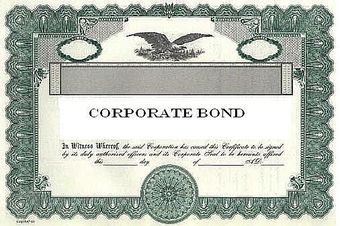
Bond
Preferred Stocks are considered a hybrid security with properties of both stocks and bonds, but are subordinate to bonds when it comes to rights of claim to company assets.
Preferred stock usually carries no voting rights, but may carry a dividend and may have priority over common stock in the payment of dividends and upon liquidation. The specific terms of owning preferred stock are specified in a certificate of designation. The features and rights which are generally associated with preferred stock are as follows:
- Preference in dividends
- Preference in assets in the event of liquidation
- Convertibility to common stock
- Callability, at the option of the corporation
- Nonvoting rights.
Similar to bonds, preferred stocks are rated by the major credit-rating companies. The rating for preferreds is generally lower, since preferred dividends do not carry the same guarantees as interest payments from bonds, and they are junior to all creditors.
Details with regards to the rights associated with preferred stock will vary with the business entity that issues the shares, and preferred stock can come in a number of different classes. Some examples are prior preferred stock (highest priority), preference preferred stock, convertible preferred stock (exchangeable for common stock), cumulative preferred stock, exchangeable preferred stock, participating preferred stock, putable preferred stock, monthly income preferred stock, and non-cumulative preferred stock.
7.3: Rules and Rights of Common and Preferred Stock
7.3.1: Claim to Income
In the cases of bankruptcy and dividend distribution, preferred stock shareholders will receive assets before common stock shareholders.
Learning Objective
Describe the rights preferred stock has to a company’s income
Key Points
- Common stock and preferred stock are both forms of equity ownership but carry different rights and claims to income.
- Preferred stock shareholders will have claim to assets over common stock shareholders in the case of company liquidation.
- Preferred stock also has first right to dividends.
Key Terms
- Common stock
-
Common stock is a form of equity and type of security. Common stock shareholders are at the bottom of the line when it comes to dividends and receiving compensation in the case of bankruptcy.
- Preferred Stock
-
Preferred stock is an equity security that has the properties of both an equity and debt instrument and is higher ranking than common stock.
Preferred and common stock have varying claims to income which will change from one equity issuer to another. In general, preferred stock will be given some preference in assets to common assets in the case of company liquidation, but both will fall behind bondholders when asset distribution takes place. In the event of bankruptcy, common stock investors receive any remaining funds after bondholders, creditors (including employees), and preferred stock holders are paid. As such, these investors often receive nothing after a bankruptcy. Preferred stock also has the first right to receive dividends. In general, common stock shareholders will not receive dividends until it is paid out to preferred shareholders. Access to dividends and other rights vary from firm to firm.

1903 stock certificate of the Baltimore and Ohio Railroad
Preferred and common stock both carry rights of ownership, but represent different classes of equity ownership.
Preferred stock may or may not have a fixed liquidation value (or par value) associated with it. This represents the amount of capital that was contributed to the corporation when the shares were first issued. Preferred stock has a claim on liquidation proceeds of a stock corporation equal to its par (or liquidation) value, unless otherwise negotiated. This claim is senior to that of common stock, which has only a residual claim.
Both types of stock can have a claim to income in the form of capital appreciation as well. As company value increases based on market determinants, the value of equity held in this company also will increase. This translates to a return on investment to shareholders. This will be different to common stock shareholders and preferred stock shareholders because of the different prices and rewards based on holding these different kinds of shares. In turn, should market forces decrease, the value of equity held will decrease as well, reflecting a loss on investment and, therefore, a decrease on the value of any claims to income for shareholders.
7.3.2: Voting Right
Common stock generally carries voting rights, while preferred stock does not; however, this will vary from company to company.
Learning Objective
Summarize the voting rights associated with common and preferred stock
Key Points
- Common stock shareholders can generally vote on issues, such as members of the board of directors, stock splits, and the establishment of corporate objectives and policy.
- While having superior rights to dividends and assets over common stock, generally preferred stock does not carry voting rights.
- Many of the voting rights of a shareholder can be exercised at annual general body meetings of companies. An annual general meeting is a meeting that official bodies, and associations involving the general public, are often required by law to hold.
Key Terms
- Voting rights
-
Rights which are generally associated with common stock shareholders in regards to business entity matters ( such as electing the board of directors or establishing corporate policy)
- Preferred Stock
-
Preferred stock is an equity security that has the properties of both an equity and debt instrument and is higher ranking than common stock.
- Common stock
-
Common stock is a form of equity and type of security. Common stock shareholders are at the bottom of the line when it comes to dividends and receiving compensation in the case of bankruptcy.
Voting Rights
Common stock can also be referred to as a “voting share. ” Common stock usually carries with it the right to vote on business entity matters, such as electing the board of directors, establishing corporate objectives and policy, and stock splits. However, common stock can be broken into voting and non-voting classes. While having superior rights to dividends and assets over common stock, generally preferred stock does not carry voting rights.
The matters that a stockholder gets to vote on vary from company to company. In many cases, the shareholder will be able to vote for members of a company board of directors and, in general, each share gets a vote as opposed to each shareholder. Therefore, a single investor who owns 300 shares will have more say in a voting matter than a single shareholder that owns 30.
Exercising Voting Rights
Many of the voting rights of a shareholder can be exercised at annual general body meetings of companies. An annual general meeting is a meeting that official bodies and associations involving the general public (including companies with shareholders) are often required by law (or the constitution, charter, by-laws, etc., governing the body) to hold. An AGM is held every year to elect the board of directors and inform their members of previous and future activities. It is an opportunity for the shareholders and partners to receive copies of the company’s accounts, as well as reviewing fiscal information for the past year and asking any questions regarding the directions the business will take in the future. Shareholders also have the option to mail their votes in if they cannot attend the shareholder meetings. In 2007, the Securities and Exchange Commission voted to require all public companies to make their annual meeting materials available online. Shareholders with the right to vote will have numerous options in how to make their voice heard with regards to voting matters should they choose to.

Shareholder Meeting
This scene from “The Office” humorously illustrates a shareholder meeting, where the shareholder can exercise their right to vote on company issues or question company directors.
7.3.3: Purchasing New Shares
New shares can be purchased on exchanges and current shareholders will usually have preemptive rights to newly issued shares.
Learning Objective
Discuss the process and implication of purchasing new shares by a shareholder that already holds shares in a company
Key Points
- New share purchase is an important indicator of current shareholder belief in the health of the company and long term prospects for growth.
- Current Shareholders will often have preemptive rights that give them the right to purchase newly issued company shares before they go on sale to the general public.
- New shares can be purchased on exchanges, which offer a platform for the financial marketplace.
Key Terms
- Stock Exchange
-
A form of exchange that provides services for stock brokers and traders to trade stocks, bonds and other securities.
- Preemption
-
The right of a shareholder to purchase newly issued shares of a business entity before they are available to the general public so as to protect individual ownership from dilution.
New share purchases are an important action by share shareholders, since it requires a further investment in a business entity and is a reflection of a shareholder’s decision to maintain an ownership position in a company, or a potential investor’s belief that purchasing equity in a company will be an investment that grows in value.
Current shareholders may have preemptive rights over new shares offered by the company. In practice, the most common form of preemption right is the right of existing shareholders to acquire new shares issued by a company in a rights issue, a usually but not always public offering. In this context, the pre-emptive right is also called “subscription right” or “subscription privilege. ” This is the right, but not the obligation, of existing shareholders to buy the new shares before they are offered to the public. In this way, existing shareholders can maintain their proportional ownership of the company, preventing stock dilution.
New shares may be purchased over the same exchange mechanisms that previous stock was acquired. A stock exchange is a form of exchange which provides services for stock brokers and traders to trade stocks, bonds, and other securities. Stock exchanges also provide facilities for issue and redemption of securities and other financial instruments, and capital events, including the payment of income and dividends. The initial offering of stocks and bonds to investors is by definition done in the primary market and subsequent trading is done in the secondary market. A stock exchange is often the most important component of a stock market. Supply and demand in stock markets are driven by various factors that, as in all free markets, affect the price of stocks.

Exchanges
New shares can be traded on exchanges such as the Nasdaq, but will usually be offered to current shareholders before being put on sale to the general public.
7.3.4: Preferred Stock Rules and Rights
Preferred stock can include rights such as preemption, convertibility, callability, and dividend and liquidation preference.
Learning Objective
List the rights that preferred stock generally has
Key Points
- Preferred stock generally does not carry voting rights, but this may vary from company to company.
- Preferred stock can gain cumulative dividends, convertibility to common stock, and callability.
- The rights that come with ownership of preferred stock are detailed in a “Certificate of Designation”.
Key Terms
- liquidation
-
liquidation is the process by which a company (or part of a company) is brought to an end, and the assets and property of the company redistributed
- Preferred Stock
-
Preferred stock is an equity security that has the properties of both an equity and debt instrument and is higher ranking than common stock.
Preferred stock usually carries no voting rights, but may carry a dividend and may have priority over common stock in the payment of dividends and upon liquidation. Terms of the preferred stock are stated in a “Certificate of Designation. “

VOC stock
Preferred stock is a security ( a little more modern that this stock from the VOC or Dutch East India Company) that carries certain rights which designate it from common stock or debt.
Preferred stock is a special class of shares that may have any combination of features not possessed by common stock. The following features are usually associated with preferred stock: Preference in dividends preference in assets, in the event of liquidation, convertibility to common stock, callability, and at the option of the corporation. Some preferred shares have special voting rights to approve extraordinary events (such as the issuance of new shares or approval of the acquisition of a company) or to elect directors, but, once again, most preferred shares have no voting rights associated with them. Some preferred shares gain voting rights when the preferred dividends are in arrears for a substantial time.
Preferred stock may or may not have a fixed liquidation value (or par value) associated with it. This represents the amount of capital which was contributed to the corporation when the shares were first issued. Preferred stock has a claim on liquidation proceeds of a stock corporation equal to its par (or liquidation) value, unless otherwise negotiated. This claim is senior to that of common stock, which has only a residual claim.Almost all preferred shares have a negotiated, fixed-dividend amount. The dividend is usually specified as a percentage of the par value, or as a fixed amount. Sometimes, dividends on preferred shares may be negotiated as floating; they may change according to a benchmark interest-rate index. Preferred stock may also have rights to cumulative dividends.
7.3.5: Provisions of Preferred Stock
Preferred shares have numerous rights which can be attached to them, such as cumulative dividends, convertibility, and participation.
Learning Objective
Describe in detail the different types of provisions for preferred stock
Key Points
- If a preferred share has cumulative dividends, then it contains the provision that should a company fail to pay out dividends at any time at the stated rate, then the issuer will have to make up for it as time goes on.
- Convertible preferred stock can be exchanged for a predetermined number of company common stock shares.
- Often times companies will keep the right to call or buy back preferred shares at a predetermined price.
- Participating preferred issues offer holders the opportunity to receive extra dividends if the company achieves predetermined financial goals.
- Sometimes, dividends on preferred shares may be negotiated as floating; they may change according to a benchmark interest-rate index.
Key Terms
- Callable shares
-
Shares which can be bought back by the issuer at a predetermined price.
- Convertible preferred stock
-
Convertible preferred stock can be exchanged for a predetermined number of company common stock shares.
- Cumulative Dividends
-
Condition where owners of certain shares will receive accumulated dividends in the case a company cannot pay out dividends at the stated rate at the stated time.
Preferred stock may be entitled to numerous rights, depending on what is designated by the issuer. One of these rights may be the right to cumulative dividends. Preferred stock shareholders already have rights to dividends before common stock shareholders, but cumulative preferred shares contain the provision that should a company fail to pay out dividends at any time at the stated rate, then the issuer will have to make up for it as time goes on.

Historical dividend information for Franklin Automobile Company
Dividends are one of the privileges of stock ownership, and preferred shares get more rights to them than common shares do.
Convertible preferred stock can be exchanged for a predetermined number of company common stock shares. Generally, this can occur at the discretion of the investor, and he or she may pick any time to do so and, therefore, take advantage of fluctuations in the price of common stock. Once converted, the common stock cannot be converted back to preferred status.
Often times companies will keep the right to call or buy back preferred shares at a predetermined price. These shares are callable shares.
There is a class of preferred shares known as “participating preferred stock. ” These preferred issues offer holders the opportunity to receive extra dividends if the company achieves predetermined financial goals. Investors who purchased these stocks receive their regular dividend regardless of company performance (assuming the company does well enough to make its annual dividend payments). If the company achieves predetermined sales, earnings, or profitability goals, the investors receive an additional dividend.
Almost all preferred shares have a negotiated, fixed-dividend amount. The dividend is usually specified as a percentage of the par value, or as a fixed amount. Sometimes, dividends on preferred shares may be negotiated as floating; they may change according to a benchmark interest-rate index or floating rate. An example of this would be tying the dividend rate to LIBOR.
7.3.6: Comparing Common Stock, Preferred Stock, and Debt
Common stock, preferred stock, and debt are all securities that a company may offer; each of these securities carries different rights.
Learning Objective
Differentiate between the rights of common shareholders, preferred shareholders, and bond holders
Key Points
- Common stock and preferred stock fall behind debt holders as creditors that would receive assets in the case of company liquidation.
- Common stock and preferred stock are both types of equity ownership. They receive rights of ownership in the company, such as voting and dividends.
- Debt holders often receive a bond for lending and while this does not give the ownership rights of being a stockholder, it does create a superior claim to a company’s assets in the case of liquidation.
Key Terms
- Common stock
-
Common stock is a form of corporate equity ownership, a type of security.
- bond
-
A bond is an instrument of indebtness of the bond issuers toward the bond holders.
- Preferred Stock
-
Preferred stock is an equity security that has the properties of both an equity and debt instrument and is higher ranking than common stock.
Equity
Common Stock and Preferred Stock are both methods of purchasing equity in a business entity.
Common stock generally carries voting rights along with it, while preferred shares generally do not.
Preferred shares act like a hybrid security, in between common stock and holding debt. Preferred stock can (depending on the issue) be converted to common stock and have access to accumulated dividends and multiple other rights. Preferred stock also has access to dividends and assets in the case of liquidation before common stock does.
However, both common and preferred stock fall behind debt holders when it comes to claims to assets of a business entity should bankruptcy occur. Common shareholders often do not receive any assets after bankruptcy as a result of this principle. However, common stock shareholders can theoretically use their votes to affect company decision making and direction in a way they believe will help the company avoid liquidation in the first place.
Debt
Debt can be “purchased” from a company in the form of a bond.

A bond from the Dutch East India Company
A bond is a financial security that represents a promise by a company or government to repay a certain amount, with interest, to the bondholder.
In finance, a bond is an instrument of indebtedness of the bond issuer to the holders. It is a debt security, under which the issuer owes the holders a debt and, depending on the terms of the bond, is obliged to pay them interest and/or to repay the principal at a later date, termed the maturity. Therefore, a bond is a form of loan or IOU: the holder of the bond is the lender (creditor), the issuer of the bond is the borrower (debtor), and the coupon is the interest. Bonds provide the borrower with external funds to finance long-term investments, or, in the case of government bonds, to finance current expenditure.
Bonds and stocks are both securities, but the major difference between the two is that (capital) stockholders have an equity stake in the company (i.e., they are owners), whereas, bondholders have a creditor stake in the company (i.e., they are lenders). Another difference is that bonds usually have a defined term, or maturity, after which the bond is redeemed, whereas stocks may be outstanding indefinitely.
7.4: Stock Markets
7.4.1: Market Actors
Market actors include individual retail investors, mutual funds, banks, insurance companies, hedge funds, and corporations.
Learning Objective
Identify the different actors that participate in a stock market
Key Points
- Pension funds are important shareholders of listed and private companies.
- Insurance companies are generally classified as either mutual or proprietary companies.
- A mutual fund is a type of professionally-managed collective investment vehicle that pools money from many investors to purchase securities.
- An index fund or index tracker is a collective investment scheme (usually a mutual fund or exchange-traded fund) that aims to replicate the movements of an index of a specific financial market, or a set of rules of ownership that are held constant, regardless of market conditions.
- An exchange-traded fund (ETF) is an investment fund traded on stock exchanges, much like stocks.
- A hedge fund is an fund that can undertake a wider range of investment and trading activities than other funds. It is generally only open to certain types of investors specified by regulators.
Key Terms
- open-end
-
An open-end(ed) fund is a collective investment scheme which can issue and redeem shares at any time.
- closed-end
-
Closed-end funds (or closed-ended funds) are mutual funds with a fixed number of shares (or units). Unlike open-end funds, new shares/units are not created by managers, to meet demand from investors, but the shares can only be purchased (and sold) in the market.
The individual actors in the financial markets can be broken down into three main categories: investors, intermediaries, and issuers. Specifically, market actors include individual retail investors, institutional investors such as mutual funds, banks, insurance companies and hedge funds, and also publicly traded corporations trading in their own shares. The value of a stock is derived from buying and selling decisions of these actors. Some studies have suggested that institutional investors and corporations trading in their own shares generally receive higher risk-adjusted returns than retail investors .

Stock Market
Different kinds of investors are active in stock market.
Investors
An investor is someone who allocates capital with the expectation of a financial return. The types of investments include, — equity, debt securities, real estate, currency, commodity, derivatives such as put and call options, etc. A few decades ago, worldwide, buyers and sellers were individual investors, such as wealthy businessmen, usually with long family histories to particular corporations. Over time, markets have become more “institutionalized. ” Buyers and sellers are largely institutions. Investors can include: pension funds, insurance companies, mutual funds, index funds, exchange-traded funds, and hedge funds.
Issuers
The issuer is a legal entity that develops, registers, and sells securities for the purpose of financing its operations. Issuers may be domestic or foreign governments, corporations, or investment trusts.
Intermediaries
Financial institutions (intermediaries) perform the vital role of bringing together those economic agents with surplus funds who want to lend, with those with a shortage of funds who want to borrow. The classic example of a financial intermediary is a bank that consolidates bank deposits and uses the funds to transform them into bank loans. Other classes of intermediaries include: credit unions, financial advisers or brokers, collective investment schemes, and pension funds.
Pension funds
A pension fund is any plan, fund, or scheme that provides retirement income.
Pension funds are important shareholders of listed and private companies. They are especially important to the stock market where large institutional investors dominate. The largest 300 pension funds collectively hold about $6 trillion in assets. In January 2008, The Economist reported that Morgan Stanley estimates that pension funds worldwide hold over $20 trillion in assets, the largest for any category of investor ahead of mutual funds, insurance companies, currency reserves, sovereign wealth funds, hedge funds, or private equity.
Insurance companies
Insurance companies are generally classified as either mutual or proprietary companies. Mutual companies are owned by the policyholders, while shareholders (who may or may not own policies) own proprietary insurance companies.
Mutual funds
A mutual fund is a type of professionally-managed collective investment vehicle that pools money from many investors to purchase securities. While there is no legal definition of mutual fund, the term is most commonly applied only to those collective investment vehicles that are regulated, available to the general public, and open-ended in nature. Hedge funds are not considered a type of mutual fund.
There are three types of U.S. mutual funds: open-end, unit investment trust, and closed-end. The most common type, the open-end mutual fund, must be willing to buy back its shares from its investors at the end of every business day. Exchange-traded funds are open-end funds or unit investment trusts that trade on an exchange. Open-end funds are most common, but exchange-traded funds have been gaining in popularity.
Index fund
An index fund or index tracker is a collective investment scheme (usually a mutual fund or exchange-traded fund) that aims to replicate the movements of an index of a specific financial market, or a set of rules of ownership that are held constant, regardless of market conditions. As of 2007, index funds made up over 11% of equity mutual fund assets in the United States.
Exchange-traded fund (ETF)
An exchange-traded fund (ETF) is an investment fund traded on stock exchanges, much like stocks. An ETF holds assets such as stocks, commodities, or bonds, and trades close to its net asset value over the course of the trading day. Most ETFs track an index, such as a stock index or bond index. ETFs may be attractive as investments because of their low costs, tax efficiency, and stock-like features. ETFs are the most popular type of exchange-traded product.
Hedge fund
A hedge fund is an fund that can undertake a wider range of investment and trading activities than other funds. It is generally only open to certain types of investors specified by regulators. These investors are typically institutions, such as pension funds, university endowments and foundations, or high-net-worth individuals, who are considered to have the knowledge or resources to understand the nature of the funds. As a class, hedge funds invest in a diverse range of assets, but they most commonly trade liquid securities on public markets. They also employ a wide variety of investment strategies, and make use of techniques such as short selling and leverage.
7.4.2: NYSE
The New York Stock Exchange is the world’s largest stock exchange by market capitalization at $14.242 trillion as of December 2011.
Learning Objective
Distinguish the New York Stock Exchange from other stock exchanges
Key Points
- The origin of the NYSE can be traced to May 17, 1792, when the Buttonwood Agreement was signed by 24 stockbrokers outside of 68 Wall Street in New York under a buttonwood tree on Wall Street.
- The New York Stock Exchange (sometimes referred to as “the Big Board”) provides a means for buyers and sellers to trade shares of stock in companies registered for public trading.
- The New York Stock Exchange is open for trading Monday through Friday from 9:30 am to 4:00 pm ET, with the exception of holidays declared by the NYSE in advance.
- Traders can gather around the appropriate post. There, a specialist broker acts as an auctioneer in an open outcry auction market environment to bring buyers and sellers together and to manage the actual auction.
- To be listed on the New York Stock Exchange, a company must have issued at least a million shares of stock worth $100 million and must have earned more than $10 million over the last three years.
Key Terms
- Dutch auction
-
an event to buy or sell that starts at a high price that is gradually reduced by the auctioneer until someone is willing to buy
- secondary market
-
The financial market in which previously issued financial instruments such as stock, bonds, options, and futures are bought and sold.
- NASDAQ
-
The National Association of Securities Dealers Automated Quotations; this is an electronic stock market.
New York Stock Exchange
The New York Stock Exchange, commonly referred to as the NYSE, is a stock exchange, or a secondary market. With primary issuances of securities or financial instruments, or the primary market, investors purchase these securities directly from issuers such as corporations issuing shares in an IPO or private placement, or directly from the federal government in the case of treasuries.
After the initial issuance, investors can purchase from other investors in secondary markets like the NYSE. If an investor wished to buy a stock from Apple, for example, the actual company is not directly involved. Secondary markets can be further subdivided into auction or dealer markets, typified by the mode of transactions. The NYSE is an auction market. Buyers and sellers meet at a physical location (in this case, Wall Street) and announce their bid or ask prices.
At the NYSE, traders gather around a specialist broker, who acts as an auctioneer in an open outcry auction market environment to bring buyers and sellers together and to manage the actual auction. The auction market format aims to bring together the parties with mutually agreeing prices in an efficient manner. The auction process moved toward automation in 1995 through the use of wireless hand held computers (HHC). The system enabled traders to receive and execute orders electronically via wireless transmission .

NYSE Trading Floor
Buyers and sellers meet and engage in face-to-face transactions at the NYSE, which is an auction-style secondary market.
The NYSE is by far the world’s largest stock exchange by market capitalization of its listed companies at $14.242 trillion as of December 2011, and most of the largest US companies are listed on the NYSE. The NYSE’s biggest competitor is NASDAQ; both are major secondary markets vying for large and profitable companies to list on their exchange.
Secondary markets like the NYSE serve a vital function as a setting where companies can raise capital for expansion through selling shares to the investing public. They also gain advertising and a boost in prestige, which likely increases their stock value. To be able to trade a security on the NYSE, it must be listed. To be listed on the New York Stock Exchange, a company must have issued at least a million shares of stock worth $100 million and must have earned more than $10 million over the last three years. They must also disclose certain information to the exchange, providing a measure of transparency that prevents insider manipulation of the stock prices.
7.4.3: NASDAQ
The NASDAQ is an American dealer-based stock market in which the dealers sell electronically to investors or firms.
Learning Objective
Distinguish the NASDAQ from other stock exchanges
Key Points
- NASDAQ was founded in 1971 by the National Association of Securities Dealers (NASD), who divested themselves of it in a series of sales in 2000 and 2001.
- NASDAQ quotes are available at three levels: Level 1 shows the highest bid and lowest offer; Level 2 shows all public quotes of market makers; Level 3 is used by the market makers and allows them to enter their quotes and execute orders.
- NASDAQ has a pre-market session from 7:00am to 9:30am, a normal trading session from 9:30am to 4:00pm, and a post-market session from 4:00pm to 8:00pm (all times in ET).
- Three market tiers are NASDAQ Capital Market – Small Cap, NASDAQ Global Market – Mid Cap, NASDAQ Global Select Market – Large Cap.
Key Term
- FINRA
-
In the United States, the Financial Industry Regulatory Authority, Inc., or FINRA, is a private corporation that acts as a self-regulatory organization (SRO). FINRA is the successor to the National Association of Securities Dealers, Inc. (NASD). Though sometimes mistaken for a government agency, it is a non-governmental organization that performs financial regulation of member brokerage firms and exchange markets. The government organization which acts as the ultimate regulator of the securities industry, including FINRA, is the Securities and Exchange Commission.
NASDAQ Stock Market
The NASDAQ Stock Market, also known simply as the NASDAQ, is an American stock exchange. “NASDAQ” originally stood for “National Association of Securities Dealers Automated Quotations. ” It is one of the largest stock exchanges in the world along with the New York Stock Exchange.

NASDAQ
NASDAQ is the second-largest stock exchange market in the world, as of 2012.
The NASDAQ is a dealer-based market in which stock dealers sell directly to investors or firms electronically via phone or Internet. The New York Stock Exchange conducts its trading in person.
History
NASDAQ was founded in 1971 by the National Association of Securities Dealers (NASD), who divested themselves of it in a series of sales in 2000 and 2001. It is owned and operated by the NASDAQ OMX Group and regulated by the Financial Industry Regulatory Authority (FINRA), the successor to the NASD.
When the NASDAQ stock exchange began trading on February 8, 1971, it was the world’s first electronic stock market. At first, it was merely a computer bulletin board system and did not actually connect buyers and sellers. The NASDAQ helped lower the spread (the difference between the bid price and the ask price of the stock), but paradoxically was unpopular among brokerages because they made much of their money on the spread.
Firms including Microsoft began doing business through NASDAQ early in their history, and remained with this exchange as the technology industry boomed. NASDAQ became known for its concentration of tech and high-growth firms, making it the primary tech market and an indicator for industry trends.
Indices
A stock index or stock market index is a method of measuring the value of a section of the stock market. It is computed from the prices of selected stocks, which vary depending on the index. Investors and financial managers can use it as a “snapshot” to describe the market conditions, and also as a tool to compare the return on specific investments. NASDAQ’s major indices include:
- NASDAQ-100
- NASDAQ Bank
- NASDAQ Biotechnology Index
- NASDAQ Transportation Index
- NASDAQ Composite
The NASDAQ Composite is often referred to as the NASDAQ. It is calculated from weighting common stocks and similar securities listed on the NASDAQ stock market. Thus “NASDAQ” can mean two things: either the stock exchange itself, or the index.
7.4.4: Market Reporting
Market indices provide valuable information for stock valuation.
Learning Objective
Explain how a market index works and its purpose
Key Points
- The is a tool used by investors and financial managers to describe the market and to compare the return on specific investments.
- An index is a mathematical construct, so it may not be invested in directly.
- A ‘world’ or ‘global’ stock market index includes (typically large) companies without regard for where they are domiciled or traded.
- A ‘national’ index represents the performance of the stock market of a given nation—and by proxy, reflects investor sentiment on the state of its economy.
- Stock market indices provide invaluable information for investors and accountants.
Key Terms
- market capitalization
-
The total market value of the equity in a publicly traded entity.
- weighted average
-
An arithmetic mean of values biased according to agreed weightings.
- Common stock
-
Shares of an ownership interest in the equity of a corporation or other entity with limited liability. Holders of this type of stock are entitled to dividends. Importantly, the financial rights for holders of this type of stock are junior to preferred stock and liabilities.
Market Reporting
A stock index or stock market index is a method of measuring the value of a section of the stock market. It is computed from the prices of selected stocks (sometimes a weighted average). It is a tool used by investors and financial managers to describe the market and to compare the return on specific investments.
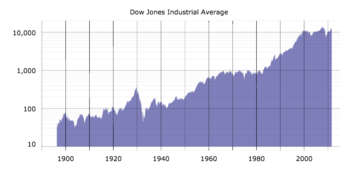
Historical Graph of the Dow Jones Industrial Average
This graph shows the general increase in the DJIA over the last century. Particularly notable is the growth from around 1,000 points in the late 1980s to around 10,000 points in 2005.
An index is a mathematical construct, so it may not be invested in directly. Many mutual funds and exchange-traded funds attempt to “track” an index. The funds that do may not be judged against those that do.
Stock market indices may be classed in many ways. A ‘world’ or ‘global’ stock market index includes (typically large) companies without regard for where they are domiciled or traded. Two examples are MSCI World and S&P Global 100.
A ‘national’ index represents the performance of the stock market of a given nation—and by proxy, reflects investor sentiment on the state of its economy. The most regularly quoted market indices are national indices composed of the stocks of large companies listed on a nation’s largest stock exchanges, such as the American S&P 500, the Japanese Nikkei 225, the Brazilian Ibovespa, the Russian RTSI, the Indian SENSEX, and the British FTSE 100.
Stock market indices provide invaluable information for investors and accountants. For example, the current market price per share, market capitalization, and trading volume are all readily available. With this information, along with a company’s consolidated financial statements, the following ratios and calculations can be performed:
- Dividend yield on common stock ratio=Dividend per share of common stock
- Payout ratio on common stock = Dividend per share of common stock
- Earnings per share (EPS)
By comparing the above ratios with those of other companies, investors, accountants, and forecasters can determine the position and health of their respective company’s stock.
7.5: Stock Valuation
7.5.1: Expected Dividends, No Growth
A no-growth company would be expected to return high dividends under traditional finance theory.
Learning Objective
Describe how a company should make a dividend decision when it expect no growth
Key Points
- Companies generally either retain earnings for investment, or distribute them as dividend, according to their growth strategy.
- Clientele effects suggests that different dividend levels attract different types of investors.
- Value investors look for indications that a stock is undervalued. High dividends are one indication of undervaluation.
- Knowing a firm’s cost of capital is needed in order to make better decisions. Managers make capital budgeting decisions while capital providers make decisions about lending and investment.
Key Term
- clientele
-
The body or class of people who frequent an establishment or purchase a service, especially when considered as forming a more-or-less homogeneous group of clients in terms of values or habits.
The Dividend Decision
Whether to issue dividends and what amount is calculated mainly on the basis of the company’s unappropriated profit and its earning prospects for the coming year. The amount is also often calculated based on expected free cash flows, which means cash remaining after all business expenses, and capital investment needs have been met.
If there are no favorable investment opportunities–projects where return exceed the hurdle rate–finance theory suggests that management will return excess cash to shareholders as dividends. However, there are exceptions. For example, shareholders of a “growth stock,” expect that the company will, almost by definition, retain earnings so as to fund growth internally.
At the other end of the spectrum, investors of a “no growth,” or value stock will expect the firm to retain little cash for investment, and to distribute a comparatively greater proportion to investors as a dividend.
Clientele Effects
This suggests that a particular pattern of dividend payments may suit one type of stock holder more than another; this is sometimes called the “clientele effect. ” A retiree may prefer to invest in a firm that provides a consistently high dividend yield, whereas a person with a high income from employment may prefer to avoid dividends due to their high marginal tax rate on income. If clienteles exist for particular patterns of dividend payments, a firm may be able to maximize its stock price and minimize its cost of capital by catering to a particular clientele. This model may help to explain the relatively consistent dividend policies followed by mostlisted companies.
Value Investors
No growth, high dividend stocks may appeal to value investors. Value investing involves buying securities with shares that appear underpriced by some form of fundamental analysis. As examples, such securities may be stock in public companies that have high dividend yields, low price-to-earning multiples, or have low price-to-book ratios. Thus, high dividends and low reinvestment of retained earnings can signal an appealing value stock to an investor.

Investing trade-offs
Value investors trade growth for dividends.
7.5.2: Expected Dividends and Constant Growth
Valuations rely heavily on the expected growth rate of a company; past growth rate of sales and income provide insight into future growth.
Learning Objective
Calculate a company’s stock price using the Constant Growth Approximation
Key Points
- Companies are constantly changing, as well as the economy. Solely using historical growth rates to predict the future is not an acceptable form of valuation. Calculating the future growth rate requires personal investment research.
- A generalized version of the Walter model (1956), SPM considers the effects of dividends, earnings growth, as well as the risk profile of a firm on a stock’s value.
- The Gordon model or Gordon’s growth model is the best known of a class of discounted dividend models. It assumes that dividends will increase at a constant growth rate (less than the discount rate) forever.
Key Term
- Gordon Growth Model
-
Gordon Growth Model is also called the dividend discount model (DDM), which is a way of valuing a company based on the theory that a stock is worth the discounted sum of all of its future dividend payments.
Growth Rate
Valuations rely very heavily on the expected growth rate of a company. One must look at the historical growth rate of both sales and income to get a feeling for the type of future growth expected. However, companies are constantly changing, as well as the economy, so solely using historical growth rates to predict the future is not an acceptable form of valuation. Instead, they are used as guidelines for what future growth could look like if similar circumstances are encountered by the company. Calculating the future growth rate requires personal investment research. This may take form in listening to the company’s quarterly conference call or reading a press release or other another company article that discusses the company’s growth guidance. However, although companies are in the best position to forecast their own growth, they are far from accurate. Unforeseen events could cause rapid changes in the economy and in the company’s industry.
And for any valuation technique, it’s important to look at a range of forecast values.
- For example, if the company being valued has been growing earnings between 5 and 10% each year for the last five years, but believes that it will grow 15 – 20% this year, a more conservative growth rate of 10 – 15% would be appropriate in valuations.
- Another example would be for a company that has been going through restructuring. They may have been growing earnings at 10 – 15% over the past several quarters / years because of cost cutting, but their sales growth could be only 0 – 5%. This would signal that their earnings growth will probably slow when the cost cutting has fully taken effect. Therefore, forecasting an earnings growth closer to the 0 – 5% rate would be more appropriate rather than the 15 – 20%. Nonetheless, the growth rate method of valuations relies heavily on gut feel to make a forecast. This is why analysts often make inaccurate forecasts. It is also why familiarity with a company is essential before making a forecast.
Sum of Perpetuities Method
The PEG ratio is a special case in the Sum of Perpetuities Method (SPM) equation. A generalized version of the Walter model (1956), SPM considers the effects of dividends, earnings growth, as well as the risk profile of a firm on a stock’s value. Derived from the compound interest formula using the present value of a perpetuity equation, SPM is an alternative to the Gordon Growth Model. The variables are:
- P is the value of the stock or business
- E is a company’s earnings
- G is the company’s constant growth rate
- K is the company’s risk adjusted discount rate
- D is the company’s dividend payment
Constant Growth Approximation
The Gordon model or Gordon’s growth model is the best known of a class of discounted dividend models . It assumes that dividends will increase at a constant growth rate (less than the discount rate) forever. The valuation is given by the formula:

Your Dividend
DDM can be used to calculate a constant growth company.
7.5.3: Relationship Between Dividend Payments and the Growth Rate
The portion of the earnings not paid to investors is, ideally, left for investment in order to provide for future earnings growth.
Learning Objective
Describe the relationship between dividend payments and a company’s growth
Key Points
- Investors take into account how much capital is distributed to investors, and conversely how much capital is kept from investors.
- Investors hope that firms will use retained earnings to either maximize their current operations or invest in such as a way as to lead to higher profits.
- Some firms are unable to distribute earnings, since their funds are tied up in maintenance, repairs, et cetera.
- On the other hand, some companies can retain earnings and put that money back to work – i.e., invest in growth opportunities.
Key Term
- capital gains
-
Profit that results from a disposition of a capital asset, such as stock, bond, or real estate due to arbitrage.
From an investor’s point of view, the fundamentals of a company are of the utmost importance. One such fundamental that that investors take into account is how much capital is distributed to investors, and conversely how much capital is kept from investors. Capital is distributed to investors via dividend payments and, indirectly, through capital gains. Capital that is kept from investors is known as retained earnings. Investors hope that firms will use retained earnings to either maximize their current operations or invest in such as a way as to lead to higher profits. In other words, the portion of profits not paid out to investors via dividends is, ideally, left for investment in order to provide for future earnings growth.
Some companies require large amounts of new capital just to continue operations. Such firms are usually unable to distribute earnings, since their funds are tied up in maintenance, repairs, et cetera. These companies also provide limited growth opportunities, since earnings are not reinvested for the purpose of growth. On the other hand, some companies can retain earnings and put that money back to work – i.e., invest in growth opportunities. Firms that can do this tend to retain more of their earnings. These firms are attractive to investors, even though there is relatively low distribution of profits.
Put succinctly, investors seeking high current income and limited capital growth prefer companies with a high dividend payout ratio. However, investors seeking higher capital growth may prefer a lower payout ratio because capital gains are taxed at a lower rate. High growth firms in early life generally have low or zero payout ratios in order to reinvest as much of their earnings as possible. As they mature, they tend to return more of the earnings back to investors. Note that dividend payout ratio is calculated as dividend per share divided by earnings per share.
7.5.4: Understanding Future Stock Value
There are many different ways to appraise the future value of stocks, including fundamental criteria and stock valuation methods.
Learning Objective
Describe different ways of valuing stock
Key Points
- Earnings Per Share is the total net income of the company divided by the number of shares outstanding; the Profits/Earnings ratio is the stock price divided by the annual EPS figure.
- Return on Invested Capital measures how much money the company makes each year per dollar of invested capital and approximates the expected level of growth; Return on Assets measures the company’s ability to make money from its assets.
- To measure Market Capitalization (the value of all of a company’s stock), multiply the current stock price by the fully diluted shares outstanding; Enterprise Value is equal to the total value the company is trading for on the stock market.
- Enterprise Value (EV) to earnings before interest, taxes, depreciation and amortization (EBITDA) is one of the best measurements of whether or not a company should be valued as cheap or expensive.
Key Terms
- GAAP
-
Generally Accepted Accounting Principles refer to the standard framework of guidelines, conventions, and rules accountants are expected to follow in recording, summarizing, and preparing financial statements in any given jurisdiction.
- risk premium
-
A risk premium is the minimum amount of money by which the expected return on a risky asset must exceed the known return on a risk-free asset, or the expected return on a less risky asset, in order to induce an individual to hold the risky asset rather than the risk-free asset.
Example
- P/E Ratio: For example, if the stock is trading at 10 and the EPS is 0.50, the P/E is 20 times. To get a good feeling of what P/E multiple a stock trades at, be sure to look at both the historical and forward ratios.
In financial markets, stock valuation involves calculating theoretical values of companies and their stocks. The main use of stock valuation is to predict future market prices and profit from price changes. Stocks that are judged as undervalued (with respect to their theoretical value) are bought, while stocks that are perceived to be overvalued are sold, in the expectation that undervalued stocks will, on the whole, rise, while overvalued stocks will, on the whole, fall .

Stock Valuation
Stock valuation involves many methods.
Fundamental Criteria (Fair Value)
The soundest stock valuation method, the discounted cash flow (DCF) method of income valuation, involves discounting the profits (dividends, earnings, or cash flows) the stock will bring to stockholders in the foreseeable future, and calculating a final value on disposal. The discounted rate normally includes a risk premium which is often based on the capital asset pricing model.
Stock Valuation Methods
There are many different ways to value stocks. The key is to take each approach into account while formulating an overall opinion of the stock. If the valuation of a company is lower or higher than other similar stocks, then the next step would be to determine the reasons for the discrepancy.
1. Earnings Per Share (EPS)
EPS is the total net income of the company divided by the number of shares outstanding. Numbers are usually reported as a GAAP EPS number (which means it is computed using mutually agreed upon accounting rules) and a Pro Forma EPS figure (income is adjusted to exclude any one time items as well as some non-cash items like amortization of goodwill or stock option expenses).
2. Price to Earnings (P/E)
Once one has several EPS figures (historical and forecasts), the most common valuation technique used by analysts is the price to earnings ratio, or P/E. To compute this figure, the stock price is divided by the annual EPS figure.
3. Price Earnings to Growth (PEG) Ratio
This valuation technique has become more popular over the past decade or so. It is better than just looking at a P/E because it takes three factors into account: the price, earnings, and earnings growth rates. To compute the PEG ratio, divide the Forward P/E by the expected earnings growth rate (historical P/E and historical growth rate are also used to see where the stock has traded in the past).
4. Return on Invested Capital (ROIC)
This valuation technique measures how much money the company makes each year per dollar of invested capital. Invested capital is the amount of money invested in the company by both stockholders and debtors. The ratio is expressed as a percent and Return on Invested Capital ratio should have a percent that approximates the expected level of growth. In its simplest definition, this ratio measures the investment return that management is able to get for its capital. The higher the number, the better the return.
5. Return on Assets (ROA)
Similar to ROIC, ROA, expressed as a percent, measures the company’s ability to make money from its assets. To measure the ROA, take the pro forma net income divided by the total assets. However, because of very common irregularities in balance sheets (due to things like goodwill, write-offs, discontinuations, etc. ) this ratio is not always a good indicator of the company’s potential. If the ratio is higher or lower than expected, be sure to look closely at the assets to see what could be overstating or understating the figure.
6. Price to Sales (P/S)
This figure is useful because it compares the current stock price to the annual sales. In other words, it tells you how much the stock costs per dollar of sales earned.
7. Market Cap
Market Cap, which is short for Market Capitalization, is the value of all of the company’s stock. To measure it, multiply the current stock price by the fully diluted shares outstanding.
8. Enterprise Value (EV)
Enterprise Value is equal to the total value of the company, as trading on the stock market. To compute it, add the Market Cap (see above) and the total net debt of the company.
9. EBITDA
EBITDA stands for earnings before interest, taxes, depreciation and amortization. It is one of the best measures of a company’s cash flow and is used for valuing both public and private companies.
10. EV to EBITDA
This is perhaps one of the best measurements of whether or not a company should be valued as cheap or expensive. To compute, divide the EV by EBITDA (see above for calculations). The higher the number, the more expensive the company is.
7.5.5: Valuing Nonconstant Growth Dividends
Limited high-growth approximation, implied growth models, and the imputed growth acceleration ratio are used to value nonconstant growth dividends.
Learning Objective
Describe the limitations of valuing a company with dividends that have a nonconstant growth rate
Key Points
- Limited high-growth approximation: When a stock has a significantly higher growth rate than its peers, it is sometimes assumed that the earnings growth rate will be sustained for a short time (say, 5 years), and then the growth rate will revert to the mean.
- Implied Growth Models: One can use the Gordon model or the limited high-growth period approximation model to impute an implied growth estimate.
- Imputed growth acceleration ratio: Subsequently, one can divide this imputed growth estimate by recent historical growth rates.
Key Terms
- DCF models
-
Valuation using discounted cash flows is a method for determining the current value of a company using future cash flows adjusted for time value. The future cash flow set is made up of the cash flows within the determined forecast period and a continuing value that represents the cash flow stream after the forecast period.
- break-even
-
Break-even (or break even) is the point of balance between making either a profit or a loss.
Limited high-growth period approximation
When a stock has a significantly higher growth rate than its peers, it is sometimes assumed that the earnings growth rate will be sustained for a short time (say, 5 years), and then the growth rate will revert to the mean. This is probably the most rigorous approximation that is practical.
While these DCF models are commonly used, the uncertainty in these values is hardly ever discussed. Note that the models diverge for and hence are extremely sensitive to the difference of dividend growth to discount factor. One might argue that an analyst can justify any value (and that would usually be one close to the current price supporting his call) by fine-tuning the growth/discount assumptions.
Implied Growth Models
One can use the Gordon model or the limited high-growth period approximation model to impute an implied growth estimate. To do this, one takes the average P/E and average growth for a comparison index, uses the current (or forward) P/E of the stock in question, and calculates what growth rate would be needed for the two valuation equations to be equal. This gives you an estimate of the “break-even” growth rate for the stock’s current P/E ratio. (Note: we are using earnings not dividends here because dividend policies vary and may be influenced by many factors including tax treatment).
Imputed growth acceleration ratio
Subsequently, one can divide this imputed growth estimate by recent historical growth rates. If the resulting ratio is greater than one, it implies that the stock would need to experience accelerated growth relative to its prior recent historical growth to justify its current P/E (higher values suggest potential overvaluation). If the resulting ratio is less than one, it implies that either the market expects growth to slow for this stock or that the stock could sustain its current P/E with lower than historical growth (lower values suggest potential undervaluation). Comparison of the IGAR across stocks in the same industry may give estimates of relative value. IGAR averages across an industry may give estimates of relative expected changes in industry growth (e.g. the market’s imputed expectation that an industry is about to “take-off” or stagnate). Naturally, any differences in IGAR between stocks in the same industry may be due to differences in fundamentals, and would require further specific analysis.
7.6: Valuing the Corporation
7.6.1: Valuing the Corporation
Three approaches are commonly used in corporation valuation: the income approach, the asset-based approach, and the market approach.
Learning Objective
Distinguish between the income, asset-based, and market approaches for corporate valuation
Key Points
- Income approaches include Discount or capitalization rates, Capital Asset Pricing Model (CAPM), Modified Capital Asset Pricing Model, and Weighted average cost of capital (“WACC”).
- The asset approach to business valuation is based on the principle of substitution: no rational investor will pay more for the business assets than the cost of procuring assets of similar economic utility.
- The market approach to business valuation is rooted in the economic principle of competition: in a free market the supply and demand forces will drive the price of business assets to a certain equilibrium.
Key Terms
- net asset value
-
Net asset value (NAV) is the value of an entity’s assets less the value of its liabilities, often in relation to open-end or mutual funds, since shares of such funds registered with the U.S.
- corporation
-
a group of individuals, created by law or under authority of law, having a continuous existence independent of the existences of its members, and powers and liabilities distinct from those of its members
- discounted cash flow
-
In finance, discounted cash flow (DCF) analysis is a method of valuing a project, company, or asset using the concepts of the time value of money. All future cash flows are estimated and discounted to give their present values (PVs)–the sum of all future cash flows, both incoming and outgoing, is the net present value (NPV), which is taken as the value or price of the cash flows in question.
Corporation valuation is a process and a set of procedures used to estimate the economic value of an owner’s interest in a business. Valuation is used by financial market participants to determine the price they are willing to pay or receive to perfect the sale of a business. In addition to estimating the selling price of a business, the same valuation tools are often used by business appraisers to resolve disputes related to estate and gift taxation, divorce litigation, allocate business purchase price among business assets, establish a formula for estimating the value of partners’ ownership interest for buy-sell agreements, and many other business and legal purposes.
Three different approaches are commonly used in business valuation: the income approach, the asset-based approach, and the market approach. Within each of these approaches, there are various techniques for determining the value of a business using the definition of value appropriate for the appraisal assignment. Generally, the income approach determines value by calculating the net present value of the benefit stream generated by the business (discounted cash flow); the asset-based approach determines value by adding the sum of the parts of the business (net asset value); and the market approach determines value by comparing the subject company to other companies in the same industry, of the same size, and/or within the same region.
1. Income approaches
- Discount or Capitalization Rates
A discount rate or capitalization rate is used to determine the present value of the expected returns of a business. The discount rate and capitalization rate are closely related to each other, but are distinguishable. Generally speaking, the discount rate or capitalization rate may be defined as the yield necessary to attract investors to a particular investment, given the risks associated with that investment.
- Capital Asset Pricing Model (CAPM)
The Capital Asset Pricing Model (CAPM) is one method of determining the appropriate discount rate in business valuations. The CAPM method originated from the Nobel Prize winning studies of Harry Markowitz, James Tobin, and William Sharpe. The CAPM method derives the discount rate by adding a risk premium to the risk-free rate. In this instance, however, the risk premium is derived by multiplying the equity risk premium times “beta,” which is a measure of stock price volatility. Beta is published by various sources for particular industries and companies. Beta is associated with the systematic risks of an investment.
- Modified Capital Asset Pricing Model
The Cost of Equity (Ke) is computed by using the Modified Capital Asset Pricing Model
CAPM Model ke = Rf + B ( Rm-Rf) + SCRP + CSRP Where: Rf = Risk free rate of return (Generally taken as 10-year Government Bond Yield) B = Beta Value (Sensitivity of the stock returns to market returns) Ke = Cost of Equity Rm= Market Rate of Return SCRP = Small Company Risk Premium, CSRP= Company specific Risk premium
- Weighted Average Cost of Capital (“WACC”)
The weighted average cost of capital is an approach used to determine a discount rate. The WACC method determines the subject company’s actual cost of capital by calculating the weighted average of the company’s cost of debt and cost of equity. The WACC must be applied to the subject company’s net cash flow to total invested capital.
2. Asset-Based Approaches
The value of asset-based analysis of a business is equal to the sum of its parts. That is the theory underlying the asset-based approaches to business valuation. The asset approach to business valuation is based on the principle of substitution: no rational investor will pay more for the business assets than the cost of procuring assets of similar economic utility. In contrast to the income-based approaches, which require the valuation professional to make subjective judgments about capitalization or discount rates, the adjusted net book value method is relatively objective.
3. Market Approaches
The market approach to business valuation is rooted in the economic principle of competition: that in a free market the supply and demand forces will drive the price of business assets to a certain equilibrium. Buyers would not pay more for the business, and the sellers will not accept less than the price of a comparable business enterprise. It is similar in many respects to the “comparable sales” method that is commonly used in real estate appraisal. The market price of the stocks of publicly traded companies engaged in the same or a similar line of business, whose shares are actively traded in a free and open market, can be a valid indicator of value when the transactions in which stocks are traded are sufficiently similar to permit meaningful comparison.
7.6.2: Discounted Dividend vs. Corporate Valuation
The dividend discount model values a firm at the discounted sum of all of its future dividends, and does not factor in income or assets.
Learning Objective
Calculate a company’s stock price using the discounted dividend formula
Key Points
- P = D1 / ( r – g ). P is the current stock price, g is the constant growth rate in perpetuity expected for the dividends, r is the constant cost of equity for that company, and D1 is the value of the next year’s dividends.
- The equation can also be understood to generate the value of a stock such that the sum of its dividend yield (income) plus its growth (capital gains) equals the investor’s required total return.
- There are also problems with the model, such as the presumption of a steady and perpetual growth rate less than the cost of capital may not be reasonable.
Key Term
- Miller-Modigliani hypothesis
-
The Modigliani–Miller theorem (of Franco Modigliani, Merton Miller) forms the basis for modern thinking on capital structure. The basic theorem states that, under a certain market price process (the classical random walk), in the absence of taxes, bankruptcy costs, agency costs, and asymmetric information, and in an efficient market, the value of a firm is unaffected by how that firm is financed.
The dividend discount model (DDM) is a way of valuing a company based on the theory that a stock is worth the discounted sum of all of its future dividend payments. In other words, it is used to value stocks based on the net present value of the future dividends. The equation most always used is called the “Gordon Growth Model. ” It is named after Myron J. Gordon who originally published it in 1959, although the theoretical underpin was provided by John Burr Williams in his 1938 text The Theory of Investment Value.
The variables and equation are:
- P is the current stock price.
- g is the constant growth rate in perpetuity expected for the dividends.
- r is the constant cost of equity for that company.
- D1 is the value of the next year’s dividends.
- There is no reason to use a calculation of next year’s dividend using the current dividend and the growth rate, when management commonly disclose the future year’s dividend, and websites post it.
Income plus capital gains equals total return:
The equation can also be understood to generate the value of a stock such that the sum of its dividend yield (income) plus its growth (capital gains) equals the investor’s required total return. Consider the dividend growth rate as a proxy for the growth of earnings and by extension the stock price and capital gains. Consider the company’s cost of equity capital as a proxy for the investor’s required total return.
Income + Capital Gain = Total Return
Dividend Yield + Growth = Cost of Equity
Problems with the Model
- a) The presumption of a steady and perpetual growth rate less than the cost of capital may not be reasonable.
- b) If the stock does not currently pay a dividend, like many growth stocks, more general versions of the discounted dividend model must be used to value the stock. One common technique is to assume that the Miller-Modigliani hypothesis of dividend irrelevance is true and, therefore, replace the stocks’s dividend D with E earnings per share. However, this requires the use of earnings growth rather than dividend growth, which might be different.
- c) The stock price resulting from the Gordon model is hypersensitive to the growth rate chosen.
Chapter 6: Bond Valuation
6.1: The Basics of Interest Rates
6.1.1: Understanding the Cost of Money
The cost of money is the opportunity cost of holding money instead of investing it, depending on the rate of interest.
Learning Objective
Explain the sources of the cost of money
Key Points
- The concept of the cost of money has its basis, as does the subject of finance in general, in the time value of money.
- The time value of money refers to the fact that a dollar in hand today is worth more than a dollar promised at some future time.
- The trade-off between money now (holding money) and money later (investing) depends on, among other things, the rate of interest you can earn by investing. Therefore, interest is the cost of money.
Key Terms
- interest rate
-
The percentage of an amount of money charged for its use per some period of time. It can also be thought of as the cost of not having money for one period, or the amount paid on an investment per year.
- Opportunity cost
-
The cost of an opportunity forgone (and the loss of the benefits that could be received from that opportunity); the most valuable forgone alternative.
The concept of the cost of money has its basis, as does the subject of finance in general, in the time value of money. The time value of money is the value of money, taking into consideration the interest earned over a given amount of time. If offered a choice between $100 today or $100 in a year’s time – and there is a positive real interest rate throughout the year – a rational person will choose $100 today. This is described by economists as time preference. Time preference can be measured by auctioning off a risk free security–like a US Treasury bill. If a $100 note, payable in one year, sells for $80 now, then $80 is the present value of the note that will be worth $100 a year from now. This fee paid as compensation for the current use of assets is known as interest. In other words, the concept of interest describes the cost of having funds tied up in investments or savings.
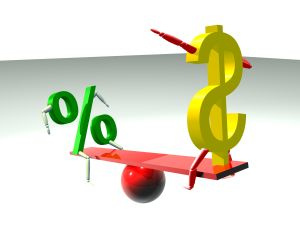
Cost Of Money
The cost of money is the opportunity cost of holding money in hands instead of investing it.
Furthermore, the time value of money is related to the concept of opportunity cost. The cost of any decision includes the cost of the most forgone alternative. The cost of money is the opportunity cost of holding money in hands instead of investing it. The trade-off between money now (holding money) and money later (investing) depends on, among other things, the rate of interest that can be earned by investing. An investor with money has two options: to spend it right now or to save it. The financial compensation for saving it as against spending it is that the money value will accrue through the compound interest that he will receive from a borrower (the bank account or investment in which he has the money).
6.1.2: Interest Rate Levels
An interest rate is the rate at which interest is paid by a borrower for the use of money that they borrow from a lender.
Learning Objective
Describe the crowding out phenomenon
Key Points
- In the U.S., the Federal Reserve (often referred to as ‘The Fed’) implements monetary policies largely by targeting the federal funds rate.
- Expansionary monetary policy is traditionally used to try to combat unemployment in a recession by lowering interest rates in the hope that easy credit will entice businesses into expanding.
- Contractionary monetary policy is intended to slow inflation in hopes of avoiding the resulting distortions and deterioration of asset values.
- Crowding out is a phenomenon occurring when expansionary fiscal policy causes interest rates to rise, thereby reducing investment spending.
Key Term
- monetary policy
-
The process by which the monetary authority of a country controls the supply of money, often targeting a rate of interest for the purpose of promoting economic growth and stability.
An interest rate is the rate at which interest is paid by a borrower for the use of money that they borrow from a lender. Changes in interest rate levels signal the status of the economy. As a vital tool of monetary policy, interest rates are kept at target levels – taking into account variables like investment, inflation, and unemployment – for the purpose of promoting economic growth and stability. In the U.S., the Federal Reserve (often referred to as ‘The Fed’) implements monetary policies largely by targeting the federal funds rate. This is the rate that banks charge each other for overnight loans of federal funds, which are the reserves held by banks at the Fed.
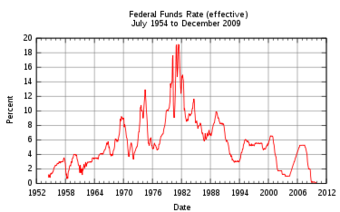
Federal fund rates
The effective federal funds rate in the U.S. charted over more than half a century.
Monetary policies are referred to as either expansionary or contractionary. Expansionary policy is traditionally used to try to combat unemployment in a recession by lowering interest rates in the hope that easy credit will entice businesses into expanding. An expansionary policy increases the total supply of money in the economy more rapidly than usual. Contractionary policy is intended to slow inflation in hopes of avoiding the resulting distortions and deterioration of asset values. Contractionary policy increases interest rate levels by expanding the money supply more slowly than usual or even shrinking it. Most central banks around the world assume and expect that lowering interest rates (expansionary monetary policies) would produce the effect of increasing investments and consumptions. However, lowering interest rates can sometimes lead to the creation of massive economic bubbles, when a large amount of investments are poured into the real estate market and stock market.
Crowding Out
Crowding out is a phenomenon occurring when expansionary fiscal policy causes interest rates to rise, thereby reducing investment spending. That means increase in government spending crowds out investment spending. This change in fiscal policy shifts equilibrium in the goods market. A fiscal expansion increases equilibrium income. If interest rates are unchanged, an increase in the level of aggregate demand will follow. This increase in demand must be met by rise in output.
With this increase in equilibrium income, the quantity of money demanded is higher. Because there is an excessive demand for real balances, the interest rate rises. Firms planned spending declines at higher interest rates, thus the aggregate demand falls. The adjustment of interest rates and their impact on aggregate demand dampen the expansionary effect of the increased government spending.
6.1.3: Drivers of Market Interest Rates
Market interest rates are mostly driven by inflationary expectations, alternative investments, risk of investment, and liquidity preference.
Learning Objective
Calculate the nominal interest rate of a given investment
Key Points
- A market interest rate is the rate at which interest is paid by a borrower for the use of money that they borrow from a lender in the market.
- Economists generally agree that the interest rates yielded by any investment take into account: the risk-free cost of capital, inflationary expectations, the level of risk in the investment, and the costs of the transaction.
- A basic interest rate pricing model for an asset is presented by the following formula: in = ir + pe + rp + lp.
Key Terms
- inflation
-
An increase in the general level of prices or in the cost of living.
- abscond
-
To flee; to withdraw from.
- interest rate risk
-
the potential for loss that arises for bond owners from fluctuating interest rates
- liquidity
-
Availability of cash over short term: ability to service short-term debt.
A market interest rate is the rate at which interest is paid by a borrower for the use of money that they borrow from a lender in the market.
Factors Influencing Market Interest Rates
Deferred consumption: When money is loaned the lender delays spending the money on consumption goods. According to time preference theory, people prefer goods now to goods later. In a free market there will be a positive interest rate.
Inflationary expectations: Most economies generally exhibit inflation, meaning a given amount of money buys fewer goods in the future than it will now. The borrower needs to compensate the lender for this. If the inflationary expectation goes up, then so does the market interest rate and vice versa.

Worldwide Inflation Rates 2009
World map showing inflation rate by country.
Alternative investments: The lender has a choice between using his money in different investments. If he chooses one, he forgoes the returns from all the others. Different investments effectively compete for funds, boosting the market interest rate up.
Risks of investment: There is always a risk that the borrower will go bankruptcy, abscond, die, or otherwise default on the loan. This means that a lender generally charges a risk premium to ensure that, across his investments, he is compensated for those that fail. The greater the risk is, the higher the market interest rate will get.
Liquidity preference: People prefer to have their resources available in a form that can immediately be exchanged, rather than a form that takes time or money to realize. If people are willing to hold more money in hands for convenience, the money supply will contract, increasing the market interest rate.
Market Impact
There is a market for investments which ultimately includes the money market, bond market, stock market, and currency market as well as retail financial institutions like banks. Exactly how these markets function are sometimes complicated. However, economists generally agree that the interest rates yielded by any investment take into account: the risk-free cost of capital, inflationary expectations, the level of risk in the investment, and the costs of the transaction. This rate incorporates the deferred consumption and alternative investments elements of interest. A basic interest rate pricing model for an asset is presented by the following formula: in = ir + pe + rp + lp.
Assuming perfect information, pe is the same for all participants in the market, and this is identical to: in = i*n+ rp + lp
where in is the nominal interest rate on a given investment, ir is the risk-free return to capital, pe = inflationary expectations, i*n = the nominal interest rate on a short-term risk-free liquid bond (such as U.S. Treasury Bills), rp = a risk premium reflecting the length of the investment and the likelihood the borrower will default, lp = liquidity premium (reflecting the perceived difficulty of converting the asset into money and thus into goods).
6.1.4: The Term Structure
Term structure of interest rates describes how rates change over time.
Learning Objective
Differentiate between the different theories explaining the different term structures of interest rates
Key Points
- Term structure of interest rates is often referred to as the yield curve.
- The expectation hypothesis of the term structure of interest rates is the proposition that the long-term rate is determined by the market’s expectation for the short-term rate plus a constant risk premium.
- The liquidity premium theory asserts that long-term interest rates not only reflect investors’ assumptions about future interest rates but also include a premium for holding long-term bonds.
- In the segmented market hypothesis, financial instruments of different terms are not substitutable; therefore, supply and demand in the markets for short-term and long-term instruments is determined largely independently.
Key Terms
- risk premium
-
A risk premium is the minimum amount of money by which the expected return on a risky asset must exceed the known return on a risk-free asset, or the expected return on a less risky asset, in order to induce an individual to hold the risky asset rather than the risk-free asset.
- premium
-
the price above par value at which a security is sold
- premium bond
-
a debt instrument bought at a price above par value
- Liquidity premium
-
Liquidity premium is a term used to explain a difference between two types of financial securities (e.g. stocks), that have all the same qualities except liquidity.
- term structure of interest rates
-
the relationship between the interest on a debt contract and the maturity of the contract
Term structure is a phrase used to describe how a given quantity or variable changes with time. In the case of bonds, time to maturity, or terms, vary from short-term – usually less than a year – to long-term – 10, 20, 30, 50 years, etc. Term structure of interest rates is often referred to as the yield curve.
In finance, the yield curve is a curve showing several yields or interest rates across different contract lengths (2 month, 2 year, 20 year, etc…) for a similar debt contract. The curve shows the relationship between the interest rate (or cost of borrowing) and the time to maturity – known as the “term” – of the debt for a given borrower in a given currency. “”
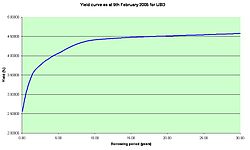
Yield curve for USD
The US dollar yield curve as of February 9, 2005. The curve has a typical upward sloping shape.
The curve allows an interest rate pattern to be determined, which can then be used to discount cash flows appropriately. Unfortunately, most bonds carry coupons, so the term structure must be determined using the prices of these securities. There are three main economic theories attempting to explain different term structures of interest rates. Two of the theories are extreme positions, while the third attempts to find a middle ground between two extremes.
The expectation hypothesis of the term structure of interest rates is the proposition that the long-term rate is determined by the market’s expectation for the short-term rate plus a constant risk premium. Shortcomings of the expectations theory is that it neglects the risks inherent in investing in bonds, namely interest rate risk and reinvestment rate risk.
The liquidity premiumtheory asserts that long-term interest rates not only reflect investors’ assumptions about future interest rates but also include a premium for holding long-term bonds (investors prefer short-term bonds to long-term bonds). This is called the term premium or the liquidity premium. This premium compensates investors for the added risk of having their money tied up for a longer period, including the greater price uncertainty. Because of the term premium, long-term bond yields tend to be higher than short-term yields, and the yield curve slopes upward. Long-term yields are also higher not just because of the liquidity premium, but also because of the risk premium added by the risk of default from holding a security over the long-term.
In the segmented market hypothesis, financial instruments of different terms are not substitutable. As a result, the supply and demand in the markets for short-term and long-term instruments is determined largely independently. Prospective investors decide in advance whether they need short-term or long-term instruments. If investors prefer their portfolio to be liquid, they will prefer short-term instruments to long-term instruments. Therefore, the market for short-term instruments will receive a higher demand. Higher demand for the instrument implies higher prices and lower yield. This explains the stylized fact that short-term yields are usually lower than long-term yields. This theory explains the predominance of the normal yield curve shape. However, because the supply and demand of the two markets are independent, this theory fails to explain the observed fact that yields tend to move together (i.e., upward and downward shifts in the curve).
6.2: Additional Detail on Interest Rates
6.2.1: The Yield Curve
A yield curve shows the relation between interest rate levels (or cost of borrowing) and the time to maturity.
Learning Objective
Describe different yield curves
Key Points
- In finance the yield curve is a curve showing several yields or interest rates across different contract lengths for a similar debt contract.
- Based on the shape of the yield curve, we have normal yield curves, steep yield curves, flat or humped yield curves, and inverted yield curves.
- There are three main economic theories that attempt to explain different term structures of interest rates, namely the expectation hypothesis, the liquidity premium theory, and the segmented market hypothesis.
Key Terms
- yield curve
-
the graph of the relationship between the interest on a debt contract and the maturity of the contract
- treasury bill
-
A United States Treasury security is a government debt issued by the United States Department of the Treasury through the Bureau of the Public Debt. Treasury securities are the debt financing instruments of the United States federal government. They are often referred to simply as treasuries. There are four types of marketable treasury securities: Treasury bills, Treasury notes, Treasury bonds, and Treasury Inflation Protected Securities (TIPS), in which Treasury bills have the shortest maturity of one year or less.
- Treasury bond
-
A United States Treasury security is a government debt issued by the United States Department of the Treasury through the Bureau of the Public Debt. Treasury securities are the debt financing instruments of the United States federal government, and they are often referred to simply as Treasuries. There are four types of marketable treasury securities: Treasury bills, Treasury notes, Treasury bonds, and Treasury Inflation Protected Securities (TIPS), in which Treasury bonds have the longest maturity, from 20 years to 30 years.
Overview
In finance the yield curve is a curve showing several yields or interest rates across different contract lengths (two month, two year, 20 year, etc…) for a similar debt contract. The curve shows the relation between the (level of) interest rate (cost of borrowing) and the time to maturity, known as the “term,” of the debt for a given borrower in a given currency. Based on the shape of the yield curve, we have normal yield curves, steep yield curves, flat or humped yield curves, and inverted yield curves .
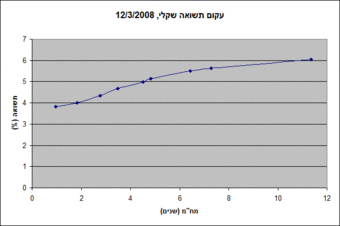
Israel Shekel yield curve
This graph is an example of a yield curve on Israeli Non-Linked Fixed Rate government bonds.
The yield curve is normal meaning that yields rise as maturity lengthens (i.e., the slope of the yield curve is positive). This positive slope reflects investor expectations for the economy to grow in the future and, importantly, for this growth to be associated with a greater expectation that inflation will rise in the future rather than fall. This expectation of higher inflation leads to expectations that the central bank will tighten monetary policy by raising short term interest rates in the future to slow economic growth and dampen inflationary pressure.
Shapes of Curves
Sometimes, treasury bond yield averages higher than that of treasury bills (e.g. 20-year Treasury yield rises higher than the three-month Treasury yield). In situations when this gap increases, the economy is expected to improve quickly in the future. This type of steep yield curve can be seen at the beginning of an economic expansion (or after the end of a recession). Here, economic stagnation will have depressed short-term interest rates. However, rates begin to rise once the demand for capital is re-established by growing economic activity.
A flat yield curve is observed when all maturities have similar yields, whereas a humped curve results when short-term and long-term yields are equal and medium-term yields are higher than those of the short-term and long-term. A flat curve sends signals of uncertainty in the economy.
An inverted yield curve occurs when long-term yields fall below short-term yields. Why this would happen is that when lenders are seeking long-term debt contracts more aggressively than short-term debt contracts. The yield curve “inverts,” with interest rates (yields) being lower and lower for each longer periods of repayment so that lenders can attract long-term borrowing .
Theories
There are three main economic theories attempting to explain different term structures of interest rates. Two of the theories are extreme positions, while the third attempts to find a middle ground between the former two.
The expectation hypothesis of the term structure of interest rates is the proposition that the long-term rate is determined by the market’s expectation for the short-term rate plus a constant risk premium. Shortcomings of expectations theory is that it neglects the risks inherent in investing in bonds, namely interest rate risk and reinvestment rate risk.
The liquidity premium theory asserts that long-term interest rates not only reflect investors’ assumptions about future interest rates, but also include a premium for holding long-term bonds (investors prefer short term bonds to long term bonds), called the term premium or the liquidity premium. This premium compensates investors for the added risk of having their money tied up for a longer period, including the greater price uncertainty. Because of the term premium, long-term bond yields tend to be higher than short-term yields, and the yield curve slopes upward. Long term yields are also higher not just because of the liquidity premium, but also because of the risk premium added by the risk of default from holding a security over the long term.
In the segmented market hypothesis, financial instruments of different terms are not substitutable. As a result, the supply and demand in the markets for short-term and long-term instruments is determined largely independently. Prospective investors decide in advance whether they need short-term or long-term instruments. If investors prefer their portfolio to be liquid, they will prefer short-term instruments to long-term instruments. Therefore, the market for short-term instruments will receive a higher demand. Higher demand for the instrument implies higher prices and lower yield. This explains the stylized fact that short-term yields are usually lower than long-term yields. This theory explains the predominance of the normal yield curve shape. However, because the supply and demand of the two markets are independent, this theory fails to explain the observed fact that yields tend to move together (i.e., upward and downward shifts in the curve).
6.2.2: Using the Yield Curve to Estimate Interest Rates in the Future
Yield curves on bonds and government provided securities are correlative, and are useful in projected future rates.
Learning Objective
Understand the conceptual implications of bond yield rates is they pertain to broader market interest rates
Key Points
- While the strict calculations involved in interest rate projections via bond yield curves come in a number of varieties (and complexities), it’s useful to note that there are strong correlations between the two.
- Yield curves combine the interest rate compounded over the duration of the debt security’s lifetime to demonstrate yield over time.
- The financial stress index uses bond yield rates to determine projected future yield curves, which can indicate a variety of economic predictions (such as recessions and interest rate changes).
- Market expectations theory uses existing projects for short-term interest rates based upon yield to project longer-term interest rates.
- The Heath-Jarrow-Morton Framework is a well-established norm for predicting interest rates based upon various inputs (including yield curves). Understanding the conceptual inputs to this model gives some scope as to interest rate derivation.
Key Terms
- yield curve
-
A curve that shows the compounded interest rate applied to the value of the security over its lifetime.
- recessions
-
Downturns in a given economic environment.
Defining the Yield Curve
For debt contracts, the overall duration of time of the debt security coupled with the interest rate compounded over that time frame will illustrate the overall yield of the security during its lifetime. This is referred to as a yield curve. When this is applied to U.S. treasury securities in respect to interest rates, useful information regarding projected interest rates in the future over time can be estimated. This is carefully monitored by many traders, and utilized as a point of comparison or benchmark for other investments (particularly valuation of bonds).
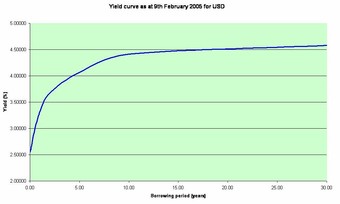
Yield Curve Example
This yield curve from 2005 demonstrates the projected yield over time of USD. As you can see, this is a typical yield curve shape, as the longer the contract is held out the higher the rate of return (with diminishing returns).
Relationship to the Business Cycle
Through assessing the slope of a yield curve on debt instruments such as governmental treasury bonds, investors can estimate the overall health of the economy in the future (i.e. inflation, interest rates, recessions, growth). Inverted yield curves are typically predictors of recession, while positively sloped yield curves indicate inflationary growth.
The Financial Stress Index
Defined as the rate of difference between a 10-year treasury bond rate and a 3-month treasury bond rate, the Financial Stress Index is a useful tool in projected future economic well-being. In fact, each of the recessionary periods since 1970 have demonstrated an inverted yield curve when subjected to Financial Stress Test just prior to that recessionary period.
Market Expectations (i.e. Pure Expectations)
When it comes to interest rates specifically, yield curves are useful constructs in projecting future behavior. The market expectations theory assumes that various maturities are perfect substitutes, and as a result the shape of the yield curve represents market expectations over time in relation to interest rates. In short, through investor expectations of what the 1-year interest rates will be next year, the current 2-year interest rate can be calculated as the compounding of this year’s 1-year interest rate by next year’s expected 1-year interest rate. Or, as an equation:
(ist and ilt are the expected short-term and actual long-term interest rates, respectively)
Heath-Jarrow-Morton Framework
When it comes to predicting future interest rates, the Heath-Jarrow-Morton framework is considered a standard approach. It focuses on modeling the evolution of the interest rate curve (instantaneous forward rate curve in particular). The equation itself is a rather evolved derivation, incorporating bond prices, forward rates, risk free rates, the Wiener process, Leibniz’s rule, and Fubini’s Theorem. While the details of this calculation are a bit outside the scope of discussion here, the equation can ultimately be described as:
For the sake of this discussion, it suffices to say that the input of existing yield curves is useful in projected future interest rates under a number of varying perspectives.
6.2.3: Macroeconomic Factors Influencing the Interest Rate
Taylor explained the rule of determining interest rates using three variables: inflation rate, GDP growth, and the real interest rate.
Learning Objective
Describe how the nominal interest rate is influenced by inflation, output, and other economic conditions
Key Points
- In economics, the Taylor rule is a monetary-policy rule that stipulates how much the Central Bank should change the nominal interest rate in response to changes in inflation, output, or other economic conditions.
- If the inflationary expectation goes up, then so does the market interest rate and vice versa.
- If output gap is positive, it is called an “inflationary gap,” possibly creating inflation, signaling a increase in interest rates made by the Central Bank; if output gap is negative, it is called a “recessionary gap,” possibly signifying deflation and a reduction in interest rates.
Key Terms
- Recessionary gap
-
An inflationary gap, in economics, is the amount by which the real Gross domestic product, or real GDP, is less than the potential GDP.
- Real interest rate
-
The “real interest rate” is the rate of interest an investor expects to receive after allowing for inflation. It can be described more formally by the Fisher equation, which states that the real interest rate is approximately the nominal interest rate minus the inflation rate.
- inflationary gap
-
An inflationary gap, in economics, is the amount by which the real gross domestic product, or real GDP, exceeds potential GDP.
Interest Rate Overview
An interest rate is the rate at which interest is paid by a borrower for the use of money that they borrow from a lender in the market. The interest rates are influenced by macroeconomic factors. In economics, a Taylor rule is a monetary-policy rule that stipulates how much the Central Bank should change the nominal interest rate in response to changes in inflation, output, or other economic conditions. In particular, the rule stipulates that for each 1% increase in inflation, the Central Bank should raise the nominal interest rate by more than one percentage point.
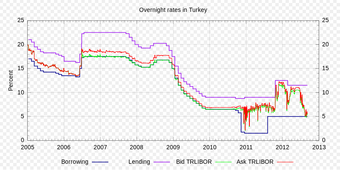
Interest Rates in Turkey
Overnight rates in Turkey are estimated to fall in 2013, indicating a loosened monetary policy.
Taylor Rule
According to Taylor’s original version of the rule, the nominal interest rate should respond to divergences of actual inflation rates from target inflation rates and of actual Gross Domestic Product (GDP) from potential GDP:
it = πt + r*t + απ(πt – π*t) + αy(yt – y*t)
In this equation, it is the target short-term nominal interest rate (e.g., the federal fund rates in the United States), πt is the rate of inflation as measured by the GDP deflator, π*t is the desired rate of inflation, r*t is the assumed equilibrium real interest rate, yt is the logarithm of real GDP, and y*t is the logarithm of potential output, as determined by a linear trend.
In other words, (πt – π*t)is inflation expectations that influence interest rates. Most economies generally exhibit inflation, meaning a given amount of money buys fewer goods in the future than it will now. The borrower needs to compensate the lender for this. If the inflationary expectation goes up, then so does the market interest rate and vice versa.
Output Gap
The GDP gap or the output gap is (yt – y*t). If this calculation yields a positive number, it is called an “inflationary gap” and indicates the growth of aggregate demand is outpacing the growth of aggregate supply (or high level of employment), possibly creating inflation, signaling an increase in interest rates made by the Central Bank; if the calculation yields a negative number it is called a “recessionary gap,” which is accompanied by a low employment rate, possibly signifying deflation and a reduction in interest rates.
In this equation, both απ and αy should be positive (as a rough rule of thumb, Taylor’s 1993 paper proposed setting απ =αy = 0.5). That is, the rule “recommends” a relatively high interest rate (a “tight” monetary policy) when inflation is above its target or when output is above its full-employment level, in order to reduce inflationary pressure. It recommends a relatively low interest rate (“easy” monetary policy) in the opposite situation to stimulate output.
Taylor explained the rule in simple terms using three variables: inflation rate, GDP growth, and the equilibrium real interest rate.
6.3: Key Characteristics of Bonds
6.3.1: Par Value
Par value is the amount of money a holder will get back once a bond matures; a bond can be sold at par, at premium, or discount.
Learning Objective
Assess when a bond should be sold at its par value
Key Points
- When a bond trades at a price above the face value, it is said to be selling at a premium. When a bond sells below face value, it is said to be selling at a discount.
- A bond’s price fluctuates throughout its life in response to a number of variables, including interest rates and time to maturity.
- Pull to par is the effect in which the price of a bond converges to par value as time passes. At maturity, the price of a debt instrument in good standing should equal its par (or face value).
Key Terms
- resale market
-
The resale market, also called “secondary market” or “aftermarket,” is the financial market in which previously issued financial instruments, such as stock, bonds, options, and futures, are bought and sold.
- par value
-
the stated value or amount of a bill or a note
Par value/face value (also known as the principal) is the amount of money a holder will get back once a bond matures. Par value means stated value or face value in finance and accounting. From this comes the expressions at par (at the par value), over par (over par value) and under par (under par value).
A newly issued bond usually sells at the par value. Corporate bonds normally have a par value of $1,000, but this amount can be much greater for government bonds. What confuses many people is that the par value is not the price of the bond. A bond’s price fluctuates throughout its life in response to a number of variables, including interest rates and time to maturity. When a bond trades at a price above the face value, it is said to be selling at a premium. When a bond sells below face value, it is said to be selling at a discount.

Temporary bonds for the state of Kansas issued in 1922
Par values of these bonds were $50, $100, $10000, and $3000.
Pull to par is the effect in which the price of a bond converges to par value as time passes. At maturity, the price of a debt instrument in good standing should equal its par (or face value). Another name for this effect is “reduction of maturity. ” It results from the difference between market interest rate and the nominal yield on the bond.
A bond selling at par has a coupon rate such that the bond is worth an amount equivalent to its original issue value or its value upon redemption at maturity. In other words, if you buy a bond at face value, or par, when it is issued and hold it until it matures, you’ll earn interest at the stated, or coupon, rate. For example, if you buy a 20-year $1,000 bond paying $550 a year for 20 years. The yield, or your return on investment, will also be 5%. You will get your $1,000 back when the 20 years are up. You can also buy and sell bonds through a broker after their date of issue. This is known as the “secondary market” or “resale market. “
6.3.2: Coupon Interest Rate
The coupon rate is the amount of interest that the bondholder will receive per payment, expressed as a percentage of the par value.
Learning Objective
Classify bonds based on coupon rate
Key Points
- Coupon interest rate is usually fixed throughout the life of the bond. It can also vary with a money market index.
- Not all bonds have coupons. Zero-coupon bonds are those that pay no coupons and thus have a coupon rate of 0%.
- Based on different coupon rates, there are fixed rate bonds, floating rate bonds, and inflation linked bonds.
Key Term
- time value of money
-
The value of money, figuring in a given amount of interest, earned over a given amount of time.
The coupon rate is the amount of interest that the bondholder will receive expressed as a percentage of the par value. Thus, if a bond has a par value of 1,000 and a coupon rate of 10,100 a year during the time between when the bond is issued and when it matures. Usually this rate is fixed throughout the life of the bond. It can also vary with a money market index, such as LIBOR, or it can be even more exotic. The bond will also specify when the interest is to be paid, whether monthly, quarterly, semi-annually, or annually.

Mecca Temple 1922 Bond Coupons
A coupon payment on a bond is a periodic interest payment that the bond holder receives during the time between when the bond is issued and when it matures.
The name “coupon” arose because in the past, paper bond certificates were issued that had coupons attached to them, one for each interest payment. On the due dates, the bondholder would hand in the coupon to a bank in exchange for the interest payment.
Not all bonds have coupons. Zero-coupon bonds are those that pay no coupons and thus have a coupon rate of 0%. Such bonds make only one payment–the payment of the face value on the maturity date. Normally, to compensate the bondholder for the time value of money, the price of a zero-coupon bond will always be less than its face value on any date before the maturity date. The bondholder receives the full principal amount on the redemption date. An example of zero coupon bonds is Series E savings bonds issued by the U.S. government.
Based on different coupon rates, bonds are classified into many types. Fixed-rate bonds have a coupon that remains constant throughout the life of the bond. A variation are stepped-coupon bonds, with a coupon that increases during the life of the bond.
Floating rate notes (FRNs, floaters) have a variable coupon that is linked to a reference rate of interest, such as LIBOR or Euribor. For example, the coupon may be defined as three month USD LIBOR + 0.20%. The coupon rate is recalculated periodically, typically every one or three months.
Inflation linked bonds (linkers), in which the principal amount and the interest payments are indexed to inflation. The interest rate is normally lower than for fixed rate bonds with a comparable maturity. However, as the principal amount grows, the payments increase with inflation. The United Kingdom was the first sovereign issuer to issue inflation linked Gilts in the 1980s. Treasury Inflation-Protected Securities (TIPS) and I-bonds are examples of inflation linked bonds issued by the U.S. government.
6.3.3: Maturity Date
Maturity date refers to the final payment date of a loan or other financial instrument.
Learning Objective
Define a US security based on its maturity date
Key Points
- As long as all due payments have been made, the issuer has no further obligations to the bond holders after the maturity date.
- The length of time until the maturity date is often referred to as the term or tenor or maturity of a bond.
- In the market for United States Treasury securities, there are three categories of bond maturities: short term, medium term, and long term.
Key Terms
- callable
-
A callable bond (also called “redeemable bond”) is a type of bond (debt security) that allows the issuer of the bond to retain the privilege of redeeming the bond at some point before the bond reaches its date of maturity.
- puttable
-
Puttable bond (put bond, putable, or retractable bond) is a bond with an embedded put option. The holder of the puttable bond has the right, but not the obligation, to demand early repayment of the principal.
In finance, maturity date or redemption date, refers to the final payment date of a loan or other financial instrument, at which point the principal (and all remaining interest) is due to be paid.

Austrian war bond
The first Austrian bonds had 5% rates of return and a five-year maturity.
The issuer has to repay the nominal amount on the maturity date. As long as all due payments have been made, the issuer has no further obligations to the bond holders after the maturity date. The length of time until the maturity date is often referred to as the term or tenor or maturity of a bond. The maturity can be any length of time, although debt securities with a term of less than one year are generally designated money market instruments rather than bonds. Most bonds have a term of up to 30 years. Some bonds have been issued with terms of 50 years or more and, historically, there have been some issues with no maturity date (irredeemables).
In the market for United States Treasury securities, there are three categories of bond maturities:
- short term (bills): maturities between 1 to 5 years (instruments with maturities less than one year are called “Money Market Instruments”);
- medium term (notes): maturities between 6 to 12 years; and
- long term (bonds): maturities greater than 12 years.
Normally the maturity of a bond is fixed. However, it is important to note that bonds are sometimes “callable,”which means that the issuer of the debt is able to pay back the principal at any time. In this case, the maturity date is the day when the bond is called. Thus, investors should inquire, before buying any fixed-income securities, whether the bond is callable or not. Bonds can also be puttable, meaning that the holder has the right, but not the obligation, to demand early repayment of the principal. Similarly, the maturity date, if applicable, is the date as the bond is redeemed.
6.3.4: Call Provisions
A callable bond allows the issuer to redeem the bond before the maturity date; this is likely to happen when interest rates go down.
Learning Objective
Classify a bond based on its call provision
Key Points
- A callable bond is a type of bond that allows the issuer of the bond to retain the privilege of redeeming the bond at some point before the bond reaches its date of maturity.
- If interest rates in the market have gone down by the time of the call date, the issuer will be able to refinance its debt at a cheaper level and so will be incentivized to call the bonds it originally issued.
- Most callable bonds allow the issuer to repay the bond at par. With some bonds, the issuer has to pay a premium, known as the call premium.
- Price of callable bond = Price of straight bond – Price of call option. Price of a callable bond is always lower than the price of a straight bond because the call option adds value to an issuer.
Key Terms
- par
-
Equal value; equality of nominal and actual value; the value expressed on the face or in the words of a certificate of value, as a bond or other commercial paper.
- straight bond
-
A straight bond is a bond with no embedded options (call or put options).
Occasionally a bond may contain an embedded option. That is, it grants option-like features to the holder or the issuer. A callable bond (also called redeemable bond) is a type of bond that allows the issuer of the bond to retain the privilege of redeeming the bond at some point before the bond reaches its date of maturity. In other words, on the call date, the issuer has the right, but not the obligation, to buy back the bonds from the bond holders at a defined call price. Technically speaking, the bonds are not really bought and held by the issuer. They are instead cancelled immediately.
Call dates are the dates on which callable bonds can be redeemed early.
There are three main categories.
- A Bermudan callable has several call dates, usually coinciding with coupon dates.
- A European callable has only one call date. This is a special case of a Bermudan callable.
- An American callable can be called at any time until the maturity date.
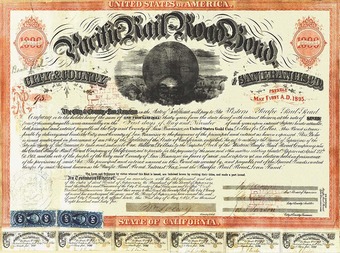
Redeemed Bonds
This Bond is one of the 400 issued to the Central Pacific Rail Road Company of California and 200 to the Western Pacific Rail Road Company in 1865 under the Act of the California Legislature passed on April 22, 1863. Coupon #1 was redeemed and cancelled on November 2, 1865, and coupon #35 on November 2, 1882, at which time the principal of $1,000.00 in gold coin was also paid from the Treasury of the City and County of San Francisco and the Bond was cancelled.
Most callable bonds allow the issuer to repay the bond at par. With some bonds, the issuer has to pay a premium, known as the call premium. This is mainly the case for high-yield bonds. These have very strict covenants, restricting the issuer in its operations. To be free from these covenants, the issuer can repay the bonds early, but only at a high cost.
The issuer has an option, for which it pays in the form of a higher coupon rate. If interest rates in the market have gone down by the time of the call date, the issuer will be able to refinance its debt at a cheaper level. The issuer will be incentivized to call the bonds it originally issued. Another way to look at this interplay is that as interest rates go down, the price of the bonds goes up. Therefore, it is advantageous to buy the bonds back at par value. With a callable bond, investors have the benefit of a higher coupon than they would have had with a straight, non-callable bond. On the other hand, if interest rates fall, the bonds will likely be called, and they can only invest at the lower rate.
The price behavior of a callable bond is the opposite of that of puttable bond. Since call option and put option are not mutually exclusive, a bond may have both options embedded.
Price of callable bond = Price of straight bond – Price of call option
Price of a callable bond is always lower than the price of a straight bond because the call option adds value to an issuer. Similarly, yield on a callable bond is higher than the yield on a straight bond.
6.3.5: Sinking Funds
A sinking fund is a method by which an organization sets aside money to retire debts.
Learning Objective
Describe how a sinking fund operates in regards to a bond issue
Key Points
- Sinking fund provision of the corporate bond indenture requires a certain portion of the issue to be retired periodically.
- A sinking fund reduces credit risk but presents reinvestment risk to bondholders.
- For the creditors, the fund reduces the risk the organization will default when the principal is due: it reduces credit risk. However, if the bonds are callable, this comes at a cost to creditors, because the organization has an option on the bonds.
Key Terms
- debentures
-
A debenture is a document that either creates a debt or acknowledges it, and it is a debt without collateral.
- Preferred Stock
-
Stock with a dividend, usually fixed, that is paid out of profits before any dividend can be paid on common stock. It also has priority to common stock in liquidation.
- call provision
-
the right for the issuer to buy back the bond at a predetermined price at a certain time in future
In modern finance, a sinking fund is a method by which an organization sets aside money over time to retire its indebtedness by repaying or purchasing outstanding loans and securities held against the entity. More specifically, it is a fund into which money can be deposited, so that over time preferred stock, debentures or stocks can be retired. Sinking funds can also be used to set aside money for purposes of replacing capital equipment as it becomes obsolete .

Farm bond
One purpose of a sinking fund is to repurchase outstanding bonds.
Sinking fund provision of the corporate bond indenture requires a certain portion of the issue to be retired periodically. The entire bond issue can be liquidated by the maturity date. Issuers may either pay to trustees, which in turn call randomly selected bonds in the issue, or, alternatively, purchase bonds in open market, then return them to trustees.
A sinking fund may operate in one or more of the following ways:
- The firm may repurchase a fraction of the outstanding bonds in the open market each year.
- The firm may repurchase a fraction of outstanding bonds at a special call price associated with the sinking fund provision (they are callable bonds).
- The firm has the option to repurchase the bonds at either the market price or the sinking fund price, whichever is lower. The firm can only repurchase a limited fraction of the bond issue at the sinking fund price. At best some indentures allow firms to use a doubling option, which allows repurchase of double the required number of bonds at the sinking fund price.
- A less common provision is to call for periodic payments to a trustee, with the payments invested so that the accumulated sum can be used for retirement of the entire issue at maturity: instead of the debt amortizing over the life, the debt remains outstanding and a matching asset accrues. Thus the balance sheet consists of Asset = Sinking fund, Liability = Bonds
For the creditors, the fund reduces the risk the organization will default when the principal is due: it reduces credit risk. However, if the bonds are callable, this comes at a cost to creditors, because the organization has an option on the bonds: The firm will choose to buy back discount bonds (selling below par) at their market price,while exercising its option to buy back premium bonds (selling above par) at par. Therefore, if interest rates fall and bond prices rise, a firm will benefit from the sinking fund provision that enables it to repurchase its bonds at below-market prices. In this case, the firm’s gain is the bondholder’s loss–thus callable bonds will typically be issued at a higher coupon rate, reflecting the value of the option.
6.3.6: Other Features
Other important features of bonds include the yield, market price and putability of a bond.
Learning Objective
Describe the effect a bond’s market price has on its yield
Key Points
- The yield is the rate of return received from investing in the bond. It usually refers either to the current yield, or to the yield to maturity or redemption yield.
- The market price of a tradeable bond will be influenced by the amounts, currency and timing of the interest payments and capital repayment due, the quality of the bond, and the available redemption yield of other comparable bonds which can be traded in the markets.
- Some bonds give the holder the right to force the issuer to repay the bond before the maturity date on the put dates. These are referred to as retractable or putable bonds.
Key Terms
- Yield to maturity
-
The internal rate of return on a bond held to maturity, assuming scheduled payment of principal and interest.
- clean price
-
the price of a bond excluding any interest that has accrued since issue or the most recent coupon payment.
Some other important features of bonds are presented below, namely the yield, market price and putability of a bond. “”
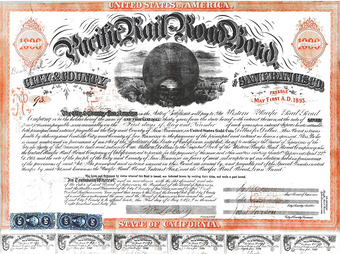
San Francisco Pacific Railroad Bond
$1,000 (30 year, 7%) “Pacific Railroad Bond” (#93 of 200) issued by the City and County of San Francisco under “An Act to Authorize the Board of Supervisors of the City and County of San Francisco to take and subscribe One Million Dollars to the Capital Stock of the Western Pacific Rail Road Company and the Central Pacific Rail Road Company of California and to provide for the payment of the same and other matters relating thereto” approved on April 22, 1863, as amended by section Five of the “Compromise Act” approved on April 4, 1864, to fund the construction of the Western Pacific Railroad between San Francisco Bay (at Alameda) and the CPRR of Cal. at Sacramento, dated May 1, 1865.
Yield
The yield is the rate of return received from investing in the bond. It usually refers either to the current yield, which is simply the annual interest payment divided by the current market price of the bond (often the clean price), or to the yield to maturity or redemption yield. Yield to maturity is a more useful measure of the return of the bond, taking into account the current market price, the amount and timing of all remaining coupon payments, and of the repayment due on maturity.
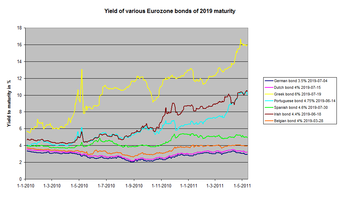
Eurozone Government Bonds Yield
Development of yield to maturity of bonds of 2019 maturity of a number of Eurozone governments.
Market Price
The market price of a tradeable bond will be influenced – amongst other things – by the amounts, currency and timing of the interest payments and capital repayment due; the quality of the bond; and the available redemption yield of other comparable bonds which can be traded in the markets. The price can be quoted as clean or dirty. “Dirty” refers to the actual price to be paid; while “clean” includes an adjustment for accrued interest. The issue price at which investors buy the bonds when they are first issued will typically be approximately equal to the nominal amount. The net proceeds that the issuer receives are thus the issue price, less issuance fees. The market price of the bond will vary over its life: it may trade at a premium (above par, usually because market interest rates have fallen since issue), or at a discount (below par, if market rates have risen or there is a high probability of default on the bond).
Putability
Some bonds give the holder the right to force the issuer to repay the bond before the maturity date on the put dates. These are referred to as retractable or putable bonds. Put dates are the dates on which putable bonds can be redeemed early. This type of bond protects investors: if interest rates rise after bond purchase, the future value of coupon payments will become less valuable. Therefore, investors sell bonds back to the issuer and may lend proceeds elsewhere at a higher rate. Bondholders are ready to pay for such protection by accepting a lower yield relative to that of a straight bond. A death put is an optional redemption feature on a debt instrument allowing the beneficiary of the estate of a deceased bondholder to put (sell) the bond (back to the issuer) at face value in the event of the bondholder’s death or legal incapacitation.
Price of puttable bond = Price of straight bond + Price of put option
Price of a puttable bond is always higher than the price of a straight bond because the put option adds value to an investor. Yield on a puttable bond is lower than the yield on a straight bond.
6.4: Understanding Bonds
6.4.1: The Nature of Bonds
A bond is an instrument of indebtedness of the bond issuer to the holders.
Learning Objective
Distinguish the various types of bonds from other types of securities
Key Points
- A bond is an instrument of indebtedness of the bond issuer to the holders. The issuer owes the holders a debt and, depending on the terms of the bond, is obliged to pay them interest (the coupon) and/or to repay the principal at a later date, termed the maturity.
- Bonds provide the borrower with external funds to finance long-term investments, or, in the case of government bonds, to finance current expenditure.
- Bonds and stocks are both securities, but the major difference between the two is that (capital) stockholders have an equity stake in the company (i.e. they are owners), whereas bondholders have a creditor stake in the company (i.e. they are lenders).
Key Terms
- municipal bonds
-
A municipal bond is a bond issued by an American city or other local government, or their agencies.
- Treasury bonds
-
A United States Treasury bond is a government debt issued by the United States Department of the Treasury through the Bureau of the Public Debt, with a maturity of 20 years to 30 years.
- corporate bonds
-
A corporate bond is a bond issue by a corporation. It is a bond that a corporation issues to raise money effectively in order to expand its business.
Nature of Bonds
A bond is an instrument of indebtedness of the bond issuer to the holders, as such it is often referred to as a debt instrument. A bond is a debt security, under which the issuer owes the holders a debt and, depending on the terms of the bond, is obliged to pay them interest (the coupon) and/or repay the principal at a later date, termed the maturity. Interest is usually payable at fixed intervals (semiannual, annual, sometimes monthly).
Bonds are issued by public authorities, credit institutions, companies, and supranational institutions in the primary market. Both individuals and companies can purchase bonds.
However, very often the bond is negotiable, i.e. the ownership of the instrument can be transferred in the secondary market .

A bond from the Dutch East India Company
A bond is a financial security that represents a promise by a company or government to repay a certain amount, with interest, to the bondholder.
Types of Bonds
The main categories of bonds are corporate bonds, municipal bonds, and U.S. Treasury bonds, notes, and bills, which are collectively referred to simply as “Treasuries. ” Two features of a bond – credit quality and duration – are the principal determinants of a bond’s interest rate. Bond maturities range from a 90-day Treasury bill to a 30-year government bond. Corporate and municipal bonds are typically in the three to 10-year range.
Overview of the Instrument
A bond is a form of loan: the holder of the bond is the lender (creditor), the issuer of the bond is the borrower (debtor), and the coupon is the interest. Bonds provide the borrower with external funds to finance long-term investments, or, in the case of government bonds, to finance current expenditure. Certificates of deposits (CDs), or short term commercial papers, are considered to be money market instruments and not bonds: the main difference is in the instruments length of term.
Bonds and stocks are both securities, but the major difference between the two is that (capital) stockholders have an equity stake in the company (they are owners), whereas bondholders have a creditor stake in the company (they are lenders). Another difference is that bonds usually have a defined term, or maturity, after which the bond is redeemed, whereas stocks may be outstanding indefinitely. An exception is an irredeemable bond, such as Consols, which is a perpetuity, that is, a bond with no maturity.
6.4.2: Duration
Duration is the weighted average of the times until fixed cash flows of a financial asset are received.
Learning Objective
Define the different types of duration
Key Points
- A good approximation for bond price changes due to yield is the duration, a measure for interest rate risk.
- The Macaulay duration is the name given to the weighted average time until cash flows are received and is measured in years. It really makes sense only for an instrument with fixed cash flows.
- The modified duration is the name given to the price sensitivity and is the percentage change in price for a unit change in yield. It really makes sense only for an instrument with fixed cash flows.
- The modified duration is a derivative (rate of change) or price sensitivity and measures the percentage rate of change of price with respect to yield. The concept of modified duration can be applied to interest-rate sensitive instruments with non-fixed cash flows.
Key Terms
- Convexity
-
As interest rates change, the price does not change linearly, but rather is a convex function of interest rates. Convexity is a measure of the curvature of how the price of a bond changes as the interest rate changes. Specifically, duration can be formulated as the first derivative of the price function of the bond with respect to the interest rate in question, and the convexity as the second derivative.
- Yield to maturity
-
The yield to maturity (YTM) of a bond or other fixed-interest security, such as gilts, is the internal rate of return (IRR, overall interest rate) earned by an investor who buys the bond today at the market price, assuming that the bond will be held until maturity and that all coupon and principal payments will be made on schedule.
Duration
In finance, the duration of a financial asset that consists of fixed cash flows, for example a bond, is the weighted average of the times until those fixed cash flows are received. When an asset is considered as a function of yield, duration also measures the price sensitivity to yield, the rate of change of price with respect to yield, or the percentage change in price for a parallel shift in yields. Since cash flows for bonds are usually fixed, a price change can come from two sources: The passage of time (convergence towards par) which is predictable and a change in the yield.
The yield-price relationship is inverse and investors would ideally wish to have a measure of how sensitive the bond price is to yield changes. A good approximation for bond price changes due to yield is the duration, a measure for interest rate risk. For large yield changes convexity can be added to improve the performance of the duration. A more important use of convexity is that it measures the sensitivity of duration to yield changes.
Types of Durations
The dual use of the word “duration” in the Macaulay duration and the modified duration, as both the weighted average time until repayment and as the percentage change in price, often causes confusion. The Macaulay duration is the name given to the weighted average time until cash flows are received and is measured in years.

Macaulay duration
The Macaulay duration is the name given to the weighted average time until cash flows are received and is measured in years.
Where: i indexes the cash flows, PVi is the present value of the cash payment from an asset, ti is the time in years until the payment will be received, and V is the present value of all cash payments from the asset.
The Modified duration is the name given to the price sensitivity and is the percentage change in price for a unit change in yield.

Modified duration
The modified duration is the name given to the price sensitivity and is the percentage change in price for a unit change in yield.
Where: k is the compounding frequency per year (1 for annual, 2 for semi-annual, 12 for monthly, 52 for weekly, and so on), y is the is the yield to maturity for an asset.
When yields are continuously-compounded the Macaulay duration and the modified duration will be numerically equal. When yields are periodically-compounded the Macaulay duration and the modified duration will differ slightly and in this case there is a simple relation between the two. The modified duration is used more than the Macaulay duration.
The Macaulay duration and the modified duration are both termed “duration” and have the same (or close to the same) numerical value, but it is important to keep in mind the conceptual distinctions between them. The Macaulay duration is a time measure with units in years and really makes sense only for an instrument with fixed cash flows. For a standard bond, the Macaulay duration will be between 0 and the maturity of the bond. It is equal to the maturity if and only if the bond is a zero-coupon bond.
The modified duration, on the other hand, is a derivative (rate of change) or price sensitivity and measures the percentage rate of change of price with respect to yield. The concept of modified duration can be applied to interest-rate sensitive instruments with non-fixed cash flows and can thus be applied to a wider range of instruments than can the Macaulay duration. For everyday use, the equality (or near-equality) of the values for the Macaulay duration and the modified duration can be a useful aid to intuition.
6.4.3: Indenture
A bond indenture is a legal contract issued to lenders that defines commitments and responsibilities of the seller and the buyer.
Learning Objective
Review the rights and responsibilities of parties to a bond
Key Points
- Terms of indentures include the interest rate, maturity date, repayment dates, convertibility, pledge, promises, representations, covenants, and other terms of the bond offering.
- A bond indenture is held by a trustee. If the company fails to live up to the terms of the bond indenture, the trustee may bring legal action against the company on behalf of the bondholders.
- The offering memorandum, also known as a prospectus, is a document that describes a financial security for potential buyers.
Key Terms
- convertibility
-
Quality of a bond that allows the holder to convert into shares of common stock in the issuing company or cash of equal value, at an agreed-upon price.
- indenture
-
a document, written as duplicates separated by indentations, specifying such a contract
- public debt offerings
-
A public debt offering is the offering of debt securities of a government, a company or a similar corporation to the public.
A bond indenture (also called a trust indenture or deed of trust) is a legal contract issued to lenders. The specifications given within the bond indenture define the responsibilities and commitments of the seller as well as those of the buyer by describing key terms such as the interest rate, maturity date, repayment dates, convertibility, pledge, promises, representations, covenants, and other terms of the bond offering. Failure to meet the payment requirements calls for drastic penalties, including liquidation of the issuer’s assets .

Indenture
Bond indenture (also trust indenture or deed of trust) is a legal contract issued to lenders.
Because it would be impractical for the corporation to enter into a direct agreement with each of the many bondholders, the bond indenture is held by a trustee – usually a commercial bank or other financial institution – appointed by the issuing firm to represent the rights of the bondholders. The issuer of a bond will use the indenture to describe detail about the issuer and the bond trustee for interested investors to research the background of the bond issue. This is to ensure that the bondholder has a clear idea of when to expect interest payments, as well as whom to contact if he or she has questions or concerns. If the company fails to live up to the terms of the bond indenture, the trustee may bring legal action against the company on behalf of the bondholders.
When the offering memorandum is prepared in advance of marketing a bond, the indenture will typically be summarized in the “description of notes” section. This offering memorandum, also known as a prospectus, is a document that describes a financial security for potential buyers. A prospectus commonly provides investors with material information about mutual funds, stocks, bonds, and other investments, such as a description of the company’s business, financial statements, biographies of officers and directors, detailed information about their compensation, any litigation that is taking place, a list of material properties, and any other material information.
In the United States, public debt offerings in excess of $10 million require the use of an indenture of trust under the Trust Indenture Act of 1939. The rationale for this is that it is necessary to establish a collective action mechanism under which creditors can collect in a fair, orderly manner if default takes place (like that which occurs during bankruptcy).
6.4.4: Ratings
Bond credit rating agencies assess and report the credit worthiness of a corporation’s or government’s debt issues.
Learning Objective
Use the ratings system to assess the risk associated with different bonds
Key Points
- Ratings play a critical role in determining how much companies and other entities that issue debt, including sovereign governments, have to pay to access credit markets; for example, the amount of interest they pay on their issued debt.
- The ratings are assigned by credit rating agencies such as Moody’s, Standard & Poor’s, and Fitch. Ratings to have letter designations (such as AAA, B, CC), which represent the quality of a bond.
- A bond is considered investment-grade (IG) if its credit rating is BBB- or higher by Standard & Poor’s, or Baa3 or higher by Moody’s, or BBB(low) or higher by DBRS. Bond ratings below BBB/Baa are not considered to be investment grade; such bonds are called junk bonds.
Key Term
- credit rating agencies
-
A credit rating agency (CRA) is a company that assigns credit ratings to issuers of certain types of debt obligations, as well as to the debt instruments themselves.
Ratings Overview
In investment, the bond credit rating assesses the credit worthiness of a corporation’s or government’s debt issue. The credit rating is analogous to a credit rating for individuals. The “quality” of the issue refers to the probability that the bondholders will receive the amounts promised on the due dates.
The credit rating is a financial indicator to potential investors of debt securities, such as bonds. Ratings play a critical role in determining the amount that companies (and other entities that issue debt, including sovereign governments) have to pay to access credit markets; for example, the amount of interest that must be paid on issued debt. The ratings are assigned by credit rating agencies, such as Moody’s, Standard & Poor’s, and Fitch Ratings, and are given in letter designations (AAA, B, CC), which represent the quality of a bond. Generally they are bonds that are judged by the rating agency as likely enough to meet payment obligations; banks are thus allowed to invest in them. “”
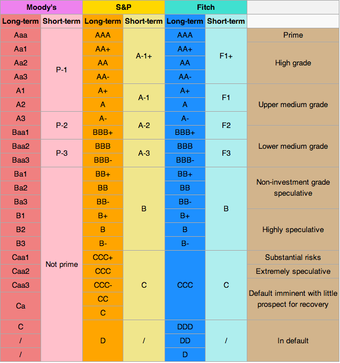
Credit Rating Equivalents
Credit ratings are used to report on the credit worthiness of a bond issuing company or government
Investment-grade Bonds
A bond is considered investment-grade, or IG, if its credit rating is BBB- or higher by Standard & Poor’s, or Baa3 or higher by Moody’s, or BBB(low) or higher by DBRS.
Bond ratings below BBB/Baa are not considered to be investment-grade; these bonds are called junk bonds. Junk bonds are also called high-yield bonds. These are bonds that are rated below investment grade by the credit rating agencies. As these bonds are more risky than investment grade bonds, investors expect them to earn a higher yield. The threshold between investment-grade and speculative-grade ratings has important market implications for issuers’ borrowing costs.
The risks associated with investment-grade bonds (or investment-grade corporate debt) are considered significantly higher than those associated with first-class government bonds. The difference between rates for first-class government bonds and investment-grade bonds is called “investment-grade spread. ” The range of this spread is an indicator of the market’s belief in the stability of the economy. The higher these investment-grade spreads (or risk premiums) are, the weaker the economy is considered.
Rating Agency Criticism
Until the early 1970s, bond credit ratings agencies were paid for their work by investors who wanted impartial information on the credit worthiness of securities issuers and their particular offerings. Starting in the early 1970s, the “Big Three” ratings agencies (S&P, Moody’s, and Fitch) began to receive payment for their work by the securities issuers for whom they issued ratings, which led to current charges that these ratings agencies can no longer always be impartial when issuing ratings for securities issuers. Securities issuers have been accused of “shopping” for the best ratings from S&P, Moody’s, and Fitch, in order to attract investors, until at least one of the agencies delivers favorable ratings.
6.5: Advantages and Disadvantages of Bonds
6.5.1: Advantages of Bonds
Bonds have some advantages over stocks, including relatively low volatility, high liquidity, legal protection, and a variety of term structures.
Learning Objective
Discuss the advantages of owning a bond
Key Points
- Bonds are a debt security under which the issuer owes the holders a debt and, depending on the terms of the bond, is obliged to pay them interest (the coupon) and or repay the principal at a later date, which is termed the maturity.
- The volatility of bonds (especially short and medium dated bonds) is lower than that of equities (stocks). Thus bonds are generally viewed as safer investments than stocks.
- Bonds are often liquid – it is often fairly easy for an institution to sell a large quantity of bonds without affecting the price much.
- Bondholders also enjoy a measure of legal protection: under the law of most countries, if a company goes bankrupt, its bondholders will often receive some money back (the recovery amount).
- There are also a variety of bonds to fit different needs of investors.
Key Terms
- inflation-linked bonds
-
Inflation-indexed bonds (also known as inflation-linked bonds or colloquially as linkers) are bonds where the principal is indexed to inflation. They are thus designed to cut out the inflation risk of an investment.
- Zero coupon bonds
-
A zero-coupon bond (also called a discount bond or deep discount bond) is a bond bought at a price lower than its face value, with the face value repaid at the time of maturity.
- Convertible bonds
-
A convertible bond is a type of bond that the holder can convert into shares of common stock in the issuing company or cash of equal value, at an agreed-upon price.
Definition and Purpose of a Bond
In finance, a bond is an instrument of indebtedness of the bond issuer to the holders. It is a debt security under which the issuer owes the holders a debt and, depending on the terms of the bond, is obliged to pay them interest (the coupon). In addition, the issuer might have to repay the principal at a later date, which is termed the maturity. Interest is usually payable at fixed intervals (semiannual, annual, and sometimes monthly). Very often the bond is negotiable; in other words, the ownership of the instrument can be transferred in the secondary market.
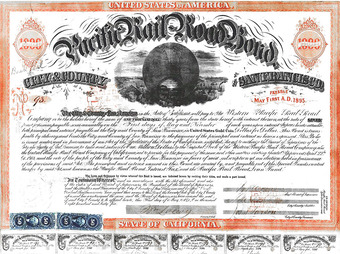
San Francisco Pacific Railroad Bond
A bond is an instrument of indebtedness of the bond issuer to the holders. It is a debt security under which the issuer owes the holders a debt and, depending on the terms of the bond, is obliged to pay them interest (the coupon). In addition, the issuer might have to repay the principal at a later date, which is termed the maturity.
Bonds are bought and traded mostly by institutions like central banks, sovereign wealth funds, pension funds, insurance companies, hedge funds, and banks. Insurance companies and pension funds have liabilities, which essentially include fixed amounts payable on predetermined dates. They buy the bonds to match their liabilities and may be compelled by law to do this. Most individuals who want to own bonds do so through bond funds. Still, in the U.S., nearly 10% of all outstanding bonds are held directly by households.
Advantages of Bonds
Bonds have a clear advantage over other securities. The volatility of bonds (especially short and medium dated bonds) is lower than that of equities (stocks). Thus bonds are generally viewed as safer investments than stocks. In addition, bonds do suffer from less day-to-day volatility than stocks, and the interest payments of bonds are sometimes higher than the general level of dividend payments.
Bonds are often liquid. It is often fairly easy for an institution to sell a large quantity of bonds without affecting the price much, which may be more difficult for equities. In effect, bonds are attractive because of the comparative certainty of a fixed interest payment twice a year and a fixed lump sum at maturity.
Bondholders also enjoy a measure of legal protection: under the law of most countries, if a company goes bankrupt, its bondholders will often receive some money back (the recovery amount), whereas the company’s equity stock often ends up valueless. Furthermore, bonds come with indentures (an indenture is a formal debt agreement that establishes the terms of a bond issue) and covenants (the clauses of such an agreement). Covenants specify the rights of bondholders and the duties of issuers, such as actions that the issuer is obligated to perform or is prohibited from performing.
There are also a variety of bonds to fit different needs of investors, including fixed rated bonds, floating rate bonds, zero coupon bonds, convertible bonds, and inflation linked bonds.
6.5.2: Disadvantages of Bonds
Bonds are subject to risks such as the interest rate risk, prepayment risk, credit risk, reinvestment risk, and liquidity risk.
Learning Objective
Discuss the disadvantages of owning a bond
Key Points
- A bond is an instrument of indebtedness of the bond issuer to the holders. It is a debt security under which the issuer owes the holders a debt and, depending on the terms of the bond, is obliged to pay them interest and possibly repay the principal at a later date, which is termed the maturity.
- Fixed rate bonds are subject to interest rate risk, meaning that their market prices will decrease in value when the generally prevailing interest rates rise.
- Bonds are also subject to various other risks such as call and prepayment risk, credit risk, reinvestment risk, liquidity risk, event risk, exchange rate risk, volatility risk, inflation risk, sovereign risk, and yield curve risk.
- A company’s bondholders may lose much or all their money if the company goes bankrupt. There is no guarantee of how much money will remain to repay bondholders.
- Some bonds are callable. This creates reinvestment risk, meaning the investor is forced to find a new place for his money. As a consequence, the investor might not be able to find as good a deal, especially because this usually happens when interest rates are falling.
Key Terms
- Reinvestment risk
-
The reinvestment risk is the possibility that the investor might be forced to find a new place for his money. As a consequence, the investor might not be able to find as good a deal, especially because this usually happens when interest rates are falling.
- Exchange rate risk
-
The exchange rate risk is a financial risk posed by an exposure to unanticipated changes in the exchange rate between two currencies.
Definition and Purpose of a Bond
A bond is a debt owed by the enterprise to the bondholder. Commercial bonds are normally issued in units of 1,000 dollars. Bondholders receive regular interest on their investment, depending on the terms of the bond. As a safe security, bonds are widely bought and traded by financial institutions. However, bonds have certain disadvantages.
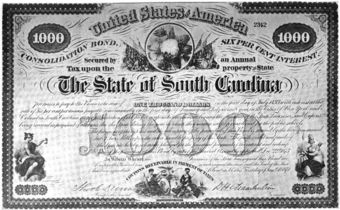
Bond
A bond is a debt owned by the enterprise to the bondholder.
Fixed rate bonds are subject to interest rate risk, meaning that their market prices will decrease in value when the generally prevailing interest rates rise. Since the payments are fixed, a decrease in the market price of the bond means an increase in its yield. When the market interest rate rises, the market price of bonds will fall, reflecting the ability of investors to get a higher interest rate on their money elsewhere — perhaps by purchasing a newly issued bond that already features the newly higher interest rate.
Disadvantages of Bonds
Bonds are also subject to various other risks such as call and prepayment risk, credit risk, reinvestment risk, liquidity risk, event risk, exchange rate risk, volatility risk, inflation risk, sovereign risk, and yield curve risk.
Price changes in a bond will immediately affect mutual funds that hold these bonds. If the value of the bonds in a trading portfolio falls, the value of the portfolio also falls. This can be damaging for professional investors such as banks, insurance companies, pension funds, and asset managers (irrespective of whether the value is immediately “marked to market” or not). If there is any chance a holder of individual bonds may need to sell his bonds and “cash out”, the interest rate risk could become a real problem.
Bond prices can become volatile depending on the credit rating of the issuer – for instance if credit rating agencies like Standard and Poor’s and Moody’s upgrade or downgrade the credit rating of the issuer. An unanticipated downgrade will cause the market price of the bond to fall. As with interest rate risk, this risk does not affect the bond’s interest payments (provided the issuer does not actually default), but puts at risk the market price, which affects mutual funds holding these bonds, and holders of individual bonds who may have to sell them.
A company’s bondholders may lose much or all their money if the company goes bankrupt. Under the laws of many countries (including the United States and Canada), bondholders are in line to receive the proceeds of the sale of the assets of a liquidated company ahead of some other creditors. Bank lenders, deposit holders (in the case of a deposit taking institution such as a bank) and trade creditors may take precedence. There is no guarantee of how much money will remain to repay bondholders. In a bankruptcy involving reorganization or recapitalization, as opposed to liquidation, bondholders may end up having the value of their bonds reduced, often through an exchange for a smaller number of newly issued bonds.
Some bonds are callable, meaning that even though the company has agreed to make payments plus interest toward the debt for a certain period of time, the company can choose to pay off the bond early. This creates reinvestment risk, meaning the investor is forced to find a new place for his money. As a consequence, the investor might not be able to find as good a deal, especially because this usually happens when interest rates are falling.
6.6: Types of Bonds
6.6.1: Government Bonds
A government bond is a bond issued by a national government denominated in the country’s domestic currency.
Learning Objective
Analyze the risks and characteristics of government bonds
Key Points
- A government bond is a bond issued by a national government, generally promising to pay a certain amount (the face value) on a certain date, as well as periodic interest payments. Such bonds are often denominated in the country’s domestic currency.
- In the primary market, Government Bonds are often issued via auctions at Stock Exchanges. In the secondary market, government bonds are traded at Stock Exchanges.
- Although, government bonds are usually referred to as risk-free, there are currency, inflation, and default risks for government bondholders.
Key Terms
- purchasing power
-
Purchasing power (sometimes retroactively called adjusted for inflation) is the amount of goods or services that can be purchased with a unit of currency.
- purchasing power parity
-
a theory of long-term equilibrium exchange rates based on relative price levels of two countries
A government bond is a bond issued by a national government, generally promising to pay a certain amount (the face value) on a certain date as well as periodic interest payments. Such bonds are often denominated in the country’s domestic currency. Government bonds are sometimes regarded as risk-free bonds because national governments can raise taxes or reduce spending up to a certain point. In many cases, they “print more money” to redeem the bond at maturity. Most developed country governments are prohibited by law from printing money directly, that function having been relegated to their central banks. However, central banks may buy government bonds in order to finance government spending, thereby monetizing the debt .

Government Bond
The short-term bond of Kolchak government in 1919 with a face value of 500 rubles.
Bonds issued by national governments in foreign currencies are normally referred to as sovereign bonds. Investors in sovereign bonds denominated in foreign currency have the additional risk that the issuer may be unable to obtain foreign currency to redeem the bonds. For example, in the 2010 Greek debt crisis the debt was held by Greece in Euros. One proposed solution was for Greece to go back to issuing its own Drachma.
In the primary market, Government Bonds are often issued via auctions at Stock Exchanges. There are several different methods of issuing such as auctions, including guarantee, combined auction and guarantee, and others. There are two types of interest rates: fixed and floating. In the secondary market, government bonds are traded at Stock Exchanges. Unlikely equity system, the bond secondary market uses a completely different system with different method of trading. At the secondary market, each bond will be assigned with very own bond code (ISIN code).
Government bonds are usually referred to as risk-free bonds because the government can raise taxes or create additional currency in order to redeem the bond at maturity. Some counter examples do exist where a government has defaulted on its domestic currency debt, such as Russia in 1998 (the “ruble crisis”), although this is very rare (see national bankruptcy). Another example is Greece in 2011. Its bonds were considered very risky, in part because Greece did not have its own currency.
There is currency risk for government bondholders. As an example, in the U.S., Treasury securities are denominated in U.S. dollars. In this instance, the term “risk-free” means free of credit risk. However, other risks still exist, such as currency risk for foreign investors (for example non-U.S. investors of U.S. Treasury securities would have received lower returns in 2004 because the value of the U.S. dollar declined against most other currencies). Secondly, there is inflation risk, in that the principal repaid at maturity will have less purchasing power than anticipated if the inflation rate is higher than expected. Many governments issue inflation-indexed bonds, which protect investors against inflation risk by increasing the interest rate given to the investor as the inflation rate of the economy increases.
6.6.2: Zero-Coupon Bonds
A zero-coupon bond is a bond with no coupon payments, bought at a price lower than its face value, with the face value repaid at the time of maturity.
Learning Objective
Distinguish zero coupon bonds from other types
Key Points
- Zero-coupon bonds may be created from fixed rate bonds by a financial institution separating (“stripping off”) the coupons from the principal. In other words, the separated coupons and the final principal payment of the bond may be traded separately.
- Zero coupon bonds have a duration equal to the bond’s time to maturity, which makes them sensitive to any changes in the interest rates.
- Pension funds and insurance companies like to own long maturity zero-coupon bonds since these bonds’ prices are particularly sensitive to changes in the interest rate and, therefore, offset or immunize the interest rate risk of these firms’ long-term liabilities.
Key Terms
- immunize
-
In finance, interest rate immunization is a strategy that ensures that a change in interest rates will not affect the value of a portfolio. Similarly, immunization can be used to ensure that the value of a pension fund’s or a firm’s assets will increase or decrease in exactly the opposite amount of their liabilities, thus leaving the value of the pension fund’s surplus or firm’s equity unchanged, regardless of changes in the interest rate.
- Pension funds
-
A pension fund is any plan, fund, or scheme which provides retirement income.
Zero coupon bonds were first introduced in 1960s, but they did not become popular until the 1980s. A zero-coupon bond (also called a “discount bond” or “deep discount bond”) is a bond bought at a price lower than its face value, with the face value repaid at the time of maturity. It does not make periodic interest payments, or have so-called “coupons,” hence the term zero-coupon bond. When the bond reaches maturity, its investor receives its par (or face) value. Examples of zero-coupon bonds include U.S. Treasury bills, U.S. savings bonds, and long-term zero-coupon bonds.
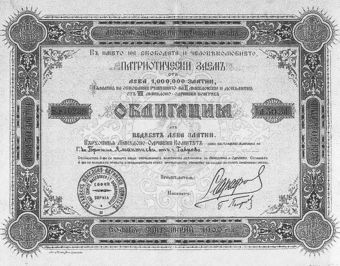
SMAC bond
Bond on VMOK with the signature on Boris Saraf.
Zero-coupon bonds may be created from fixed rate bonds by a financial institution separating (“stripping off”) the coupons from the principal. In other words, the separated coupons and the final principal payment of the bond may be traded separately. Investment banks or dealers separate coupons from the principal of coupon bonds, which is known as the “residue,” so that different investors may receive the principal and each of the coupon payments. This creates a supply of new zero coupon bonds. The coupons and residue are sold separately to investors. Each of these investments then pays a single lump sum. This method of creating zero coupon bonds is known as stripping, and the contracts are known as strip bonds. “STRIPS” stands for Separate Trading of Registered Interest and Principal Securities.
Zero coupon bonds may be long- or short-term investments. Long-term zero coupon maturity dates typically start at 10 to 15 years. The bonds can be held until maturity or sold on secondary bond markets. Short-term zero coupon bonds generally have maturities of less than one year and are called bills. The U.S. Treasury bill market is the most active and liquid debt market in the world.
Zero coupon bonds have a duration equal to the bond’s time to maturity, which makes them sensitive to any changes in the interest rates. The impact of interest rate fluctuations on strip bonds is higher than for a coupon bond.
Pension funds and insurance companies like to own long maturity zero-coupon bonds because of the bonds’ high duration. This high duration means that these bonds’ prices are particularly sensitive to changes in the interest rate and, therefore, offset or immunize the interest rate risk of these firms’ long-term liabilities.
6.6.3: Floating-Rate Bonds
Floating rate bonds are bonds that have a variable coupon equal to a money market reference rate (e.g., LIBOR), plus a quoted spread.
Learning Objective
Describe a floating-rate bond
Key Points
- FRBs are typically quoted as a spread over the reference rate. At the beginning of each coupon period, the coupon is calculated by taking the fixing of the reference rate for that day and adding the spread. A typical coupon would look like three months USD LIBOR +0.20%.
- FRBs carry little interest rate risk. A FRB has a duration close to zero, and its price shows very low sensitivity to changes in market rates. As FRBs are almost immune to interest rate risk. The risk that remains is a credit risk.
- Securities dealers make markets in FRBs. They are traded over the counter, instead of on a stock exchange. In Europe, most FRBs are liquid, as the biggest investors are banks. In the United States, FRBs are mostly held to maturity, so the markets aren’t as liquid.
Key Terms
- duration
-
A measure of the sensitivity of the price of a financial asset to changes in interest rates, computed for a simple bond as a weighted average of the maturities of the interest and principal payments associated with it
- LIBOR
-
The London Interbank Offered Rate is the average interest rate estimated by leading banks in London that they would be charged if borrowing from other banks.
- floating-rate bond
-
a debt instruments with a variable coupon
Floating rate bonds (FRBs) are bonds that have a variable coupon, equal to a money market reference rate, like LIBOR or federal funds rate, plus a quoted spread (i.e., quoted margin). The spread is a rate that remains constant. Almost all FRBs have quarterly coupons (i.e., they pay out interest every three months), though counter examples do exist. At the beginning of each coupon period, the coupon is calculated by taking the fixing of the reference rate for that day and adding the spread. A typical coupon would look like three months USD LIBOR +0.20%.
In the United States, government sponsored enterprises (GSEs), such as the Federal Home Loan Banks, the Federal National Mortgage Association (Fannie Mae), and the Federal Home Loan Mortgage Corporation (Freddie Mac), are important issuers. In Europe, the main issuers are banks.

Municipal bond
Municipal bond issued in 1929 by city of Kraków (Poland).
There are many variations of floating-rate bonds. For instance, some FRBs have special features, such as maximum or minimum coupons, called “capped FRBs” and “floored FRBs. ” Those with both minimum and maximum coupons are called collared FRBs. Perpetual FRBs are another form of FRBs that are also called irredeemable or unrated FRBs and are akin to a form of capital. FRBs can also be obtained synthetically by the combination of a fixed rate bond and an interest rate swap. This combination is known as an “asset swap. “
FRBs carry little interest rate risk. A FRB has a duration close to zero, and its price shows very low sensitivity to changes in market rates. When market rates rise, the expected coupons of the FRB increase in line with the increase in forward rates, which means its price remains constant. Thus, FRBs differ from fixed rate bonds, whose prices decline when market rates rise. As FRBs are almost immune to interest rate risk, they are considered conservative investments for investors who believe market rates will increase. The risk that remains is credit risk.
Securities dealers make markets in FRBs. They are traded over the counter, instead of on a stock exchange. In Europe, most FRBs are liquid, as the biggest investors are banks. In the United States, FRBs are mostly held to maturity, so the markets aren’t as liquid. In the wholesale markets, FRBs are typically quoted as a spread over the reference rate.
6.6.4: Other Types of Bonds
Other bonds include register vs. bearer bonds, convertible bonds, exchangeable bonds, asset-backed securities, and foreign currency bonds.
Learning Objective
Classify the different types of bonds
Key Points
- Bonds directly linked to interest rates include fixed rate bonds, floating rate bonds, and zero coupon bonds.
- Convertible bonds are bonds that let a bondholder exchange a bond to a number of shares of the issuer’s common stock. Exchangeable bonds allows for exchange to shares of a corporation other than the issuer.
- Asset-backed securities are bonds whose interest and principal payments are backed by underlying cash flows from other assets.
- Subordinated bonds are those that have a lower priority than other bonds of the issuer in case of liquidation.
- Foreign currency bonds are issued by companies, banks, governments, and other sovereign entities in foreign currencies, as it may appear to be more stable and predictable than their domestic currency.
Key Terms
- gross domestic product
-
A measure of the economic production of a particular territory in financial capital terms over a specific time period.
- tranches
-
One of a number of related securities offered as part of the same transaction.
- LIBOR
-
The London Interbank Offered Rate is the average interest rate estimated by leading banks in London that they would be charged if borrowing from other banks.
General Categorization
Based on coupon interest rates, bonds can be classified into
- Fixed rate bonds
- Floating rate bonds
- Zero-coupon bonds
Fixed rate bonds have a coupon that remains constant throughout the life of the bond. A variation is a stepped-coupon bonds, whose coupon increases during the life of the bond.
Floating rate notes (FRNs, floaters) have a variable coupon that is linked to a reference rate of interest, such as LIBOR or Euribor. For example the coupon may be defined as three month USD LIBOR + 0.20%. The coupon rate is recalculated periodically, typically every one or three months.
Zero-coupon bonds pay no regular interest. They are issued at a substantial discount to par value, so that the interest is effectively rolled up to maturity (and usually taxed as such). The bondholder receives the full principal amount on the redemption date. Zero-coupon bonds may be created from fixed rate bonds by a financial institution separating (“stripping off”) the coupons from the principal. In other words, the separated coupons and the final principal payment of the bond may be traded separately .

Government Bond
Bond of National Loan issued by Polish National Government in 1863.
Additional Types
There are additional special classes of bonds, including:
Inflation linked bonds (linkers) are those in which the principal amount and the interest payments are indexed to inflation. It is one type of floating rate bond. The interest rate is normally lower than for fixed rate bonds, with a comparable maturity. However, as the principal amount grows, the payments increase with inflation. Treasury Inflation-Protected Securities (TIPS) and I-bonds are examples of inflation linked bonds issued by the U.S. government. There are also other indexed bonds. For example equity-linked notes and bonds indexed on a business indicator (income, added value) or on a country’s gross domestic product (GDP).
Convertible bonds are bonds that let a bondholder exchange a bond for a number of shares of the issuer’s common stock. Exchangeable bonds allows for exchange to shares of a corporation other than the issuer.
Asset-backed securities are bonds whose interest and principal payments are backed by underlying cash flows from other assets. Examples of asset-backed securities are mortgage-backed securities (MBS’s), collateralized mortgage obligations (CMOs), and collateralized debt obligations (CDOs).
Subordinated bonds are those that have a lower priority than other bonds of the issuer in case of liquidation. In case of bankruptcy, there is a hierarchy of creditors. First the liquidator is paid, then government taxes, etc. The first bond holders in line to be paid are those holding what is called senior bonds. After they have been paid, the subordinated bond holders are paid. As a result, the risk is higher. Therefore, subordinated bonds usually have a lower credit rating than senior bonds. The main examples of subordinated bonds can be found in bonds issued by banks and asset-backed securities. The latter are often issued in tranches. The senior tranches get paid back first, the subordinated tranches later.
Perpetual bonds are also often called perpetuities or “perps. ” They have no maturity date. The most famous of these are the UK Consols, which are also known as Treasury Annuities or Undated Treasuries.
A registered bond is a bond whose ownership (and any subsequent purchaser) is recorded by the issuer or by a transfer agent. It is the alternative to a bearer bond. Interest payments, and the principal upon maturity, are sent to the registered owner. On the contrary, a bearer bond is an official certificate issued without a named holder. In other words, the person who has the paper certificate can claim the value of the bond. Often they are registered by a number to prevent counterfeiting, but may be traded like cash. Bearer bonds are very risky because they can be lost or stolen. Especially after federal income tax began in the United States, bearer bonds were seen as an opportunity to conceal income or assets.
A serial bond is a bond that matures in installments over a period of time. In effect, a $100,000, 5-year serial bond would mature in a $20,000 annuity over a 5-year interval.
Some companies, banks, governments, and other sovereign entities may decide to issue bonds in foreign currencies because it may appear to be more stable and predictable than their domestic currency. Issuing bonds denominated in foreign currencies also gives issuers the ability to access investment capital available in foreign markets. Some examples include:
- Eurodollar bond – U.S. dollar-denominated bond issued by a non-U.S. (European) entity.
- U.S. Yankee bond – a US dollar-denominated bond issued by a non-U.S. entity in the U.S. market.
- Samurai bond – a Japanese yen-denominated bond issued by a non-Japanese entity in the Japanese market.
- Bulldog bond – a pound-sterling-denominated bond issued in England by a foreign institution or government.
- Kimchi bond – a Korean won-denominated bond issued by a non-Korean entity in the Korean market.
6.7: Bond Markets
6.7.1: Purchase Process
Most individuals purchase bonds via a broker or through bond funds.
Learning Objective
Describe the process for purchasing a bond
Key Points
- Buying a bond involves setting up an account with a broker and requesting that the broker buy bonds on the buyer’s behalf.
- An individual can also purchase bonds by investing in bond funds, which hold baskets of bonds rather than competing for individual bond sales.
- Most bond funds pay out dividends more frequently than individual bonds.
Key Terms
- hedge funds
-
An investment fund that can undertake a wider range of investment and trading activities than other funds, but which is generally only open to certain types of investors specified by regulators.
- bond funds
-
A bond fund or debt fund is a fund that invests in bonds or other debt securities. Bond funds can be contrasted with stock funds and money funds.
- Pension funds
-
Any plan, fund, or scheme which provides retirement income.
Bonds are bought and traded mostly by institutions like central banks, sovereign wealth funds, pension funds, insurance companies, hedge funds, and banks. Insurance companies and pension funds have liabilities which essentially include fixed amounts payable on predetermined dates. They buy the bonds to match their liabilities, and may be compelled by law to do this. Most individuals who want to own bonds purchase bonds via a broker or do so through bond funds. Still, in the U.S., nearly 10% of all bonds outstanding are held directly by households.
Buying a bond involves setting up an account with a broker and requesting that the broker buy bonds on the buyer’s behalf. Brokers also can furnish considerable market information regarding prices, products, and market conditions. Like with stocks, accounts can be set up with an online discount broker to buy bonds while paying lower transaction fees. It is a good idea to look at several different brokers and their commission rates and services before choosing one. Additionally, bonds can be purchased directly from the U.S. federal government without the use of a broker and without paying broker commission fees.

Bond Brokers
Bonds can be purchased through brokerages, such Fidelity Investments.
An individual can also purchase bonds by investing in bond funds, which hold baskets of bonds rather than competing for individual bond sales. Bond funds typically pay periodic dividends that include interest payments on the fund’s underlying securities plus periodic realized capital appreciation. Bond funds typically pay higher dividends than certificates of deposits (CDs) and money market accounts. Most bond funds pay out dividends more frequently than individual bonds. Fund managers provide dedicated management and save the individual investor from researching issuer creditworthiness, maturity, price, face value, coupon rate, yield, and countless other factors that affect bond investing. Bond funds invest in many individual bonds, so that even a relatively small investment is diversified.
6.7.2: Price Transparency
Since bonds are traded in a decentralized, over-the-counter market dominated by dealers, there can be a lack of price transparency.
Learning Objective
Explain why bond markets may not have price transparency
Key Points
- A market is transparent if much is known–by many–about what products, services, or capital assets are available at what price and where.
- In most developed bond markets, such as the United States, Japan, and western Europe, bonds trade in decentralized, dealer-based, over-the-counter markets.
- Poor transparency contributes to investor differences in bond valuations, as well as other inefficiencies that may lead to economic losses for market participants and, ultimately, inhibit business development.
Key Terms
- market liquidity
-
In business, economics or investment, market liquidity is an asset’s ability to be sold without causing a significant movement in the price and with minimum loss of value.
- transparency
-
(figuratively) openness, degree of accessibility to view
In economics, a market is transparent if much is known–by many– about what products, services, or capital assets are available at what price and where.
There are two types of price transparency:
- Knowing what price will be charged to me
- Knowing what price will be charged to you
The two types of price transparency have different implications for differential pricing. Bond markets, unlike stock or share markets, sometimes do not have a centralized exchange or trading system. Rather, in most developed bond markets such as the United States, Japan, and western Europe, bonds trade in decentralized, dealer-based, over-the-counter markets. This convention, combined with the large number of debt issues outstanding, is largely responsible for the lack of price transparency that exists in the fixed income markets.

New York Stock Exchange
Most bonds are not sold in centralized marketplaces, such as the New York Stock Exchange, leading to a lack of price transparency.
Poor transparency contributes to investor differences in bond valuations, as well as other inefficiencies that may lead to economic losses for market participants, and, ultimately, inhibit business development. In such a market, market liquidity is provided by dealers and other market participants committing risk capital to trading activity. In the bond market, when an investor buys or sells a bond, the counterpart to the trade is almost always a bank or securities firm acting as a dealer. In some cases, when a dealer buys a bond from an investor, the dealer carries the bond “in inventory. ” In other words, the dealer holds it for his own account. The dealer is then subject to risks of price fluctuation. In other cases, the dealer immediately resells the bond to another investor.
Bond markets can also differ from stock markets in that, in some markets, investors sometimes do not pay brokerage commissions to dealers with whom they buy or sell bonds. Rather, the dealers earn revenue by means of the spread, or difference, between the price at which the dealer buys a bond from one investor–the “bid” price–and the price at which he or she sells the same bond to another investor—the “ask” or “offer” price. The bid/offer spread represents the total transaction cost associated with transferring a bond from one investor to another. In summary, since bonds are traded in a decentralized, over-the-counter market dominated by dealers, there is a lack of price transparency for bond markets.
6.8: Valuing Bonds
6.8.1: Present Value of Payments
The value of a bond is obtained by discounting the bond’s expected cash flows to the present using an appropriate discount rate.
Learning Objective
Calculate the present value of an annuity
Key Points
- The bond price can be summarized as the sum of the present value of the par value repaid at maturity and the present value of coupon payments.
- The present value of coupon payments is the present value of an annuity of coupon payments.
- The present value of an annuity is the value of a stream of payments, discounted by the interest rate to account for the payments being made at various moments in the future.
Key Term
- discount rate
-
The interest rate used to discount future cash flows of a financial instrument; the annual interest rate used to decrease the amounts of future cash flow to yield their present value.
The bond price can be calculated using the present value approach. Bond valuation is the determination of the fair price of a bond. As with any security or capital investment, the theoretical fair value of a bond is the present value of the stream of cash flows it is expected to generate. Therefore, the value of a bond is obtained by discounting the bond’s expected cash flows to the present using an appropriate discount rate. In practice, this discount rate is often determined by reference to similar instruments, provided that such instruments exist. The formula for calculating a bond’s price uses the basic present value (PV) formula for a given discount rate .

Bond Price
Bond price is the present value of coupon payments and face value paid at maturity.
F = face value, iF = contractual interest rate, C = F * iF = coupon payment (periodic interest payment), N = number of payments, i = market interest rate, or required yield, or observed / appropriate yield to maturity, M = value at maturity, usually equals face value, and P = market price of bond.
The bond price can be summarized as the sum of the present value of the par value repaid at maturity and the present value of coupon payments. The present value of coupon payments is the present value of an annuity of coupon payments.
An annuity is a series of payments made at fixed intervals of time. The present value of an annuity is the value of a stream of payments, discounted by the interest rate to account for the payments being made at various moments in the future. The present value is calculated by:
i is the number of periods and n is the per period interest rate.
6.8.2: Par Value at Maturity
Par value is stated value or face value, with a typical bond making a repayment of par value at maturity.
Learning Objective
Calculate a bond’s par value
Key Points
- A bond selling at par has a coupon rate such that the bond is worth an amount equivalent to its original issue value or its value upon redemption at maturity.
- A typical bond makes coupon payments at fixed intervals during the life of it and a final repayment of par value at maturity. Together with coupon payments, the par value at maturity is discounted back to the time of purchase to calculate the bond price.
- Par value of a bond usually does not change, except for inflation-linked bonds whose par value is adjusted by inflation rates every predetermined period of time.
Key Term
- inflation-linked bonds
-
Inflation-indexed bonds (also known as inflation-linked bonds or colloquially as linkers) are bonds where the principal is indexed to inflation. They are thus designed to cut out the inflation risk of an investment.
Par value, in finance and accounting, means the stated value or face value. From this comes the expressions at par (at the par value), over par (over par value) and under par (under par value). A bond selling at par has a coupon rate such that the bond is worth an amount equivalent to its original issue value or its value upon redemption at maturity. Corporate bonds usually have par values of $1,000 while municipal bonds generally have face values of $500. Federal government bonds tend to have much higher face values at $10,000.
A typical bond makes coupon payments at fixed intervals during the life of it and a final repayment of par value at maturity. Together with coupon payments, the par value at maturity is discounted back to the time of purchase to calculate the bond price.
Below is the formula for calculating a bond’s price, which uses the basic present value (PV) formula for a given discount rate .

Bond Price Formula
Bond price is the present value of coupon payments and the par value at maturity.
F = face value, iF = contractual interest rate, C = F * iF = coupon payment (periodic interest payment), N = number of payments, i = market interest rate, or required yield, or observed/ appropriate yield to maturity, M = value at maturity, usually equals face value, P = market price of bond.
Par value of a bond usually does not change, except for inflation-linked bonds whose par value is adjusted by inflation rates every predetermined period of time. The coupon payments of such bonds are also accordingly adjusted even though the coupon interest rate is unchanged.
6.8.3: Yield to Maturity
Yield to maturity is the discount rate at which the sum of all future cash flows from the bond are equal to the price of the bond.
Learning Objective
Classify a bond based on its market value and Yield to Maturity
Key Points
- The Yield to maturity is the internal rate of return earned by an investor who bought the bond today at the market price, assuming that the bond will be held until maturity, and that all coupon and principal payments will be made on schedule.
- Yield to maturity(YTM) = [(Face value/Present value)1/Time period]-1.
- If the YTM is less than the bond’s coupon rate, then the market value of the bond is greater than par value (premium bond). If a bond’s coupon rate is less than its YTM, then the bond is selling at a discount. If a bond’s coupon rate is equal to its YTM, then the bond is selling at par.
- There are some variants of YTM: yield to call, yield to put, yield to worst…
Key Terms
- quote
-
To name the current price, notably of a financial security.
- internal rate of return
-
IRR. The rate of return on an investment which causes the net present value of all future cash flows to be zero.
- call premium
-
the additional cost paid by the issuer for the right to buy back the bond at a predtermined price at a certain time in the future
The Yield to maturity (YTM) or redemption yield of a bond or other fixed-interest security, such as gilts, is the internal rate of return (IRR, overall interest rate) earned by an investor who buys the bond today at the market price, assuming that the bond will be held until maturity, and that all coupon and principal payments will be made on schedule .
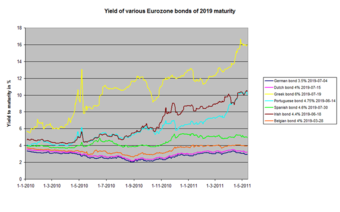
Yield to Maturity
Development of yield to maturity of bonds of 2019 maturity of a number of Eurozone governments.
Contrary to popular belief, including concepts often cited in advanced financial literature, Yield to maturity does not depend upon a reinvestment of dividends. Yield to maturity, rather, is simply the discount rate at which the sum of all future cash flows from the bond (coupons and principal) is equal to the price of the bond. The formula for yield to maturity:
Yield to maturity (YTM) = [(Face value / Present value)1/Time period]-1
The YTM is often given in terms of Annual Percentage Rate (A.P.R.), but usually market convention is followed: in a number of major markets the convention is to quote yields semi-annually (for example, an annual effective yield of 10.25% would be quoted as 5.00%, because 1.05 x 1.05 = 1.1025).
If the yield to maturity for a bond is less than the bond’s coupon rate, then the (clean) market value of the bond is greater than the par value (and vice versa).
- If a bond’s coupon rate is less than its YTM, then the bond is selling at a discount.
- If a bond’s coupon rate is more than its YTM, then the bond is selling at a premium.
- If a bond’s coupon rate is equal to its YTM, then the bond is selling at par.
As some bonds have different characteristics, there are some variants of YTM:
- Yield to call: when a bond is callable (can be repurchased by the issuer before the maturity), the market looks also to the Yield to call, which is the same calculation of the YTM, but assumes that the bond will be called, so the cash flow is shortened.
- Yield to put: same as yield to call, but when the bond holder has the option to sell the bond back to the issuer at a fixed price on specified date.
- Yield to worst: when a bond is callable, puttable, exchangeable, or has other features, the yield to worst is the lowest yield of yield to maturity, yield to call, yield to put, and others.
For instance, you buy ABC Company bond which matures in 1 year and has a 5% interest rate (coupon) and has a par value of $100. You pay $90 for the bond. The current yield is 5.56% ((5/90)*100). If you hold the bond until maturity, ABC Company will pay you $5 as interest and $100 par value for the matured bond. Now for your $90 investment, you get $105, so your yield to maturity is 16.67% [= (105/90)-1] or [=(105-90)/90].
6.8.4: Inflation Premium
An inflation premium is the part of prevailing interest rates that results from lenders compensating for expected inflation.
Learning Objective
Explain how to determine and use an inflation premium
Key Points
- Investors seek this premium to compensate for the erosion in the value of their capital due to inflation.
- Actual interest rates (without factoring in inflation) are viewed by economists and investors as being the nominal (stated) interest rate minus the inflation premium.
- Letting r denote the real interest rate, i denote the nominal interest rate, and let π denote the inflation rate, the Fisher equation is: i = r + π. In the Fisher equation, π is the inflation premium.
Key Term
- systematic risks
-
In finance and economics, systematic risk (sometimes called aggregate risk, market risk, or undiversifiable risk) is vulnerability to events which affect aggregate outcomes such as broad market returns, total economy-wide resource holdings, or aggregate income.
An inflation premium is the part of prevailing interest rates that results from lenders compensating for expected inflation by pushing nominal interest rates to higher levels.
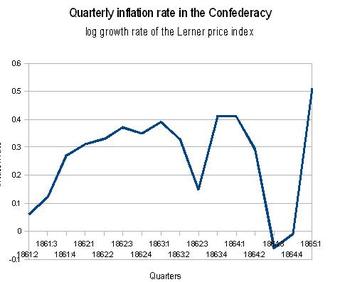
Inflation rate graph
Inflation rate in the Confederacy during the American Civil War.
In economics and finance, an individual who lends money for repayment at a later point in time expects to be compensated for the time value of money, or not having the use of that money while it is lent. In addition, they will want to be compensated for the risks of the money having less purchasing power when the loan is repaid. These risks are systematic risks, regulatory risks and inflationary risks. The first includes the possibility that the borrower will default or be unable to pay on the originally agreed upon terms, or that collateral backing the loan will prove to be less valuable than estimated. The second includes taxation and changes in the law which would prevent the lender from collecting on a loan or having to pay more in taxes on the amount repaid than originally estimated. The third takes into account that the money repaid may not have as much buying power from the perspective of the lender as the money originally lent, that is inflation, and may include fluctuations in the value of the currencies involved. The inflation premium will compensate for the third risk, so investors seek this premium to compensate for the erosion in the value of their capital, due to inflation.
Actual interest rates (without factoring in inflation) are viewed by economists and investors as being the nominal (stated) interest rate minus the inflation premium.
The Fisher equation in financial mathematics and economics estimates the relationship between nominal and real interest rates under inflation. In economics, this equation is used to predict nominal and real interest rate behavior. Letting r denote the real interest rate, i denote the nominal interest rate, and let π denote the inflation rate, the Fisher equation is: i = r + π. In the Fisher equation, π is the inflation premium.
For example, if an investor were able to lock in a 5% interest rate for the coming year and anticipates a 2% rise in prices, he would expect to earn a real interest rate of 3%. 2% is the inflation premium. This is not a single number, as different investors have different expectations of future inflation.
Since the inflation rate over the course of a loan is not known initially, volatility in inflation represents a risk to both the lender and the borrower.
6.8.5: Differences Between Real and Nominal Rates
Nominal rate refers to the rate before adjustment for inflation; the real rate is the nominal rate minus inflation: r = R – i or, 1+r = (1+r)(1+E(r)).
Learning Objective
Differentiate between real and nominal interest rates
Key Points
- Nominal rate refers to the rate before adjustment for inflation; the real rate is the nominal rate minus inflation.
- Fisher equation states that the real interest rate is approximately the nominal interest rate minus the inflation rate: 1 + i = (1+r) (1+E(r)).
- Simple equation between nominal rates and real rates: i = R – r.
Key Term
- purchasing power
-
Purchasing power (sometimes retroactively called adjusted for inflation) is the amount of goods or services that can be purchased with a unit of currency.
In finance and economics, nominal rate refers to the rate before adjustment for inflation (in contrast with the real rate). The real rate is the nominal rate minus inflation. In the case of a loan, it is this real interest that the lender receives as income. If the lender is receiving 8% from a loan and inflation is 8%, then the real rate of interest is zero, because nominal interest and inflation are equal. A lender would have no net benefit from such a loan because inflation fully diminishes the value of the loan’s profit.
The relationship between real and nominal rates can be described in the equation:

Real and nominal
The relationship between real and nominal interest rates is captured by the formula.
Where r is the real rate, i is the inflation rate, and R is the nominal rate.
The real rate can be described more formally by the Fisher equation, which states that the real interest rate is approximately the nominal interest rate minus the inflation rate: 1 + i = (1+r) (1+E(r)), where i = nominal interest rate; r = real interest rate; E(r) = expected inflation rate.
For example, if somebody lends $1,000 for a year at 10%, and receives $1,100 back at the end of the year, this represents a 10% increase in his purchasing power if prices for the average goods and services that he buys are unchanged from what they were at the beginning of the year. However, if the prices of the food, clothing, housing, and other things that he wishes to purchase have increased 20% over this period, he has in fact suffered a real loss of about 12% in his purchasing power.
In this analysis, the nominal rate is the stated rate, and the real rate is the rate after the expected losses due to inflation. Since the future inflation rate can only be estimated, the ex ante and ex post (before and after the fact) real rates may be different; the premium paid to actual inflation may be higher or lower.
6.8.6: Time to Maturity
“Time to maturity” refers to the length of time before the par value of a bond must be returned to the bondholder.
Learning Objective
Discuss the importance of a bond’s maturity when determining its value
Key Points
- The maturity can be any length of time, but debt securities with a term of less than one year are generally not designated as bonds. Instead, they are considered money market instruments.
- In the market for United States Treasury securities, there are three categories of bond maturities: short-term, medium-term and long-term bonds.
- A bond that takes longer to mature necessarily has a greater duration. The bond price in this type of a situation, therefore, is more sensitive to changes in interest rates.
Key Terms
- duration
-
A measure of the sensitivity of the price of a financial asset to changes in interest rates, computed for a simple bond as a weighted average of the maturities of the interest and principal payments associated with it
- money market
-
A market for trading short-term debt instruments, such as treasury bills, commercial paper, bankers’ acceptances, and certificates of deposit
Time to Maturity
“Time to maturity” refers to the length of time that can elapse before the par value (face value) for a bond must be returned to a bondholder. This time may be as short as a few months, or longer than 50 years. Once this time has been reached, the bondholder should receive the par value for their particular bond.
The issuer of a bond has to repay the nominal amount for that bond on the maturity date. After this date, as long as all due payments have been made, the issuer will have no further obligations to the bondholders. The length of time until a bond’s matures is referred to as its term, tenor, or maturity. These dates can technically be any length of time, but debt securities with a term of less than one year are generally not designated as bonds. Instead, they are designated as money market instruments .

Money market interest rates
Interest rates of one-month maturity of German banks from 1967 to 2003
Most bonds have a term of up to 30 years. That being said, bonds have been issued with terms of 50 years or more, and historically, issues have arisen where bonds completely lack maturity dates (irredeemables). In the market for United States Treasury securities, there are three categories of bond maturities:
- Short term (bills): maturities between one to five years (Instruments that mature in less than one year are considered Money Market Instruments. )
- Medium term (notes): maturities between six to twelve years
- Long term (bonds): maturities greater than twelve years
Because bonds with long maturities necessarily have long durations, the bond prices in these situations are more sensitive to interest rate changes. In other words, the price risk of such bonds is higher. The fair price of a “straight bond,” a bond with no embedded options, is usually determined by discounting its expected cash flows at the appropriate discount rate. Although this present value relationship reflects the theoretical approach to determining the value of a bond, in practice, the price is (usually) determined with reference to other, more liquid instruments.
In general, coupon and par value being equal, a bond with a short time to maturity will trade at a higher value than one with a longer time to maturity. This is because the par value is discounted at a higher rate further into the future.
Finally, it is important to recognize that future interest rates are uncertain, and that the discount rate is not adequately represented by a single fixed number (this would be the case if an option was written on the bond in question) stochastic calculus may be employed. Where the market price of a bond is less than its face value (par value), the bond is selling at a discount. Conversely, if the market price of bond is greater than its face value, the bond is selling at a premium.
6.8.7: Calculating Yield to Maturity Using the Bond Price
The yield to maturity is the discount rate that returns the bond’s market price: YTM = [(Face value/Bond price)1/Time period]-1.
Learning Objective
Calculate a bond’s yield to maturity
Key Points
- To achieve a return equal to YTM (i.e., where it is the required return on the bond), the bond owner must buy the bond at price P0, hold the bond until maturity, and redeem the bond at par.
- If a bond’s coupon rate is less than its YTM, then the bond is selling at a discount. If a bond’s coupon rate is more than its YTM, then the bond is selling at a premium. If a bond’s coupon rate is equal to its YTM, then the bond is selling at par.
- Formula for yield to maturity: Yield to maturity(YTM) = [(Face value/Bond price)1/Time period]-1.
Key Term
- discount rate
-
The interest rate used to discount future cash flows of a financial instrument; the annual interest rate used to decrease the amounts of future cash flow to yield their present value.
YTM
The yield to maturity is the discount rate which returns the market price of the bond. YTM is the internal rate of return of an investment in the bond made at the observed price.
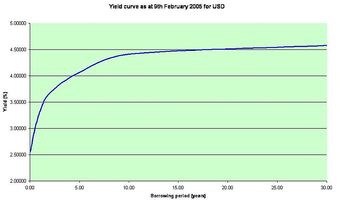
USD Yield Curve
2005 USD yield curve
To achieve a return equal to YTM (i.e., where it is the required return on the bond), the bond owner must buy the bond at price P0, hold the bond until maturity, and redeem the bond at par.
If the yield to maturity for a bond is less than the bond’s coupon rate, then the (clean) market value of the bond is greater than the par value (and vice versa). If a bond’s coupon rate is less than its YTM, then the bond is selling at a discount. If a bond’s coupon rate is more than its YTM, then the bond is selling at a premium. If a bond’s coupon rate is equal to its YTM, then the bond is selling at par.
Calculating YTM
Formula for yield to maturity: Yield to maturity(YTM) = [(Face value/Bond price)1/Time period]-1
As can be seen from the formula, the yield to maturity and bond price are inversely correlated.
Consider a 30-year, zero-coupon bond with a face value of $100. If the bond is priced at an annual YTM of 10%, it will cost $5.73 today (the present value of this cash flow, 100/(1.1)30 = 5.73). Over the coming 30 years, the price will advance to $100, and the annualized return will be 10%.
What happens in the meantime? Suppose that over the first 10 years of the holding period, interest rates decline, and the yield-to-maturity on the bond falls to 7%. With 20 years remaining to maturity, the price of the bond will be 100/1.0720, or $25.84. Even though the yield-to-maturity for the remaining life of the bond is just 7%, and the yield-to-maturity bargained for when the bond was purchased was only 10%, the return earned over the first 10 years is 16.25%. This can be found by evaluating (1+i) from the equation (1+i)10 = (25.842/5.731), giving 1.1625.
Over the remaining 20 years of the bond, the annual rate earned is not 16.25%, but rather 7%. This can be found by evaluating (1+i) from the equation (1+i)20 = 100/25.84, giving 1.07. Over the entire 30 year holding period, the original $5.73 invested increased to $100, so 10% per annum was earned, irrespective of any interest rate changes in between.
6.8.8: Impact of Payment Frequency on Bond Prices
Payment frequency can be annual, semi annual, quarterly, or monthly; the more frequently a bond makes coupon payments, the higher the bond price.
Learning Objective
Calculate the price of a bond
Key Points
- Payment frequency can be annual, semi annual, quarterly, monthly, weekly, daily, or continuous.
- Bond price is the sum of the present value of face value paid back at maturity and the present value of an annuity of coupon payments. The present value of face value received at maturity is the same. However, the present values of annuities of coupon payments vary among payment frequencies.
- The more frequent a bond makes coupon payments, the higher the bond price, given equal coupon, par, and face.
Key Term
- annuity
-
A specified income payable at stated intervals for a fixed or a contingent period, often for the recipient’s life, in consideration of a stipulated premium paid either in prior installment payments or in a single payment. For example, a retirement annuity paid to a public officer following his or her retirement.
The payment schedule of financial instruments defines the dates at which payments are made by one party to another on, for example, a bond or a derivative. It can be either customised or parameterized. Payment frequency can be annual, semi annual, quarterly, monthly, weekly, daily, or continuous.
Bond prices is the present value of all coupon payments and the face value paid at maturity. The formula to calculate bond prices:

Bond price formula
Bond price is the present value of all coupon payments and the face value paid at maturity.
F = face value, iF = contractual interest rate, C = F * iF = coupon payment (periodic interest payment), N = number of payments, i = market interest rate, or required yield, or observed / appropriate yield to maturity, M = value at maturity, usually equals face value, P = market price of bond.
In other words, bond price is the sum of the present value of face value paid back at maturity and the present value of an annuity of coupon payments. For bonds of different payment frequencies, the present value of face value received at maturity is the same. However, the present values of annuities of coupon payments vary among payment frequencies.
The present value of an annuity is the value of a stream of payments, discounted by the interest rate to account for the payments are being made at various moments in the future. The formula is:

Annuity formula
The formula to calculate PV of annuities.
Where n is the number of terms or number of payments n =1 (annually), n = 2 (semi-annually), n = 4 (quarterly)… and i is the per period interest rate.
According to the formula, the greater n, the greater the present value of the annuity (coupon payments). To put it differently, the more frequent a bond makes coupon payments, the higher the bond price.
6.8.9: Deciding to Refund Bonds
Refunding occurs when an entity that has issued callable bonds calls those debt securities to issue new debt at a lower coupon rate.
Learning Objective
Explain when to refund a debt issue
Key Points
- The issue of new, lower-interest debt allows the company to prematurely refund the older, higher-interest debt.
- Bond refunding occurs when a) interest rates in the market are sufficiently less than the coupon rate on the old bond, b) the price of the old bond is less than par. and c) the sinking fund has accumulated enough money to retire the bond issue.
- The decision of whether to refund a particular debt issue is usually based on a capital budgeting (present value) analysis.
Key Term
- sinking fund
-
A sinking fund is a fund established by a government agency or business for the purpose of reducing debt by repaying or purchasing outstanding loans and securities held against the entity. It helps keep the borrower liquid so it can repay the bondholder.
Refunding occurs when an entity that has issued callable bonds calls those debt securities from the debt holders with the express purpose of reissuing new debt at a lower coupon rate. In essence, the issue of new, lower-interest debt allows the company to prematurely refund the older, higher-interest debt. On the contrary, nonrefundable bonds may be callable, but they cannot be re-issued with a lower coupon rate (i.e., they cannot be refunded).

French Bond
French Bond for the Akhtala mines issued in 1887.
The decision of whether to refund a particular debt issue is usually based on a capital budgeting (present value) analysis. The principal benefit, or cash inflow, is the present value of the after-tax interest savings over the life of the issue.
Bond refunding occurs when all three of the following are true
- Interest rates in the market are sufficiently less than the coupon rate on the old bond
- The price of the old bond is less than par
- The sinking fund has accumulated enough money to retire the bond issue.
The three steps of whether to make a refunding decision are as follows:
Step 1: Calculate the present value of interest savings (cash inflows):
Interest savings = annual interest of old issue – annual interest of new issue
Step 2: Calculate the net investment (net cash outflow at time 0). This involves computing the after-tax call premium, the issuance cost of the new issue, the issuance cost of the old issue, and the overlapping interest. The call premium is a cash outflow.
Step 3: Finally, calculate the net present value of refunding.
Net present value of refunding = Present value of interest savings – Present value of net investment
6.9: Bond Risk
6.9.1: Price Risk
Price risk is the risk that the market price of a bond will fall, usually due to a rise in the market interest rate.
Learning Objective
Identify a bond’s price risk
Key Points
- The market price of bonds will decrease in value when the generally prevailing interest rates rise and vice versa.
- Unless you plan to buy or sell them in the open market, changing interest rates do not affect the interest payments to the bondholder.
- Price changes in a bond will immediately affect mutual funds that hold these bonds. If the value of the bonds in their trading portfolio falls, the value of the portfolio also falls.
Key Term
- mutual funds
-
A type of professionally-managed collective investment vehicle that pools money from many investors to purchase securities. While there is no legal definition, the term is most commonly applied only to those collective investment vehicles that are regulated, available to the general public and open-ended in nature.
Interest rates and bond prices carry an inverse relationship. Bond price risk is closely related to fluctuations in interest rates. Fixed-rate bonds are subject to interest rate risk, meaning that their market prices will decrease in value when the generally prevailing interest rates rise. Since the payments are fixed, a decrease in the market price of the bond means an increase in its yield. When the market interest rate rises, the market price of bonds will fall, reflecting investors’ ability to get a higher interest rate on their money elsewhere — perhaps by purchasing a newly-issued bond that already features the new higher interest rate. On the flip side, if the prevailing interest rate were on the decline, investors would naturally buy bonds that pay lower rates of interest. This would force bond prices up.
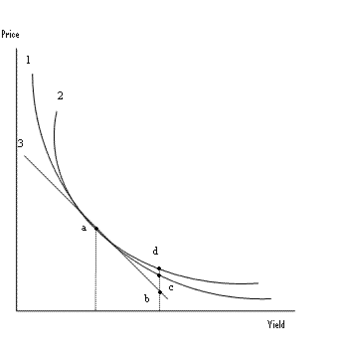
Bond price and yield
Several curves depicting the inverse relationship between bond price and yield (interest rates).
Unless you plan to buy or sell them in the open market, changing interest rates do not affect the interest payments to the bondholder, so long-term investors who want a specific amount at the maturity date do not need to worry about price swings in their bonds and do not suffer from interest rate risk. However, because of the interest rate risk, bonds with longer terms are more risky than bonds with shorter terms.
Price changes in a bond will immediately affect mutual funds that hold these bonds. If the value of the bonds in their trading portfolio falls, the value of the portfolio also falls. This can be damaging for professional investors such as banks, insurance companies, pension funds and asset managers (irrespective of whether the value is immediately “marked to market” or not). If there is any chance a holder of individual bonds may need to sell his bonds and “cash out”, interest rate risk could become a real problem.
Bond prices can become volatile depending on the credit rating of the issuer – for instance if the credit rating agencies like Standard & Poor’s and Moody’s upgrade or downgrade the credit rating of the issuer. An unanticipated downgrade will cause the market price of the bond to fall. As with interest rate risk, this risk does not affect the bond’s interest payments (provided the issuer does not actually default), but puts at risk the market price, which affects mutual funds holding these bonds, and holders of individual bonds who may have to sell them.
6.9.2: Reinvestment Risk
Reinvestment risk is the risk that a bond is repaid early, and an investor has to find a new place to invest with the risk of lower returns.
Learning Objective
Define reinvestment risk
Key Points
- Reinvestment risk is more likely when interest rates are declining.
- Reinvestment risk affects the yield-to-maturity of a bond, which is calculated on the premise that all future coupon payments will be reinvested at the interest rate in effect when the bond was first purchased.
- Two factors that have a bearing on the degree of reinvestment risk are maturity of the bond and the coupon interest rate.
Key Term
- Yield to maturity
-
The Yield to maturity (YTM) or redemption yield of a bond or other fixed-interest security, such as gilts, is the internal rate of return (IRR, overall interest rate) earned by an investor who buys the bond today at the market price, assuming that the bond will be held until maturity, and that all coupon and principal payments will be made on schedule.
Reinvestment risk is one of the main genres of financial risk. The term describes the risk that a particular investment might be canceled or stopped somehow, and that one may have to find a new place to invest their money with the risk being there might not be a similarly attractive investment available. This primarily occurs if bonds (which are portions of loans to entities) are paid back earlier than expected.
The risk resulting from the fact that interest or dividends earned from an investment may not be able to be reinvested in such a way that they earn the same rate of return as the invested funds that generated them. Reinvestment risk is more likely when interest rates are declining. For example, falling interest rates may prevent bond coupon payments from earning the same rate of return as the original bond. Pension funds are also subject to reinvestment risk. Especially with the short-term nature of cash investments, there is always the risk that future proceeds will have to be reinvested at a lower interest rate.
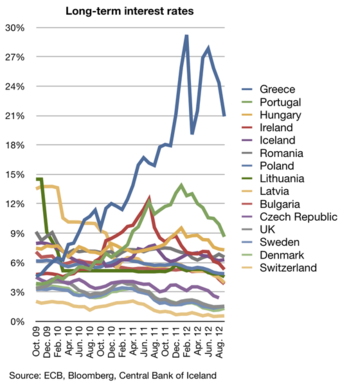
Interest rates
Reinvestment risk is more likely when interest rates are declining.
Reinvestment risk affects the yield-to-maturity of a bond, which is calculated on the premise that all future coupon payments will be reinvested at the interest rate in effect when the bond was first purchased.
Two factors that have a bearing on the degree of reinvestment risk are:
Maturity of the bond – The longer the maturity of the bond, the higher the likelihood that interest rates will be lower than they were at the time of the bond purchase.
Interest rate on the bond – The higher the interest rate, the bigger the coupon payments that have to be reinvested, and, consequently, the reinvestment risk. Zero coupon bonds are the only fixed-income instruments to have no reinvestment risk, since they have no interim coupon payments.
6.9.3: Comparing Price Risk and Reinvestment Risk
Price risk is positively correlated to changes in interest rates, while reinvestment risk is inversely correlated.
Learning Objective
Differentiate between price risk and reinvestment risk
Key Points
- Price risk and reinvestment risk are both the uncertainty associated with the effects of changes in market interest rates.
- Price risk and changes in interest rates are positively correlated.
- Reinvestment risk and changes in interest rates are inversely correlated.
Key Term
- duration
-
A measure of the sensitivity of the price of a financial asset to changes in interest rates, computed for a simple bond as a weighted average of the maturities of the interest and principal payments associated with it
Overview
Price risk and reinvestment risk both represent the uncertainty associated with the effects of changes in market interest rates. Both types of interest rate risks are important considerations in investments, corporate financial planning, and banking.
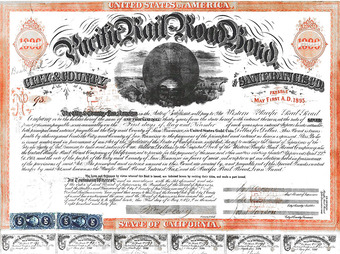
Pacific Railroad Bond
$1,000 (30 year, 7%) “Pacific Railroad Bond” (#93 of 200) issued by the City and County of San Francisco.
Price Risk
Price risk is the uncertainty associated with potential changes in the price of an asset caused by changes in interest rate levels in the economy. The price risk is sometimes referred to as maturity risk since the greater the maturity of an investment (the greater the duration), the greater the change in price for a given change in interest rates. Bond market prices will decrease in value when the generally prevailing interest rates rise (price risk is on the rise). Since the payments are fixed, a decrease in the market price of the bond means an increase in its yield. When the market interest rate rises, the market price of bonds will fall, reflecting investors’ ability to get a higher interest rate on their money elsewhere — perhaps by purchasing a newly issued bond that already features the newly higher interest rate. When interest rates fall, bond prices increase, and there is less price risk. To sum up, price risk and interest rates are positively correlated.
Reinvestment Risk
Reinvestment risk is the risk that a particular investment might be canceled or stopped somehow, and that one may have to find a new place to invest their money with the risk that there might not be a similarly attractive investment available. This primarily occurs if bonds (which are portions of loans to entities) are paid back earlier than expected. When interest rates increase, there is less likelihood that a bond is called and paid back before maturity. So there is little reinvestment risk. When interest rates decrease, there is more likelihood that the bond is called and paid back earlier than expected. There is, accordingly, more reinvestment risk. Reinvestment risk and interest rates are inversely correlated.
Discussion
In summary, price risk and reinvestment risk are two main financial risks resulting from changes in interest rates. The former is positively correlated to interest rates, while reinvestment risk is inversely correlated to fluctuations in interest rates.
6.9.4: Default Risk
Default risk is the risk that a bond issuer will default on any type of debt by failing to make payments which it is obligated to make.
Learning Objective
Define default risk
Key Points
- With default risk, the risk is primarily that of the bondholder and includes lost principal and interest, disruption to cash flows, and increased collection costs.
- To reduce the bondholders’ credit risk, the lender may perform a credit check on the prospective borrower and may require the issuer to take out appropriate insurance.
- A company’s bondholders may lose much or all their money if the company goes bankrupt. There is no guarantee of how much money will remain to repay bondholders.
Key Terms
- liquidated
-
In law, liquidation is the process by which a company (or part of a company) is brought to an end and the assets and property of the company redistributed.
- insolvent
-
Unable to pay one’s bills as they fall due.
Default risk (or credit risk) of a bond refers to the risk that a bond issuer will default on any type of debt by failing to make payments which it is obligated to do. The risk is primarily that of the bondholder and includes lost principal and interest, disruption to cash flows, and increased collection costs. The loss may be complete or partial and can arise in a number of circumstances. For example, a company is unable to repay amounts secured by a fixed or floating charge over the assets of the company, a business or consumer does not pay a trade invoice when due, a business does not pay an employee’s earned wages when due, a business or government bond issuer does not make a payment on a coupon or principal payment when due, an insolvent insurance company does not pay a policy obligation, and an insolvent bank won’t return funds to a depositor .
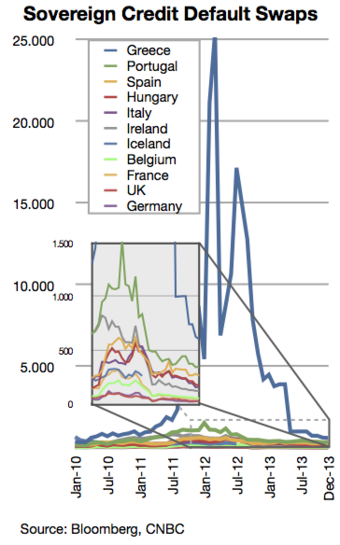
Prices of sovereign credit default swaps
Credit default swaps are an instrument to protect against default risk. This image shows the monthly prices of sovereign credit default swaps from January 2010 till September 2011 of Greece, Portugal, Ireland, Hungary, Italy, Spain, Belgium, France, Germany, and the UK (Greece is illustrated by blue line). Higher credit default swap prices mean that investors perceive a higher risk of default.
To reduce the bondholders’ credit risk, the lender may perform a credit check on the prospective borrower, may require the issuer to take out appropriate insurance, such as mortgage insurance or seek security or guarantees of third parties, besides other possible strategies. In general, the higher the risk, the higher will be the interest rate that the issuer will have to pay.
A company’s bondholders may lose much or all their money if the company goes bankrupt. Under the laws of many countries (including the United States and Canada), bondholders are in line to receive the proceeds of the sale of the assets of a liquidated company ahead of some other creditors. Bank lenders, deposit holders (in the case of a deposit taking institution such as a bank), and trade creditors may take precedence.
There is no guarantee of how much money will remain to repay bondholders. As an example, after an accounting scandal and a Chapter 11 bankruptcy at the giant telecommunications company Worldcom, in 2004 its bondholders ended up being paid 35.7 cents on the dollar. In a bankruptcy involving reorganization or recapitalization, as opposed to liquidation, bondholders may end up having the value of their bonds reduced, often through an exchange for a smaller number of newly issued bonds.
6.9.5: Bond Rating System
The credit rating is a financial indicator assigned by credit rating agencies; bond ratings below BBB-/Baa are considered junk bonds.
Learning Objective
Discuss the role of NRSROs in the bond market
Key Points
- In investment, the bond credit rating assesses the credit worthiness of a corporation’s or government debt issues.
- The credit rating is a financial indicator to potential investors of debt securities, such as bonds. These are assigned by credit rating agencies such as Moody’s, Standard & Poor’s, and Fitch Ratings to have letter designations (such as AAA, B, CC) which represent the quality of a bond.
- Bond ratings below BBB-/Baa are considered not to be investment grade and are colloquially called junk bonds.
Key Term
- asset-backed securities
-
An asset-backed security is a security that has value and income payments derived from and collateralized (or “backed”) by a specified pool of underlying assets. The pool of assets is typically a group of small and illiquid assets that are unable to be sold individually.
In investment, the bond credit rating assesses the credit worthiness of a corporation’s or government’s debt issues. It is analogous to credit ratings for individuals.The credit rating is a financial indicator to potential investors of debt securities, such as bonds. These are assigned by credit rating agencies such as Moody’s, Standard & Poor’s, and Fitch Ratings to have letter designations (such as AAA, B, CC), which represent the quality of a bond. Bond ratings below BBB-/Baa are considered to be not investment grade and are colloquially called “junk bonds. “
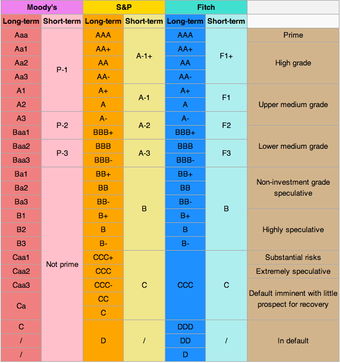
Bond rating
Bond ratings below BBB-/Baa are considered to be not investment grade and are colloquially called “junk bonds. “
Credit rating agencies registered as such with the SEC are “Nationally recognized statistical rating organizations. ” The following firms are currently registered as NRSROs: A.M. Best Company, Inc.; DBRS Ltd.; Egan-Jones Rating Company; Fitch, Inc.; Japan Credit Rating Agency, Ltd.; LACE Financial Corp.; Moody’s Investors Service, Inc.; Rating and Investment Information, Inc.; and Standard & Poor’s Ratings Services.
Under the Credit Rating Agency Reform Act, an NRSRO may be registered with respect to up to five classes of credit ratings: (1) financial institutions, brokers, or dealers; (2) insurance companies; (3) corporate issuers; (4) issuers of asset-backed securities; and (5) issuers of government securities, municipal securities, or securities issued by a foreign government. S&P, Moody’s, and Fitch dominate the market with approximately 90-95% of world market share.
Moody’s assigns bond credit ratings of Aaa, Aa, A, Baa, Ba, B, Caa, Ca, C, with WR and NR as withdrawn and not rated. Standard & Poor’s and Fitch assign bond credit ratings of AAA, AA, A, BBB, BB, B, CCC, CC, C, and D.
A bond is considered investment grade or IG if its credit rating is BBB- or higher by Standard & Poor’s or Baa3 or higher by Moody’s or BBB (low) or higher by DBRS. Generally, they are bonds that are judged by the rating agency as likely enough to meet payment obligations that banks are allowed to invest in them. Ratings play a critical role in determining how much companies and other entities that issue debt, including sovereign governments, have to pay to access credit markets (i.e., the amount of interest they pay on their issued debt). The threshold between investment-grade and speculative-grade ratings has important market implications for issuers’ borrowing costs. Bonds that are not rated as investment-grade bonds are known as high-yield bonds or more derisively as junk bonds. The risks associated with investment-grade bonds (or investment-grade corporate debt) are considered significantly higher than those associated with first-class government bonds.
6.9.6: Bankruptcy and Bond Value
There is no guarantee of how much money will remain to repay bondholders in a bankruptcy, therefore, the value of the bond is uncertain.
Learning Objective
Identify which stakeholders take precedence in receiving cash from a bankrupt business
Key Points
- When a business is unable to service its debt or pay its creditors, it or its creditors can file with a federal bankruptcy court for protection under either Chapter 7 or Chapter 11 of the Bankruptcy code.
- If a company goes bankrupt, its bondholders will often receive some money back (the recovery amount).
- In a bankruptcy involving reorganization or recapitalization, as opposed to liquidation, bondholders may end up having the value of their bonds reduced, often through an exchange for a smaller number of newly-issued bonds.
Key Terms
- recapitalization
-
A restructuring of a company’s mixture of equity and debt.
- liquidation
-
The selling of the assets of a business as part of the process of dissolving the business.
A company’s bondholders may lose much or all their money if the company goes bankrupt. Under the laws of many countries (including the United States and Canada), bondholders are in line to receive the proceeds of the sale of the assets of a liquidated company ahead of some other creditors.
Bank lenders, deposit holders (in the case of a deposit-taking institution such as a bank) and trade creditors may take precedence. However, compared to equity holders, bondholders also enjoy a measure of legal protection: under the law of most countries, if a company goes bankrupt, its bondholders will often receive some money back (the recovery amount), whereas the company’s equity stock often ends up valueless.
When a business is unable to service its debt or pay its creditors, the business or its creditors can file with a federal bankruptcy court for protection under either Chapter 7 or Chapter 11 of the Bankruptcy code. In Chapter 7, the business ceases operations, a trustee sells all of its assets, and then distributes the proceeds to its creditors. Any residual amount is returned to the owners of the company. In Chapter 11, in most instances, the debtor remains in control of its business operations as a debtor in possession, and is subject to the oversight and jurisdiction of the court.

Bankruptcy Courthouse
Old U.S. Post Office and Court House, now used by the U.S. Bankruptcy Court for the Northern District of Florida.
There is no guarantee of how much money will remain to repay bondholders, therefore, the value of the bond is uncertain. As an example, after an accounting scandal and a chapter 11 bankruptcy at the giant telecommunications company Worldcom in 2004, its bondholders ended up being paid 35.7 cents on the dollar. In a bankruptcy involving reorganization or recapitalization, as opposed to liquidation, bondholders may end up having the value of their bonds reduced, often through an exchange for a smaller number of newly-issued bonds.
Chapter 5: The Time Value of Money
5.1: Introduction to the Time Value of Money
5.1.1: Defining the Time Value of Money
The Time Value of Money is the concept that money is worth more today that it is in the future.
Learning Objective
Identify the variables that are used to calculate the time value of money
Key Points
- Being given $100 today is better than being given $100 in the future because you don’t have to wait for your money.
- Money today has a value (present value, or PV) and money in the future has a value (future value, or FV).
- The amount that the value of the money changes after one year is called the interest rate (i). For example, if money today is worth 10% more in one year, the interest rate is 10%.
Key Terms
- Interest Rate (i or r)
-
The cost of not having money for one period, or the amount paid on an investment per year.
- Present Value (PV)
-
The value of the money today.
- Future Value (FV)
-
The value of the money in the future.
One of the most fundamental concepts in finance is the Time Value of Money. It states that money today is worth more than money in the future.
Imagine you are lucky enough to have someone come up to you and say “I want to give you $500. You can either have $500 right now, or I can give you $500 in a year. What would you prefer? ” Presumably, you would ask to have the $500 right now. If you took the money now, you could use it to buy a TV. If you chose to take the money in one year, you could still use it to buy the same TV, but there is a cost. The TV might not be for sale, inflation may mean that the TV now costs $600, or simply, you would have to wait a year to do so and should be paid for having to wait. Since there’s no cost to taking the money now, you might as well take it.
There is some value, however, that you could be paid in one year that would be worth the same to you as $500 today. Say it’s $550- you are completely indifferent between taking $500 today and $550 next year because even if you had to wait a year to get your money, you think $50 is worth waiting.
In finance, there are special names for each of these numbers to help ensure that everyone is talking about the same thing. The $500 you get today is called the Present Value (PV). This is what the money is worth right now. The $550 is called the Future Value (FV). This is what $500 today is worth after the time period (t)- one year in this example. In this example money with a PV of $500 has a FV of $550. The rate that you must be paid per year in order to not have the money is called an Interest Rate (i or r).
All four of the variables (PV, FV, r, and t) are tied together in the equation in . Don’t worry if this seems confusing; the concept will be explored in more depth later.

Simple Interest Formula
Simple interest is when interest is only paid on the amount you originally invested (the principal). You don’t earn interest on interest you previously earned.
5.1.2: Importance of the Time Value of Money
Time value of money is integral in making the best use of a financial player’s limited funds.
Learning Objective
Describe why the time value of money is important when analyzing a potential project
Key Points
- Money today is worth more than the same quantity of money in the future. You can invest a dollar today and receive a return on your investment.
- Loans, investments, and any other deal must be compared at a single point in time to determine if it’s a good deal or not.
- The process of determining how much a future cash flow is worth today is called discounting. It is done for most major business transactions during investing decisions in capital budgeting.
Key Terms
- discounting
-
The process of determining how much money paid/received in the future is worth today. You discount future values of cash back to the present using the discount rate.
- interest rate
-
The percentage of an amount of money charged for its use per some period of time. It can also be thought of as the cost of not having money for one period, or the amount paid on an investment per year.
Why is the Time Value of Money Important?
The time value of money is a concept integral to all parts of business. A business does not want to know just what an investment is worth todayit wants to know the total value of the investment. What is the investment worth in total? Let’s take a look at a couple of examples.
Suppose you are one of the lucky people to win the lottery. You are given two options on how to receive the money.
- Option 1: Take $5,000,000 right now.
- Option 2: Get paid $600,000 every year for the next 10 years.
In option 1, you get $5,000,000 and in option 2 you get $6,000,000. Option 2 may seem like the better bet because you get an extra $1,000,000, but the time value of money theory says that since some of the money is paid to you in the future, it is worth less. By figuring out how much option 2 is worth today (through a process called discounting), you’ll be able to make an apples-to-apples comparison between the two options. If option 2 turns out to be worth less than $5,000,000 today, you should choose option 1, or vice versa.
Let’s look at another example. Suppose you go to the bank and deposit $100. Bank 1 says that if you promise not to withdraw the money for 5 years, they’ll pay you an interest rate of 5% a year. Before you sign up, consider that there is a cost to you for not having access to your money for 5 years. At the end of 5 years, Bank 1 will give you back $128. But you also know that you can go to Bank 2 and get a guaranteed 6% interest rate, so your money is actually worth 6% a year for every year you don’t have it. Converting our present cash worth into future value using the two different interest rates offered by Banks 1 and 2, we see that putting our money in Bank 1 gives us roughly $128 in 5 years, while Bank 2’s interest rate gives $134. Between these two options, Bank 2 is the better deal for maximizing future value.

Compound Interest
In this formula, your deposit ($100) is PV, i is the interest rate (5% for Bank 1, 6% for Bank 2), t is time (5 years), and FV is the future value.
5.2: Future Value, Single Amount
5.2.1: Single-Period Investment
Since the number of periods (n or t) is one, FV=PV(1+i), where i is the interest rate.
Learning Objective
Calculate the future value of a single-period investment
Key Points
- Single-period investments use a specified way of calculating future and present value.
- Single-period investments take place over one period (usually one year).
- In a single-period investment, you only need to know two of the three variables PV, FV, and i. The number of periods is implied as one since it is a single-period.
Key Terms
- Single-period investment
-
An investment that takes place over one period, usually one year.
- Multi-period investment
-
An investment that takes place over more than one periods.
- Periods (t or n)
-
Units of time. Usually one year.
Example
- What is the value of a single-period, $100 investment at a 5% interest rate? PV=100 and i=5% (or .05) so FV=100(1+.05). FV=100(1.05) FV=$105.
The amount of time between the present and future is called the number of periods. A period is a general block of time. Usually, a period is one year. The number of periods can be represented as either t or n.
Suppose you’re making an investment, such as depositing your money in a bank. If you plan on leaving the money there for one year, you’re making a single-period investment. Any investment for more than one year is called a multi-period investment.
Let’s go through an example of a single-period investment. As you know, if you know three of the following four values, you can solve for the fourth:
- Present Value (PV)
- Future Value (FV)
- Interest Rate (i or r) [Note: for all formulas, express interest in it’s decimal form, not as a whole number. 7% is .07, 12% is .12, and so on. ]
- Number of Periods (t or n)
In a single-period, there is only one formula you need to know: FV=PV(1+i). The full formulas, which we will be addressing later, are as follows:
Compound interest:
.
Simple interest:
We will address these later, but note that when
both formulas become $FV = PV \cdot (1+i)$.
For example, suppose you deposit $100 into a bank account that pays 3% interest. What is the balance in your account after one year?
In this case, your PV is $100 and your interest is 3%. You want to know the value of your investment in the future, so you’re solving for FV. Since this is a single-period investment, t (or n) is 1. Plugging the numbers into the formula, you get FV=100(1+.03) so FV=100(1.03) so FV=103. Your balance will be $103 in one year.
5.2.2: Multi-Period Investment
Multi-period investments take place over more than one period (usually multiple years). They can either accrue simple or compound interest.
Learning Objective
Calculate the future value of a multi-period investment with simple and complex interest rates
Key Points
- Investments that accrue simple interest have interest paid based on the amount of the principal, not the balance in the account.
- Investments that accrue compound interest have interest paid on the balance of the account. This means that interest is paid on interest earned in previous periods.
- Simple interest increases the balance linearly, while compound interest increases it exponentially.
Key Terms
- accrue
-
To add, or grow.
- principal
-
The money originally invested or loaned, on which basis interest and returns are calculated.
There are two primary ways of determining how much an investment will be worth in the future if the time frame is more than one period.
The first concept of accruing (or earning) interest is called “simple interest. ” Simple interest means that you earn interest only on the principal. Your total balance will go up each period, because you earn interest each period, but the interest is paid only on the amount you originally borrowed/deposited. Simple interest is expressed through the formula in.

Simple Interest Formula
Simple interest is when interest is only paid on the amount you originally invested (the principal). You don’t earn interest on interest you previously earned.
Suppose you make a deposit of $100 in the bank and earn 5% interest per year. After one year, you earn 5% interest, or $5, bringing your total balance to $105. One more year passes, and it’s time to accrue more interest. Since simple interest is paid only on your principal ($100), you earn 5% of $100, not 5% of $105. That means you earn another $5 in the second year, and will earn $5 for every year of the investment. In simple interest, you earn interest based on the original deposit amount, not the account balance.
The second way of accruing interest is called “compound interest. ” In this case, interest is paid at the end of each period based on the balance in the account. In simple interest, it is only how much the principal is that matters. In compound interest, it is what the balance is that matters. Compound interest is named as such because the interest compounds: Interest is paid on interest. The formula for compound interest is.

Compound Interest
Interest is paid at the total amount in the account, which may include interest earned in previous periods.
Suppose you make the same $100 deposit into a bank account that pays 5%, but this time, the interest is compounded. After the first year, you will again have $105. At the end of the second year, you also earn 5%, but it’s 5% of your balance, or $105. You earn $5.25 in interest in the second year, bringing your balance to $110.25. In the third year, you earn interest of 5% of your balance, or $110.25. You earn $5.51 in interest bringing your total to $115.76.
Compare compound interest to simple interest. Simple interest earns you 5% of your principal each year, or $5 a year. Your balance will go up linearly each year. Compound interest earns you $5 in the first year, $5.25 in the second, a little more in the third, and so on. Your balance will go up exponentially.
Simple interest is rarely used compared to compound interest, but it’s good to know both types.
5.2.3: Calculating Future Value
The Future Value can be calculated by knowing the present value, interest rate, and number of periods, and plugging them into an equation.
Learning Objective
Distinguish between calculating future value with simple interest and with compound interest
Key Points
- The future value is the value of a given amount of money at a certain point in the future if it earns a rate of interest.
- The future value of a present value is calculated by plugging the present value, interest rate, and number of periods into one of two equations.
- Unless otherwise noted, it is safe to assume that interest compounds and is not simple interest.
Key Term
- compound interest
-
Interest, as on a loan or a bank account, that is calculated on the total on the principal plus accumulated unpaid interest.
When calculating a future value (FV), you are calculating how much a given amount of money today will be worth some time in the future. In order to calculate the FV, the other three variables (present value, interest rate, and number of periods) must be known. Recall that the interest rate is represented by either r or i, and the number of periods is represented by either t or n. It is also important to remember that the interest rate and the periods must be in the same units. That is, if the interest rate is 5% per year, one period is one year. However, if the interest rate is 5% per month, t or n must reflect the number of periods in terms of months.
Example 1
What is the FV of a $500, 10-year loan with 7% annual interest?
In this case, the PV is $500, t is 10 years, and i is 7% per year. The next step is to plug these numbers into an equation. But recall that there are two different formulas for the two different types of interest, simple interest and compound interest . If the problem doesn’t specify how the interest is accrued, assume it is compound interest, at least for business problems.

Compound Interest
Interest is paid at the total amount in the account, which may include interest earned in previous periods.

Simple Interest Formula
Simple interest is when interest is only paid on the amount you originally invested (the principal). You don’t earn interest on interest you previously earned.
So from the formula, we see that FV=PV(1+i)t so FV=500(1+.07)10. Therefore, FV=$983.58.
In practical terms, you just calculated how much your loan will be in 10 years. This assumes that you don’t need to make any payments during the 10 years, and that the interest compounds. Unless the problem states otherwise, it is safe to make these assumptions – you will be told if there are payments during the 10 year period or if it is simple interest.
Example 2
Suppose we want to again find the future value of a $500, 10-year loan, but with an interest rate of 1% per month. In order to get our total number of periods (t), we would multiply 12 months by 10 years, which equals 120 periods. Therefore:
FV=500(1+.01)120
FV=$1,650.19
5.2.4: Approaches to Calculating Future Value
Calculating FV is a matter of identifying PV, i (or r), and t (or n), and then plugging them into the compound or simple interest formula.
Learning Objective
Describe the difference between compounding interest and simple interest
Key Points
- The “present” can be moved based on whatever makes the problem easiest. Just remember that moving the date of the present also changes the number of periods until the future for the FV.
- To find FV, you must first identify PV, the interest rate, and the number of periods from the present to the future.
- The interest rate and the number of periods must have consistent units. If one period is one year, the interest rate must be X% per year, and vis versa.
Key Term
- quarter
-
A period of three consecutive months (1/4 of a year).
The method of calculating future value for a single amount is relatively straightforward; it’s just a matter of plugging numbers into an equation. The tough part is correctly identifying what information needs to be plugged in.
As previously discussed, there are four things that you need to know in order to find the FV:
- How does the interest accrue? Is it simple or compounding interest?
- Present Value
- Interest Rate
- Number of periods
Let’s take one complex problem as an example:
On June 1, 2014, you will take out a $5000 loan for 8-years. The loan accrues interest at a rate of 3% per quarter. On January 1, 2015, you will take out another $5000, eight-year loan, with this one accruing 5% interest per year. The loan accrues interest on the principal only. What is the total future value of your loans on December 31, 2017?
First, the question is really two questions: What is the value of the first loan in 2017, and what is the value of the second in 2017? Once both values are found, simply add them together.
Let’s talk about the first loan first. The present value is $5,000 on June 1, 2014. It is possible to find the value of the loan today, and then find it’s value in 2017, but since the value is the same in 2017, it’s okay to just imagine it is 2014 today. Next, we need to identify the interest rate. The problem says it’s 3% per quarter, or 3% every three months. Since the problem doesn’t say otherwise, we assume that the interest on this loan is compounded. That means we will use the formula in . Finally, we need to identify the number of periods. There are two and a half years between the inception of the loan and when we need the FV. But recall that the interest rate and periods must be in the same units. That means that the interest must either be converted to % per year, or one period must be one quarter. Let’s take one period to be one quarter. That means there are 10 periods. Please note that we don’t really care when the loan ends in this problem–we only care about the value of the loan on December 31, 2017.

Compound Interest
Interest is paid at the total amount in the account, which may include interest earned in previous periods.
Next, we simply plug the numbers into . PV=5000, i=.03, and t=10. That gives us a FV of $6,719.58.
Now let’s find the value of the second loan at December 31, 2017. Again, PV=$5000, but this time, pretend it is January 1, 2015. This time, the interest is 5% per year and it is explicitly stated to be simple interest. That means we use the formula in . January 31, 2017 is exactly two years from the January 1, 2015 and since the interest is measured per year, we can set t=2 years.
When we plug all of those numbers into , we find that FV=$5,500.00

Simple Interest Formula
Simple interest is when interest is only paid on the amount you originally invested (the principal). You don’t earn interest on interest you previously earned.
Since the problem asks for the total FV of the loans, we add $6,719.58 to $5,500.00, and get a total value of $12,219.58
5.3: Present Value, Single Amount
5.3.1: Single-Period Investment
When considering a single-period investment, n is one, so the PV is simply FV divided by 1+i.
Learning Objective
Calculate the present value of a future, single-period payment
Key Points
- A single period investment has the number of periods (n or t) equal to one.
- For both simple and compound interest, the PV is FV divided by 1+i.
- The time value of money framework says that money in the future is not worth as much as money in the present.
Key Terms
- interest rate
-
The percentage of an amount of money charged for its use per some period of time. It can also be thought of as the cost of not having money for one period, or the amount paid on an investment per year.
- period
-
The length of time during which interest accrues.
The time value of money framework says that money in the future is not worth as much as money in the present. Investors would prefer to have the money today because then they are able to spend it, save it, or invest it right now instead of having to wait to be able to use it.
The difference between what the money is worth today and what it will be worth at a point in the future can be quantified. The value of the money today is called the present value (PV), and the value of the money in the future is called the future value (FV). There is also a name for the cost of not having the money today: the interest rate or discount rate (i or r). For example, if the interest rate is 3% per year, it means that you would be willing to pay 3% of the money to have it one year sooner. The amount of time is also represented by a variable: the number of periods (n). One period could be any length of time, such as one day, one month, or one year, but it must be clearly defined, consistent with the time units in the interest rate, and constant throughout your calculations.

FV of a single payment
The FV is related to the PV by being i% more each period.
All of these variables are related through an equation that helps you find the PV of a single amount of money. That is, it tells you what a single payment is worth today, but not what a series of payments is worth today (that will come later). relates all of the variables together. In order to find the PV, you must know the FV, i, and n.
When considering a single-period investment, n is, by definition, one. That means that the PV is simply FV divided by 1+i. There is a cost to not having the money for one year, which is what the interest rate represents. Therefore, the PV is i% less than the FV.
5.3.2: Multi-Period Investment
Multi-period investments require an understanding of compound interest, incorporating the time value of money over time.
Learning Objective
Calculate the return on a multi-period investment over time
Key Points
- A dollar today is worth more than a dollar tomorrow, and the time value of money must take into account foregone opportunities.
- Single period investments are relatively simple to calculate in terms of future value, applying the interest rate to a present value a single time.
- Multi-period investments require a slightly more complex equation, where interest gets compounded based on the number of periods the investment spans.
- As a result of multiple periods, it is usually a good idea to calculate the average rate of return (cumulatively) over the lifetime of the investment.
Key Term
- Compound interest
-
An interest rate applied to multiple applications of interest during the lifetime of the investment.
When investing, the time value of money is a core concept investors simply cannot ignore. A dollar today is valued higher than a dollar tomorrow, and when utilizing the capital it is important to recognize the opportunity cost involved in what could have been invested in instead.
Single Period Investments
With single period investments, the concept of time value of money is relatively straightforward. The future value is simply the present value applied to the interest rate compounded one time. When comparing this to the opportunity costs involved, the rate of return of an alternative investment during the same time is similarly straightforward.
The variables involved in understanding the time value of money in these investments are:
- Present Value (PV)
- Future Value (FV)
- Interest Rate (i or r) [Note: for all formulas, express interest in its decimal form, not as a whole number. 7% is .07, 12% is .12, and so on. ]
- Number of Periods (t or n)
With these variables, a single period investment could be calculated as follows:
‘t’ in this equation would simply be 1, simplifying this equation to FV = PV(1+r).
Multi-period Investments
With multi-periods in mind, interest begins to compound. Compound interest simple means that the interest from the first period is added to the future present value, and the interest rate the next time around is now being applied to a larger amount. This turns into an exponential calculation of interest, calculated as follows:
This means that the interest rate of a given period may not be the same percentage as the interest rate over multiple periods (in most situations). A useful tool at this point is a way to create an average rate of return over the life of the investment, which can be derived with the following:
Conclusion
All and all, the difference from a time value of money perspective between single and multiple period investments is relatively straightforward. Normalizing expected returns in present value terms (or projecting future returns over multiple time periods of compounding interest) paints a clearer and more accurate picture of the actual worth of a given investment opportunity.
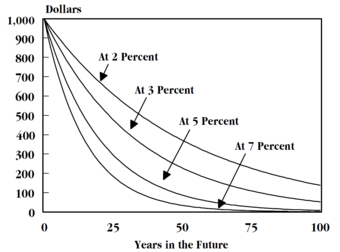
Time Value of Money
Time value of money requires an understanding of how return rates impact fixed values over time.
5.3.3: The Discount Rate
Discounting is the procedure of finding what a future sum of money is worth today.
Learning Objective
Describe what real world costs to the investor comprise an investment’s interest rate
Key Points
- The discount rate represents some cost (or group of costs) to the investor or creditor.
- Some costs to the investor or creditor are opportunity cost, liquidity cost, risk, and inflation.
- The discount rate is used by both the creditor and debtor to find the present value of an amount of money.
Key Terms
- discount rate
-
The interest rate used to discount future cash flows of a financial instrument; the annual interest rate used to decrease the amounts of future cash flow to yield their present value.
- discounting
-
The process of finding the present value using the discount rate.
- discount
-
to account for the time value of money
Another common name for finding present value (PV) is discounting. Discounting is the procedure of finding what a future sum of money is worth today. As you know from the previous sections, to find the PV of a payment you need to know the future value (FV), the number of time periods in question, and the interest rate. The interest rate, in this context, is more commonly called the discount rate.
The discount rate represents some cost (or group of costs) to the investor or creditor. The sum of these costs amounts to a percentage which becomes the interest rate (plus a small profit, sometimes). Here are some of the most significant costs from the investor/creditor’s point of view:

Borrowing and lending
Banks like HSBC take such costs into account when determining the terms of a loan for borrowers.
- Opportunity Cost: The cost of not having the cash on hand at a certain point of time. If the investor/creditor had the cash s/he could spend it, but since it has been invested/loaned out, s/he incurs the cost of not being able to spend it.
- Inflation: The real value of a single dollar decreases over time with inflation. That means that even if everything else is constant, a $100 item will retail for more than $100 in the future. Inflation is generally positive in most countries at most times (if it’s not, it’s called deflation, but it’s rare).
- Risk: There is a chance that you will not get your money back because it is a bad investment, the debtor defaults. You require compensation for taking on that risk.
- Liquidity: Investing or loaning out cash necessarily reduces your liquidity.
All of these costs combine to determine the interest rate on an account, and that interest rate in turn is the rate at which the sum is discounted.
The PV and the discount rate are related through the same formula we have been using,
.
If FV and n are held as constants, then as the discount rate (i) increases, PV decreases. PV and the discount rate, therefore, vary inversely, a fundamental relationship in finance. Suppose you expect $1,000 dollars in one year’s time (FV = $1,000) . To determine the present value, you would need to discount it by some interest rate (i). If this discount rate were 5%, the $1,000 in a year’s time would be the equivalent of $952.38 to you today (1000/[1.00 + 0.05]).
5.3.4: Number of Periods
The number of periods corresponds to the number of times the interest is accrued.
Learning Objective
Define what a period is in terms of present value calculations
Key Points
- A period is just a general term for a length of time. It can be anything- one month, one year, one decade- but it must be clearly defined and fixed.
- For both simple and compound interest, the number of periods varies jointly with FV and inversely with PV.
- The number of periods is also part of the units of the discount rate: if one period is one year, the discount rate must be defined as X% per year. If one period is one month, the discount rate must be X% per month.
Key Term
- period
-
The length of time during which interest accrues.
In , nrepresents the number of periods. A period is just a general term for a length of time. It can be anything- one month, one year, one decade- but it must be clearly defined and fixed. The length of one period must be the same at the beginning of an investment and at the end. It is also part of the units of the discount rate: if one period is one year, the discount rate must be defined as X% per year. If one period is one month, the discount rate must be X% per month.

FV of a single payment
The PV and FV are directly related.
The number of periods corresponds to the number of times the interest is accrued. In the case of simple interest the number of periods, t, is multiplied by their interest rate. This makes sense because if you earn $30 of interest in the first period, you also earn $30 of interest in the last period, so the total amount of interest earned is simple t x $30.
Simple interest is rarely used in comparison to compound interest . In compound interest, the interest in one period is also paid on all interest accrued in previous periods. Therefore, there is an exponential relationship between PV and FV, which is reflected in (1+i)n .

Car
Car loans, mortgages, and student loans all generally have compound interest.
For both forms of interest, the number of periods varies jointly with FV and inversely with PV. Logically, if more time passes between the present and the future, the FV must be higher or the PV lower (assuming the discount rate remains constant).
5.3.5: Calculating Present Value
Calculating the present value (PV) is a matter of plugging FV, the interest rate, and the number of periods into an equation.
Learning Objective
Distinguish between the formula used for calculating present value with simple interest and the formula used for present value with compound interest
Key Points
- The first step is to identify if the interest is simple or compound. Most of the time, it is compound.
- The interest rate and number of periods must have consistent units.
- The PV is what a future sum is worth today given a specific interest rate (often called a “discount rate”).
Key Terms
- compound interest
-
Interest, as on a loan or a bank account, that is calculated on the total on the principal plus accumulated unpaid interest.
- simple interest
-
interest paid only on the principal.
Finding the present value (PV) of an amount of money is finding the amount of money today that is worth the same as an amount of money in the future, given a certain interest rate.
Calculating the present value (PV) of a single amount is a matter of combining all of the different parts we have already discussed. But first, you must determine whether the type of interest is simple or compound interest. If the interest is simple interest, you plug the numbers into the simple interest formula.

Simple Interest Formula
Simple interest is when interest is only paid on the amount you originally invested (the principal). You don’t earn interest on interest you previously earned.
If it is compound interest, you can rearrange the compound interest formula to calculate the present value.

Present Value Single Payment
Finding the PV is a matter of plugging in for the three other variables.
Inputs
- Future Value: The known value of the money at a declared point in the future.
- Interest Rate (Discount Rate): Represented as either i or r. This is the percentage of interest paid each period.
- Number of periods: Represented as n or t.
Once you know these three variables, you can plug them into the appropriate equation. If the problem doesn’t say otherwise, it’s safe to assume the interest compounds. If you happen to be using a program like Excel, the interest is compounded in the PV formula. Simple interest is pretty rare.
One area where there is often a mistake is in defining the number of periods and the interest rate. They have to have consistent units, which may require some work. For example, interest is often listed as X% per year. The problem may talk about finding the PV 24 months before the FV, but the number of periods must be in years since the interest rate is listed per year. Therefore, n = 2. As long as the units are consistent, however, finding the PV is done by plug-and-chug.
5.4: Annuities
5.4.1: Annuities
An annuity is a type of investment in which regular payments are made over the course of multiple periods.
Learning Objective
Classify the different types of annuity
Key Points
- Annuities have payments of a fixed size paid at regular intervals.
- There are three types of annuities: annuities-due, ordinary annuities, and perpetuities.
- Annuities help both the creditor and debtor have predictable cash flows, and it spreads payments of the investment out over time.
Key Term
- period
-
The length of time during which interest accrues.
An annuity is a type of multi-period investment where there is a certain principal deposited and then regular payments made over the course of the investment. The payments are all a fixed size. For example, a car loan may be an annuity: In order to get the car, you are given a loan to buy the car. In return you make an initial payment (down payment), and then payments each month of a fixed amount. There is still an interest rate implicitly charged in the loan. The sum of all the payments will be greater than the loan amount, just as with a regular loan, but the payment schedule is spread out over time.
Suppose you are the bank that makes the car loan. There are three advantages to making the loan an annuity. The first is that there is a regular, known cash flow. You know how much money you’ll be getting from the loan and when you’ll be getting them. The second is that it should be easier for the person you are loaning to to repay, because they are not expected to pay one large amount at once. The third reason why banks like to make annuity loans is that it helps them monitor the financial health of the debtor. If the debtor starts missing payments, the bank knows right away that there is a problem, and they could potentially amend the loan to make it better for both parties.
Similar advantages apply to the debtor. There are predictable payments, and paying smaller amounts over multiple periods may be advantageous over paying the whole loan plus interest and fees back at once.
Since annuities, by definition, extend over multiple periods, there are different types of annuities based on when in the period the payments are made. The three types are:
- Annuity-due: Payments are made at the beginning of the period . For example, if a period is one month, payments are made on the first of each month.
- Ordinary Annuity: Payments are made at the end of the period . If a period is one month, this means that payments are made on the 28th/30th/31st of each month. Mortgage payments are usually ordinary annuities.
- Perpetuities: Payments continue forever. This is much rarer than the first two types.
5.4.2: Future Value of Annuity
The future value of an annuity is the sum of the future values of all of the payments in the annuity.
Learning Objective
Calculate the future value of different types of annuities
Key Points
- To find the FV, you need to know the payment amount, the interest rate of the account the payments are deposited in, the number of periods per year, and the time frame in years.
- The first and last payments of an annuity due both occur one period before they would in an ordinary annuity, so they have different values in the future.
- There are different formulas for annuities due and ordinary annuities because of when the first and last payments occur.
Key Terms
- annuity-due
-
An investment with fixed-payments that occur at regular intervals, paid at the beginning of each period.
- ordinary repair
-
expense accrued in normal maintenance of an asset
- annuity-due
-
a stream of fixed payments where payments are made at the beginning of each period
- ordinary annuity
-
An investment with fixed-payments that occur at regular intervals, paid at the end of each period.
The future value of an annuity is the sum of the future values of all of the payments in the annuity. It is possible to take the FV of all cash flows and add them together, but this isn’t really pragmatic if there are more than a couple of payments.
If you were to manually find the FV of all the payments, it would be important to be explicit about when the inception and termination of the annuity is. For an annuity-due, the payments occur at the beginning of each period, so the first payment is at the inception of the annuity, and the last one occurs one period before the termination.
For an ordinary annuity, however, the payments occur at the end of the period. This means the first payment is one period after the start of the annuity, and the last one occurs right at the end. There are different FV calculations for annuities due and ordinary annuities because of when the first and last payments occur.
There are some formulas to make calculating the FV of an annuity easier. For both of the formulas we will discuss, you need to know the payment amount (m, though often written as pmt or p), the interest rate of the account the payments are deposited in (r, though sometimes i), the number of periods per year (n), and the time frame in years (t).
The formula for an ordinary annuity is as follows:
where m is the payment amount, r is the interest rate, n is the number of periods per year, and t is the length of time in years.
In contrast, the formula for an annuity-due is as follows:
Provided you know m, r, n, and t, therefore, you can find the future value (FV) of an annuity.
5.4.3: Present Value of Annuity
The PV of an annuity can be found by calculating the PV of each individual payment and then summing them up.
Learning Objective
Calculate the present value of annuities
Key Points
- The PV for both annuities-due and ordinary annuities can be calculated using the size of the payments, the interest rate, and number of periods.
- The PV of a perpetuity can be found by dividing the size of the payments by the interest rate.
- Payment size is represented as p, pmt, or A; interest rate by i or r; and number of periods by n or t.
Key Term
- perpetuity
-
An annuity in which the periodic payments begin on a fixed date and continue indefinitely.
The Present Value (PV) of an annuity can be found by calculating the PV of each individual payment and then summing them up . As in the case of finding the Future Value (FV) of an annuity, it is important to note when each payment occurs. Annuities-due have payments at the beginning of each period, and ordinary annuities have them at the end.
Recall that the first payment of an annuity-due occurs at the start of the annuity, and the final payment occurs one period before the end. The PV of an annuity-due can be calculated as follows:
where
is the size of the payment (sometimes
or
),
is the interest rate, and
is the number of periods.
An ordinary annuity has annuity payments at the end of each period, so the formula is slightly different than for an annuity-due. An ordinary annuity has one full period before the first payment (so it must be discounted) and the last payment occurs at the termination of the annuity (so it must be discounted for one period more than the last period in an annuity-due). The formula is:
where, again,
,
, and
are the size of the payment, the interest rate, and the number of periods, respectively.
Both annuities-due and ordinary annuities have a finite number of payments, so it is possible, though cumbersome, to find the PV for each period. For perpetuities, however, there are an infinite number of periods, so we need a formula to find the PV. The formula for calculating the PV is the size of each payment divided by the interest rate.
Example 1
Suppose you have won a lottery that pays $1,000 per month for the next 20 years. But, you prefer to have the entire amount now. If the interest rate is 8%, how much will you accept?
Consider for argument purposes that two people, Mr. Cash, and Mr. Credit, have won the same lottery of $1,000 per month for the next 20 years. Now, Mr. Credit is happy with his $1,000 monthly payment, but Mr. Cash wants to have the entire amount now. Our job is to determine how much Mr. Cash should get. We reason as follows: If Mr. Cash accepts x dollars, then the x dollars deposited at 8% for 20 years should yield the same amount as the $1,000 monthly payments for 20 years. In other words, we are comparing the future values for both Mr. Cash and Mr. Credit, and we would like the future values to be equal.
Since Mr. Cash is receiving a lump sum of x dollars, its future value is given by the lump sum formula:
Since Mr. Credit is receiving a sequence of payments, or an annuity, of $1,000 per month, its future value is given by the annuity formula:
The only way Mr. Cash will agree to the amount he receives is if these two future values are equal. So we set them equal and solve for the unknown:
The reader should also note that if Mr. Cash takes his lump sum of $119,554.36 and invests it at 8% compounded monthly, he will have $589,020.41 in 20 years.
Example 2
Find the monthly payment for a car costing $15,000 if the loan is amortized over five years at an interest rate of 9%.
Again, consider the following scenario: Two people, Mr. Cash and Mr. Credit, go to buy the same car that costs $15,000. Mr. Cash pays cash and drives away, but Mr. Credit wants to make monthly payments for five years. Our job is to determine the amount of the monthly payment.
We reason as follows: If Mr. Credit pays x dollars per month, then the x dollar payment deposited each month at 9% for 5 years should yield the same amount as the $15,000 lump sum deposited for 5 years. Again, we are comparing the future values for both Mr. Cash and Mr. Credit, and we would like them to be the same.
Since Mr. Cash is paying a lump sum of $15,000, its future value is given by the lump sum formula:
Mr. Credit wishes to make a sequence of payments, or an annuity, of x dollars per month, and its future value is given by the annuity formula:
We set the two future amounts equal and solve for the unknown:
5.4.4: Calculating Annuities
Understanding the relationship between each variable and the broader concept of the time value of money enables simple valuation calculations of annuities.
Learning Objective
Calculate the present or future value of various annuities based on the information given
Key Points
- Annuities are basically loans that are paid back over a set period of time at a set interest rate with consistent payments each period.
- A mortgage or car loan are simple examples of an annuity. Borrowers agree to pay a given amount each month when borrowing capital to compensate for the risk and the time value of money.
- The six potential variables included in an annuity calculation are the present value, the future value, interest, time (number of periods), payment amount, and payment growth (if applicable).
- Through integrating each of these (excluding payment growth, if payments are consistent over time), it is simple to solve for the present of future value of a given annuity.
Key Term
- annuity
-
A right to receive amounts of money regularly over a certain fixed period in repayment of a loan or investment (or perpetually, in the case of a perpetuity).
Annuities Defined
To understand how to calculate an annuity, it’s useful to understand the variables that impact the calculation. An annuity is essentially a loan, a multi-period investment that is paid back over a fixed (or perpetual, in the case of a perpetuity) period of time. The amount paid back over time is relative to the amount of time it takes to pay it back, the interest rate being applied, and the principal (when creating the annuity, this is the present value).
Generally speaking, annuities and perpetuities will have consistent payments over time. However, it is also an option to scale payments up or down, for various reasons.
Variables
This gives us six simple variables to use in our calculations:
- Present Value (PV) – This is the value of the annuity at time 0 (when the annuity is first created)
- Future Value (FV) – This is the value of the annuity at time n (i.e. at the conclusion of the life of the annuity).
- Payments (A) – Each period will require individual payments that will be represented by this amount.
- Number of Payments (n) – The number of payments (A) will equate to the number of expected periods of payment over the life of the annuity.
- Interest (i) – Annuities occur over time, and thus a given rate of return (interest) is applied to capture the time value of money.
- Growth (g) – For annuities that have changes in payments, there is a growth rate applied to these payments over time.
Calculating Annuities
With all of the inputs above at hand, it’s fairly simply to value various types of annuities. Generally investors, lenders, and borrowers are interested in the present and future value of annuities.
Present Value
The present value of an annuity can be calculated as follows:
For a growth annuity (where the payment amount changes at a predetermined rate over the life of the annuity), the present value can be calculated as follows:
Future Value
The future value of an annuity can be determined using this equation:
In a situation where payments grow over time, the future value can be determined using this equation:
Various Formula Arrangements
It is also possible to use existing information to solve for missing information. Which is to say, if you know interest and time, you can solve for the following (given the following):
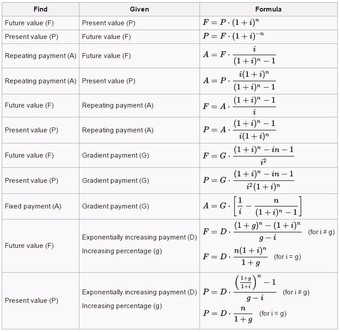
Annuities Equations
This table is a useful way to view the calculation of annuities variables from a number of directions. Understanding how to manipulate the formula will underline the relationship between the variables, and provide some conceptual clarity as to what annuities are.
5.5: Valuing Multiple Cash Flows
5.5.1: Future Value, Multiple Flows
To find the FV of multiple cash flows, sum the FV of each cash flow.
Learning Objective
Calculate the Future Value of Multiple Annuities
Key Points
- The FV of multiple cash flows is the sum of the FV of each cash flow.
- To sum the FV of each cash flow, each must be calculated to the same point in the future.
- If the multiple cash flows are a fixed size, occur at regular intervals, and earn a constant interest rate, it is an annuity. There are formulas for calculating the FV of an annuity.
Key Terms
- incremental cash flows
-
the additional money flowing in or out of a business due to a project
- annuity
-
A specified income payable at stated intervals for a fixed or a contingent period, often for the recipient’s life, in consideration of a stipulated premium paid either in prior installment payments or in a single payment. For example, a retirement annuity paid to a public officer following his or her retirement.
- cash flow
-
The sum of cash revenues and expenditures over a period of time.
Future Value, Multiple Cash Flows
Finding the future value (FV) of multiple cash flows means that there are more than one payment/investment, and a business wants to find the total FV at a certain point in time. These payments can have varying sizes, occur at varying times, and earn varying interest rates, but they all have a certain value at a specific time in the future.
The first step in finding the FV of multiple cash flows is to define when the future is. Once that is done, you can determine the FV of each cash flow using the formula in . Then, simply add all of the future values together.

FV of a single payment
The FV of multiple cash flows is the sum of the future values of each cash flow.
Manually calculating the FV of each cash flow and then summing them together can be a tedious process. If the cash flows are irregular, don’t happen at regular intervals, or earn different interest rates, there isn’t a special way to find the total FV.
However, if the cash flows do happen at regular intervals, are a fixed size, and earn a uniform interest rate, there is an easier way to find the total FV. Investments that have these three traits are called “annuities. “
There are formulas to find the FV of an annuity depending on some characteristics, such as whether the payments occur at the beginning or end of each period. There is a module that goes through exactly how to calculate the FV of annuities.
If the multiple cash flows are a part of an annuity, you’re in luck; there is a simple way to find the FV. If the cash flows aren’t uniform, don’t occur at fixed intervals, or earn different interest rates, the only way to find the FV is do find the FV of each cash flow and then add them together.
5.5.2: Present Value, Multiple Flows
The PV of multiple cash flows is simply the sum of the present values of each individual cash flow.
Learning Objective
Calculate the present value of an investment portfolio that has multiple cash flows
Key Points
- To find the PV of multiple cash flows, each cash flow much be discounted to a specific point in time and then added to the others.
- To discount annuities to a time prior to their start date, they must be discounted to the start date, and then discounted to the present as a single cash flow.
- Multiple cash flow investments that are not annuities unfortunately cannot be discounted by any other method but by discounting each cash flow and summing them together.
Key Terms
- discount
-
To find the value of a sum of money at some earlier point in time. To find the present value.
- net present value
-
the present value of a project or an investment decision determined by summing the discounted incoming and outgoing future cash flows resulting from the decision
The PV of multiple cash flows follows the same logic as the FV of multiple cash flows. The PV of multiple cash flows is simply the sum of the present values of each individual cash flow .

Sum FV
The PV of an investment is the sum of the present values of all its payments.
Each cash flow must be discounted to the same point in time. For example, you cannot sum the PV of two loans at the beginning of the loans if one starts in 2012 and one starts in 2014. If you want to find the PV in 2012, you need to discount the second loan an additional two years, even though it doesn’t start until 2014.
The calculations get markedly simpler if the cash flows make up an annuity. In order to be an annuity (and use the formulas explained in the annuity module), the cash flows need to have three traits:
- Constant payment size
- Payments occur at fixed intervals
- A constant interest rate
Things may get slightly messy if there are multiple annuities, and you need to discount them to a date before the beginning of the payments.
Suppose there are two sets of cash flows which you determine are both annuities. The first extends from 1/1/14 to 1/1/16, and the second extends from 1/1/15 to 1/1/17. You want to find the total PV of all the cash flows on 1/1/13.
The annuity formulas are good for determining the PV at the date of the inception of the annuity. That means that it’s not enough to simply plug in the payment size, interest rate, and number of periods between 1/1/13 and the end of the annuities. If you do, that supposes that both annuities begin on 1/1/13, but neither do. Instead, you have to first find the PV of the first annuity on 1/1/14 and the second on 1/1/15 because that’s when the annuities begin.
You now have two present values, but both are still in the future. You then can discount those present values as if they were single sums to 1/1/13.
Unfortunately, if the cash flows do not fit the characteristics of an annuity, there isn’t a simple way to find the PV of multiple cash flows: each cash flow much be discounted and then all of the PVs must be summed together.
Example
A corporation must decide whether to introduce a new product line. The new product will have start-up expenditures, operational expenditures, and then it will have associated incoming cash receipts (sales) and disbursements (Cash paid for materials, supplies, direct labor, maintenance, repairs, and direct overhead) over 12 years. This project will have an immediate (t=0) cash outflow of 100,000 (which might include all cash paid for the machinery, transportation-in and set-up expenditures, and initial employee training disbursements. ) The annual net cash flow (receipts less disbursements) from this new line for years 1-12 is forecast as follows: -54672, -39161, 3054, 7128, 25927, 28838, 46088, 77076, 46726, 76852, 132332, 166047, reflecting two years of running deficits as experience and sales are built up, with net cash receipts forecast positive after that. At the end of the 12 years it’s estimated that the entire line becomes obsolete and its scrap value just covers all the removal and disposal expenditures. All values are after-tax, and the required rate of return is given to be 10%. (This also makes the simplifying assumption that the net cash received or paid is lumped into a single transaction occurring on the last day of each year. )
The present value (PV) can be calculated for each year:
T=0:
T=1:
T=2:
T=3:
T=4:
T=5:
T=6:
T=7:
T=8:
T=9:
T=10:
T=11:
T=12:
The sum of all these present values is the net present value, which equals 65,816.04. Since the NPV is greater than zero, it would be better to invest in the project than to do nothing, and the corporation should invest in this project if there is no alternative with a higher NPV.
5.6: Additional Detail on Present and Future Values
5.6.1: The Relationship Between Present and Future Value
Present value (PV) and future value (FV) measure how much the value of money has changed over time.
Learning Objective
Discuss the relationship between present value and future value
Key Points
- The future value (FV) measures the nominal future sum of money that a given sum of money is “worth” at a specified time in the future assuming a certain interest rate, or more generally, rate of return. The FV is calculated by multiplying the present value by the accumulation function.
- PV and FV vary jointly: when one increases, the other increases, assuming that the interest rate and number of periods remain constant.
- As the interest rate (discount rate) and number of periods increase, FV increases or PV decreases.
Key Terms
- discounting
-
The process of finding the present value using the discount rate.
- present value
-
a future amount of money that has been discounted to reflect its current value, as if it existed today
- capitalization
-
The process of finding the future value of a sum by evaluating the present value.
The future value (FV) measures the nominal future sum of money that a given sum of money is “worth” at a specified time in the future assuming a certain interest rate, or more generally, rate of return. The FV is calculated by multiplying the present value by the accumulation function. The value does not include corrections for inflation or other factors that affect the true value of money in the future. The process of finding the FV is often called capitalization.
On the other hand, the present value (PV) is the value on a given date of a payment or series of payments made at other times. The process of finding the PV from the FV is called discounting.
PV and FV are related , which reflects compounding interest (simple interest has n multiplied by i, instead of as the exponent). Since it’s really rare to use simple interest, this formula is the important one.

FV of a single payment
The PV and FV are directly related.
PV and FV vary directly: when one increases, the other increases, assuming that the interest rate and number of periods remain constant.
The interest rate (or discount rate) and the number of periods are the two other variables that affect the FV and PV. The higher the interest rate, the lower the PV and the higher the FV. The same relationships apply for the number of periods. The more time that passes, or the more interest accrued per period, the higher the FV will be if the PV is constant, and vice versa.
The formula implicitly assumes that there is only a single payment. If there are multiple payments, the PV is the sum of the present values of each payment and the FV is the sum of the future values of each payment.
5.6.2: Calculating Perpetuities
The present value of a perpetuity is simply the payment size divided by the interest rate and there is no future value.
Learning Objective
Calculate the present value of a perpetuity
Key Points
- Perpetuities are a special type of annuity; a perpetuity is an annuity that has no end, or a stream of cash payments that continues forever.
- To find the future value of a perpetuity requires having a future date, which effectively converts the perpetuity to an ordinary annuity until that point.
- Perpetuities with growing payments are called Growing Perpetuities; the growth rate is subtracted from the interest rate in the present value equation.
Key Term
- growth rate
-
The percentage by which the payments grow each period.
Perpetuities are a special type of annuity; a perpetuity is an annuity that has no end, or a stream of cash payments that continues forever. Essentially, they are ordinary annuities, but have no end date. There aren’t many actual perpetuities, but the United Kingdom has issued them in the past.
Since there is no end date, the annuity formulas we have explored don’t apply here. There is no end date, so there is no future value formula. To find the FV of a perpetuity would require setting a number of periods which would mean that the perpetuity up to that point can be treated as an ordinary annuity.
There is, however, a PV formula for perpetuities . The PV is simply the payment size (A) divided by the interest rate (r). Notice that there is no n, or number of periods. More accurately, is what results when you take the limit of the ordinary annuity PV formula as n → ∞.
It is also possible that an annuity has payments that grow at a certain rate per period. The rate at which the payments change is fittingly called the growth rate (g). The PV of a growing perpetuity is represented as
. It is essentially the same as in except that the growth rate is subtracted from the interest rate. Another way to think about it is that for a normal perpetuity, the growth rate is just 0, so the formula boils down to the payment size divided by r.
5.6.3: Calculating Values for Different Durations of Compounding Periods
Finding the Effective Annual Rate (EAR) accounts for compounding during the year, and is easily adjusted to different period durations.
Learning Objective
Calculate the present and future value of something that has different compounding periods
Key Points
- The units of the period (e.g. one year) must be the same as the units in the interest rate (e.g. 7% per year).
- When interest compounds more than once a year, the effective interest rate (EAR) is different from the nominal interest rate.
- The equation in skips the step of solving for EAR, and is directly usable to find the present or future value of a sum.
Key Terms
- Future Value
-
The value of an asset at a specific date. It measures the nominal future sum of money that a given sum of money is “worth” at a specified time in the future, assuming a certain interest rate, or more generally, rate of return, it is the present value multiplied by the accumulation function.
- present value
-
Also known as present discounted value, is the value on a given date of a payment or series of payments made at other times. If the payments are in the future, they are discounted to reflect the time value of money and other factors such as investment risk. If they are in the past, their value is correspondingly enhanced to reflect that those payments have been (or could have been) earning interest in the intervening time. Present value calculations are widely used in business and economics to provide a means to compare cash flows at different times on a meaningful “like to like” basis.
Sometimes, the units of the number of periods does not match the units in the interest rate. For example, the interest rate could be 12% compounded monthly, but one period is one year. Since the units have to be consistent to find the PV or FV, you could change one period to one month. But suppose you want to convert the interest rate into an annual rate. Since interest generally compounds, it is not as simple as multiplying 1% by 12 (1% compounded each month). This atom will discuss how to handle different compounding periods.
Effective Annual Rate
The effective annual rate (EAR) is a measurement of how much interest actually accrues per year if it compounds more than once per year. The EAR can be found through the formula in where i is the nominal interest rate and n is the number of times the interest compounds per year (for continuous compounding, see ). Once the EAR is solved, that becomes the interest rate that is used in any of the capitalization or discounting formulas.

EAR with Continuous Compounding
The effective rate when interest compounds continuously.

Calculating the effective annual rate
The effective annual rate for interest that compounds more than once per year.
For example, if there is 8% interest that compounds quarterly, you plug .08 in for i and 4 in for n. That calculates an EAR of .0824 or 8.24%. You can think of it as 2% interest accruing every quarter, but since the interest compounds, the amount of interest that actually accrues is slightly more than 8%. If you wanted to find the FV of a sum of money, you would have to use 8.24% not 8%.
Solving for Present and Future Values with Different Compounding Periods
Solving for the EAR and then using that number as the effective interest rate in present and future value (PV/FV) calculations is demonstrated here. Luckily, it’s possible to incorporate compounding periods into the standard time-value of money formula. The equation in is the same as the formulas we have used before, except with different notation. In this equation, A(t) corresponds to FV, A0 corresponds to Present Value, r is the nominal interest rate, n is the number of compounding periods per year, and t is the number of years.

FV Periodic Compounding
Finding the FV (A(t)) given the PV (Ao), nominal interest rate (r), number of compounding periods per year (n), and number of years (t).
The equation follows the same logic as the standard formula. r/n is simply the nominal interest per compounding period, and nt represents the total number of compounding periods.
Solving for n
The last tricky part of using these formulas is figuring out how many periods there are. If PV, FV, and the interest rate are known, solving for the number of periods can be tricky because n is in the exponent. It makes solving for n manually messy. shows an easy way to solve for n. Remember that the units are important: the units on n must be consistent with the units of the interest rate (i).

Solving for n
This formula allows you to figure out how many periods are needed to achieve a certain future value, given a present value and an interest rate.
5.6.4: Comparing Interest Rates
Variables, such as compounding, inflation, and the cost of capital must be considered before comparing interest rates.
Learning Objective
Discuss the differences between effective interest rates, real interest rates, and cost of capital
Key Points
- A nominal interest rate that compounds has a different effective rate (EAR), because interest is accrued on interest.
- The Fisher Equation approximates the amount of interest accrued after accounting for inflation.
- A company will theoretically only invest if the expected return is higher than their cost of capital, even if the return has a high nominal value.
Key Term
- inflation
-
An increase in the general level of prices or in the cost of living.
The amount of interest you would have to pay on a loan or would earn on an investment is clearly an important consideration when making any financial decisions. However, it is not enough to simply compare the nominal values of two interest rates to see which is higher.
Effective Interest Rates
The reason why the nominal interest rate is only part of the story is due to compounding. Since interest compounds, the amount of interest actually accrued may be different than the nominal amount. The last section went through one method for finding the amount of interest that actually accrues: the Effective Annual Rate (EAR).
The EAR is a calculation that account for interest that compounds more than one time per year. It provides an annual interest rate that accounts for compounded interest during the year. If two investments are otherwise identical, you would naturally pick the one with the higher EAR, even if the nominal rate is lower.
Real Interest Rates
Interest rates are charged for a number of reasons, but one is to ensure that the creditor lowers his or her exposure to inflation. Inflation causes a nominal amount of money in the present to have less purchasing power in the future. Expected inflation rates are an integral part of determining whether or not an interest rate is high enough for the creditor.
The Fisher Equation is a simple way of determining the real interest rate, or the interest rate accrued after accounting for inflation. To find the real interest rate, simply subtract the expected inflation rate from the nominal interest rate.

Fisher Equation
The nominal interest rate is approximately the sum of the real interest rate and inflation.
For example, suppose you have the option of choosing to invest in two companies. Company 1 will pay you 5% per year, but is in a country with an expected inflation rate of 4% per year. Company 2 will only pay 3% per year, but is in a country with an expected inflation of 1% per year. By the Fisher Equation, the real interest rates are 1% and 2% for Company 1 and Company 2, respectively. Thus, Company 2 is the better investment, even though Company 1 pays a higher nominal interest rate.
Cost of Capital
Another major consideration is whether or not the interest rate is higher than your cost of capital. The cost of capital is the rate of return that capital could be expected to earn in an alternative investment of equivalent risk. Many companies have a standard cost of capital that they use to determine whether or not an investment is worthwhile.
In theory, a company will never make an investment if the expected return on the investment is less than their cost of capital. Even if a 10% annual return sounds really nice, a company with a 13% cost of capital will not make that investment.
5.6.5: Calculating Values for Fractional Time Periods
The value of money and the balance of the account may be different when considering fractional time periods.
Learning Objective
Calculate the future and present value of an account when a fraction of a compounding period has passed
Key Points
- The balance of an account only changes when interest is paid. To find the balance, round the fractional time period down to the period when interest was last accrued.
- To find the PV or FV, ignore when interest was last paid an use the fractional time period as the time period in the equation.
- The discount rate is really the cost of not having the money over time, so for PV/FV calculations, it doesn’t matter if the interest hasn’t been added to the account yet.
Key Terms
- time period assumption
-
business profit or loses are measured on timely basis
- compounding period
-
The length of time between the points at which interest is paid.
- time value of money
-
the value of an asset accounting for a given amount of interest earned or inflation accrued over a given period
Up to this point, we have implicitly assumed that the number of periods in question matches to a multiple of the compounding period. That means that the point in the future is also a point where interest accrues. But what happens if we are dealing with fractional time periods?
Compounding periods can be any length of time, and the length of the period affects the rate at which interest accrues.

Compounding Interest
The effect of earning 20% annual interest on an initial $1,000 investment at various compounding frequencies.
Suppose the compounding period is one year, starting January1, 2012. If the problem asks you to find the value at June 1, 2014, there is a bit of a conundrum. The last time interest was actually paid was at January 1, 2014, but the time-value of money theory clearly suggests that it should be worth more in June than in January.
In the case of fractional time periods, the devil is in the details. The question could ask for the future value, present value, etc., or it could ask for the future balance, which have different answers.
Future/Present Value
If the problem asks for the future value (FV) or present value (PV), it doesn’t really matter that you are dealing with a fractional time period. You can plug in a fractional time period to the appropriate equation to find the FV or PV. The reasoning behind this is that the interest rate in the equation isn’t exactly the interest rate that is earned on the money. It is the same as that number, but more broadly, is the cost of not having the money for a time period. Since there is still a cost to not having the money for that fraction of a compounding period, the FV still rises.
Account Balance
The question could alternatively ask for the balance of the account. In this case, you need to find the amount of money that is actually in the account, so you round the number of periods down to the nearest whole number (assuming one period is the same as a compounding period; if not, round down to the nearest compounding period). Even if interest compounds every period, and you are asked to find the balance at the 6.9999th period, you need to round down to 6. The last time the account actually accrued interest was at period 6; the interest for period 7 has not yet been paid.
If the account accrues interest continuously, there is no problem: there can’t be a fractional time period, so the balance of the account is always exactly the value of the money.
5.6.6: Loans and Loan Amortization
When borrowing money to be paid back via a number of installments over time, it is important to understand the time value of money and how to build an amortization schedule.
Learning Objective
Understand amortization schedules
Key Points
- Amortization of a loan is the process of identifying a payment amount for each period of repayment on a given outstanding debt.
- Repaying capital over time at an interest rate requires an amortization schedule, which both parties agree to prior to the exchange of capital. This schedule determines the repayment period, as well as the amount of repayment per period.
- Time value of money is a central concept to amortization. A dollar today, for example, is worth more than a dollar tomorrow due to the opportunity cost of other investments.
- When purchasing a home for $100,000 over 30 years at 8% interest (consistent payments each month), for example, the total amount of repayment is more than 2.5 times the original principal of $100,000.
Key Term
- amortization
-
This is the process of scheduling intervals of payment over time to pay back an existing debt, taking into account the time value of money.
When lending money (or borrowing, depending on your perspective), it is common to have multiple payback periods over time (i.e. multiple, smaller cash flow installments to pay back the larger borrowed sum). In these situations, an amortization schedule will be created. This will determine how much will be paid back each period, and how many periods of repayment will be required to cover the principal balance. This must be agreed upon prior to the initial borrowing occurs, and signed by both parties.
Time Value of Money
Now if you add up all of the separate payments in an amortization schedule, you’ll find the total exceeds the amount borrowed. This is because amortization schedules must take into account the time value of money. Time value of money is a fairly simple concept at it’s core: a dollar today is worth more than a dollar tomorrow.
Why? Because capital can be invested, and those investments can yield returns. Lending your money to someone means incurring the opportunity cost of the other things you could do with that money. This gets even more drastic as the scale of capital increases, as the returns on capital over time are expressed in a percentage of the capital invested. Say you spend $100 on some stock, and turn 10% on that investment. You now have $110, a profit of $10. Say instead of only a $100, you put in $10,000. Now you have $11,000, a profit of $1,000.
Principle and Interest
As a result of this calculation, amortization schedules charge interest over time as a percentage of the principal borrowed. The calculation will incorporate the number of payment periods (n), the principal (P), the amortization payment (A) and the interest rate (r).
To make this a bit more realistic, let’s insert some numbers. Let’s say you find a dream house, at the reasonable rate of $100,000. Unfortunately, a bit of irresponsible borrowing in your past means you must pay 8% interest over a 30 year loan, which will be paid via a monthly amortization schedule (12 months x 30 years = 360 payments total). If you do the math, you should find yourself paying $734 per month 360 times. 360 x 734 will leave you in the ballpark of $264,000 in total repayment. that means you are paying more than 2.5 times as much for this house due to time value of money! This bit of knowledge is absolutely critical for personal financial decisions, as well as for high level business decisions.
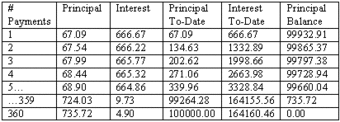
Amortization Schedule Example
This shows the first few installments in the example discussed above (i.e. borrowing $100,000 at 8% interest paid monthly over 30 years).
5.7: Yield
5.7.1: Calculating the Yield of a Single-Period Investment
The yield of a single period investment is simply
.
Learning Objective
Differentiate between the different methods of calculating yield of a single period investment
Key Points
- There are a number of ways to calculate yield, but the most common ones are to calculate the percent change from the initial investment, APR, and APY (or EAR).
- APR (annual percentage rate) is a commonly used calculation that figures out the nominal amount of interest accrued per year. It does not account for compounding interest.
- APY (annual percentage yield) is a way of using the nominal interest rate to calculate the effective interest rate per year. It accounts for compounding interest.
- EAR (effective annual rate) is a special type of APY that uses APR as the nominal interest rate.
Key Terms
- effective-interest method
-
amortizing a debt according to the effective interest rate paid
- Nominal Interest
-
The amount of interest accrued per year without accounting for compounding.
- Effective Interest
-
The amount of interest accrued per year after accounting for compounding.
Determining Yield
The yield on an investment is the amount of money that is returned to the owner at the end of the term. In short, it’s how much you get back on your investment.
Naturally, this is a number that people care a lot about. The whole point of making an investment is to get a yield. There are a number of different ways to calculate an investment’s yield, though. You may get slightly different numbers using different methods, so it’s important to make sure that you use the same method when you are comparing yields. This section will address the yield calculation methods you are most likely to encounter, though there are many more.
Change-In-Value
The most basic type of yield calculation is the change-in-value calculation. This is simply the change in value (FV minus PV) divided by the PV times 100%. This calculation measures how different the FV is from the PV as a percentage of PV.

Percent Change
The percent change in value is the change in value from PV to FV (V2 to V1) divided by PV (V1) times 100%.
Annual Percentage Rate
Another common way of calculating yield is to determine the Annual Percentage Rate, or APR. You may have heard of APR from ads for car loans or credit cards. These generally have monthly loans or fees, but if you want to get an idea of how much you will accrue in interest per year, you need to calculate an APR. Nominal APR is simply the interest rate multiplied by the number of payment periods per year. However, since interest compounds, nominal APR is not a very accurate measure of the amount of interest you actually accrue.
Effective Annual Rate
To find the effective APR, the actual amount of interest you would accrue per year, we use the Effective Annual Rate, or EAR.

EAR
The Effective Annual Rate is the amount of interest actually accrued per year based on the APR. n is the number of compounding periods of APR per year.
For example, you may see an ad that says you can get a car loan at an APR of 10% compounded monthly. That means that APR=.10 and n=12 (the APR compounds 12 times per year). That means the EAR is 10.47%.
The EAR is a form of the Annual Percentage Yield (APY). APY may also be calculated using interest rates other than APR, so a more general formula is in . The logic behind calculating APY is the same as that used when calculating EAR: we want to know how much you actually accrue in interest per year. Interest usually compounds, so there is a difference between the nominal interest rate (e.g. monthly interest times 12) and the effective interest rate.

Annual Percentage Yield
The Annual Percentage Yield is a way or normalizing the nominal interest rate. Basically, it is a way to account for the time factor in order to get a more accurate number for the actual interest rate.inom is the nominal interest rate.N is the number of compounding periods per year.
5.7.2: Calculating the Yield of an Annuity
The yield of an annuity is commonly found using either the percent change in the value from PV to FV, or the internal rate of return.
Learning Objective
Calculate the yield of an annuity using the internal rate of return method
Key Points
- The yield of an annuity may be found by discounting to find the PV, and then finding the percentage change from the PV to the FV.
- The Internal Rate of Return (IRR) is the discount rate at which the NPV of an investment equals 0.
- The IRR calculates an annualized yield of an annuity.
Key Terms
- Net Present Value (NPV)
-
The present value of a project or an investment decision determined by summing the discounted incoming and outgoing future cash flows resulting from the decision.
- Internal Rate of Return (IRR)
-
The discount rate that will cause the NPV of an investment to equal 0.
- yield
-
In finance, the term yield describes the amount in cash that returns to the owners of a security. Normally it does not include the price variations, at the difference of the total return. Yield applies to various stated rates of return on stocks (common and preferred, and convertible), fixed income instruments (bonds, notes, bills, strips, zero coupon), and some other investment type insurance products
The yield of annuity can be calculated in similar ways to the yield for a single payment, but two methods are most common.
The first is the standard percentage-change method. Just as for a single payment, this method calculated the percentage difference between the FV and the PV. Since annuities include multiple payments over the lifetime of the investment, the PV (or V1 in is the present value of the entire investment, not just the first payment.
The second popular method is called the internal rate of return (IRR). The IRR is the interest rate (or discount rate) that causes the Net Present Value (NPV) of the annuity to equal 0. That means that the PV of the cash outflows equals the PV of the cash inflows. The higher the IRR, the more desirable is the investment. In theory, you should make investment with an IRR greater than the cost of capital.
Let’s take an example investment: It is not technically an annuity because the payments vary, but still is a good example for how to find IRR:
Suppose you have a potential investment that would require you to make a $4,000 investment today, but would return cash flows of $1,200, $1,410, $1,875, and $1,050 in the four successive years. This investment has an implicit rate of return, but you don’t know what it is. You plug the numbers into the NPV formula and set NPV equal to 0. You then solve for r, which is your IRR (it’s not easy to solve this problem by hand. You will likely need to use a business calculator or Excel). When r = 14.3%, NPV = 0, so therefore the IRR of the investment is 14.3%.

IRR Example
The setup to find the IRR of the investment with cash flows of -4000, 1200, 1410, 1875, and 1050. By setting NPV = 0 and solving for r, you can find the IRR of this investment.
Chapter 4: Forecasting Financial Statements
4.1: The Role of Financial Forecasting in Planning
4.1.1: Strategic Planning
The financial forecast is a key input to strategic planning, a firm’s process of defining strategy and making decisions about allocating resources.
Learning Objective
Explain how financial forecasting influences a company’s strategic planning
Key Points
- Using historical internal accounting and sales data, in addition to external market and economic indicators, a financial forecast is an economist’s best guess of what will happen to a company in financial terms over a given time period, which is usually one year.
- Financial forecasting is often helped by financial modeling processes. Financial modeling is the task of building an abstract representation (a model) of a financial decision-making situation.
- Assumptions play a key role in financial forecasts and can affect the way the forecasts predict the outcomes of decisions made on the corporate level.
Key Terms
- financial modeling
-
the task of building an abstract representation (a model) of a financial decision making situation.
- financial forecast
-
estimate of future financial outcomes for a company or country
- strategy
-
A plan of action intended to accomplish a specific goal
Strategic Planning
Strategic planning is an organization’s process of defining its strategy, or direction, and making decisions about allocating resources to pursue this strategy. In order to determine the direction of the organization, it is necessary to understand its current position and the possible avenues through which it can pursue a particular course of action.
A financial forecast is an estimate of future financial outcomes for a company. Using historical internal accounting and sales data, in addition to external market and economic indicators, a financial forecast is an economist’s best guess of what will happen to a company in financial terms over a given time period—which is usually one year. Often, the forecaster’s own assumptions and beliefs will be used to guess future growth rates and potential events that will affect the numbers on a financial statement.
Arguably, the most difficult aspect of preparing a financial forecast is predicting revenue. Future costs can be estimated by using historical accounting data; variable costs are also a function of sales. Unlike a financial plan or a budget, a financial forecast doesn’t have to be used as a planning document. Outside analysts can use a financial forecast to estimate a company’s success in the coming year.

Strategic Planning
Financial forecasting is essential for a company’s strategic planning, management, and organization.
Financial forecasting is often helped by processes of financial modeling. Financial modeling is the task of building an abstract representation (a model) of a financial decision making situation. This is a mathematical model designed to represent a simplified version of the performance of a financial asset or portfolio of a business, project, or any other investment. Financial modeling is a general term that means different things to different users; the reference usually relates either to accounting and corporate finance applications, or to quantitative finance applications.Typically, financial modelling is understood to mean an exercise in either asset pricing or corporate finance, of a quantitative nature. In other words, financial modelling is about translating a set of hypotheses about the behavior of markets or agents into numerical predictions; for example, a firm’s decisions about investments or investment returns. Once again, these are assumptions that will factor into the financial forecasting and planning for the corporation. Once the financial statements are forecast, one can attach a value to the firm, and see what changes need to be made to put the company in a better financial position.
4.1.2: Additional Funds Needed (AFN)
AFN is “additional funds needed,” and refers to the additional resources that will be needed for a company to expand its operations.
Learning Objective
Calculate the additional funds needed equation
Key Points
- AFN is a way of calculating how much new funding will be required, so that the firm can realistically look at whether or not they will be able to generate the additional funding and therefore be able to achieve the higher sales level.
- The simplified formula is: AFN = Projected increase in assets – spontaneous increase in liabilities – any increase in retained earnings. If this value is negative, this means the action or project which is being undertaken will generate extra income for the company, which can be invested elsewhere.
- The mathematical formulas used to determine AFN are based on showing how liabilities will grow relative to new assets and sales when a project is undertaken and can be used as tools to determine whether a project or operational expansion is worthwhile.
Key Terms
- liabilities
-
An amount of money in a company that is owed to someone and has to be paid in the future, such as tax, debt, interest, and mortgage payments.
- asset
-
Something or someone of any value; any portion of one’s property or effects so considered.
- sales
-
Revenues
AFN stands for “additional funds needed. ” It is a concept used most commonly in business looking to expand operations and influence. Since a business that seeks to increase its sales level will require more assets to meet that goal, some provision must be made to accommodate the change in assets . To phrase it another way, the business must have some plan to actually finance the new assets that will be needed to increase sales.

Assets – Economic Resources
AFN determines the extra assets and financing that will be needed for a firm to undertake a new project or expand its operations and sales.
AFN is a way of calculating how much new funding will be required, so that the firm can realistically look at whether or not they will be able to generate the additional funding and therefore be able to achieve the higher sales level. Determining the amount of external funding needed is a key part of calculating AFN. This can be determined by mathematical formulas which use inputs that can be found in a company’s financial statements.
The simplified formula is:
AFN = Projected increase in assets – spontaneous increase in liabilities – any increase in retained earnings.
If this value is negative, this means the action or project which is being undertaken will generate extra income for the company, which can be invested elsewhere.
The more formal equation for AFN is
AFN = (A*/S0)ΔS – (L*/S0)ΔS – MS1(RR)
- A- Assets tied directly to sales
- L-spontaneous liabilities that are affected by sales
- S0=the previous year’s sales
- S1=total projected sales for next year
- ΔS=the change in sales between S0 and S1
- M=profit margin
- MS1=projected net income
- RR=the retention ratio from net income (equal to 1 minus the dividend payout ratio; disregard if dividends are not declared).
4.1.3: Adjusting Capacity
Capacity adjustment takes into account maximum production levels and the alteration of this level depending on how the firm wants to grow.
Learning Objective
Calculate a company’s capacity using a variety of information
Key Points
- Capacity planning is the process of determining the production capacity needed by an organization to meet changing demands for its products.
- Capacity utilization is a concept in economics and managerial accounting which refers to the extent to which an enterprise or a nation actually uses its installed productive capacity.
- When planning out how to manage capacity at the optimal level to attain the long term goals of the firm, capacity planning and utilization and other processes should be analyzed.
Key Terms
- capacity
-
The maximum that can be produced on a machine or in a facility or group.
- capitalism
-
A socio-economic system based on private property rights, including the private ownership of resources or capital, with economic decisions made largely through the operation of a market unregulated by the state.
- forecast
-
An estimation of a future condition.
Adjusting capacity takes into account the maximum level of output that can be produced by a firm, and how that can be changed in order to change the potential forecasts of a firm’s performance long term . This involves capacity planning and management that will keep a firm from growing too fast in sales and making sure it is utilizing capital in the most efficient way possible. Capacity planning is the process of determining the production capacity needed by an organization to meet changing demands for its products. In the context of capacity planning, “design capacity” is the maximum amount of work that an organization is capable of completing in a given period. “Effective capacity” is the maximum amount of work that an organization is capable of completing in a given period due to constraints such as quality problems, delays, material handling, etc.

Thunderbird Assembly Line
Adjusting capacity will affect the amount of items produced on the assembly line.
Capacity utilization is a concept in economics and managerial accounting that refers to the extent to which an enterprise or a nation actually uses its installed productive capacity. Therefore, it refers to the relationship between actual output that ‘is’ produced with the installed equipment and the potential output which ‘could’ be produced with it, if capacity was fully used. Implicitly, the capacity utilization rate is also an indicator of how efficiently the factors of production are being used. Much statistical and anecdotal evidence shows that many industries in the developed capitalist economies suffer from chronic excess capacity. Therefore, critics of market capitalism argue the system is not as efficient as it may seem, since at least 1/5 more output could be produced and sold, if buying power was better distributed. However, a level of utilization somewhat below the maximum prevails, regardless of economic conditions. As a result, we look into capacity utilization to forecast a firm’s success and growth numbers when predicting how financial statements will look into the future. The decision makers at the firm will be able to adjust this capacity in order to grow the firm in a way they feel is optimal.
4.2: Overview of Forecasting
4.2.1: Inputs
The main inputs of forecasting include time series, cross-sectional and longitudinal data, or using judgmental methods.
Learning Objective
Describe the different forecasting methods
Key Points
- Forecasting is the process of making statements about events whose actual outcomes (typically) have not yet been observed.
- Time series is a sequence of data points, measured typically at successive time instants spaced at uniform time intervals.
- Cross-sectional data refers to data collected by observing many subjects at the same point of time, or without regard to differences in time.
- A longitudinal data involves repeated observations of the same variables over long periods of time — often many decades.
- Judgmental forecasting methods incorporate intuitive judgements, opinions and subjective probability estimates.
Key Terms
- nonprobability sample
-
a subset of the population in which the probability of getting any particular sample may be calculated, and therefore cannot be used to represent the whole population
- Dow Jones index
-
It is an index that shows how 30 large publicly-owned companies based in the United States have traded during a standard trading session in the stock market.
- probability sample
-
a technique of studying a population subset in which the liklihood of getting any particular subset may be calculated
Forecasting in Accounting
In corporate finance, investment banking, and the accounting profession, financial modeling is largely synonymous with cash flow forecasting.
This usually involves the preparation of detailed company specific models used for decision making purposes and financial analysis.
A financial forecast is an estimate of future financial outcomes for a company or country (for futures and currency markets). Using historical internal accounting and sales data, in addition to external market and economic indicators, a financial forecast is an economist’s best guess of what will happen to a company in financial terms over a given time period—usually one year.
Challenges
Arguably, the most difficult aspect of preparing a financial forecast is predicting revenue. Future costs can be estimated by using historical accounting data; variable costs are also a function of sales.
Forecasting vs. Financial Plans and Budgets
Unlike a financial plan or a budget, a financial forecast doesn’t have to be used as a planning document. Outside analysts can use a financial forecast to estimate a company’s success in the coming year.
Forecasting is the process of making statements about events whose actual outcomes (typically) have not yet been observed. A commonplace example might be the estimation of some variable of interest at some specified future date. Prediction is a similar, but more general term. Both might refer to formal statistical methods employing time series, cross-sectional or longitudinal data, or less formal judgmental methods.
Time Series Data
Time series is a sequence of data points, measured typically at successive time instants and spaced at uniform time intervals. Examples of time series are the daily closing value of the Dow Jones index or the annual flow volume of the Nile River at Aswan. Time series analysis comprises methods for analyzing time series data in order to extract meaningful statistics and other characteristics of the data. Time series forecasting is the use of a model to predict future values based on previously observed values. Time series are very frequently plotted via line charts.

Time Series Data
Wall Street uses time series data to monitor the stock market.
Cross-sectional data
Cross-sectional data refers to data collected by observing many subjects (such as individuals, firms or countries/regions) at the same point in time, or without regard to differences in time. Analysis of cross-sectional data usually consists of comparing the differences among the subjects.
For example, if we want to measure current obesity levels in a population, we could randomly draw a sample of 1,000 people from the population (also known as a cross section of that population), measure their weight and height, and calculate what percentage of that sample is categorized as obese. For example, 30% of our sample may be categorized as obese based on our measures. This cross-sectional sample provides us with a snapshot of that population, at that one point in time. Note that we do not know based on one cross-sectional sample if obesity is increasing or decreasing; we can only describe the current proportion. Cross-sectional data differs from time series data also known as longitudinal data, which follows one subject’s changes over the course of time. Another variant, panel data (or time-series cross-sectional (TSCS) data), combines both and looks at multiple subjects and how they change over the course of time. Panel analysis uses panel data to examine changes in variables over time and differences in variables between subjects.
Longitudinal Data
A longitudinal study is a correlational research study that involves repeated observations of the same variables over long periods of time — often many decades. It is a type of observational study. Longitudinal studies are often used in psychology to study developmental trends across the life span, and in sociology to study life events throughout lifetimes or generations. The reason for this is that unlike cross-sectional studies, in which different individuals with same characteristics are compared, longitudinal studies track the same people, and therefore the differences observed in those people are less likely to be the result of cultural differences across generations. Because of this benefit, longitudinal studies make observing changes more accurate, and they are applied in various other fields. In medicine, the design is used to uncover predictors of certain diseases. In advertising, the design is used to identify the changes that adverts have produced in the attitudes and behaviors of those within the target audience who have seen the advertising campaign.
Judgmental methods
Judgmental forecasting methods incorporate intuitive judgements, opinions and subjective probability estimates, such as Composite forecasts, Delphi method, Forecast by analogy, Scenario building, Statistical surveys and Technology forecasting.
Usage of forecasting can differ between areas of application: for example, in hydrology, the terms “forecast” and “forecasting” are sometimes reserved for estimates of values at certain specific future times, while the term “prediction” is used for more general estimates, such as the number of times floods will occur over a long period.
4.2.2: Steps Required to Forecast
Steps of forecast include problem definition, cash flow forecast, profit forecast, balance sheet forecast and profit determination.
Learning Objective
Describe the process for performing a forecast
Key Points
- It is important to note those earlier identified ‘threats’ to your business to ensure that as you forecast you can see the deviation of the best and worst models.
- Three key forecasts include problem definition, cash flow forecast, profit forecast, and balance sheet forecast.
- By completing these scenarios you gain an insight into the various risks that a business faces.
Key Term
- taxable income
-
Taxable income refers to the base upon which an income tax system imposes tax.
Example
- For example, if a business has previously identified the threat of a diminishing cheap labor force, then its forecast needs to reflect that the price of labor (or any other resource, such as power) is going to go up.
Problem definition
It is important to note those earlier identified ‘threats’ to your business to ensure that, as you forecast, you can see the deviation of the best and worst models. For example, if a business has previously identified the threat of a diminishing cheap labor force, then its forecast needs to reflect that the price of labor (or any other resource, such as power) is going to go up.

Forecast
Just like a weather forecast, businesses use different types of forecasts to analyze and prepare for their futures.
Three key forecasts
Cash flow forecast
This seeks to forecast a bank balance after a period – typically 12 months. This forecast shows the sources and application of funds.
Profit forecast
This modifies the cash flow in an attempt to calculate taxable income and, in the process, forecast a businesses income tax liability. There are two differences between a cash flow and a profit forecast. The cash flow forecast includes all expenditure in the period, whereas the profit forecast looks to match revenue with the costs associated with generating that revenue. To achieve this, one uses non-cash expenses to estimate some of the costs associated with running a business.
These two forecasts are reconciled with a forecast balance sheet.
Balance sheet forecast
While we have based this example on a smaller business and, while forecasting balance sheets demonstrates completeness and a high level of technical integrity in forecasting, we feel the process is complex and better left to a professional. We also feel that the additional benefit is outweighed by the costs for a small business.
It is always easier to forecast the future performance of a business if your business is already up and running as there are past trading results to look at. When a completely new venture is being planned, a certain amount of imagination is required. However, this is in no way a license to be overly optimistic.
Basic Steps
By completing these scenarios you gain an insight into the various risks that a business faces. Spreadsheet programs make this quite easy if they are well set up.
1. The
sales
forecast
This is the dominant influence on the performance of your business. Also, many expenses have a link to the level of activity in a business.
For existing businesses, past sales are the best predictor of future sales, for new businesses it is less simple. However, once the business is established, you will find you have a better understanding between the business’s products and its markets.
The most important thing is to keep detailed records of sales as it is these that will provide you with the growing ability to forecast income accurately.
- Forecast the number of units you expect to sell
- Begin with an analysis of current performance
- Divide sales into appropriate categories
- Consider factors that affect each category
- Internal factors might include staffing changes (for service industries)
- External factors might include the impact of inflation – current relevance
- Now attempt to forecast unit sales in cash category
2. Multiply by unit price
3. Determine market price
4. Cost plus
- Expected mark-up
- Expected revenue per unit sold
- Statistical review of the market
- Determination of units sold
- Seasonal sales pattern
- Cash flow
- Every business needs cash (sometimes called liquidity) to keep going.
- Forecasting cash flow lets us anticipate liquidity problems and helps identify solutions.
5. Profit determination
The essential difference between cash flow and profit is that cash flow includes all items of income and expense, whereas profit seeks to match income and costs related to the generation of the income in a period of time; usually 12 months.
To facilitate the calculation of profit (and hence, the income tax due) the cash flow statements were split into four sections. We now take the total of income and the operational costs into a Profit Statement. We add depreciation to the operational costs and subtract our adjusted operational costs from income. This difference will indicate a profit (where the difference is positive) or a loss (where the difference is negative).
Where there is profit, we need to then calculate income tax. This calculation depends on the legal structure adopted for the business. Where a business is registered for Goods and Services Tax, we take only the net payments and receipts into account.
It should be noted there is always a risk in new product development. Despite the time and effort put into planning the new product may not earn a significant return on investment.
4.3: Forecasting the Income Statement
4.3.1: Sales Forecast Input
Target volume, price, and contribution margin per unit are the key inputs to a sales forecast.
Learning Objective
Apply forecasting techniques to determine a company’s target volume
Key Points
- Net sales are operating revenues earned by a company for selling its products or rendering its services.
- Gross sales are the sum of all sales during a time period. Net sales are gross sales minus sales returns, sales allowances, and sales discounts.
- The purpose of profit-based sales target metrics is to ensure that marketing and sales objectives mesh with profit targets.
Key Terms
- fixed costs
-
In economics, fixed costs are business expenses that are not dependent on the level of goods or services produced by the business.
- contribution margin
-
In cost-volume-profit analysis, a form of management accounting, contribution margin is the marginal profit per unit sale.
Sales
Net sales are operating revenues earned by a company for selling its products or rendering its services. Also referred to as revenue, they are reported directly on the income statement as Sales or Net sales.
For financial ratios that use income statement sales values, “sales” refers to net sales, not gross sales. Sales are the unique transactions that occur in professional selling or during marketing initiatives.
The term sales in a marketing, advertising or a general business context often refers to a contract in which a buyer has agreed to purchase some products at a set time in the future. “Outstanding orders” refers to sales orders that have not been filled.
A sale is a transfer of property for money or credit. In double-entry bookkeeping, a sale of merchandise is recorded in the general journal as a debit to cash or accounts receivable and a credit to the sales account. A discount from list price might be noted if it applies to the sale (discount expense debit).
Fees for services are recorded separately from sales of merchandise, but the bookkeeping transactions for recording sales of services are similar to those for recording sales of tangible goods.
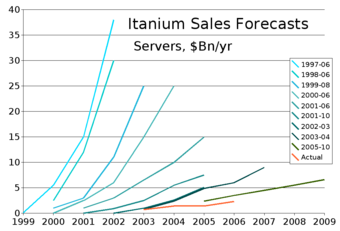
Sales Forecasting
An example of sales forecasting for a company over a decade.
Forecasting: Gross Sales and Net Sales
Net sales = Gross sales – (Customer discounts, returns, allowances)
Gross sales are the sum of all sales during a time period. Net sales are gross sales minus sales returns, sales allowances, and sales discounts. Gross sales do not normally appear on an income statement. The sales figures reported on an income statement are net sales.
- sales returns are refunds to customers for returned merchandise/credit notes
- debit notes
- sales journal entries non-current, current batch-processed transactions, predictive analytics in strategic management/administration/governance research metaframeworks
- sales allowances are reductions in sales price for merchandise with minor defects, the allowance agreed upon after the customer has purchased the merchandise
- sales discounts allowed are reduced payments from the customer based on invoice payment terms such as 2/10, n/30 (2% discount if paid within 10 days, net invoice total due in 30 days)
- interest received for amounts in arrears
- includes/excludes amounts capital goods & services, non-capital goods & services, input valued-added tax, with cost of non-capital goods sold
- input vat – output vat
- sales of portfolio items and capital gains taxes
- Sales Returns and Allowances and Sales Discounts are contra-revenue accounts
Sales Forecasting
In launching a program, managers often start with an idea of the dollar profit they desire and ask what sales levels will be required to reach it. Target volume is the unit sales quantity required to meet an earnings goal. Target revenue is the corresponding figure for dollar sales. Both of these metrics can be viewed as extensions of break-even analysis. Increasingly, marketers are expected to generate volumes that meet the target profits of their firm. This will often require them to revise sales targets as prices and costs change.
- Target volume: the volume of sales necessary to generate the profits specified in a company’s plans.
- Target Volume = [Fixed costs + Target Profits] / Contribution per Unit
- The formula for target volume will be familiar to those who have performed break-even analysis. The only change is to add the required profit target to the fixed costs. From another perspective, the break-even volume equation can be viewed as a special case of the general target volume calculation — one in which the profit target is zero, and a company seeks only to cover its fixed costs.
- In target volume calculations, the company broadens this objective to solve for a desired profit.
- Target Revenue = Target Volume * Selling Price per Unit; or
- Target Revenue = 100 * [ { Fixed Costs + Target Profits } / Contribution Margin ]
The purpose of profit-based sales target metrics is to ensure that marketing and sales objectives mesh with profit targets. In target volume and target revenue calculations, managers go beyond break-even analysis (the point at which a company sells enough to cover its fixed costs) to determine the level of unit sales or revenues needed not only to cover a firm’s costs but also to attain its profit targets.
4.3.2: Inputs to the Production Schedule
Production schedule can be divided into raw materials, work in process, finished goods and goods for resale.
Learning Objective
Differentiate the different production schedule inputs
Key Points
- A good purchased as a “raw material” goes into the manufacture of a product.
- A good only partially completed during the manufacturing process is called “work in process”.
- When the good is completed as to manufacturing but not yet sold or distributed to the end-user, it is called a “finished good”.
- Inventory management is primarily about specifying the shape and percentage of stocked goods.
- Basic reasons for keeping an inventory involve time, uncertainty and economics of scales.
Key Term
- ABC analysis
-
The ABC analysis is a business term used to define an inventory categorization technique often used in materials management. It is also known as Selective Inventory Control. Policies based on ABC analysis: A ITEMS, very tight control and accurate records; B ITEMS, less tightly controlled, and good records; and C ITEMS, simplest controls possible and minimal records.
Example
- By taking the Costs-To-Date divided by the Cost Estimate, the “percentage complete” for the project is calculated. For example: Assume a project is estimated to cost $70,000 by the time the work is complete, Assume at the end of December, $35,000 has been spent to date for the project, $35,000 divided by $70,000 is 50%, therefore, the project can be considered 50% complete at December 31.
Production schedule inputs:
- A good purchased as a “raw material” goes into the manufacture of a product.
- A good only partially completed during the manufacturing process is called “work in process. “
- When the good is completed as to manufacturing but not yet sold or distributed to the end user, it is called a “finished good. “
Raw materials – materials and components scheduled for use in making a product.
A raw material is the basic material from which a product is manufactured or made, frequently used with an extended meaning. For example, the term is used to denote material that came from nature and is in an unprocessed or minimally processed state. Latex, iron ore, logs, and crude oil, and salt water are examples. The use of raw material by non-human species includes twigs and found objects as used by birds to make nests.
Work in process, WIP – materials and components that have begun their transformation to finished goods.
Work in process (WIP) or in-process inventory includes the set at large of unfinished items for products in a production process. These items are not yet completed but either just being fabricated or waiting in a queue for further processing or in a buffer storage. The term is used in production and supply chain management.
Optimal production management aims to minimize work in process. Work in process requires storage space, represents bound capital not available for investment, and carries an inherent risk of earlier expiration of shelf life of the products. A queue leading to a production step shows that the step is well buffered for shortage in supplies from preceding steps, but may also indicate insufficient capacity to process the output from these preceding steps.
Finished goods – goods ready for sale to customers.
Finished goods are goods that have completed the manufacturing process but have not yet been sold or distributed to the end user. Finished goods is a relative term. In a Supply chain management flow, the finished goods of a supplier can constitute the raw material of a buyer.
Goods for resale – returned goods that are salable.
Inventory management
Inventory management is primarily about specifying the shape and percentage of stocked goods. It is required at different locations within a facility or within many locations of a supply network to precede the regular and planned course of production and stock of materials.
The scope of inventory management concerns the fine lines between replenishment lead time, carrying costs of inventory, asset management, inventory forecasting, inventory valuation, inventory visibility, future inventory price forecasting, physical inventory, available physical space for inventory, quality management, replenishment, returns and defective goods, and demand forecasting. Balancing these competing requirements leads to optimal inventory levels, which is an on-going process as the business needs shift and react to the wider environment.
Inventory management involves a retailer seeking to acquire and maintain a proper merchandise assortment while ordering, shipping, handling, and related costs are kept in check. It also involves systems and processes that identify inventory requirements, set targets, provide replenishment techniques, report actual and projected inventory status, and handle all functions related to the tracking and management of material. This would include the monitoring of material moved into and out of stockroom locations and the reconciling of the inventory balances. It also may include ABC analysis, lot tracking, cycle counting support, etc. Management of the inventories, with the primary objective of determining/controlling stock levels within the physical distribution system, functions to balance the need for product availability against the need for minimizing stock holding and handling costs.
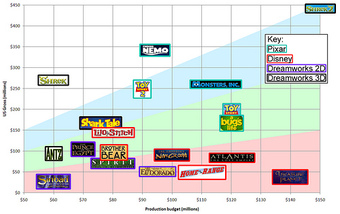
Production budget
Production budget is important for inventory and sales revenue
There are three basic reasons for keeping an inventory:
- Time: The time lags present in the supply chain, from supplier to user at every stage, requires that you maintain certain amounts of inventory to use in this lead time. However, in practice, inventory is to be maintained for consumption during variations in lead time. Lead time itself can be addressed by ordering that many days in advance.
- Uncertainty: Inventories are maintained as buffers to meet uncertainties in demand, supply and movements of goods.
- Economies of scale: Ideal condition of “one unit at a time at a place where a user needs it, when he needs it” principle tends to incur lots of costs in terms of logistics. So bulk buying, movement, and storing brings in economies of scale, thus inventory.

A Sample Production Plan
An example of a production plan covering one week.
4.3.3: Inputs to COGS
COGS is difficult to forecast due to the sheer amount of expenses included and differing methods of estimating each.
Learning Objective
Classify the different components of Cost of Goods Sold (COGS)
Key Points
- Costs include all costs of purchase, costs of conversion, and other costs incurred in bringing the inventories to their present location and condition.
- The key components of cost generally include: parts – raw materials and supplies used, labor – including associated costs such as payroll taxes and benefits, and overhead of the business allocable to production.
- A miscalculation or faulty estimation can be amplified drastically, causing a vastly different forecasted amount of income than what will actually come to pass.
Key Terms
- overhead
-
Any cost or expenditure (monetary, time, effort or otherwise) incurred in a project or activity, which does not directly contribute to the progress or outcome of the project or activity.
- allocate
-
To distribute according to a plan.
Cost of goods sold (COGS) refer to the inventory costs of the goods a business has sold during a particular period. Costs include all costs of purchase, costs of conversion, and other costs incurred in bringing the inventories to their present location and condition. Costs of goods made by the business include material, labor, and allocated overhead. The costs of those goods not yet sold are deferred as costs of inventory until the inventory is sold or written down in value.
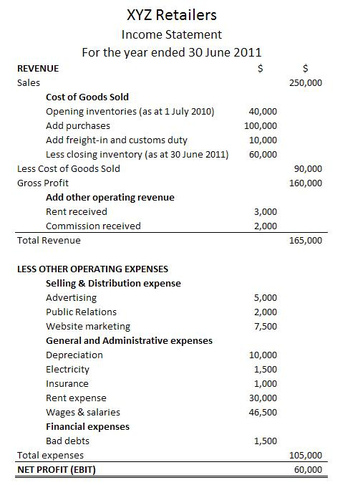
A Sample Income Statement
Expenses are listed on a company’s income statement.
Because costs of goods sold is a major expense for most companies, it is an extremely important input to a forecast of the income statement. A miscalculation or faulty estimation can be amplified drastically, causing a vastly different forecasted amount of income than what will actually come to pass. Specifically, underestimating the costs associated with goods to be sold can cause the forecasted income to be much higher than what it actually will be, and vice versa. Also, because cost of goods sold is such a broad input, encompassing many separate expenses with different methods of estimating each, it becomes difficult to accurately forecast all phases.
Components of COGS
Parts, Raw Materials, and Supplies Used
Most businesses make more than one of a particular item. Therefore, costs are incurred for multiple items rather than a particular item sold. Determining how much of each of these components to allocate to particular goods requires either tracking the particular costs or making some allocations of costs. Parts and raw materials are often tracked to particular sets (e.g., batches or production runs) of goods, then allocated to each item.
Labor and Associated Costs
Labor costs include direct labor and indirect labor. Direct labor costs are the wages paid to those employees who spend all their time working directly on the product being manufactured. Indirect labor costs are the wages paid to other factory employees involved in production. Costs of payroll taxes and employee benefits are generally included in labor costs, but may be treated as overhead costs. Labor costs may be allocated to an item or set of items based on timekeeping records.
Overhead of the Business Allocable to Production
Determining overhead costs often involves making assumptions about what costs should be associated with production activities and what costs should be associated with other activities. Traditional methods attempt to make these assumptions based on past experience and management judgment as to factual relationships. Activity based costing attempts to allocate costs based on those factors that drive the business to incur the costs.
Variable production overheads are allocated to units produced based on actual use of production facilities. Fixed production overheads are often allocated based on normal capacities or expected production. More or fewer goods may be produced than expected when developing cost assumptions (like burden rates). These differences in production levels often result in too much or too little cost being assigned to the goods produced. This also gives rise to variances.
4.3.4: Other Expenses
Other expenses include SG&A, depreciation, amortization, R&D, finance costs, income tax expense, discontinued operations expenses.
Learning Objective
Differentiate the different inputs that are classified as “other expenses”
Key Points
- Other expenses include operation expenses section and non-operation expenses section.
- Operation section expenses include SG&A, depreciation, amortization, and R&D expenses.
- Non-operation section expenses include finance costs, income tax expense, and discontinued operations expenses.
- SG&A is usually understood as a major portion of non-production related costs, in contrast to production costs such as direct labour.
Key Terms
- intangible assets
-
Intangible assets are defined as identifiable non-monetary assets that cannot be seen, touched or physically measured, and are created through time and effort, and are identifiable as a separate asset.
- deferred tax liabilities
-
Deferred tax liabilities generally arise where tax relief is provided in advance of an accounting expense, or income is accrued but not taxed until received.
Example
- Extraordinary items: natural disaster might not qualify depending on location.
Operation Section:

Expenses
Operational expenses and non-operational expenses are the main cash outflow of a business.
Selling, General, and Administrative expenses (SG&A or SGA)
Selling, General, and Administrative expenses (SG&A or SGA) consist of the combined payroll costs. SGA is usually understood as a major portion of non-production related costs, in contrast to production costs such as direct labor.
- Selling expenses – represent expenses needed to sell products (e.g. salaries of sales people, commissions and travel expenses, advertising, freight, shipping, depreciation of sales store buildings and equipment, rent, and all expenses and taxes directly related to producing and selling product, etc. )
- General expenses- general operating expenses and taxes that are directly related to the general operation of the company, but don’t relate to the other two categories.
- Administrative expenses – executive salaries, general support, and all associated taxes related to the overall administration of the company.
Depreciation
1. The decrease in value of assets (fair value depreciation).
2. The allocation of the cost of assets to periods in which the assets are used (depreciation with the matching principle).
The former affects values of businesses and entities. The latter affects net income. Generally, the cost is allocated, as depreciation expense, among the periods in which the asset is expected to be used. Such expense is recognized by businesses for financial reporting and tax purposes. Methods of computing depreciation may vary by asset for the same business. Methods and lives may be specified in accounting and/or tax rules in a country. Several standard methods of computing depreciation expense may be used, including fixed percentage, straight line, and declining balance methods. Depreciation expense generally begins when the asset is placed in service.
Amortization
Amortization (or amortisation) is the process of decreasing or accounting for an amount over a period. When used in the context of a home purchase, amortization is the process by which loan principal decreases over the life of a loan. With each mortgage payment that is made, a portion of the payment is applied towards reducing the principal, and another portion of the payment is applied towards paying the interest on the loan. An amortization table shows this ratio of principal and interest and demonstrates how a loan’s principal amount decreases over time. Amortization is generally known as depreciation of intangible assets of a firm.
Research & Development (R&D) Expenses
The term R&D or research and development refers to a specific group of activities within a business. The activities that are classified as R&D differ from company to company, but there are two primary models. In one model, the primary function of an R&D group is to develop new products. In the other model, the primary function of an R&D group is to discover and create new knowledge about scientific and technological topics for the purpose of uncovering and enabling development of valuable new products, processes, and services.
Non-operating section
- Other expenses or losses – expenses or losses not related to primary business operations, (e.g. foreign exchange loss).
- Finance costs – costs of borrowing from various creditors (e.g. interest expenses, bank charges).
- Income tax expense – sum of the amount of tax payable to tax authorities in the current reporting period (current tax liabilities/ tax payable) and the amount of deferred tax liabilities (or assets).
- Discontinued operations are the most common type of irregular items. Shifting business location(s), stopping production temporarily, or changes due to technological improvement do not qualify as discontinued operations. Discontinued operations must be shown separately.
- Extraordinary items are both unusual (abnormal) and infrequent, for example, unexpected natural disaster, expropriation, prohibitions under new regulations.
4.3.5: Pro Forma Income Statement
A pro forma income statement is planned and prepared in advance to of a transaction to project the future status of the company.
Learning Objective
Prepare a pro forma income statement
Key Points
- The pro forma accounting is a statement of the company’s financial activities while excluding “unusual and nonrecurring transactions” when stating how much money the company actually made.
- Income statement is a company’s financial statement that indicates how the revenue is transformed into the net income during a certain period of time.
- Pro forma Income statement includes revenue, COGS, operational expenses and non-operational expenses.
Key Terms
- depreciation
-
The measurement of the decline in value of assets. Not to be confused with impairment, which is the measurement of the unplanned, extraordinary decline in value of assets.
- pro forma
-
For the sake of form only.
- write-off
-
The term written-off describes a reduction in recognized value. In accounting terminology, it refers to recognition of the reduced or zero value of an asset.
Pro forma
The term pro forma, Latin for “as a matter of form” or “for the sake of form”, is a term applied to practices or documents that are done as a pure formality, perfunctorily, or seek to satisfy the minimum requirements or to conform to a convention or doctrine. It has different meanings in different fields.
Pro forma financial statements are prepared in advance of a planned transaction, such as a merger, an acquisition, a new capital investment, or a change in capital structure like an incurrence of new debt or issuance of equity.
The pro forma models the anticipated results of the transaction, with particular emphasis on the projected cash flows, net revenues and (for taxable entities) taxes. Consequently, pro forma statements summarize the projected future status of a company, based on the current financial statements. For example, when a transaction with a material effect on a company’s financial condition is contemplated, the Finance Department will prepare, for management and Board review, a business plan containing pro forma financial statements demonstrating the expected effect of the proposed transaction on the company’s financial viability. Lenders and investors will require such statements to structure or confirm compliance with debt covenants, such as debt service reserve coverage and debt to equity ratios. Similarly, when a new corporation is envisioned, its founders will prepare pro forma financial statements for the information of prospective investors.
Pro forma accounting is a statement of the company’s financial activities while excluding “unusual and nonrecurring transactions” when stating how much money the company actually made. Expenses often excluded from pro forma results include company restructuring costs, a decline in the value of the company’s investments, or other accounting charges, such as adjusting the current balance sheet to fix faulty accounting practices in previous years.
Income Statement
The income statement is a company’s financial statement that indicates how the revenue is transformed into the net income (the result after all revenues and expenses have been accounted for, also known as Net Profit or the “bottom line”). It displays the revenues recognized for a specific period, and the cost and expenses charged against these revenues, including write-offs (e.g., depreciation and amortization of various assets) and taxes.
Pro Forma Income Statement
Pro forma figures should be clearly labeled as such and the reason for any deviation from reported past figures clearly explained. A pro forma Income statement could be planned and prepared in advance, which includes the items below:
Operating Section:
- Revenue – Cash inflows or other enhancements of assets of an entity during a period from delivering or producing goods, rendering services, or other activities that constitute the entity’s ongoing major operations. It is usually presented as sales minus sales discounts, returns, and allowances.
- Expenses – Cash outflows or other using-up of assets or incurrence of liabilities during a period from delivering or producing goods, rendering services, or carrying out other activities that constitute the entity’s ongoing major operations.
- Cost of Goods Sold (COGS) / Cost of Sales – represents the direct costs attributable to goods produced and sold by a business (manufacturing or merchandizing). It includes material costs, direct labour, and overhead costs (as in absorption costing).
- Selling, General and Administrative expenses (SG&A or SGA) – consist of the combined payroll costs. SGA is usually understood as a major portion of non-production related costs, in contrast to production costs such as direct labour.
- Depreciation / Amortization – the charge with respect to fixed assets / intangible assets that have been capitalised on the balance sheet for a specific (accounting) period. It is a systematic and rational allocation of cost rather than the recognition of market value decrement.
- Research & Development (R&D) expenses – expenses included in research and development.
Non-Operating Section:
- Other revenues or gains – income from other than primary business activities (e.g. rent, income from patents). It also includes gains that are either unusual or infrequent, but not both (e.g. gain from sale of securities or gain from disposal of fixed assets)
- Other expenses or losses – not related to primary business operations, (e.g. foreign exchange loss).
- Finance costs – costs of borrowing from various creditors (e.g. interest expenses, bank charges).
- Income tax expense – sum of the amount of tax payable to tax authorities in the current reporting period (current tax liabilities / tax payable) and the amount of deferred tax liabilities (or assets).
- Irregular items – these are reported separately because this way users can better predict future cash flows – irregular items most likely will not recur. These are reported net of taxes.
- Discontinued operations is the most common type of irregular items. Shifting business location(s), stopping production temporarily, or changes due to technological improvement do not qualify as discontinued operations. Discontinued operations must be shown separately.
4.4: Forecasting the Balance Sheet
4.4.1: Pro Forma Balance Sheet
A pro forma balance sheet summarizes the projected future status of a company after a planned transaction, based on the current financial statements.
Learning Objective
Prepare pro forma balance sheets when the situation requires
Key Points
- The pro forma accounting is a statement of the company’s financial activities while excluding “unusual and nonrecurring transactions” when stating how much money the company actually made.
- In business, pro forma financial statements are prepared in advance of a planned transaction, such as a merger, an acquisition, a new capital investment, or a change in capital structure such as incurrence of new debt or issuance of equity.
- Pro forma figures should be clearly labeled as such and the reason for any deviation from reported past figures clearly explained.
Key Terms
- a merger, an acquisition
-
Mergers and acquisitions (abbreviated M&A) is an aspect of corporate strategy, corporate finance, and management dealing with the buying, selling, dividing, and combining of different companies and similar entities that can help an enterprise grow rapidly in its sector or location of origin, or a new field or new location, without creating a subsidiary, other child entity or using a joint venture.
- intangible assets
-
Intangible assets are defined as identifiable non-monetary assets that cannot be seen, touched, or physically measured. They are created through time and effort, and are identifiable as a separate asset.
- warranties
-
In business and legal transactions, a warranty is an assurance by one party to the other party that specific facts or conditions are true or will happen. The other party is permitted to rely on that assurance and seek some type of remedy if it is not true or followed.
Example
- For example, when a transaction with a material effect on a company’s financial condition is contemplated, the Finance Department will prepare, for management and board review, a business plan containing pro forma financial statements demonstrating the expected effect of the proposed transaction on the company’s financial viability.
Pro Forma Financial Statements
In business, pro forma financial statements are prepared in advance of a planned transaction, such as a merger, an acquisition, a new capital investment, or a change in capital structure such as incurrence of new debt or issuance of equity. The pro forma models the anticipated results of the transaction, with particular emphasis on the projected cash flows, net revenues and (for taxable entities) taxes. Consequently, pro forma statements summarize the projected future status of a company, based on the current financial statements. For example, when a transaction with a material effect on a company’s financial condition is contemplated, the Finance Department will prepare, for management and Board review, a business plan containing pro forma financial statements demonstrating the expected effect of the proposed transaction on the company’s financial viability.
Pro Forma Balance Sheet
If applicable to the business, summary values for the following items should be included in the pro forma balance sheet :
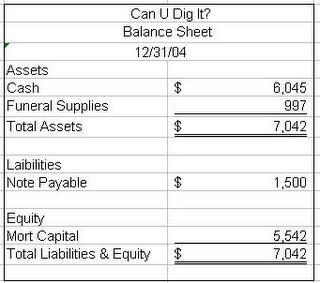
Balance Sheet
Simple balance sheet including basic items
-
Assets
- Current assets
- Cash and cash equivalents
- Accounts receivable
- Inventories
- Prepaid expenses for future services that will be used within a year
- Non-current assets (Fixed assets)
- Property, plant and equipment
- Investment property, such as real estate held for investment purposes
- Intangible assets
- Financial assets (excluding investments accounted for using the equity method, accounts receivables, and cash and cash equivalents)
- Investments accounted for using the equity method
- Biological assets, which are living plants or animals. Bearer biological assets are plants or animals which bear agricultural produce for harvest, such as apple trees grown to produce apples and sheep raised to produce wool.
-
Liabilities
- Accounts payable
- Provisions for warranties or court decisions
- Financial liabilities (excluding provisions and accounts payable), such as promissory notes and corporate bonds
- Liabilities and assets for current tax
- Deferred tax liabilities and deferred tax assets
- Unearned revenue for services paid for by customers, but not yet provided
- Equity
- The net assets shown by the balance sheet equals the third part of the balance sheet, which is known as the shareholders’ equity. It comprises:
- Issued capital and reserves attributable to equity holders of the parent company (controlling interest)
- Non-controlling interest in equity
- Formally, shareholders’ equity is part of the company’s liabilities: they are funds “owing” to shareholders (after payment of all other liabilities). Usually, however, “liabilities” is used in the more restrictive sense of liabilities excluding shareholders’ equity. The balance of assets and liabilities (including shareholders’ equity) is not a coincidence. Records of the values of each account in the balance sheet are maintained using a system of accounting known as double-entry bookkeeping. In this sense, shareholders’ equity by construction must equal assets minus liabilities, and are a residual.
- Regarding the items in equity section, the following disclosures are required:
- Numbers of shares authorized, issued and fully paid, and issued but not fully paid
- Par value of shares
- Reconciliation of shares outstanding at the beginning and the end of the period
- Description of rights, preferences, and restrictions of shares
- Treasury shares, including shares held by subsidiaries and associates
- Shares reserved for issuance under options and contracts
- A description of the nature and purpose of each reserve within owners’ equity
Lenders and investors will require such statements to structure or confirm compliance with debt covenants such as debt service reserve coverage and debt to equity ratios. Similarly, when a new corporation is envisioned, its founders will prepare pro forma financial statements for the information of prospective investors. Pro forma figures should be clearly labeled as such and the reason for any deviation from reported past figures clearly explained.
4.4.2: Balance Sheet Analysis
Balance sheet analysis is process of understanding the risk and profitability of a firm through analysis of reported financial information.
Learning Objective
Analyze a company’s balance sheet
Key Points
- Balance sheet is a summary of the financial balances of a sole proprietorship, a business partnership, a corporation or other business organization. Assets, liabilities and ownership equity are listed as of a specific date, such as the end of its financial year.
- Balance sheet analysis (or financial analysis) the process of understanding the risk and profitability of a firm (business, sub-business or project) through analysis of reported financial information, particularly annual and quarterly reports.
- Financial ratio analysis should be based on regrouped and adjusted financial statements. Two types of ratio analysis are performed: 3.1) Analysis of risk and 3.2) analysis of profitability.
- Balance sheet analysis consists of 1) reformulating reported Balance sheet, 2) analysis and adjustments of measurement errors, and 3) financial ratio analysis on the basis of reformulated and adjusted Balance sheet.
Key Terms
- RNOA
-
return on net operating assets
- NFD
-
net financial debt
- NFIR
-
the net financial interest rate
Balance sheet
In financial accounting, a balance sheet or statement of financial position is a summary of the financial balances of a sole proprietorship, a business partnership, a corporation or other business organization. Assets, liabilities and ownership equity are listed as of a specific date, such as the end of its financial year. A balance sheet is often described as a “snapshot of a company’s financial condition”. Of the four basic financial statements, the balance sheet is the only statement which applies to a single point in time of a business’ calendar year.
A business operating entirely in cash can measure its profits by withdrawing the entire bank balance at the end of the period, plus any cash in hand. However, many businesses are not paid immediately; they build up inventories of goods and they acquire buildings and equipment. In other words: businesses have assets and so they cannot, even if they want to, immediately turn these into cash at the end of each period. Often, these businesses owe money to suppliers and to tax authorities, and the proprietors do not withdraw all their original capital and profits at the end of each period. In other words businesses also have liabilities.
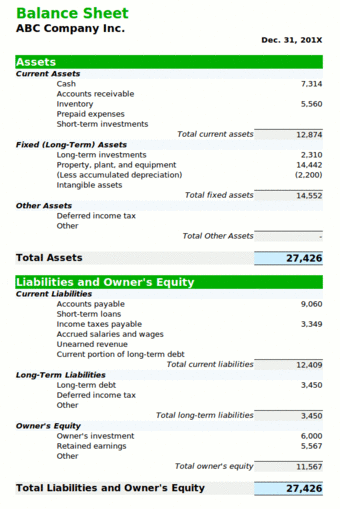
Balance Sheet
An example of a classified balance sheet.
Balance sheet analysis
Balance sheet analysis (or financial analysis) the process of understanding the risk and profitability of a firm (business, sub-business or project) through analysis of reported financial information, particularly annual and quarterly reports.
Balance sheet analysis consists of 1) reformulating reported Balance sheet, 2) analysis and adjustments of measurement errors, and 3) financial ratio analysis on the basis of reformulated and adjusted Balance sheet. The two first steps are often dropped in practice, meaning that financial ratios are just calculated on the basis of the reported numbers, perhaps with some adjustments. Financial statement analysis is the foundation for evaluating and pricing credit risk and for doing fundamental company valuation.
Financial ratio analysis should be based on regrouped and adjusted financial statements. Two types of ratio analysis are performed: 3.1) Analysis of risk and 3.2) analysis of profitability:
3.1) Analysis of risk typically aims at detecting the underlying credit risk of the firm. Risk analysis consists of liquidity and solvency analysis. Liquidity analysis aims at analyzing whether the firm has enough liquidity to meet its obligations when they should be paid. A usual technique to analyze illiquidity risk is to focus on ratios such as the current ratio and interest coverage. Cash flow analysis is also useful. Solvency analysis aims at analyzing whether the firm is financed so that it is able to recover from a losses or a period of losses.
3.2) Analysis of profitability refers to the analysis of return on capital, for example return on equity, ROE, defined as earnings divided by average equity. Return on equity, ROE, could be decomposed: ROE = RNOA + (RNOA – NFIR) * NFD/E
Purposes of balance sheet analysis
“The objective of financial statements is to provide information about the financial position, performance and changes in financial position of an enterprise that is useful to a wide range of users in making economic decisions. ” Financial statements should be understandable, relevant, reliable and comparable. Reported assets, liabilities, equity, income and expenses are directly related to an organization’s financial position.
Financial statements are intended to be understandable by readers who have “a reasonable knowledge of business and economic activities and accounting and who are willing to study the information diligently. ” Financial statements may be used by users for different purposes:
- Owners and managers require financial statements to make important business decisions that affect its continued operations. Financial analysis is then performed on these statements to provide management with a more detailed understanding of the figures. These statements are also used as part of management’s annual report to the stockholders.
- Employees also need these reports in making collective bargaining agreements (CBA) with the management, in the case of labor unions or for individuals in discussing their compensation, promotion and rankings.
- Prospective investors make use of financial statements to assess the viability of investing in a business. Financial analyses are often used by investors and are prepared by professionals (financial analysts), thus providing them with the basis for making investment decisions.
- Financial institutions (banks and other lending companies) use them to decide whether to grant a company with fresh working capital or extend debt securities (such as a long-term bank loan or debentures) to finance expansion and other significant expenditures.
- Government entities (tax authorities) need financial statements to ascertain the propriety and accuracy of taxes and other duties declared and paid by a company.
- Vendors who extend credit to a business require financial statements to assess the creditworthiness of the business.
- Media and the general public are also interested in financial statements for a variety of reasons.
4.5: Building a Cash Budget
4.5.1: Receipts
Forecasting incoming cash flows via receipts is a useful tool for organizations to determine the amount of cash that will be available on hand.
Learning Objective
Learn what organizational assets can be considered cash receivables, and understand how to forecast these receivables
Key Points
- Forecasting receipts is an important responsibility in corporate finance, as predicting cash on hand is critical in ensuring that organizations can invest their capital in a meaningful way.
- Receipts and disbursements are the two inputs of cash flow forecasting, particularly in the short term. Receipts include accounts receivable, interest on short-term investments, and the sale of assets.
- In the shorter term, predicting receipts is largely a process of compiling existing established contractual agreements. In the longer term, receipts can be predicted through understanding trends and growth over time.
Key Terms
- disbursements
-
Money paid out or spent.
- Receipts
-
Potential sources of incoming cash over a given time frame.
Why Forecast Receipts?
The broader field of cash flow forecasting is integral to ensuring organizational liquidity. Maintaining cash receipts over a given time frame enables organizations to have cash at hand in a predictable fashion, thus allowing them to reinvest in business operations to avoid the opportunity cost of having unused cash and cash receivables. Forecasting cash inflows and outflows in advance is a primary role of corporate financiers and accountants, and enables efficient use of existing assets to capture maximum competitive value in the marketplace.
Cash Receipts and Disbursements (R&D)
The direct method of projecting incoming cash flow is through understanding cash receipts and disbursements of the time period being projected.
Receipts
Receipts generally refer to the collection of accounts receivable, which are the payments of paying customers over time. Receipts also refer to the returns off of short-term investments as well as the sale of various assets. There are other potential incoming cash flows that also fall under receipts, which are worth noting on a case by case basis.
Disbursements
On the inverse side of receipts, disbursements are outgoing cash flows during a short-term business operation. These can quite accurately project accounts payable, payroll costs, dividend payments, interest payments, and other short-term alterations to existing cash flow. By comparing receipts with disbursements, the overall available cash flow can be derived.
How to Forecast Receipts
As with all forecasting, shorter term forecasts are more certain than longer term forecasts (in general). Short term forecasts can be quite accurate, as the various accounts receivable, accounts payable, short-term investments and short-term costs are often relatively established (contractually and operationally). In shorter term situations, most forecasting is done through implementing what is known with the probability that these obligations will be met.
With longer term forecasting, it can be useful to consider past averages over time. Larger organizations can look at their average cash receipts over the past few years, and couple that with growth trajectories to project what level of cash inflow is likely over a given time frame. It’s important to keep in mind that forecasts are only estimations, and organizations should be aware of the error margins involved.
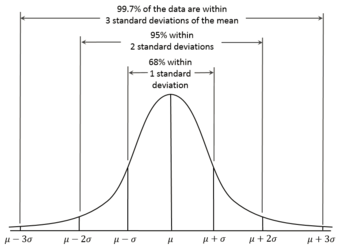
Normal Distributions
When creating a forecast utilizing past data, it is important to recognize the degree of certainty that can be reasonably applied to this forecast. By creating a normalized distribution, and identifying the percentage likelihood of a certain outcome, organizations can better prepare for all likely outcomes.
4.5.2: Payments
Cash payments describe cash flowing out of a business resulting from operating activities, investment activities and financing activities.
Learning Objective
Analyze a company’s disbursement cycle
Key Points
- Cash payments must be made for relevant expenses, which include those to suppliers for inventory or other supplies, employees for wages, government for taxes, and lenders for interest on borrowed money.
- A company’s objective in regards to the cash dispersement cycle should be to increase the cycle time, or delay making payments until they are due.
- Typical cash outflows from investing activities include purchase of capital assets, purchase of bonds/notes or shares of other entities, and loans to other entities.
- Typical cash outflows from financing activities include payments of dividends to the company’s own shareholders, redemption (repurchase) of company’s own shares, and repayment of principal and interest on company’s own bonds or notes.
Key Term
- disbursement
-
Money paid out or spent.
Why is cash flow forecasting important? If a business runs out of cash and is not able to obtain new financing, it will become insolvent. It is no excuse for management to claim that they didn’t see a cash flow crisis coming. So in business, “cash is king”.
Cash Payments
Cash payments describe cash flowing out of a business. These cash payments can result from operating activities, investment activities and financing activities.
Generally speaking, normal operating activities refer to the cash effects of transactions involving revenues and expenses that impact net income. Cash payments must be made for relevant expenses. Typical payments include those to:
- Suppliers for inventory or other supplies
- Employees for wages
- Government for taxes
- Lenders for interest on borrowed money
Typical cash outflows from investing activities include:
- Purchase of capital assets
- Purchase of bonds/notes or shares of other entities
- Loans to other entities
Typical cash outflows from financing activities include:
- Payments of dividends to the company’s own shareholders
- Redemption (repurchase) of company’s own shares
- Repayment of principal and interest on company’s own bonds or notes
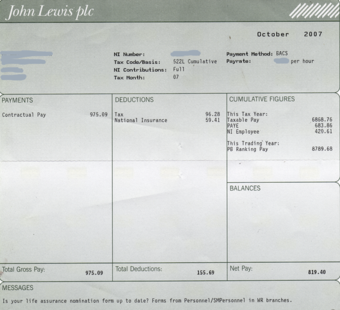
Sample Paystub
This is an example of a paystub to an employee, one of the most significant cash disbursements necessary for a company.
Disbursement Cycle
The cash disbursement cycle is important to consider when analyzing cash payments. This is the total time between when an obligation occurs and when the payment clears the bank. A company’s objective regarding the cash disbursement cycle should be to increase the cycle time, or delay making payments until they are due. A firm may delay payments by:
- Mailing checks from locations not close to customers. This will increase the mail time, or mail float, within the disbursement cycle.
- Disbursing checks from a remote bank. This will increase the time required for the payment to clear the bank.
- Purchasing with credit cards so that the time required for making payment is much longer. By using a credit card, you will receive a bill at the end of the month payable in 30 days. This creates more processing time or processing float.
Therefore, when a company manages cash flow cycles, it tries to control three types of float times:
- Mail float, or the time spent for a payment in the mail.
- Clearance float, or the time spent for a payment to clear the bank.
- Processing float, or the time required to process cash flow transactions.
4.5.3: The Forecast Budget
Understanding cash and liquidity needs is critical for organizations to capture opportunities and ensure all profitable processes are funded.
Learning Objective
Understand the various methods of forecasting budgets, and the importance of doing so regularly
Key Points
- Liquidity, or the ability to have cash on hand when it is required, is critical to capturing opportunities and ensuring smooth operations.
- Forecasting budgets in advance enables organizations to project what cash will be required during a given operating time frame and to keep these resources available when necessary.
- For larger organizations, this is usually done at the departmental or operational level, projecting different budgets for different operational teams.
- There are a number of methods involved in forecast budgets, including the direct method, the adjusted net income method, and the accrual reversal method.
Key Terms
- forecast
-
A projection of cash inflows and/or outflows.
- liquidity
-
The ease of turning assets into cash.
The Purpose of Forecasting
Financial planning is a critical financial tool for funding profitable operations and dividing existing organizational assets optimally to pursue revenue maximization. The forecast budget will project what cash flows will be needed for each organizational process, and how those cash flows will be utilized over a fixed period of time. If there is a problem with liquidity during an operational period, it can result in huge opportunity costs (i.e. an organization being unable to capture an existing opportunity in the market).
How to Forecast
There are a number of ways to approach financial forecasting for a cash budget. A cash budget is all about liquidity, and therefore forecasting what available liquidity will be required over a given period is the primary input for forecasting budgets. There are a number of different approaches, though most of them rely on understanding the inputs required for various business operations.
The inputs include the following cash obligations during regular operations:
- Payroll
- Payment of accounts payable
- Dividends
- Interest on debt
- Sourcing raw materials
It’s also worth noting that various cash inflows will occur during a given time period. For example, accounts receivable, short-term financing options, and various other sources of income may directly convert into usable capital. However, budgeting should either build these into the current budget forecast or utilize them during the next calculation of budgetary requirements.
The Direct Method
At its simplest, cash flow forecasting and budgeting can be computed directly based off of fixed information over a short time frame. This works particularly well for consistent businesses that run routine operations with limited risk-taking and diversification in process.
The Adjusted Net Income Method (ANI)
The adjusted net income method starts by calculating operating income (EBIT or EBITDA) and adding/subtracting short-term changes in the balance sheet, such as those that occur to inventories, payable, receivables and other short-term. This gives the organization some idea of what short-term cash flows are typically required during an operational period.
Pro-forma Balance Sheet
Pro-formas are financial statements created in advance as a projection or estimation of what that document will look like after the financial period is finished. By using a pro-forma balance sheet for the upcoming period being budgeted for, the short-term assets and liabilities (if accurately projected) will underline the amount of cash that should be set aside for budgeting purposes.
Accrual Reversal Method
A third option for projecting cash budgets is accrual reversal. This process relies on statistical distributions, reversing large accruals, and projecting cash effects via algorithms. This method requires a good deal of data and statistical skill, and is best utilized for mid-term forecasting (unlike the direct method, which is much better for a shorter time frame). The advantage of this method is that it is often accurate to the day or week, enabling high accuracy.
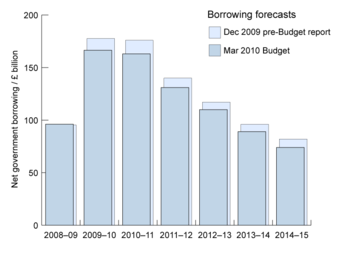
Budget Forecast Example
This chart demonstrates a forecast budget to the reality of what actually occurred. Budgeting is an estimation, often adjustments over time.
4.6: Analyzing Forecasts
4.6.1: Ratio Analysis and EPS
Ratio analysis and EPS are used to compare the strengths and weaknesses of various companies with industry or company benchmarks.
Learning Objective
Classify the different type of financial ratios
Key Points
- Financial analysts use financial ratios to compare the strengths and weaknesses in various companies.
- Financial ratios quantify many aspects of a business and are an integral part of the financial statement analysis. Financial ratios are categorized according to the financial aspect of the business which the ratio measures.
- Earnings per share (EPS) is the amount of earnings per each outstanding share of a company’s stock.
Key Terms
- Diluted EPS
-
Diluted Earnings Per Share (diluted EPS) is a company’s earnings per share (EPS) calculated using fully diluted shares outstanding (i.e. including the impact of stock option grants and convertible bonds).
- Preferred dividends
-
Preferred stock usually carries no voting rights, but may carry a dividend and may have priority over common stock in the payment of dividends and upon liquidation.
- Financial Accounting Standards Board (FASB)
-
The Financial Accounting Standards Board (FASB) is a private, not-for-profit organization whose primary purpose is to develop generally accepted accounting principles (GAAP) within the United States in the public’s interest.
Example
- If preferred dividends total $100,000, then that is money not available to distribute to each share of common stock.
Ratio Analysis
A financial ratio (or accounting ratio) is a relative magnitude of two selected numerical values taken from an enterprise’s financial statements. Often used in accounting, there are many standard ratios used to try to evaluate the overall financial condition of a corporation or other organization. Financial ratios may be used by managers within a firm, by current and potential shareholders (owners) of a firm, and by a firm’s creditors. Financial analysts use financial ratios to compare the strengths and weaknesses in various companies. If shares in a company are traded in a financial market, the market price of the shares is used in certain financial ratios.
Values used in calculating financial ratios are taken from the balance sheet, income statement, statement of cash flows or (sometimes) the statement of retained earnings. These comprise the firm’s “accounting statements” or financial statements. The statements’ data is based on the accounting method and accounting standards used by the organization.
Financial ratios quantify many aspects of a business and are an integral part of the financial statement analysis. Financial ratios are categorized according to the financial aspect of the business which the ratio measures .
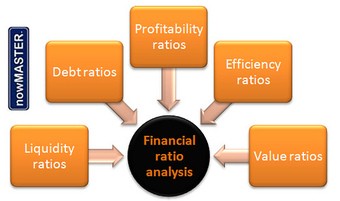
Ratio analysis
Ratio analysis includes profitability ratios, activity (efficiency) ratios, debt ratios, liquidity ratios and market (value) ratios
Liquidity ratios:
Liquidity ratios measure the availability of cash to pay
debt
.
Current ratio (Working Capital Ratio): Current assets / Current liabilities
Acid-test ratio (Quick ratio): (Current assets – Inventory – Prepayments) / Current liabilities
Activity ratios:
Activity ratios measure how quickly a firm converts non-cash assets to cash assets.
Average collection period: Accounts receivable / (Annual credit sales / 365 days)
Average payment period: Accounts payable / (Annual credit purchases / 365 days)
Inventory conversion ratio: 365 days / Inventory turnover
Cash Conversion Cycle: Inventory conversion period + Receivables conversion period – Payables conversion period
Debt ratios
Debt ratios measure the firm’s ability to repay long-term debt.
Debt ratio: Total liabilities / Total assets
Times interest earned ratio (Interest Coverage Ratio): EBIT / Annual interest expense
Profitability
ratios
Profitability ratios measure the firm’s use of its assets and control of its expenses to generate an acceptable rate of
return
.
Gross margin, Gross profit margin or Gross Profit Rate: Gross profit / Net sales
Profit margin, net margin or net profit margin: Net profit / Net sales
Return on equity (ROE): Net income / Average shareholders equity
Return on assets (ROA ratio or Du Pont Ratio): Net income / Average total assets
Market ratios
Market ratios measure
investor
response to owning a company’s stock and also the cost of issuing stock. These are concerned with the
return on
investment
for shareholders, and with the relationship between return and the value of an investment in company’s shares.
Earnings per share (EPS): Net earnings / Number of shares
Payout ratio: Dividends / Earnings
P/E ratio: Market price per share / Diluted EPS
Ratios generally are not useful unless they are benchmarked against something else, like past performance or another company. Thus, the ratios of firms in different industries, which face different risks, capital requirements, and competition are usually hard to compare.
Earnings per share (EPS)
Earnings per share (EPS) is the amount of earnings per each outstanding share of a company’s stock. In the United States, the Financial Accounting Standards Board (FASB) requires companies’ income statements to report EPS for each of the major categories of the income statement: continuing operations, discontinued operations, extraordinary items, and net income.
The EPS formula does not include preferred dividends for categories outside of continued operations and net income. Earnings per share for continuing operations and net income are more complicated in that any preferred dividends are removed from net income before calculating EPS. This is because preferred stock rights have precedence over common stock.
Earnings Per Share (Basic Formula):
Earnings per Share = Profit / Weighted average common shares
Ratios generally are not useful unless they are benchmarked against something else, like past performance or another company. Thus, the ratios of firms in different industries, which face different risks, capital requirements, and competition are usually hard to compare.
4.6.2: Impacts of Forecasting on a Business
Since actual business activities are planned in relation to forecasting, it is very important that realistic expectations and estimations be undertaken.
Learning Objective
Describe how forecasting can help a business improve its operations
Key Points
- Business planning and forecasting refers to the set of activities where business operations are planned against the business strategy.
- Forecasting financial statements comprises the estimation of several values – including sales, costs, and expected interest rates.
- It is always easier to forecast future performance of a business if your business is already up and running because there are past trading results to look at.
- Forecasting can be used in Supply Chain Management to make sure that the right product is at the right place at the right time.
- On a broader level, economic forecasting is the process of making predictions about the economy as a whole.
Key Terms
- supply chain management
-
Supply chain management (SCM) is the management of a network of interconnected businesses involved in the provision of product and service packages required by the end customers in a supply chain.
- inflation
-
In economics, inflation is a rise in the general level of prices of goods and services in an economy over a period of time.
- Egain Forecasting
-
a method of controlling building heating by calculating demand for heating energy that should be supplied to the building in each time unit.
Example
- The financial and economic crisis that erupted in 2007 – arguably the worst since the Great Depression of the 1930’s – was not foreseen by most of the forecasters, even if a few lone analysts had been crying wolf for some time (for example, Nouriel Roubini and Robert Shiller).
Business planning and forecasting refers to the set of activities where business operations are planned against the business strategy, and what forecast activities or results may occur from operational execution during a particular time period. In preparing financial forecasts, firms should always assume they will be reviewed by a bank manager, regulatory agency, or investor. With this goal in mind, the firm should be guided to keep forecasts tidy and easy to understand by grouping cash inflows and outflows in simple ways that are easy to understand quickly.
Forecasting financial statements comprises the estimation of several values – including sales, costs, and expected interest rates. Since actual business activities are planned in relation to these estimations, it is very important that realistic expectations and estimations be undertaken. With this in mind, there are specific points of interest to lenders and investors that need to be addressed. The profitability of a business reflects a sound relationship between market-driven sales projections and accurate cost estimates.
- Have you planned to have sufficient cash to meet your regular bills and also non-regular costs (like annual insurance premiums)?
- Does the financial position of the business remain sound when growth is forecast (this is what the balance sheet is for)?
- Is there a sensible balance between borrowings and the amount contributed by the owner (when the business is raising capital in its own right)?
- Are short and long-term obligations matched with relevant finance options?
- Do key business ratios remain within sensible bounds?
It is always easier to forecast future performance of a business when the business is already up and running because there are past trading results to look at. When a completely new venture is being planned a certain amount of imagination and estimation is required. However, this is in no way a license to be overly optimistic.
Forecasting has applications in many situations and impacts multiple aspects of a business. One such aspect is Supply Chain Management. Forecasting can be used in Supply Chain Management to make sure that the right product is at the right place at the right time. Accurate forecasting will help retailers reduce excess inventory and therefore increase the profit margin. Accurate forecasting will also help them meet consumer demand. On a broader level, economic forecasting is the process of making predictions about the economy as a whole. Forecasts can be carried out at a high level of aggregation — for GDP, inflation, unemployment or the fiscal deficit — or at a more disaggregated level — for specific sectors of the economy or even specific firms .

Economic Impact
Studies on the economic impact of business operations should be taken into account when forecasting financial statements and business activities. For example, a mining company may take into account a study such as the one pictured here.
Other important areas of forecasting include:
- Egain Forecasting
- Land use forecasting
- Player and team performance in sports
- Political Forecasting
- Product forecasting
- Sales Forecasting
- Technology forecasting
- Telecommunications forecasting
- Transport planning and Transportation forecasting
- Weather forecasting
4.6.3: Regression Analysis for Forecast Improvement
Regression Analysis is a causal / econometric forecasting method that is widely used for prediction and forecasting improvement.
Learning Objective
Explain how regression analysis works
Key Points
- Regression Analysis is a causal / econometric forecasting method. Some forecasting methods use the assumption that it is possible to identify the underlying factors that might influence the variable that is being forecast.
- Regression analysis includes several classical assumptions.
- Regression analysis includes many techniques for modeling and analyzing several variables when the focus is on the relationship between a dependent variable and one or more independent variables.
- A large body of techniques for carrying out regression analysis has been developed. Familiar methods, such as linear regression and ordinary least squares regression, are parametric.
Key Terms
- Ordinary least squares regression
-
In statistics, ordinary least squares (OLS) or linear least squares is a method for estimating the unknown parameters in a linear regression model. This method minimizes the sum of squared vertical distances between the observed responses in the dataset and the responses predicted by the linear approximation.
- linear regression
-
In statistics, linear regression is an approach to modeling the relationship between a scalar dependent variable y and one or more explanatory variables denoted X.
- independent
-
not contingent or depending on something else
Example
- One can forecast based on linear relationships. If one variable is linearly related to the other for a long enough period of time, it may be beneficial to predict such a relationship in the future.
Regression Analysis
Regression Analysis is a causal / econometric forecasting method. Some forecasting methods are based on the assumption that it is possible to identify underlying factors that might influence a variable that is being forecast. For example, including information about weather conditions might improve the ability of a model to predict umbrella sales. This is a model of seasonality that shows a regular pattern of up and down fluctuations. In addition to weather, seasonality can also result from holidays and customs such as predicting that sales in college football apparel will be higher during football season as opposed to the off season.
Regression analysis includes a large group of methods that can be used to predict future values of a variable using information about other variables. These methods include both parametric (linear or non-linear) and non-parametric techniques.
Classical assumptions for regression analysis include:
- The sample is representative of the population for the inference prediction.
- The error is a random variable with a mean of zero conditional on the explanatory variables.
- The independent variables are measured with no error. (Note: If this is not so, modeling may be performed instead, using errors-in-variables model techniques).
- The predictors are linearly independent, i.e. it is not possible to express any predictor as a linear combination of the others.
- The errors are uncorrelated, that is, the variance– co-variance matrix of the errors is diagonal, and each non-zero element is the variance of the error.
- The variance of the error is constant across observations (homoscedasticity). (Note: If not, weighted least squares or other methods might instead be used).
In statistics, regression analysis includes many techniques for modeling and analyzing several variables, when the focus is on the relationship between a dependent variable and one or more independent variables. More specifically, regression analysis helps one understand how the typical value of the dependent variable changes when any one of the independent variables is varied, while the other independent variables are held fixed.
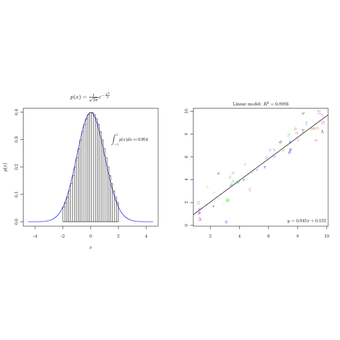
Regression analysis
Regression analysis shows the relationship between a dependent variable and one or more independent variables.
Most commonly, regression analysis estimates the conditional expectation of the dependent variable given the independent variables — that is, the average value of the dependent variable when the independent variables are fixed. Less commonly, the focus is on a quantile, or other location parameter of the conditional distribution of the dependent variable given the independent variables. In all cases, the estimation target is a function of the independent variables called the regression function. In regression analysis, it is also of interest to characterize the variation of the dependent variable around the regression function, which can be described by a probability distribution.
Forecast Improvement
Regression analysis is widely used for prediction and forecasting, where its use has substantial overlap with the field of machine learning. Regression analysis is also used to understand which among the independent variables is related to the dependent variable, and to explore the forms of these relationships. In restricted circumstances, regression analysis can be used to infer causal relationships between the independent and dependent variables. However, this can lead to illusions or false relationships, so caution is advisable.
A large body of techniques for carrying out regression analysis has been developed. Familiar methods, such as linear regression and ordinary least squares regression, are parametric, in that the regression function is defined in terms of a finite number of unknown parameters that are estimated from the data. Nonparametric regression refers to techniques that allow the regression function to lie in a specified set of functions, which may be infinite-dimensional.
The performance of regression analysis methods in practice depends on the form of the data generating process and how it relates to the regression approach being used. Since the true form of the data-generating process is generally not known, regression analysis often depends to some extent on making assumptions about this process. These assumptions are sometimes testable if a large amount of data is available. Regression models for prediction are often useful even when the assumptions are moderately violated, although they may not perform optimally. However, in many applications, especially with small effects or questions of causality based on observational data, regression methods give misleading results.
4.6.4: Impact of Modifying Inputs on Business Operations
Modifying inputs such as accounts receivable, inventory, and accounts payable will significantly influence forecasting and business operations.
Learning Objective
Explain how modifying different inputs will influence financial forecasts
Key Points
- Accounts receivable has a great effect on a firm’s expected cash inflows, and thus modifying this input on a forecast will affect how much cash a company decides to have on hand.
- Because of its prevalence as an expense, modifying the amount of inventory will have far reaching consequences on all forecasted financial statements.
- Accounts payable will influence the current liabilities of a business; therefore, its modification will change a company’s perspective on the amount of cash-on-hand needed.
Key Terms
- forecast
-
An estimation of a future condition.
- solvency
-
The state of having enough funds or liquid assets to pay all of one’s debts; the state of being solvent.
- liquidity
-
Availability of cash over short term: ability to service short-term debt.
Example
- For example, 2%,30 Net 31 terms mean that the payor will deduct 2% from the invoice if payment is made within 30 days. If the payment is made on Day 31 then the full amount is paid.
Inputs
The inputs of accounts receivable, inventory, accounts payable, and other line items on financial statements provide important data for financial forecasting. Modifying any one of these inputs can lead to major changes in forecasts. Similarly, drastic differences in expected values and actual values in regard to these inputs can cause problems for a company, possibly even leading to insolvency.
Accounts Receivable
Accounts receivable is money owed to a business by its customers and shown on its balance sheet as an asset. It is one of a series of accounting transactions dealing with the billing of a customer for goods and services that the customer has ordered. A business must not only anticipate the level of sales that will be made on credit, but it must also anticipate when payment on these accounts will occur and account for the fact that some of these credit accounts will default. Accounts receivable has a great effect on a firm’s expected cash inflows, and thus modifying this input on a forecast will affect how much cash a company decides to have on hand.
Inventory
Inventory management is primarily about specifying the scope and percentage of stocked goods. It is required at different locations within a facility or within many locations of a supply network to precede the regular and planned course of production and stock of materials. The scope of inventory management concerns the fine lines between replenishment lead time, carrying costs of inventory, asset management, inventory forecasting, inventory valuation, inventory visibility, future inventory price forecasting, physical inventory, available physical space for inventory, quality management, replenishment, returns and defective goods, and demand forecasting. Balancing these competing requirements leads to optimal inventory levels, which is an on-going process as the business needs shift and react to the wider environment.
Companies that rely on the sale of physical goods — i.e., those that must carry inventory — must manage inventory in such as way as to decrease expenses as much as possible. Since inventory is such a prevalent expense, accurate forecasting is of the utmost importance. Moreover, the modification of this particular input will have expansive effects on all of the financial statements a firm must forecast.

Inventory
Inventory management is a modifying input that can impact financial forecasts
Accounts Payable
Accounts payable is money owed by a business to its suppliers and is shown on its balance sheet as a liability. Commonly, a supplier will ship a product, issue an invoice, and collect payment later, which describes a cash conversion cycle. This is the period of time during which the supplier has already paid for raw materials but hasn’t been paid in return by the final customer.
Accounts payable will influence the current liabilities of a business, which will accordingly influence the liquidity of the business. A major requirement for a business to continue its operations is for that business to maintain solvency. Modifying accounts payable will drastically change the amount of cash-on-hand required for a business.
Chapter 3: Analyzing Financial Statements
3.1: Standardizing Financial Statements
3.1.1: Balance Sheets
A standard balance sheet has three parts: assets, liabilities, and ownership equity; Asset = Liabilities + Equity.
Learning Objective
Identify the basics of a balance sheet
Key Points
- Of the four basic financial statements, the balance sheet is the only statement which applies to a single point in time of a business’ calendar year.
- The main categories of assets are usually listed first (in order of liquidity) and are followed by the liabilities.
- The difference between the assets and the liabilities is known as “equity”.
- Balance sheets can either be in the report form or the account form.
- A balance sheet is often presented alongside one for a different point in time (typically the previous year) for comparison.
- Guidelines for balance sheets of public business entities are given by the International Accounting Standards Board and numerous country-specific organizations/companies.
Key Terms
- asset
-
Something or someone of any value; any portion of one’s property or effects so considered.
- equity
-
Ownership, especially in terms of net monetary value, of a business.
- balance sheet
-
A summary of a person’s or organization’s assets, liabilities and equity as of a specific date.
Balance sheet
In financial accounting, a balance sheet or statement of financial position is a summary of the financial balances of a sole proprietorship, a business partnership, a corporation or other business organization, such as an LLC or an LLP. Assets, liabilities and ownership equity are listed as of a specific date, such as the end of its financial year. A balance sheet is often described as a “snapshot of a company’s financial condition. ” Of the four basic financial statements, the balance sheet is the only statement which applies to a single point in time of a business’ calendar year.
A standard company balance sheet has three parts: assets, liabilities, and ownership equity. The main categories of assets are usually listed first, and typically in order of liquidity. Assets are followed by the liabilities. The difference between the assets and the liabilities is known as “equity. ” Equity is the net assets or net worth of the capital of the company. According to the accounting equation, net worth must equal assets minus liabilities.
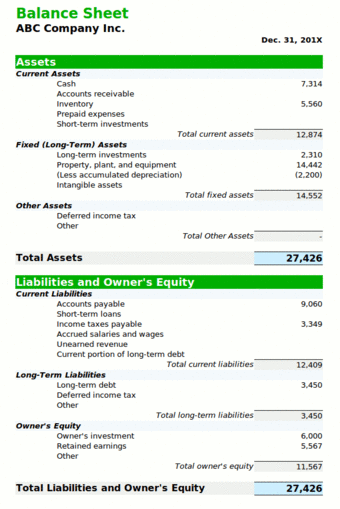
Balance Sheet Example
Types
A balance sheet summarizes an organization or individual’s assets, equity, and liabilities at a specific point in time. We have two forms of balance sheet. They are the report form and the account form. Individuals and small businesses tend to have simple balance sheets. Larger businesses tend to have more complex balance sheets, and these are presented in the organization’s annual report. Large businesses also may prepare balance sheets for segments of their businesses. A balance sheet is often presented alongside one for a different point in time (typically the previous year) for comparison.
Personal Balance Sheet
A personal balance sheet lists current assets, such as cash in checking accounts and savings accounts; long-term assets, such as common stock and real estate; current liabilities, such as loan debt and mortgage debt due; or long-term liabilities, such as mortgage and other loan debt. Securities and real estate values are listed at market value rather than at historical cost or cost basis. Personal net worth is the difference between an individual’s total assets and total liabilities.
U.S. Small Business Balance Sheet
A small business balance sheet lists current assets, such as cash, accounts receivable and inventory; fixed assets, such as land, buildings, and equipment; intangible assets, such as patents; and liabilities, such as accounts payable, accrued expenses, and long-term debt. Contingent liabilities, such as warranties, are noted in the footnotes to the balance sheet. The small business’s equity is the difference between total assets and total liabilities.
Public Business Entities Balance Sheet
Structure
Guidelines for balance sheets of public business entities are given by the International Accounting Standards Board and numerous country-specific organizations/companies.
Balance sheet account names and usage depend on the organization’s country and the type of organization. Government organizations do not generally follow standards established for individuals or businesses.
If applicable to the business, summary values for the following items should be included in the balance sheet: Assets are all the things the business owns, including property, tools, cars, etc.
Assets:
1. Current assets
- Cash and cash equivalents
- Accounts receivable
- Inventories
- Prepaid expenses for future services that will be used within a year
2. Non-current assets (fixed assets)
- Property, plant, and equipment.
- Investment property, such as real estate held for investment purposes.
- Intangible assets.
- Financial assets (excluding investments accounted for using the equity method, accounts receivables, and cash and cash equivalents).
- Investments accounted for using the equity method
- Biological assets, which are living plants or animals. Bearer biological assets are plants or animals which bear agricultural produce for harvest, such as apple trees grown to produce apples and sheep raised to produce wool.
Liabilities:
- Accounts payable.
- Provisions for warranties or court decisions.
- Financial liabilities (excluding provisions and accounts payable), such as promissory notes and corporate bonds.
- Liabilities and assets for current tax.
- Deferred tax liabilities and deferred tax assets.
- Unearned revenue for services paid for by customers but not yet provided.
Equity:
- Issued capital and reserves attributable to equity holders of the parent company (controlling interest).
- Non-controlling interest in equity.
Regarding the items in equity section, the following disclosures are required:
- Numbers of shares authorized, issued and fully paid, and issued but not fully paid.
- Par value of shares.
- Reconciliation of shares outstanding at the beginning and the end of the period/
- Description of rights, preferences, and restrictions of shares.
- Treasury shares, including shares held by subsidiaries and associates.
- Shares reserved for issuance under options and contracts.
- A description of the nature and purpose of each reserve within owners’ equity
3.1.2: Income Statements
Income statement is a company’s financial statement that indicates how the revenue is transformed into the net income.
Learning Objective
Describe the different methods used for presenting data in a company’s income statement
Key Points
- Income statement displays the revenues recognized for a specific period, and the cost and expenses charged against these revenues, including write offs (e.g., depreciation and amortization of various assets) and taxes.
- The income statement can be prepared in one of two methods: The Single Step income statement and Multi-Step income statement.
- The income statement includes revenue, expenses, COGS, SG&A, depreciation, other revenues and expenses, finance costs, income tax expense, and net income.
Key Term
- intangible asset
-
Intangible assets are defined as identifiable non-monetary assets that cannot be seen, touched, or physically measured, and are created through time and effort, and are identifiable as a separate asset.
Income Statement
Income statement (also referred to as profit and loss statement [P&L]), revenue statement, a statement of financial performance, an earnings statement, an operating statement, or statement of operations) is a company’s financial statement. This indicates how the revenue (money received from the sale of products and services before expenses are taken out, also known as the “top line”) is transformed into the net income (the result after all revenues and expenses have been accounted for, also known as “Net Profit” or the “bottom line”). It displays the revenues recognized for a specific period, and the cost and expenses charged against these revenues, including write offs (e.g., depreciation and amortization of various assets) and taxes. The purpose of the income statement is to show managers and investors whether the company made or lost money during the period being reported.
The important thing to remember about an income statement is that it represents a period of time. This contrasts with the balance sheet, which represents a single moment in time.
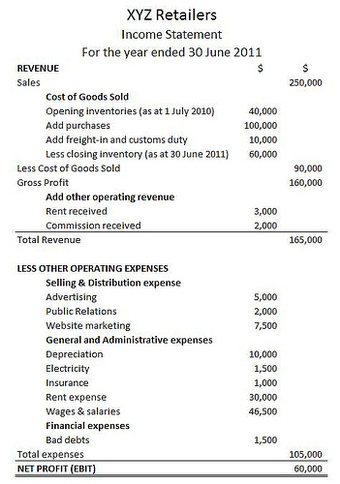
Income statement
GAAP and IRS accounting can differ.
Two Methods
- The Single Step income statement takes a simpler approach, totaling revenues and subtracting expenses to find the bottom line.
- The Multi-Step income statement (as the name implies) takes several steps to find the bottom line, starting with the gross profit. It then calculates operating expenses and, when deducted from the gross profit, yields income from operations. Adding to income from operations is the difference of other revenues and other expenses. When combined with income from operations, this yields income before taxes. The final step is to deduct taxes, which finally produces the net income for the period measured.
Operating Section
- Revenue – cash inflows or other enhancements of assets of an entity during a period from delivering or producing goods, rendering services, or other activities that constitute the entity’s ongoing major operations. It is usually presented as sales minus sales discounts, returns, and allowances. Every time a business sells a product or performs a service, it obtains revenue. This often is referred to as gross revenue or sales revenue.
- Expenses – cash outflows or other using-up of assets or incurrence of liabilities during a period from delivering or producing goods, rendering services, or carrying out other activities that constitute the entity’s ongoing major operations.
- Cost of Goods Sold (COGS)/Cost of Sales – represents the direct costs attributable to goods produced and sold by a business (manufacturing or merchandizing). It includes material costs, direct labor, and overhead costs (as in absorption costing), and excludes operating costs (period costs), such as selling, administrative, advertising or R&D, etc.
- Selling, General and Administrative expenses (SG&A or SGA) – consist of the combined payroll costs. SGA is usually understood as a major portion of non-production related costs, in contrast to production costs such as direct labour.
- Selling expenses – represent expenses needed to sell products (e.g., salaries of sales people, commissions, and travel expenses; advertising; freight; shipping; depreciation of sales store buildings and equipment, etc.).
- General and Administrative (G&A) expenses – represent expenses to manage the business (salaries of officers/executives, legal and professional fees, utilities, insurance, depreciation of office building and equipment, office rents, office supplies, etc.).
- Depreciation/Amortization – the charge with respect to fixed assets/intangible assets that have been capitalized on the balance sheet for a specific (accounting) period. It is a systematic and rational allocation of cost rather than the recognition of market value decrement.
- Research & Development (R&D) expenses – represent expenses included in research and development.
- Expenses recognized in the income statement should be analyzed either by nature (raw materials, transport costs, staffing costs, depreciation, employee benefit, etc.) or by function (cost of sales, selling, administrative, etc.).
Non-operating Section
- Other revenues or gains – revenues and gains from other than primary business activities (e.g., rent, income from patents).
- Other expenses or losses – expenses or losses not related to primary business operations, (e.g., foreign exchange loss).
- Finance costs – costs of borrowing from various creditors (e.g., interest expenses, bank charges).
- Income tax expense – sum of the amount of tax payable to tax authorities in the current reporting period (current tax liabilities/tax payable) and the amount of deferred tax liabilities (or assets).
- Irregular items – are reported separately because this way users can better predict future cash flows – irregular items most likely will not recur. These are reported net of taxes.
Bottom Line
Bottom line is the net income that is calculated after subtracting the expenses from revenue. Since this forms the last line of the income statement, it is informally called “bottom line. ” It is important to investors as it represents the profit for the year attributable to the shareholders.
3.2: Overview of Ratio Analysis
3.2.1: Classification
Ratio analysis consists of calculating financial performance using five basic types of ratios: profitability, liquidity, activity, debt, and market.
Learning Objective
Classify a financial ratio based on what it measures in a company
Key Points
- Ratio analysis consists of the calculation of ratios from financial statements and is a foundation of financial analysis.
- A financial ratio, or accounting ratio, shows the relative magnitude of selected numerical values taken from those financial statements.
- The numbers contained in financial statements need to be put into context so that investors can better understand different aspects of the company’s operations. Ratio analysis is one method an investor can use to gain that understanding.
Key Terms
- liquidity
-
Availability of cash over short term: ability to service short-term debt.
- ratio
-
A number representing a comparison between two things.
- ratio analysis
-
the use of quantitative techniques on values taken from an enterprise’s financial statements
- shareholder
-
One who owns shares of stock.
Classification
Financial statements are generally insufficient to provide information to investors on their own; the numbers contained in those documents need to be put into context so that investors can better understand different aspects of the company’s operations. Ratio analysis is one of three methods an investor can use to gain that understanding.

Business analysis and profitability
Financial ratio analysis allows an observer to put the data provided by a company in context. This allows the observer to gauge the strength of different aspects of the company’s operations.
Financial statement analysis is the process of understanding the risk and profitability of a firm through analysis of reported financial information. Ratio analysis is a foundation for evaluating and pricing credit risk and for doing fundamental company valuation. A financial ratio, or accounting ratio, is derived from a company’s financial statements and is a calculation showing the relative magnitude of selected numerical values taken from those financial statements.
There are various types of financial ratios, grouped by their relevance to different aspects of a company’s business as well as to their interest to different audiences. Financial ratios may be used internally by managers within a firm, by current and potential shareholders and creditors of a firm, and other audiences interested in understanding the strengths and weaknesses of a company, especially compared to the company over time or compared to other companies.
Types of Ratios
Most analysts think of financial ratios as consisting of five basic types:
- Profitability ratios measure the firm’s use of its assets and control of its expenses to generate an acceptable rate of return.
- Liquidity ratios measure the availability of cash to pay debt.
- Activity ratios, also called efficiency ratios, measure the effectiveness of a firm’s use of resources, or assets.
- Debt, or leverage, ratios measure the firm’s ability to repay long-term debt.
- Market ratios are concerned with shareholder audiences. They measure the cost of issuing stock and the relationship between return and the value of an investment in company’s shares.
3.3: Profitability Ratios
3.3.1: Operating Margin
The operating margin is a ratio that determines how much money a company is actually making in profit and equals operating income divided by revenue.
Learning Objective
Calculate a company’s operating margin
Key Points
- The operating margin equals operating income divided by revenue.
- The operating margin shows how much profit a company makes for each dollar in revenue. Since revenues and expenses are considered ‘operating’ in most companies, this is a good way to measure a company’s profitability.
- Although It is a good starting point for analyzing many companies, there are items like interest and taxes that are not included in operating income. Therefore, the operating margin is an imperfect measurement a company’s profitability.
Key Term
- operating income
-
Revenue – operating expenses. (Does not include other expenses such as taxes and depreciation).
Operating Margin
The financial job of a company is to earn a profit, which is different than earning revenue. If a company doesn’t earn a profit, their revenues aren’t helping the company grow. It is not only important to see how much a company has sold, it is important to see how much a company is making.
The operating margin (also called the operating profit margin or return on sales) is a ratio that shines a light on how much money a company is actually making in profit. It is found by dividing operating income by revenue, where operating income is revenue minus operating expenses .

Operating margin formula
The operating margin is found by dividing net operating income by total revenue.
The higher the ratio is, the more profitable the company is from its operations. For example, an operating margin of 0.5 means that for every dollar the company takes in revenue, it earns $0.50 in profit. A company that is not making any money will have an operating margin of 0: it is selling its products or services, but isn’t earning any profit from those sales.
However, the operating margin is not a perfect measurement. It does not include things like capital investment, which is necessary for the future profitability of the company. Furthermore, the operating margin is simply revenue. That means that it does not include things like interest and income tax expenses. Since non-operating incomes and expenses can significantly affect the financial well-being of a company, the operating margin is not the only measurement that investors scrutinize. The operating margin is a useful tool for determining how profitable the operations of a company are, but not necessarily how profitable the company is as a whole.
3.3.2: Profit Margin
Profit margin measures the amount of profit a company earns from its sales and is calculated by dividing profit (gross or net) by sales.
Learning Objective
Calculate a company’s net and gross profit margin
Key Points
- Profit margin is the profit divided by revenue.
- There are two types of profit margin: gross profit margin and net profit margin.
- A higher profit margin is better for the company, but there may be strategic decisions made to lower the profit margin or to even have it be negative.
Key Terms
- gross profit
-
The difference between net sales and the cost of goods sold.
- net profit
-
The gross revenue minus all expenses.
Profit Margin
Profit margin is one of the most used profitability ratios. Profit margin refers to the amount of profit that a company earns through sales.
The profit margin ratio is broadly the ratio of profit to total sales times 100%. The higher the profit margin, the more profit a company earns on each sale.
Since there are two types of profit (gross and net), there are two types of profit margin calculations. Recall that gross profit is simply the revenue minus the cost of goods sold (COGS). Net profit is the gross profit minus all other expenses. The gross profit margin calculation uses gross profit and the net profit margin calculation uses net profit . The difference between the two is that the gross profit margin shows the relationship between revenue and COGS, while the net profit margin shows the percentage of the money spent by customers that is turned into profit.

Net Profit Margin
The percentage of net profit (gross profit minus all other expenses) earned on a company’s sales.

Gross Profit Margin
The percentage of gross profit earned on the company’s sales.
Companies need to have a positive profit margin in order to earn income, although having a negative profit margin may be advantageous in some instances (e.g. intentionally selling a new product below cost in order to gain market share).
The profit margin is mostly used for internal comparison. It is difficult to accurately compare the net profit ratio for different entities. Individual businesses’ operating and financing arrangements vary so much that different entities are bound to have different levels of expenditure. Comparing one business’ arrangements with another has little meaning. A low profit margin indicates a low margin of safety. There is a higher risk that a decline in sales will erase profits and result in a net loss or a negative margin.
3.3.3: Return on Total Assets
The return on assets ratio (ROA) measures how effectively assets are being used for generating profit.
Learning Objective
Calculate a company’s return on assets
Key Points
- ROA is net income divided by total assets.
- The ROA is the product of two common ratios: profit margin and asset turnover.
- A higher ROA is better, but there is no metric for a good or bad ROA. An ROA depends on the company, the industry and the economic environment.
- ROA is based on the book value of assets, which can be starkly different from the market value of assets.
Key Terms
- net income
-
Gross profit minus operating expenses and taxes.
- asset
-
Something or someone of any value; any portion of one’s property or effects so considered.
Return
on Assets
The return on assets ratio (ROA) is found by dividing net income by total assets. The higher the ratio, the better the company is at using their assets to generate income. ROA was developed by DuPont to show how effectively assets are being used. It is also a measure of how much the company relies on assets to generate profit.

Return on Assets
The return on assets ratio is net income divided by total assets. That can then be broken down into the product of profit margins and asset turnover.
Components of ROA
ROA can be broken down into multiple parts. The ROA is the product of two other common ratios – profit margin and asset turnover. When profit margin and asset turnover are multiplied together, the denominator of profit margin and the numerator of asset turnover cancel each other out, returning us to the original ratio of net income to total assets.
Profit margin is net income divided by sales, measuring the percent of each dollar in sales that is profit for the company. Asset turnover is sales divided by total assets. This ratio measures how much each dollar in asset generates in sales. A higher ratio means that each dollar in assets produces more for the company.
Limits of ROA
ROA does have some drawbacks. First, it gives no indication of how the assets were financed. A company could have a high ROA, but still be in financial straits because all the assets were paid for through leveraging. Second, the total assets are based on the carrying value of the assets, not the market value. If there is a large discrepancy between the carrying and market value of the assets, the ratio could provide misleading numbers. Finally, there is no metric to find a good or bad ROA. Companies that operate in capital intensive industries will tend to have lower ROAs than those who do not. The ROA is entirely contextual to the company, the industry and the economic environment.
3.3.4: Basic Earning Power (BEP) Ratio
The Basic Earning Power ratio (BEP) is Earnings Before Interest and Taxes (EBIT) divided by Total Assets.
Learning Objective
Calculate a company’s Basic Earning Power ratio
Key Points
- The higher the BEP ratio, the more effective a company is at generating income from its assets.
- Using EBIT instead of operating income means that the ratio considers all income earned by the company, not just income from operating activity. This gives a more complete picture of how the company makes money.
- BEP is useful for comparing firms with different tax situations and different degrees of financial leverage.
Key Terms
- EBIT
-
Earnings before interest and taxes. A measure of a business’s profitability.
- Return on Assets
-
A measure of a company’s profitability. Calculated by dividing the net income for an accounting period by the average of the total assets the business held during that same period.
BEP Ratio
Another profitability ratio is the Basic Earning Power ratio (BEP). The purpose of BEP is to determine how effectively a firm uses its assets to generate income.
The BEP ratio is simply EBIT divided by total assets . The higher the BEP ratio, the more effective a company is at generating income from its assets.

Basic Earnings Power Ratio
BEP is calculated as the ratio of Earnings Before Interest and Taxes to Total Assets.
This may seem remarkably similar to the return on assets ratio (ROA), which is operating income divided by total assets. EBIT, or earnings before interest and taxes, is a measure of how much money a company makes, but is not necessarily the same as operating income:
EBIT = Revenue – Operating expenses+
Non-operating
income
Operating income = Revenue – Operating expenses
The distinction between EBIT and Operating Income is non-operating income. Since EBIT includes non-operating income (such as dividends paid on the stock a company holds of another), it is a more inclusive way to measure the actual income of a company. However, in most cases, EBIT is relatively close to Operating Income.
The advantage of using EBIT, and thus BEP, is that it allows for more accurate comparisons of companies. BEP disregards different tax situations and degrees of financial leverage while still providing an idea of how good a company is at using its assets to generate income.
BEP, like all profitability ratios, does not provide a complete picture of which company is better or more attractive to investors. Investors should favor a company with a higher BEP over a company with a lower BEP because that means it extracts more value from its assets, but they still need to consider how things like leverage and tax rates affect the company.
3.3.5: Return on Common Equity
Return on equity (ROE) measures how effective a company is at using its equity to generate income and is calculated by dividing net profit by total equity.
Learning Objective
Calculate the Return on Equity (ROE) for a business
Key Points
- ROE is net income divided by total shareholders’ equity.
- ROE is also the product of return on assets (ROA) and financial leverage.
- ROE shows how well a company uses investment funds to generate earnings growth. There is no standard for a good or bad ROE, but a higher ROE is better.
Key Term
- equity
-
Ownership, especially in terms of net monetary value, of a business.
Return on Equity
Return on equity (ROE) is a financial ratio that measures how good a company is at generating profit.
ROE is the ratio of net income to equity. From the fundamental equation of accounting, we know that equity equals net assets minus net liabilities. Equity is the amount of ownership interest in the company, and is commonly referred to as shareholders’ equity, shareholders’ funds, or shareholders’ capital.
In essence, ROE measures how efficient the company is at generating profits from the funds invested in it. A company with a high ROE does a good job of turning the capital invested in it into profit, and a company with a low ROE does a bad job. However, like many of the other ratios, there is no standard way to define a good ROE or a bad ROE. Higher ratios are better, but what counts as “good” varies by company, industry, and economic environment.
ROE can also be broken down into other components for easier use. ROE is the product of the net margin (profit margin), asset turnover, and financial leverage. Also note that the product of net margin and asset turnover is return on assets, so ROE is ROA times financial leverage.

Return on Equity
The return on equity is a ratio of net income to equity. It is a measure of how effective the equity is at generating income.
Breaking ROE into parts allows us to understand how and why it changes over time. For example, if the net margin increases, every sale brings in more money, resulting in a higher overall ROE. Similarly, if the asset turnover increases, the firm generates more sales for every unit of assets owned, again resulting in a higher overall ROE. Finally, increasing financial leverage means that the firm uses more debt financing relative to equity financing. Interest payments to creditors are tax deductible, but dividend payments to shareholders are not. Thus, a higher proportion of debt in the firm’s capital structure leads to higher ROE. Financial leverage benefits diminish as the risk of defaulting on interest payments increases. So if the firm takes on too much debt, the cost of debt rises as creditors demand a higher risk premium, and ROE decreases. Increased debt will make a positive contribution to a firm’s ROE only if the matching return on assets (ROA) of that debt exceeds the interest rate on the debt.
3.4: Asset Management Ratios
3.4.1: Inventory Turnover Ratio
Inventory turnover is a measure of the number of times inventory is sold or used in a time period, such as a year.
Learning Objective
Calculate inventory turnover and average days to sell inventory for a business
Key Points
- Inventory turnover = Cost of goods sold/Average inventory.
- Average days to sell the inventory = 365 days /Inventory turnover ratio.
- A low turnover rate may point to overstocking, obsolescence, or deficiencies in the product line or marketing effort.
- Conversely, a high turnover rate may indicate inadequate inventory levels, which may lead to a loss in business as the inventory is too low.
Key Term
- holding cost
-
In business management, holding cost is money spent to keep and maintain a stock of goods in storage.
Inventory Turnover
In accounting, the Inventory turnover is a measure of the number of times inventory is sold or used in a time period, such as a year. The equation for inventory turnover equals the cost of goods sold divided by the average inventory. Inventory turnover is also known as inventory turns, stockturn, stock turns, turns, and stock turnover.
Inventory Turnover Equation
- The formula for inventory turnover:
Inventory turnover = Cost of goods sold/Average inventory
- The formula for average inventory:
Average inventory = (Beginning inventory + Ending inventory)/2
- The average days to sell the inventory is calculated as follows:
Average days to sell the inventory = 365 days / Inventory turnover ratio
Application in Business
A low turnover rate may point to overstocking, obsolescence, or deficiencies in the product line or marketing effort. However, in some instances a low rate may be appropriate, such as where higher inventory levels occur in anticipation of rapidly rising prices or expected market shortages.

Inventory
A low turnover rate may point to overstocking, obsolescence, or deficiencies in the product line or marketing effort.
Conversely, a high turnover rate may indicate inadequate inventory levels, which may lead to a loss in business as the inventory is too low. This often can result in stock shortages.
Some compilers of industry data (e.g., Dun & Bradstreet) use sales as the numerator instead of cost of sales. Cost of sales yields a more realistic turnover ratio, but it is often necessary to use sales for purposes of comparative analysis. Cost of sales is considered to be more realistic because of the difference in which sales and the cost of sales are recorded. Sales are generally recorded at market value (i.e., the value at which the marketplace paid for the good or service provided by the firm). In the event that the firm had an exceptional year and the market paid a premium for the firm’s goods and services, then the numerator may be an inaccurate measure. However, cost of sales is recorded by the firm at what the firm actually paid for the materials available for sale. Additionally, firms may reduce prices to generate sales in an effort to cycle inventory. In this article, the terms “cost of sales” and “cost of goods sold” are synonymous.
An item whose inventory is sold (turns over) once a year has a higher holding cost than one that turns over twice, or three times, or more in that time. Stock turnover also indicates the briskness of the business. The purpose of increasing inventory turns is to reduce inventory for three reasons.
- Increasing inventory turns reduces holding cost. The organization spends less money on rent, utilities, insurance, theft, and other costs of maintaining a stock of good to be sold.
- Reducing holding cost increases net income and profitability as long as the revenue from selling the item remains constant.
- Items that turn over more quickly increase responsiveness to changes in customer requirements while allowing the replacement of obsolete items. This is a major concern in fashion industries.
When making comparison between firms, it’s important to take note of the industry, or the comparison will be distorted. Making comparison between a supermarket and a car dealer, will not be appropriate, as a supermarket sells fast moving goods, such as sweets, chocolates, soft drinks, so the stock turnover will be higher. However, a car dealer will have a low turnover due to the item being a slow moving item. As such, only intra-industry comparison will be appropriate.
3.4.2: Days Sales Outstanding
Days sales outstanding (also called DSO or days receivables) is a calculation used by a company to estimate their average collection period.
Learning Objective
Calculate the days sales outstanding ratio for a business
Key Points
- Days sales outstanding is a financial ratio that illustrates how well a company’s accounts receivables are being managed.
- DSO ratio = accounts receivable / average sales per day, or DSO ratio = accounts receivable / (annual sales / 365 days).
- Generally speaking, higher DSO ratio can indicate a customer base with credit problems and/or a company that is deficient in its collections activity. A low ratio may indicate the firm’s credit policy is too rigorous, which may be hampering sales.
Key Terms
- days in inventory
-
the average value of inventory divided by the average cost of goods sold per day
- average collection period
-
365 divided by the receivables turnover ratio
- outstanding check
-
a check that has been written but has not yet been deposited in the receiver’s bank account
- business cycle
-
The term business cycle (or economic cycle) refers to economy-wide fluctuations in production or economic activity over several months or years.
Days Sales Outstanding
In accountancy, days sales outstanding (also called DSO or days receivables) is a calculation used by a company to estimate their average collection period. It is a financial ratio that illustrates how well a company’s accounts receivables are being managed. The days sales outstanding figure is an index of the relationship between outstanding receivables and credit account sales achieved over a given period.
Typically, days sales outstanding is calculated monthly. The days sales outstanding analysis provides general information about the number of days on average that customers take to pay invoices. Generally speaking, though, higher DSO ratio can indicate a customer base with credit problems and/or a company that is deficient in its collections activity. A low ratio may indicate the firm’s credit policy is too rigorous, which may be hampering sales.
Days sales outstanding is considered an important tool in measuring liquidity. Days sales outstanding tends to increase as a company becomes less risk averse. Higher days sales outstanding can also be an indication of inadequate analysis of applicants for open account credit terms. An increase in DSO can result in cash flow problems, and may result in a decision to increase the creditor company’s bad debt reserve.
A DSO ratio can be expressed as:
- DSO ratio = accounts receivable / average sales per day, or
- DSO ratio = accounts receivable / (annual sales / 365 days)
For purposes of this ratio, a year is considered to have 365 days.
Days sales outstanding can vary from month to month and over the course of a year with a company’s seasonal business cycle. Of interest, when analyzing the performance of a company, is the trend in DSO. If DSO is getting longer, customers are taking longer to pay their bills, which may be a warning that customers are dissatisfied with the company’s product or service, or that sales are being made to customers that are less credit worthy or that sales people have to offer longer payment terms in order to generate sales. Many financial reports will state Receivables Turnover defined as Net Credit Account Sales / Trade Receivables; divide this value into the time period in days to get DSO.
However, days sales outstanding is not the most accurate indication of the efficiency of accounts receivable department. Changes in sales volume influence the outcome of the days sales outstanding calculation. For example, even if the overdue balance stays the same, an increase of sales can result in a lower DSO. A better way to measure the performance of credit and collection function is by looking at the total overdue balance in proportion of the total accounts receivable balance (total AR = Current + Overdue), which is sometimes calculated using the days’ delinquent sales outstanding (DDSO) formula.
3.4.3: Fixed Assets Turnover Ratio
Fixed-asset turnover is the ratio of sales to value of fixed assets, indicating how well the business uses fixed assets to generate sales.
Learning Objective
Calculate the fixed-asset turnover ratio for a business
Key Points
- Fixed asset turnover = Net sales / Average net fixed assets.
- The higher the ratio, the better, because a high ratio indicates the business has less money tied up in fixed assets for each unit of currency of sales revenue. A declining ratio may indicate that the business is over-invested in plant, equipment, or other fixed assets.
- Fixed assets, also known as a non-current asset or as property, plant, and equipment (PP&E), is a term used in accounting for assets and property that cannot easily be converted into cash.
Key Term
- IAS
-
International Financial Reporting Standards (IFRS) are designed as a common global language for business affairs so that company accounts are understandable and comparable across international boundaries.
Fixed Assets
Fixed assets, also known as a non-current asset or as property, plant, and equipment (PP&E), is a term used in accounting for assets and property that cannot easily be converted into cash. This can be compared with current assets, such as cash or bank accounts, which are described as liquid assets. In most cases, only tangible assets are referred to as fixed.
Moreover, a fixed/non-current asset also can be defined as an asset not directly sold to a firm’s consumers/end-users. As an example, a baking firm’s current assets would be its inventory (in this case, flour, yeast, etc.), the value of sales owed to the firm via credit (i.e., debtors or accounts receivable), cash held in the bank, etc. Its non-current assets would be the oven used to bake bread, motor vehicles used to transport deliveries, cash registers used to handle cash payments, etc. Each aforementioned non-current asset is not sold directly to consumers.
These are items of value that the organization has bought and will use for an extended period of time; fixed assets normally include items, such as land and buildings, motor vehicles, furniture, office equipment, computers, fixtures and fittings, and plant and machinery. These often receive favorable tax treatment (depreciation allowance) over short-term assets. According to International Accounting Standard (IAS) 16, Fixed Assets are assets which have future economic benefit that is probable to flow into the entity and which have a cost that can be measured reliably.
The primary objective of a business entity is to make a profit and increase the wealth of its owners. In the attainment of this objective, it is required that the management will exercise due care and diligence in applying the basic accounting concept of “Matching Concept.” Matching concept is simply matching the expenses of a period against the revenues of the same period.
The use of assets in the generation of revenue is usually more than a year–that is long term. It is, therefore, obligatory that in order to accurately determine the net income or profit for a period depreciation, it is charged on the total value of asset that contributed to the revenue for the period in consideration and charge against the same revenue of the same period. This is essential in the prudent reporting of the net revenue for the entity in the period.
Fixed-asset Turnover
Fixed-asset turnover is the ratio of sales (on the profit and loss account) to the value of fixed assets (on the balance sheet). It indicates how well the business is using its fixed assets to generate sales.

Turn Tables
Turn tables should help you remember turnover. Fixed-asset turnover indicates how well the business is using its fixed assets to generate sales.
Fixed asset turnover = Net sales / Average net fixed assets
Generally speaking, the higher the ratio, the better, because a high ratio indicates the business has less money tied up in fixed assets for each unit of currency of sales revenue. A declining ratio may indicate that the business is over-invested in plant, equipment, or other fixed assets.
3.4.4: Total Assets Turnover Ratio
Total asset turnover is a financial ratio that measures the efficiency of a company’s use of its assets in generating sales revenue.
Learning Objective
Calculate the total assets turnover ratio for a business
Key Points
- Total assets turnover = Net sales revenue / Average total assets.
- Net sales are operating revenues earned by a company for selling its products or rendering its services.
- Anything tangible or intangible that is capable of being owned or controlled to produce value and that is held to have positive economic value is considered an asset.
- Companies with low profit margins tend to have high asset turnover, while those with high profit margins have low asset turnover.
Key Term
- profit margins
-
Profit margin, net margin, net profit margin or net profit ratio all refer to a measure of profitability. It is calculated by finding the net profit as a percentage of the revenue.
Example
- Examples of intangible assets are goodwill, copyrights, trademarks, patents, computer programs, and financial assets, including such items as accounts receivable, bonds and stocks.
Total assets turnover
This is a financial ratio that measures the efficiency of a company’s use of its assets in generating sales revenue or sales income to the company.

Assets
Asset turnover measures the efficiency of a company’s use of its assets in generating sales revenue or sales income to the company.
Companies with low profit margins tend to have high asset turnover, while those with high profit margins have low asset turnover. Companies in the retail industry tend to have a very high turnover ratio due mainly to cut-throat and competitive pricing.
Total assets turnover = Net sales revenue / Average total assets
- “Sales” is the value of “Net Sales” or “Sales” from the company’s income statement”.
- Average Total Assets” is the average of the values of “Total assets” from the company’s balance sheet in the beginning and the end of the fiscal period. It is calculated by adding up the assets at the beginning of the period and the assets at the end of the period, then dividing that number by two.
Net sales
- In bookkeeping, accounting, and finance, Net sales are operating revenues earned by a company for selling its products or rendering its services. Also referred to as revenue, they are reported directly on the income statement as Sales or Net sales.
- In financial ratios that use income statement sales values, “sales” refers to net sales, not gross sales. Sales are the unique transactions that occur in professional selling or during marketing initiatives.
Total assets
In financial accounting, assets are economic resources. Anything tangible or intangible that is capable of being owned or controlled to produce value, and that is held to have positive economic value, is considered an asset. Simply stated, assets represent value of ownership that can be converted into cash (although cash itself is also considered an asset).
The balance sheet of a firm records the monetary value of the assets owned by the firm. It is money and other valuables belonging to an individual or business.
Two major asset classes are tangible assets and intangible assets.
- Tangible assets contain various subclasses, including current assets and fixed assets. Current assets include inventory, while fixed assets include such items as buildings and equipment.
- Intangible assets are non-physical resources and rights that have a value to the firm because they give the firm some kind of advantage in the market place.
3.5: Liquidity Ratios
3.5.1: Current Ratio
Current ratio is a financial ratio that measures whether or not a firm has enough resources to pay its debts over the next 12 months.
Learning Objective
Use a company’s current ratio to evaluate its short-term financial strength
Key Points
- The liquidity ratio expresses a company’s ability to repay short-term creditors out of its total cash. The liquidity ratio is the result of dividing the total cash by short-term borrowings.
- The current ratio is a financial ratio that measures whether or not a firm has enough resources to pay its debts over the next 12 months.
- Current ratio = current assets / current liabilities.
- Acceptable current ratios vary from industry to industry and are generally between 1.5 and 3 for healthy businesses.
Key Terms
- working capital management
-
Decisions relating to working capital and short term financing are referred to as working capital management [19]. These involve managing the relationship between a firm’s short-term assets and its short-term liabilities.
- current ratio
-
current assets divided by current liabilities
Liquidity Ratio
Liquidity ratio expresses a company’s ability to repay short-term creditors out of its total cash. The liquidity ratio is the result of dividing the total cash by short-term borrowings. It shows the number of times short-term liabilities are covered by cash. If the value is greater than 1.00, it means it is fully covered .

Liquidity
High liquidity means a company has the ability to meet its short-term obligations.
Liquidity ratio may refer to:
- Reserve requirement – a bank regulation that sets the minimum reserves each bank must hold.
- Acid Test – a ratio used to determine the liquidity of a business entity.
The formula is the following:
LR = liquid assets / short-term liabilities
Current Ratio
The current ratio is a financial ratio that measures whether or not a firm has enough resources to pay its debts over the next 12 months. It compares a firm’s current assets to its current liabilities. It is expressed as follows:
Current ratio = current assets / current liabilities
- Current asset is an asset on the balance sheet that can either be converted to cash or used to pay current liabilities within 12 months. Typical current assets include cash, cash equivalents, short-term investments, accounts receivable, inventory, and the portion of prepaid liabilities that will be paid within a year.
- Current liabilities are often understood as all liabilities of the business that are to be settled in cash within the fiscal year or the operating cycle of a given firm, whichever period is longer.
The current ratio is an indication of a firm’s market liquidity and ability to meet creditor’s demands. Acceptable current ratios vary from industry to industry and are generally between 1.5 and 3 for healthy businesses. If a company’s current ratio is in this range, then it generally indicates good short-term financial strength. If current liabilities exceed current assets (the current ratio is below 1), then the company may have problems meeting its short-term obligations. If the current ratio is too high, then the company may not be efficiently using its current assets or its short-term financing facilities. This may also indicate problems in working capital management. In such a situation, firms should consider investing excess capital into middle and long term objectives.
Low values for the current or quick ratios (values less than 1) indicate that a firm may have difficulty meeting current obligations. However, low values do not indicate a critical problem. If an organization has good long-term prospects, it may be able to borrow against those prospects to meet current obligations. Some types of businesses usually operate with a current ratio less than one. For example, if inventory turns over much more rapidly than the accounts payable do, then the current ratio will be less than one. This can allow a firm to operate with a low current ratio.
If all other things were equal, a creditor, who is expecting to be paid in the next 12 months, would consider a high current ratio to be better than a low current ratio. A high current ratio means that the company is more likely to meet its liabilities which fall due in the next 12 months.
3.5.2: Quick Ratio (Acid-Test Ratio)
The Acid Test or Quick Ratio measures the ability of a company to use its assets to retire its current liabilities immediately.
Learning Objective
Calculate a company’s quick ratio
Key Points
- Quick Ratio = (Cash and cash equivalent + Marketable securities + Accounts receivable) / Current liabilities.
- Acid Test Ratio = (Current assets – Inventory) / Current liabilities.
- Ideally, the acid test ratio should be 1:1 or higher, however this varies widely by industry. In general, the higher the ratio, the greater the company’s liquidity.
Key Term
- Treasury bills
-
Treasury bills (or T-Bills) mature in one year or less. Like zero-coupon bonds, they do not pay interest prior to maturity; instead they are sold at a discount of the par value to create a positive yield to maturity.
Quick ratio
In finance, the Acid-test (also known as quick ratio or liquid ratio) measures the ability of a company to use its near cash or quick assets to extinguish or retire its current liabilities immediately. Quick assets include those current assets that presumably can be quickly converted to cash at close to their book values. A company with a Quick Ratio of less than 1 cannot pay back its current liabilities.
Quick Ratio = (Cash and cash equivalent + Marketable securities + Accounts receivable) / Current liabilities.
Cash and cash equivalents are the most liquid assets found within the asset portion of a company’s balance sheet. Cash equivalents are assets that are readily convertible into cash, such as money market holdings, short-term government bonds or Treasury bills, marketable securities, and commercial paper. Cash equivalents are distinguished from other investments through their short-term existence. They mature within 3 months, whereas short-term investments are 12 months or less and long-term investments are any investments that mature in excess of 12 months. Another important condition that cash equivalents need to satisfy, is the investment should have insignificant risk of change in value. Thus, common stock cannot be considered a cash equivalent, but preferred stock acquired shortly before its redemption date can be.

Cash
Cash is the most liquid asset in a business.
Acid test ratio
Acid test often refers to Cash ratio instead of Quick ratio: Acid Test Ratio = (Current assets – Inventory) / Current liabilities.
Note that Inventory is excluded from the sum of assets in the Quick Ratio, but included in the Current Ratio. Ratios are tests of viability for business entities but do not give a complete picture of the business’ health. A business with large Accounts Receivable that won’t be paid for a long period (say 120 days), and essential business expenses and Accounts Payable that are due immediately, the Quick Ratio may look healthy when the business could actually run out of cash. In contrast, if the business has negotiated fast payment or cash from customers, and long terms from suppliers, it may have a very low Quick Ratio and yet be very healthy.
The acid test ratio should be 1:1 or higher, however this varies widely by industry. The higher the ratio, the greater the company’s liquidity will be (better able to meet current obligations using liquid assets).
3.6: Debt Management Ratios
3.6.1: Total Debt to Total Assets
The debt ratio is expressed as Total debt / Total assets.
Learning Objective
Use a company’s debt ratio to evaluate its financial strength
Key Points
- The debt ratio measures the firm’s ability to repay long-term debt by indicating the percentage of a company’s assets that are provided via debt.
- Debt ratio = Total debt / Total assets.
- The higher the ratio, the greater risk will be associated with the firm’s operation.
Key Terms
- goodwill
-
Goodwill is an accounting concept meaning the value of an asset owned that is intangible but has a quantifiable “prudent value” in a business for example a reputation the firm enjoyed with its clients.
- debt to total assets ratio
-
after tax income divided by liabilities
Example
- For example, a company with 2 million in total assets and 500,000 in total liabilities would have a debt ratio of 25%.
Financial Ratios
Financial ratios quantify many aspects of a business and are an integral part of the financial statement analysis. Financial ratios are categorized according to the financial aspect of the business which the ratio measures.
Financial ratios allow for comparisons:
- Between companies
- Between industries
- Between different time periods for one company
- Between a single company and its industry average
Ratios generally are not useful unless they are benchmarked against something else, like past performance or another company. Thus, the ratios of firms in different industries, which face different risks, capital requirements, and competition, are usually hard to compare.
Debt ratios

Debt
Debt ratio is an index of a business operation.
Debt ratios measure the firm’s ability to repay long-term debt. It is a financial ratio that indicates the percentage of a company’s assets that are provided via debt. It is the ratio of total debt (the sum of current liabilities and long-term liabilities) and total assets (the sum of current assets, fixed assets, and other assets such as ‘goodwill’).
- Debt ratio = Total debt / Total assets
Or alternatively:
- Debt ratio = Total liability / Total assets
The higher the ratio, the greater risk will be associated with the firm’s operation. In addition, high debt to assets ratio may indicate low borrowing capacity of a firm, which in turn will lower the firm’s financial flexibility. Like all financial ratios, a company’s debt ratio should be compared with their industry average or other competing firms.
Total liabilities divided by total assets. The debt/asset ratio shows the proportion of a company’s assets which are financed through debt. If the ratio is less than 0.5, most of the company’s assets are financed through equity. If the ratio is greater than 0.5, most of the company’s assets are financed through debt. Companies with high debt/asset ratios are said to be “highly leveraged,” not highly liquid as stated above. A company with a high debt ratio (highly leveraged) could be in danger if creditors start to demand repayment of debt.
3.6.2: Times-Interest-Earned Ratio
Times Interest Earned ratio (EBIT or EBITDA divided by total interest payable) measures a company’s ability to honor its debt payments.
Learning Objective
Use a company’s index coverage ratio to evaluate its ability to meet its debt obligations
Key Points
- Times interest earned (TIE) or Interest Coverage ratio is a measure of a company’s ability to honor its debt payments. It may be calculated as either EBIT or EBITDA divided by the total interest payable.
- Interest Charges = Traditionally “charges” refers to interest expense found on the income statement.
- EBIT = Revenue – Operating expenses (OPEX) + Non-operating income.
- EBITDA = Earnings before interest, taxes, depreciation and amortization.
- Times Interest Earned or Interest Coverage is a great tool when measuring a company’s ability to meet its debt obligations.
Key Term
- Non-operating income
-
Non-operating income, in accounting and finance, is gains or losses from sources not related to the typical activities of the business or organization. Non-operating income can include gains or losses from investments, property or asset sales, currency exchange, and other atypical gains or losses.
Times interest earned (TIE), or interest coverage ratio, is a measure of a company’s ability to honor its debt payments. It may be calculated as either EBIT or EBITDA, divided by the total interest payable.
Times-Interest-Earned = EBIT or EBITDA / Interest charges
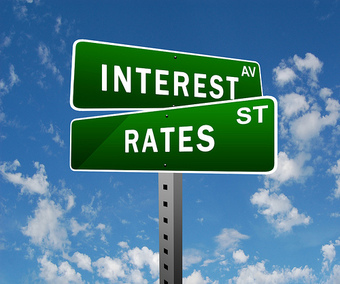
Interest
Interest rates of working capital financing can be largely affected by discount rate, WACC and cost of capital.
Times-Interest-Earned = EBIT or EBITDA / Interest charges
- Interest Charges = Traditionally “charges” refers to interest expense found on the income statement.
- EBIT = Earnings Before Interest and Taxes, also called operating profit or operating income. EBIT is a measure of a firm’s profit that excludes interest and income tax expenses. It is the difference between operating revenues and operating expenses. When a firm does not have non-operating income, then operating income is sometimes used as a synonym for EBIT and operating profit.
- EBIT = Revenue – Operating Expenses (OPEX) + Non-operating income.
- Operating income = Revenue – Operating expenses.
- EBITDA = Earnings Before Interest, Taxes, Depreciation and Amortization. The EBITDA of a company provides insight on the operational profitability of the business. It shows the profitability of a company regarding its present assets and operations with the products it produces and sells, taking into account possible provisions that need to be done.
If EBITDA is negative, then the business has serious issues. A positive EBITDA, however, does not automatically imply that the business generates cash. EBITDA ignores changes in Working Capital (usually needed when growing a business), capital expenditures (needed to replace assets that have broken down), taxes, and interest.
Times Interest Earned or Interest Coverage is a great tool when measuring a company’s ability to meet its debt obligations. When the interest coverage ratio is smaller than 1, the company is not generating enough cash from its operations EBIT to meet its interest obligations. The Company would then have to either use cash on hand to make up the difference or borrow funds. Typically, it is a warning sign when interest coverage falls below 2.5x.
3.7: Market Value Ratios
3.7.1: Price/Earnings Ratio
Price to earnings ratio (market price per share / annual earnings per share) is used as a guide to the relative values of companies.
Learning Objective
Calculate a company’s Price to Earnings Ratio
Key Points
- P/E ratio = Market price per share / Annual earnings per share.
- The P/E ratio is a widely used valuation multiple used as a guide to the relative values of companies; for example, a higher P/E ratio means that investors are paying more for each unit of current net income, so the stock is more expensive than one with a lower P/E ratio.
- Different types of P/E include: trailing P/E or P/E ttm, trailing P/E from continued operations, and forward P/E or P/Ef.
Key Terms
- time value of money
-
The value of money, figuring in a given amount of interest, earned over a given amount of time.
- inflation
-
An increase in the general level of prices or in the cost of living.
Example
- As an example, if stock A is trading at 24 and the earnings per share for the most recent 12 month period is three, then stock A has a P/E ratio of 24/3, or eight.
Price/Earnings Ratio
In stock trading, the price-to-earnings ratio of a share (also called its P/E, or simply “multiple”) is the market price of that share divided by the annual earnings per share (EPS).
The P/E ratio is a widely used valuation multiple used as a guide to the relative values of companies; a higher P/E ratio means that investors are paying more for each unit of current net income, so the stock is more “expensive” than one with a lower P/E ratio. The P/E ratio can be regarded as being expressed in years. The price is in currency per share, while earnings are in currency per share per year, so the P/E ratio shows the number of years of earnings that would be required to pay back the purchase price, ignoring inflation, earnings growth, and the time value of money.

Price-Earning Ratios as a Predictor of Twenty-Year Returns
The horizontal axis shows the real price-earnings ratio of the S&P Composite Stock Price Index as computed in Irrational Exuberance (inflation adjusted price divided by the prior ten-year mean of inflation-adjusted earnings). The vertical axis shows the geometric average real annual return on investing in the S&P Composite Stock Price Index, reinvesting dividends, and selling twenty years later. Note that over the last century, as the P/E ratio has decreased, annualized returns have increased.
P/E ratio = Market price per share / Annual earnings per share
The price per share in the numerator is the market price of a single share of the stock. The earnings per share in the denominator may vary depending on the type of P/E. The types of P/E include the following:
- Trailing P/E or P/E ttm: Here, earning per share is the net income of the company for the most recent 12 month period, divided by the weighted average number of common shares in issue during the period. This is the most common meaning of P/E if no other qualifier is specified. Monthly earnings data for individual companies are not available, and usually fluctuate seasonally, so the previous four quarterly earnings reports are used, and earnings per share are updated quarterly. Note, each company chooses its own financial year so the timing of updates will vary from one to another.
- Trailing P/E from continued operations: Instead of net income, this uses operating earnings, which exclude earnings from discontinued operations, extraordinary items (e.g. one-off windfalls and write-downs), and accounting changes. Longer-term P/E data, such as Shiller’s, use net earnings.
- Forward P/E, P/Ef, or estimated P/E: Instead of net income, this uses estimated net earnings over the next 12 months. Estimates are typically derived as the mean of those published by a select group of analysts (selection criteria are rarely cited). In times of rapid economic dislocation, such estimates become less relevant as the situation changes (e.g. new economic data is published, and/or the basis of forecasts becomes obsolete) more quickly than analysts adjust their forecasts.
By comparing price and earnings per share for a company, one can analyze the market’s stock valuation of a company and its shares relative to the income the company is actually generating. Stocks with higher (or more certain) forecast earnings growth will usually have a higher P/E, and those expected to have lower (or riskier) earnings growth will usually have a lower P/E. Investors can use the P/E ratio to compare the value of stocks; for example, if one stock has a P/E twice that of another stock, all things being equal (especially the earnings growth rate), it is a less attractive investment. Companies are rarely equal, however, and comparisons between industries, companies, and time periods may be misleading. P/E ratio in general is useful for comparing valuation of peer companies in a similar sector or group.
The P/E ratio of a company is a significant focus for management in many companies and industries. Managers have strong incentives to increase stock prices, firstly as part of their fiduciary responsibilities to their companies and shareholders, but also because their performance based remuneration is usually paid in the form of company stock or options on their company’s stock (a form of payment that is supposed to align the interests of management with the interests of other stock holders). The stock price can increase in one of two ways: either through improved earnings, or through an improved multiple that the market assigns to those earnings. In turn, the primary driver for multiples such as the P/E ratio is through higher and more sustained earnings growth rates.
Companies with high P/E ratios but volatile earnings may be tempted to find ways to smooth earnings and diversify risk; this is the theory behind building conglomerates. Conversely, companies with low P/E ratios may be tempted to acquire small high growth businesses in an effort to “rebrand” their portfolio of activities and burnish their image as growth stocks and thus obtain a higher P/E rating.
3.7.2: Market/Book Ratio
The price-to-book ratio is a financial ratio used to compare a company’s current market price to its book value.
Learning Objective
Calculate the different types of price to book ratios for a company
Key Points
- The calculation can be performed in two ways: 1) the company’s market capitalization can be divided by the company’s total book value from its balance sheet, 2) using per-share values, is to divide the company’s current share price by the book value per share.
- A higher P/B ratio implies that investors expect management to create more value from a given set of assets, all else equal.
- Technically, P/B can be calculated either including or excluding intangible assets and goodwill.
Key Term
- outstanding shares
-
Shares outstanding are all the shares of a corporation that have been authorized, issued and purchased by investors and are held by them.
Price/Book Ratio
The price-to-book ratio, or P/B ratio, is a financial ratio used to compare a company’s current market price to its book value. The calculation can be performed in two ways, but the result should be the same either way.
In the first way, the company’s market capitalization can be divided by the company’s total book value from its balance sheet.
- Market Capitalization / Total Book Value
The second way, using per-share values, is to divide the company’s current share price by the book value per share (i.e. its book value divided by the number of outstanding shares).
- Share price / Book value per share
As with most ratios, it varies a fair amount by industry. Industries that require more infrastructure capital (for each dollar of profit) will usually trade at P/B ratios much lower than, for example, consulting firms. P/B ratios are commonly used to compare banks, because most assets and liabilities of banks are constantly valued at market values.
A higher P/B ratio implies that investors expect management to create more value from a given set of assets, all else equal (and/or that the market value of the firm’s assets is significantly higher than their accounting value). P/B ratios do not, however, directly provide any information on the ability of the firm to generate profits or cash for shareholders.
This ratio also gives some idea of whether an investor is paying too much for what would be left if the company went bankrupt immediately. For companies in distress, the book value is usually calculated without the intangible assets that would have no resale value. In such cases, P/B should also be calculated on a “diluted” basis, because stock options may well vest on the sale of the company, change of control, or firing of management.
It is also known as the market-to-book ratio and the price-to-equity ratio (which should not be confused with the price-to-earnings ratio), and its inverse is called the book-to-market ratio.
Total Book Value vs Tangible Book Value
Technically, P/B can be calculated either including or excluding intangible assets and goodwill. When intangible assets and goodwill are excluded, the ratio is often specified to be “price to tangible book value” or “price to tangible book”.
3.8: The DuPont Equation, ROE, ROA, and Growth
3.8.1: The DuPont Equation
The DuPont equation is an expression which breaks return on equity down into three parts: profit margin, asset turnover, and leverage.
Learning Objective
Explain why splitting the return on equity calculation into its component parts may be helpful to an analyst
Key Points
- By splitting ROE into three parts, companies can more easily understand changes in their returns on equity over time.
- As profit margin increases, every sale will bring more money to a company’s bottom line, resulting in a higher overall return on equity.
- As asset turnover increases, a company will generate more sales per asset owned, resulting in a higher overall return on equity.
- Increased financial leverage will also lead to an increase in return on equity, since using more debt financing brings on higher interest payments, which are tax deductible.
Key Term
- competitive advantage
-
something that places a company or a person above the competition
Example
- A company has sales of 1,000,000. It has a net income of 400,000. Total assets have a value of 5,000,000, and shareholder equity has a value of 10,000,000. Using DuPont analysis, what is the company’s return on equity? Profit Margin = 400,000/1,000,000 = 40%. Asset Turnover = 1,000,000/5,000,000 = 20%. Financial Leverage = 5,000,000/10,000,000 = 50%. Multiplying these three results, we find that the Return on Equity = 4%.
The DuPont Equation
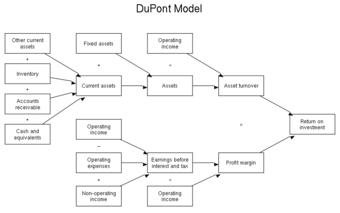
DuPont Model
A flow chart representation of the DuPont Model.
The DuPont equation is an expression which breaks return on equity down into three parts. The name comes from the DuPont Corporation, which created and implemented this formula into their business operations in the 1920s. This formula is known by many other names, including DuPont analysis, DuPont identity, the DuPont model, the DuPont method, or the strategic profit model.

The DuPont Equation
In the DuPont equation, ROE is equal to profit margin multiplied by asset turnover multiplied by financial leverage.
Under DuPont analysis, return on equity is equal to the profit margin multiplied by asset turnover multiplied by financial leverage. By splitting ROE (return on equity) into three parts, companies can more easily understand changes in their ROE over time.
Components of the DuPont Equation: Profit Margin
Profit margin is a measure of profitability. It is an indicator of a company’s pricing strategies and how well the company controls costs. Profit margin is calculated by finding the net profit as a percentage of the total revenue. As one feature of the DuPont equation, if the profit margin of a company increases, every sale will bring more money to a company’s bottom line, resulting in a higher overall return on equity.
Components of the DuPont Equation: Asset Turnover
Asset turnover is a financial ratio that measures how efficiently a company uses its assets to generate sales revenue or sales income for the company. Companies with low profit margins tend to have high asset turnover, while those with high profit margins tend to have low asset turnover. Similar to profit margin, if asset turnover increases, a company will generate more sales per asset owned, once again resulting in a higher overall return on equity.
Components of the DuPont Equation: Financial Leverage
Financial leverage refers to the amount of debt that a company utilizes to finance its operations, as compared with the amount of equity that the company utilizes. As was the case with asset turnover and profit margin, Increased financial leverage will also lead to an increase in return on equity. This is because the increased use of debt as financing will cause a company to have higher interest payments, which are tax deductible. Because dividend payments are not tax deductible, maintaining a high proportion of debt in a company’s capital structure leads to a higher return on equity.
The DuPont Equation in Relation to Industries
The DuPont equation is less useful for some industries, that do not use certain concepts or for which the concepts are less meaningful. On the other hand, some industries may rely on a single factor of the DuPont equation more than others. Thus, the equation allows analysts to determine which of the factors is dominant in relation to a company’s return on equity. For example, certain types of high turnover industries, such as retail stores, may have very low profit margins on sales and relatively low financial leverage. In industries such as these, the measure of asset turnover is much more important.
High margin industries, on the other hand, such as fashion, may derive a substantial portion of their competitive advantage from selling at a higher margin. For high end fashion and other luxury brands, increasing sales without sacrificing margin may be critical. Finally, some industries, such as those in the financial sector, chiefly rely on high leverage to generate an acceptable return on equity. While a high level of leverage could be seen as too risky from some perspectives, DuPont analysis enables third parties to compare that leverage with other financial elements that can determine a company’s return on equity.
3.8.2: ROE and Potential Limitations
Return on equity measures the rate of return on the ownership interest of a business and is irrelevant if earnings are not reinvested or distributed.
Learning Objective
Calculate a company’s return on equity
Key Points
- Return on equity is an indication of how well a company uses investment funds to generate earnings growth.
- Returns on equity between 15% and 20% are generally considered to be acceptable.
- Return on equity is equal to net income (after preferred stock dividends but before common stock dividends) divided by total shareholder equity (excluding preferred shares).
- Stock prices are most strongly determined by earnings per share (EPS) as opposed to return on equity.
Key Term
- fundamental analysis
-
An analysis of a business with the goal of financial projections in terms of income statement, financial statements and health, management and competitive advantages, and competitors and markets.
Example
- A small business’ net income after taxes is $10,000. The total shareholder equity in the business is $50,000. What is the return on equity? ROE = 10,000/50,000 ROE = 20%
Return On Equity
Return on equity (ROE) measures the rate of return on the ownership interest or shareholders’ equity of the common stock owners. It is a measure of a company’s efficiency at generating profits using the shareholders’ stake of equity in the business. In other words, return on equity is an indication of how well a company uses investment funds to generate earnings growth. It is also commonly used as a target for executive compensation, since ratios such as ROE tend to give management an incentive to perform better. Returns on equity between 15% and 20% are generally considered to be acceptable.
The Formula
Return on equity is equal to net income, after preferred stock dividends but before common stock dividends, divided by total shareholder equity and excluding preferred shares.

Return On Equity
ROE is equal to after-tax net income divided by total shareholder equity.
Expressed as a percentage, return on equity is best used to compare companies in the same industry. The decomposition of return on equity into its various factors presents various ratios useful to companies in fundamental analysis.

ROE Broken Down
This is an expression of return on equity decomposed into its various factors.
The practice of decomposing return on equity is sometimes referred to as the “DuPont System. “
Potential Limitations of ROE
Just because a high return on equity is calculated does not mean that a company will see immediate benefits. Stock prices are most strongly determined by earnings per share (EPS) as opposed to return on equity. Earnings per share is the amount of earnings per each outstanding share of a company’s stock. EPS is equal to profit divided by the weighted average of common shares.

Earnings Per Share
EPS is equal to profit divided by the weighted average of common shares.
The true benefit of a high return on equity comes from a company’s earnings being reinvested into the business or distributed as a dividend. In fact, return on equity is presumably irrelevant if earnings are not reinvested or distributed.
3.8.3: Assessing Internal Growth and Sustainability
Sustainable– as opposed to internal– growth gives a company a better idea of its growth rate while keeping in line with financial policy.
Learning Objective
Calculate a company’s internal growth and sustainability ratios
Key Points
- The internal growth rate is a formula for calculating the maximum growth rate a firm can achieve without resorting to external financing.
- Sustainable growth is defined as the annual percentage of increase in sales that is consistent with a defined financial policy.
- Another measure of growth, the optimal growth rate, assesses sustainable growth from a total shareholder return creation and profitability perspective, independent of a given financial strategy.
Key Terms
- sustainable growth rate
-
the optimal growth from a financial perspective assuming a given strategy with clear defined financial frame conditions/ limitations
- retention ratio
-
retained earnings divided by net income
- retention
-
The act of retaining; something retained
Example
- A company’s net income is 750,000 and its total shareholder equity is 5,000,000. Its earnings retention rate is 80%. What is its sustainable growth rate? Sustainable Growth Rate = (750,000/5,000,000) x (1-0.80). Sustainable Growth Rate = 3%
Internal Growth and Sustainability
The true benefit of a high return on equity arises when retained earnings are reinvested into the company’s operations. Such reinvestment should, in turn, lead to a high rate of growth for the company. The internal growth rate is a formula for calculating maximum growth rate that a firm can achieve without resorting to external financing. It’s essentially the growth that a firm can supply by reinvesting its earnings. This can be described as (retained earnings)/(total assets), or conceptually as the total amount of internal capital available compared to the current size of the organization.
We find the internal growth rate by dividing net income by the amount of total assets (or finding return on assets) and subtracting the rate of earnings retention. However, growth is not necessarily favorable. Expansion may strain managers’ capacity to monitor and handle the company’s operations. Therefore, a more commonly used measure is the sustainable growth rate.
Sustainable growth is defined as the annual percentage of increase in sales that is consistent with a defined financial policy, such as target debt to equity ratio, target dividend payout ratio, target profit margin, or target ratio of total assets to net sales.
We find the sustainable growth rate by dividing net income by shareholder equity (or finding return on equity) and subtracting the rate of earnings retention. While the internal growth rate assumes no financing, the sustainable growth rate assumes you will make some use of outside financing that will be consistent with whatever financial policy being followed. In fact, in order to achieve a higher growth rate, the company would have to invest more equity capital, increase its financial leverage, or increase the target profit margin.
Optimal Growth Rate
Another measure of growth, the optimal growth rate, assesses sustainable growth from a total shareholder return creation and profitability perspective, independent of a given financial strategy. The concept of optimal growth rate was originally studied by Martin Handschuh, Hannes Lösch, and Björn Heyden. Their study was based on assessments on the performance of more than 3,500 stock-listed companies with an initial revenue of greater than 250 million Euro globally, across industries, over a period of 12 years from 1997 to 2009.
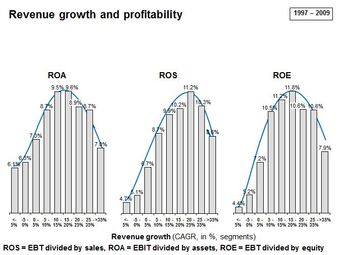
Revenue Growth and Profitability
ROA, ROS and ROE tend to rise with revenue growth to a certain extent.
Due to the span of time included in the study, the authors considered their findings to be, for the most part, independent of specific economic cycles. The study found that return on assets, return on sales and return on equity do in fact rise with increasing revenue growth of between 10% to 25%, and then fall with further increasing revenue growth rates. Furthermore, the authors attributed this profitability increase to the following facts:
- Companies with substantial profitability have the opportunity to invest more in additional growth, and
- Substantial growth may be a driver for additional profitability, whether by attracting high performing young professionals, providing motivation for current employees, attracting better business partners, or simply leading to more self-confidence.
However, according to the study, growth rates beyond the “profitability maximum” rate could bring about circumstances that reduce overall profitability because of the efforts necessary to handle additional growth (i.e., integrating new staff, controlling quality, etc).
3.8.4: Dividend Payments and Earnings Retention
The dividend payout and retention ratios offer insight into how much of a firm’s profit is distributed to shareholders versus retained.
Learning Objective
Calculate a company’s dividend payout and retention ratios
Key Points
- Many corporations retain a portion of their earnings and pay the remainder as a dividend.
- Dividends are usually paid in the form of cash, store credits, or shares in the company.
- Cash dividends are a form of investment income and are usually taxable to the recipient in the year that they are paid.
- Dividend payout ratio is the fraction of net income a firm pays to its stockholders in dividends.
- Retained earnings can be expressed in the retention ratio.
Key Term
- stock split
-
To issue a higher number of new shares to replace old shares. This effectively increases the number of shares outstanding without changing the market capitalization of the company.
Dividend Payments and Earnings Retention
Dividends are payments made by a corporation to its shareholder members. It is the portion of corporate profits paid out to stockholders. On the other hand, retained earnings refers to the portion of net income which is retained by the corporation rather than distributed to its owners as dividends. Similarly, if the corporation takes a loss, then that loss is retained and called variously retained losses, accumulated losses or accumulated deficit. Retained earnings and losses are cumulative from year to year with losses offsetting earnings. Many corporations retain a portion of their earnings and pay the remainder as a dividend.
A dividend is allocated as a fixed amount per share. Therefore, a shareholder receives a dividend in proportion to their shareholding. Retained earnings are shown in the shareholder equity section in the company’s balance sheet–the same as its issued share capital.
Public companies usually pay dividends on a fixed schedule, but may declare a dividend at any time, sometimes called a “special dividend” to distinguish it from the fixed schedule dividends. Dividends are usually paid in the form of cash, store credits (common among retail consumers’ cooperatives), or shares in the company (either newly created shares or existing shares bought in the market). Further, many public companies offer dividend reinvestment plans, which automatically use the cash dividend to purchase additional shares for the shareholder.
Cash dividends (most common) are those paid out in currency, usually via electronic funds transfer or a printed paper check. Such dividends are a form of investment income and are usually taxable to the recipient in the year they are paid. This is the most common method of sharing corporate profits with the shareholders of the company. For each share owned, a declared amount of money is distributed. Thus, if a person owns 100 shares and the cash dividend is $0.50 per share, the holder of the stock will be paid $50. Dividends paid are not classified as an expense but rather a deduction of retained earnings. Dividends paid do not show up on an income statement but do appear on the balance sheet.
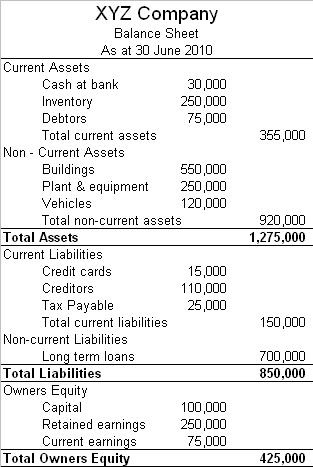
Example Balance Sheet
Retained earnings can be found on the balance sheet, under the owners’ (or shareholders’) equity section.
Stock dividends are those paid out in the form of additional stock shares of the issuing corporation or another corporation (such as its subsidiary corporation). They are usually issued in proportion to shares owned (for example, for every 100 shares of stock owned, a 5% stock dividend will yield five extra shares). If the payment involves the issue of new shares, it is similar to a stock split in that it increases the total number of shares while lowering the price of each share without changing the market capitalization, or total value, of the shares held.
Dividend Payout and Retention Ratios
Dividend payout ratio is the fraction of net income a firm pays to its stockholders in dividends:
The part of the earnings not paid to investors is left for investment to provide for future earnings growth. These retained earnings can be expressed in the retention ratio. Retention ratio can be found by subtracting the dividend payout ratio from one, or by dividing retained earnings by net income.

Dividend Payout Ratio
The dividend payout ratio is equal to dividend payments divided by net income for the same period.
3.8.5: Relationships between ROA, ROE, and Growth
Return on assets is a component of return on equity, both of which can be used to calculate a company’s rate of growth.
Learning Objective
Discuss the different uses of the Return on Assets and Return on Assets ratios
Key Points
- Return on equity measures the rate of return on the shareholders’ equity of common stockholders.
- Return on assets shows how profitable a company’s assets are in generating revenue.
- In other words, return on assets makes up two-thirds of the DuPont equation measuring return on equity.
- Capital intensity is the term for the amount of fixed or real capital present in relation to other factors of production. Rising capital intensity pushes up the productivity of labor.
Key Terms
- return on common stockholders’ equity
-
a fiscal year’s net income (after preferred stock dividends but before common stock dividends) divided by total equity (excluding preferred shares), expressed as a percentage
- quantitatively
-
With respect to quantity rather than quality.
Example
- A company has net income of 500,000. It has total assets valued at 3,000,000. Its retention rate is 80%, and its shareholder equity is equal to $1,500,000. What is the company’s ROA and internal growth rate? What is the company’s ROE and sustainable growth rate? ROA = 500,000/3,000,000 = 17% Internal growth rate = 17% x 80% = 13% ROE = 17% x (3,000,000/1,500,000) = 34% Sustainable growth rate = 34% x 80% = 27.2%
Return On Assets Versus Return On Equity
In review, return on equity measures the rate of return on the ownership interest (shareholders’ equity) of common stockholders. Therefore, it shows how well a company uses investment funds to generate earnings growth. Return on assets shows how profitable a company’s assets are in generating revenue. Return on assets is equal to net income divided by total assets.

Return On Assets
Return on assets is equal to net income divided by total assets.
This percentage shows what the company can do with what it has (i.e., how many dollars of earnings they derive from each dollar of assets they control). This is in contrast to return on equity, which measures a firm’s efficiency at generating profits from every unit of shareholders’ equity. Return on assets is, however, a vital component of return on equity, being an indicator of how profitable a company is before leverage is considered. In other words, return on assets makes up two-thirds of the DuPont equation measuring return on equity.
ROA, ROE, and Growth
In terms of growth rates, we use the value known as return on assets to determine a company’s internal growth rate. This is the maximum growth rate a firm can achieve without resorting to external financing. We use the value for return on equity, however, in determining a company’s sustainable growth rate, which is the maximum growth rate a firm can achieve without issuing new equity or changing its debt-to-equity ratio.
Capital Intensity and Growth
Return on assets gives us an indication of the capital intensity of the company. “Capital intensity” is the term for the amount of fixed or real capital present in relation to other factors of production, especially labor. The underlying concept here is how much output can be procured from a given input (assets!). The formula for capital intensity is below:
The use of tools and machinery makes labor more effective, so rising capital intensity pushes up the productivity of labor. While companies that require large initial investments will generally have lower return on assets, it is possible that increased productivity will provide a higher growth rate for the company. Capital intensity can be stated quantitatively as the ratio of the total money value of capital equipment to the total potential output. However, when we adjust capital intensity for real market situations, such as the discounting of future cash flows, we find that it is not independent of the distribution of income. In other words, changes in the retention or dividend payout ratios can lead to changes in measured capital intensity.
3.9: Using Financial Ratios for Analysis
3.9.1: Evaluating Financial Statements
With a few exceptions, the majority of the data used in ratio analysis comes from evaluation of the financial statements.
Learning Objective
Differentiate between recurring and non-recurring items in financial reports
Key Points
- Ratio analysis is a tool for evaluating financial statements but also relies on the numbers in the reported financial statements being put into order to be used for comparison. With a few exceptions, the majority of the data used in ratio analysis comes from the financial statements.
- Prior to the calculation of financial ratios, reported financial statements are often reformulated and adjusted by analysts to make the financial ratios more meaningful as comparisons across time or across companies.
- In terms of reformulation, earnings might be separated into recurring and non-recurring items. In terms of adjustment of financial statements, analysts may adjust earnings numbers up or down when they suspect the reported data is inaccurate due to issues like earnings management.
Key Terms
- valuation
-
The process of estimating the market value of a financial asset or liability.
- earnings management
-
A euphemism, such as creative accounting, to refer to fraudulent accounting practices that manipulate reporting of income, assets or liabilities with the intent to influence interpretations of the income statements.
Ratio analysis is a tool for evaluating financial statements but also relies on the numbers in the reported financial statements being put into order to be used as ratios for comparison over time or across companies. Financial statements are used as a way to discover the financial position and financial results of a business. With a few exceptions, such as ratios involving stock price, the majority of the data used in ratio analysis comes from the financial statements. Ratios put this financial statement information in context.

Putting Numbers in Order
Evaluating financial statements involves getting the numbers in order and then using these figures to perform ratio analysis.
Prior to the calculation of financial ratios, reported financial statements are often reformulated and adjusted by analysts to make the financial ratios more meaningful as comparisons across time or across companies. In terms of reformulation, one common reformulation is to divide reported items into recurring or normal items and non-recurring or special items. In this way, earnings could be separated into normal or core earnings and transitory earnings with the idea that normal earnings are more permanent and hence more relevant for prediction and valuation. In terms of adjustment of financial statements, analysts may adjust earnings numbers up or down when they suspect the reported data is inaccurate due to issues like earnings management.
The evaluation of a company’s financial statement analysis is a form of fundamental analysis that is bottoms up. While analysis of a company’s prospects can include a number of factors, including understanding the economic situation or the industry or sentiment about the company or its products, ratio analysis of a company relies on the specific company financials.
3.9.2: Industry Comparisons
While ratio analysis can be quite helpful in comparing companies within an industry, cross-industry comparisons should be done with caution.
Learning Objective
Describe how valuation methodologies are used to compare different companies in different sectors
Key Points
- One of the advantages of ratio analysis is that it allows comparison across companies. However, while ratios can be quite helpful in comparing companies within an industry and even across some similar industries, cross-industry comparisons may not be helpful and should be done with caution.
- An industry represents a classification of companies by economic activity, but “industry” can be too broad or narrow a definition for ratio analysis comparison. When comparing ratios, companies should be comparable in terms of having similar characteristics in the statistics being analyzed.
- Valuation using multiples only reveals patterns in relative values. For multiples to be useful, the statistic involved must bear a logical, meaningful relationship to the market value observed, which is something that can vary across industry.
Key Terms
- metric
-
A measure for something; a means of deriving a quantitative measurement or approximation for otherwise qualitative phenomena.
- valuation
-
The process of estimating the market value of a financial asset or liability.
One of the advantages of ratio analysis is that it allows comparison across companies, an activity which is often called benchmarking. However, while ratios can be quite helpful in comparing companies within an industry and even across some similar industries, comparing ratios of companies across different industries may not be helpful and should be done with caution .

Industry
Comparing ratios of companies within an industry can allow an analyst to make like to like (apples to apples) comparisons. Comparisons across industries may be like to unlike (apples to oranges) comparisons, and thus less useful.
An industry represents a classification of companies by economic activity. At a very broad level, industry is sometimes classified into three sectors: primary or extractive, secondary or manufacturing, and tertiary or services. At a very detailed level are classification systems like the ISIC (International Standard Industrial Classification).
However, in terms of ratio analysis and comparing companies, it is most helpful to consider whether the companies being compared are comparable in the financial metrics being evaluated in the ratios. Different businesses will have different ratios for different reasons. A peer group is a set of companies or assets which are selected as being sufficiently comparable to the company or assets being valued (usually by virtue of being in the same industry or by having similar characteristics in terms of earnings growth and return on investment). From the investor perspective, peers can include companies that are not only direct product competitors but are subject to similar cycles, suppliers, and other external factors.
Valuation using multiples involves estimating the value of an asset by comparing it to the values assessed by the market for similar or comparable assets in the peer group. A valuation multiple is simply an expression of market value of an asset relative to a key statistic that is assumed to relate to that value. To be useful, that statistic – whether earnings, cash flow, or some other measure – must bear a logical relationship to the market value observed; to be seen, in fact, as the driver of that market value. The price to earnings ratio, for example, is a common multiple but can differ across companies that have different capital structures; this could make it difficult to compare this particular ratio across industries.
Additionally, there could be problems with the valuation of an entire industry, making ratio analysis of a company relative to an industry less useful. The use of multiples only reveals patterns in relative values, not absolute values such as those obtained from discounted cash flow valuations. If the peer group as a whole is incorrectly valued (such as may happen during a stock market “bubble”), then the resulting multiples will also be misvalued.
3.9.3: Benchmarking
Comparing the financial ratios of a company to those of the top performer in its class is a type of benchmarking.
Learning Objective
Describe how benchmarking can be used to assess the strength of a company
Key Points
- Financial ratios allow for comparisons and, therefore, are intertwined with the process of benchmarking, comparing one’s business to that of relevant others or of the same company at a different point in time processes on a specific indicator or series of indicators.
- Benchmarking can be done in many ways and ratio analysis is only one of these. One benefit of ratio analysis as a component of benchmarking is that many financial ratios are well-established calculations derived from verified data.
- Benchmarking using ratio analysis can be useful to various audiences; for example, investors and managers interested in incorporate quantitative comparisons of a company to peers.
Key Terms
- benchmark
-
A standard by which something is evaluated or measured.
- ratio
-
A number representing a comparison between two things.
Benchmarking
Financial ratios allow for comparisons and, therefore, are intertwined with the process of benchmarking, comparing one’s business to that of others or of the same company at a different point in time. In many cases, benchmarking involves comparisons of one company to the best companies in a comparable peer group or the average in that peer group or industry. In the process of benchmarking, an analyst or manager identifies the best firms in their industry, or in another industry where similar processes exist, and compares the results and processes of those studied to one’s own results and processes on a specific indicator or series of indicators.
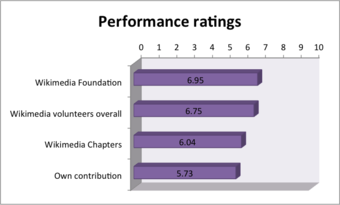
Benchmarking Measures Performance
Results are the paramount concern to a transactional leader.
Benchmarking can be done in many ways, and ratio analysis is only one of these. One benefit of ratio analysis as a component of benchmarking is that many financial ratios are well-established calculations derived from verified data. In benchmarking as a whole, benchmarking can be done on a variety of processes, meaning that definitions may change over time within the same organization due to changes in leadership and priorities. The most useful comparisons can be made when metrics definitions are common and consistent between compared units and over time.
Benchmarking using ratio analysis can be useful to various audiences. From an investor perspective, benchmarking can involve comparing a company to peer companies that can be considered alternative investment opportunities from the perspective of an investor. In this process, the investor may compare the focus company to others in the peer group (leaders, averages) on certain financial ratios relevant to those companies and the investor’s investment style. From a management perspective, benchmarking using ratio analysis may be a way for a manager to compare their company to peers using externally recognizable, quantitative data.
3.9.4: Trend Analysis
Trend analysis consists of using ratios to compare company performance on an indicator over time, often to forecast or inform future events.
Learning Objective
Analyze the benefits and challenges of using trend analysis to evaluate a company
Key Points
- Trend analysis is the practice of collecting information and attempting to spot a pattern or trend in the same metric historically, either by examining it in tables or charts. Often this trend analysis is used to predict or inform decisions around future events.
- Trend analysis can be performed in different ways in finance. Fundamental analysis relies on historical financial statement analysis, often in the form of ratio analysis.
- Trend analysis using financial ratios can be complicated by changes to companies and accounting over time. For example, a company may change its business model and begin to operate in a new industry or it may change the end of its financial year or the way it accounts for inventories.
Key Terms
- sentiment
-
A general thought, feeling, or sense.
- forecast
-
An estimation of a future condition.
In addition to using financial ratio analysis to compare one company with others in its peer group, ratio analysis is often used to compare the company’s performance on certain measures over time. Trend analysis is the practice of collecting information and attempting to spot a pattern, or trend, in the information. This often involves comparing the same metric historically, either by examining it in tables or charts. Often this trend analysis is used to forecast or inform decisions around future events, but it can be used to estimate uncertain events in the past .
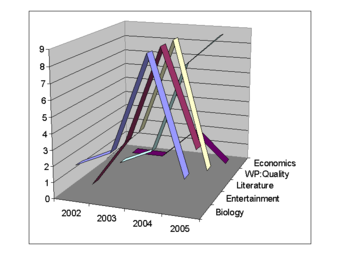
Trend Analysis
Determining the popularity and demand for specific subject over time through trend analysis.
Trend analysis can be performed in different ways in finance. For example, in technical analysis the direction of prices of a particular company’s public stock is calculated through the study of past market data, primarily price, and volume. Fundamental analysis, on the other hand, relies not on sentiment measures (like technical analysis) but on financial statement analysis, often in the form of ratio analysis. Creditors and company managers also use ratio analysis as a form of trend analysis. For example, they may examine trends in liquidity or profitability over time.
Trend analysis using financial ratios can be complicated by the fact that companies and accounting can change over time. For example, a company may change its business model so that it begins to operate in a new industry or it may change the end of its financial year or the way it accounts for inventories. When examining historical trends in ratios, analysts will often make adjustments to the ratios for these reasons, perhaps performing some ratio analysis in which they segment out business segments that are not consistent over time or they separate recurring from non-recurring items.
3.9.5: Limitations of Financial Statement Analysis
Financial statement analyses can yield a limited view of a company because of accounting, market, and management related limitations of such analyses.
Learning Objective
Describe the limitations associated with using ratio analysis
Key Points
- Ratio analysis is hampered by potential limitations with accounting and the data in the financial statements themselves. This can include errors as well as accounting mismanagement, which involves distorting the raw data used to derive financial ratios.
- Proponents of the stronger forms of the efficient-market hypothesis, technical analysts, and behavioral economists argue that fundamental analysis is limited as a stock valuation tool, all for their own distinct reasons.
- Ratio analysis can also omit important aspects of a firm’s success, such as key intangibles, like brand, relationships, skills and culture. These are primary drivers of success over the longer term even though they are absent from conventional financial statements.
- Other disadvantages of this type of analysis is that if used alone it can present an overly simplistic view of the company by distilling a great deal of information into a single number or series of numbers that may not provide adequate context or be comparable across time or industry.
Key Term
- valuation
-
The process of estimating the market value of a financial asset or liability.
Limitations of Financial Statement Analysis
Ratio analysis using financial statements includes accounting, stock market, and management related limitations. These limits leave analysts with remaining questions about the company.
First of all, ratio analysis is hampered by potential limitations with accounting and the data in the financial statements themselves. This can include errors as well as accounting mismanagement, which involves distorting the raw data used to derive financial ratios. While accounting measures may have more external standards and oversights than many other ways of benchmarking companies, this is still a limit.
Ratio analysis using financial statements as a tool for performing stock valuation can be limited as well. The efficient-market hypothesis (EMH), for example, asserts that financial markets are “informationally efficient. ” In consequence of this, one cannot consistently achieve returns in excess of average market returns on a risk-adjusted basis, given the information available at the time the investment is made. While the weak form of this hypothesis argues that there can be a long run benefit to information derived from fundamental analysis, stronger forms argue that fundamental analysis like ratio analysis will not allow for greater financial returns.
In another view on stock markets, technical analysts argue that sentiment is as much if not more of a driver of stock prices than is the fundamental data on a company like its financials. Behavioral economists attribute the imperfections in financial markets to a combination of cognitive biases such as overconfidence, overreaction, representative bias, information bias, and various other predictable human errors in reasoning and information processing. These audiences also see limits to ratio analysis as a predictor of stock market returns.
At the management and investor level, ratio analysis using financial statements can also leave out a number of important aspects of a firm’s success, such as key intangibles, like brand, relationships, skills, and culture. These are primary drivers of success over the longer term even though they are absent from conventional financial statements.
Other disadvantages of this type of analysis is that if used alone it can present an overly simplistic view of the company by distilling a great deal of information into a single number or series of numbers. Also, changes in the information underlying ratios can hamper comparisons across time and inconsistencies within and across the industry can also complicate comparisons.
3.10: Considering Inflation’s Distortionary Effects
3.10.1: Impact of Inflation on Financial Statement Analysis
General price level changes creates distortions in financial statements. Inflation accounting is used in countries with high inflation.
Learning Objective
Discuss how inflation can impact a company’s financial statements
Key Points
- Many of the historical numbers appearing on financial statements are not economically relevant because prices have changed since they were incurred.
- Since the numbers on financial statements represent dollars expended at different points of time and, in turn, embody different amounts of purchasing power, they are simply not additive.
- Reported profits may exceed the earnings that could be distributed to shareholders without impairing the company’s ongoing operations.
- Future earnings are not easily projected from historical earnings. Future capital needs are difficult to forecast and may lead to increased leverage, which increases the risk to the business.
- The asset values for inventory, equipment and plant do not reflect their economic value to the business.
Key Terms
- Financial Accounting Standards Board
-
private, not-for-profit organization whose primary purpose is to develop generally accepted accounting principles (GAAP) within the United States in the public’s interest
- hyperinflation
-
In economics, this occurs when a country experiences very high, accelerating, and perceptibly “unstoppable” rates of inflation. In such a condition, the general price level within an economy rapidly increases as the currency quickly loses real value.
- historical cost basis
-
Under this type of accounting, assets and liabilities are recorded at their values when first acquired. They are not then generally restated for changes in values. Costs recorded in the Income Statement are based on the historical cost of items sold or used, rather than their replacement costs.
Inflation’s Impact on Financial Statements
In most countries, primary financial statements are prepared on the historical cost basis of accounting without regard either to changes in the general level of prices. Accountants in the United Kingdom and the United States have discussed the effect of inflation on financial statements since the early 1900s .

Hyperinflation Graph
German Hyperinflation Data
General price level changes in financial reporting creates distortions in financial statements such as:
- Many of the historical numbers appearing on financial statements are not economically relevant because prices have changed since they were incurred.
- Since the numbers on financial statements represent dollars expended at different points of time and, in turn, embody different amounts of purchasing power, they are simply not additive. Hence, adding cash of $10,000 held on December 31, 2002, with $10,000 representing the cost of land acquired in 1955 (when the price level was significantly lower) is a dubious operation because of the significantly different amount of purchasing power represented by the two identical numbers.
- Reported profits may exceed the earnings that could be distributed to shareholders without impairing the company’s ongoing operations.
- The asset values for inventory, equipment and plant do not reflect their economic value to the business.
- Future earnings are not easily projected from historical earnings.
- The impact of price changes on monetary assets and liabilities is not clear.
- Future capital needs are difficult to forecast and may lead to increased leverage, which increases the risk to the business.
- When real economic performance is distorted, these distortions lead to social and political consequenses that damage businesses (examples: poor tax policies and public misconceptions regarding corporate behavior).
Inflation accounting, a range of accounting systems designed to correct problems arising from historical cost accounting in the presence of inflation, is a solution to these problems. This type of accounting is used in countries experiencing high inflation or hyperinflation. For example, in countries such as these the International Accounting Standards Board requires corporate financial statements to be adjusted for changes in purchasing power using a price index.
3.10.2: Disinflation
Disinflation is a decrease in the inflation rate; a slowdown in the rate of increase of the general price level of goods, services.
Learning Objective
Describe what causes disinflation
Key Points
- Disinflation occurs when the increase in the “consumer price level” slows down from the previous period when the prices were rising. Disinflation is the reduction in the general price level in the economy but for a very short period of time.
- The causes of disinflation may be a decrease in the growth rate of the money supply. If the central bank of a country enacts tighter monetary policy, the supply of money reduces, and money becomes more upscale and the demand for money remains constant.
- Disinflation may result from a recession. The central bank adopts contractionary monetary policy, goods, and services are more expensive. Even though the demand for commodities fall, the supply still remains unaltered.Thus, the prices would fall over a period of time leading to disinflation.
Key Terms
- recession
-
A period of reduced economic activity.
- business cycle
-
A long-term fluctuation in economic activity between growth and recession.
Disinflation is a decrease in the rate of inflation–a slowdown in the rate of increase of the general price level of goods and services in a nation’s gross domestic product over time. Disinflation occurs when the increase in the “consumer price level” slows down from the previous period when the prices were rising. Disinflation is the reduction in the general price level in the economy but for a very short period of time. Disinflation takes place only when an economy is suffering from recession.
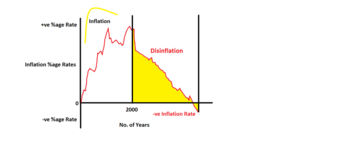
Disinflation
Disinflation is a decrease in the rate of inflation as illustrated in the yellow region of this graph.
If the inflation rate is not very high to start with, disinflation can lead to deflation–decreases in the general price level of goods and services. For example if the annual inflation rate for the month of January is 5% and it is 4% in the month of February, the prices disinflated by 1% but are still increasing at a 4% annual rate. Again, if the current rate is 1% and it is -2% for the following month, prices disinflated by 3% (i.e., 1%-[-2]%) and are decreasing at a 2% annual rate.
The causes of disinflation are either a decrease in the growth rate of the money supply, or a business cycle contraction (recession). If the central bank of a country enacts tighter monetary policy, (i.e., the government start selling its securities) this reduces the supply of money in an economy. This contraction of the monetary policy is known as a “quantitative tightening technique. ” When the government sell its securities in the market, the supply of money reduces, and money becomes more upscale and the demand for money remains constant. During a recession, competition among businesses for customers becomes more intense, and so retailers are no longer able to pass on higher prices to their customers. The main reason is that when the central bank adopts contractionary monetary policy, its becomes expensive to annex money, which leads to the fall in the demand for goods and services in the economy. Even though the demand for commodities fall, the supply of commodities still remains unaltered. Thus the prices fall over a period of time leading to disinflation.
When the growth rate of unemployment is below the natural rate of growth, this leads to an increase in the rate of inflation; whereas, when the growth rate of unemployment is above the natural rate of growth it leads to a decrease in the rate of inflation also known as disinflation. This happens when people are jobless, and they have a very small portion of money to spend, which indirectly implies reduction in the supply of money in an economy.
3.10.3: Deflation
Deflation is a decrease in the general price level of goods and services and occurs when the inflation rate falls below 0%.
Learning Objective
Explain how deflation can effect a business
Key Points
- In the IS/LM model (Investment and Saving equilibrium/ Liquidity Preference and Money Supply equilibrium model), deflation is caused by a shift in the supply-and-demand curve for goods and services, particularly a fall in the aggregate level of demand.
- In more recent economic thinking, deflation is related to risk: where the risk-adjusted return on assets drops to negative, investors and buyers will hoard currency rather than invest it. This can produce a liquidity trap.
- In monetarist theory, deflation must be associated with either a reduction in the money supply, a reduction in the velocity of money or an increase in the number of transactions. But any of these may occur separately without deflation.
- In mainstream economics, deflation may be caused by a combination of the supply and demand for goods and the supply and demand for money; specifically the supply of money going down and the supply of goods going up.
- The effects of deflation are: decreasing nominal prices for goods and services, increasing buying power of cash money and all assets denominated in cash terms, possibly decreasing investment and lending if cash holdings are seen as preferable, and benefiting recipients of fixed incomes.
Key Terms
- liquidity trap
-
A liquidity trap is a situation in which injections of cash into the private banking system by a central bank fail to lower interest rates and hence fail to stimulate economic growth. A liquidity trap is caused when people hoard cash because they expect an adverse event such as deflation, insufficient aggregate demand, or war.
- deflationary spiral
-
A deflationary spiral is a situation where decreases in price lead to lower production, which in turn leads to lower wages and demand, which leads to further decreases in price. Since reductions in general price level are called deflation, a deflationary spiral is when reductions in price lead to a vicious circle, where a problem exacerbates its own cause.
In economics, deflation is a decrease in the general price level of goods and services. This occurs when the inflation rate falls below 0% (a negative inflation rate). Inflation reduces the real value of money over time; conversely, deflation increases the real value of money – the currency of a national or regional economy. In turn, this allows one to buy more goods with the same amount of money over time.
Economists generally believe that deflation is a problem in a modern economy because they believe it may lead to a deflationary spiral .

US historical inflation rates
Annual inflation (in blue) and deflation (in green) rates in the United States from 1666 to 2004
In the IS/LM model (Investment and Saving equilibrium/ Liquidity Preference and Money Supply equilibrium model), deflation is caused by a shift in the supply-and-demand curve for goods and services, particularly with a fall in the aggregate level of demand. That is, there is a fall in how much the whole economy is willing to buy, and the going price for goods. Because the price of goods is falling, consumers have an incentive to delay purchases and consumption until prices fall further, which in turn reduces overall economic activity. Since this idles the productive capacity, investment also falls, leading to further reductions in aggregate demand. This is the deflationary spiral.
An answer to falling aggregate demand is stimulus, either from the central bank, by expanding the money supply; or by the fiscal authority to increase demand, and to borrow at interest rates which are below those available to private entities.
In more recent economic thinking, deflation is related to risk: where the risk-adjusted return on assets drops to negative, investors and buyers will hoard currency rather than invest it, even in the most solid of securities. This can produce a liquidity trap. A central bank cannot normally charge negative interest for money, and even charging zero interest often produces less stimulative effect than slightly higher rates of interest. In a closed economy, this is because charging zero interest also means having zero return on government securities, or even negative return on short maturities. In an open economy it creates a carry trade, and devalues the currency. A devalued currency produces higher prices for imports without necessarily stimulating exports to a like degree.
In monetarist theory, deflation must be associated with either a reduction in the money supply, a reduction in the velocity of money or an increase in the number of transactions. But any of these may occur separately without deflation. It may be attributed to a dramatic contraction of the money supply, or to adherence to a gold standard or to other external monetary base requirements.
In mainstream economics, deflation may be caused by a combination of the supply and demand for goods and the supply and demand for money, specifically: the supply of money going down and the supply of goods going up. Historic episodes of deflation have often been associated with the supply of goods going up (due to increased productivity) without an increase in the supply of money, or (as with the Great Depression and possibly Japan in the early 1990s) the demand for goods going down combined with a decrease in the money supply. Studies of the Great Depression by Ben Bernanke have indicated that, in response to decreased demand, the Federal Reserve of the time decreased the money supply, hence contributing to deflation.
The effects of deflation are thus: decreasing nominal prices for goods and services, increasing buying power of cash money and all assets denominated in cash terms, possibly decreasing investment and lending if cash holdings are seen as preferable (aka hoarding), and benefiting recipients of fixed incomes.
3.11: Other Distortions
3.11.1: Discrepancies
Accounting discrepancies are unintentional mistakes in the delivery of financial statements.
Learning Objective
Recognize the various reasons a discrepancy may occur, and how to prevent them
Key Points
- Mistakes happen. Being aware of common pitfalls is the best way to avoid accounting discrepancies, though.
- Discrepancies shouldn’t be confused with irregularities, which are generally assumed to be intentional mistakes to misrepresent data.
- Data errors, software issues, late payments, and shrinkage may all contribute to potential discrepancies in the tracking of organizational finances.
- Preventing discrepancies is best, but if a mistake occurs, it is best to address it as soon as possible (as opposed to waiting for an audit to catch it).
Key Terms
- accounting irregularity
-
An intentional misrepresentation of accounting data.
- discrepancies
-
Accidental misrepresentations of accounting data.
Nobody’s perfect, including accountants. From time to time, discrepancies will arise on financial statements, for a wide variety of reasons. Accounting errors that are not intentional are described as discrepancies (as opposed to an accounting irregularity, which is distinguished from a discrepancy by an intention to defraud). Accounting requires meticulous eye for detail and a strong sense of accuracy and accountability, and financial professionals and internal stakeholders must be careful of errors which could be mistaken for intentional fraud.
Common Discrepancies
Data Errors
All accounting relies heavily on input data from various sources, including accurate inventory counts, revenue reports, sales figures, asset valuations, and a wide variety of other relevant aspects of income statements, balance sheets, and statements of cash flows. Any error from input data points will thus be reflected in the final financial statements, for public companies these are released externally. Catching these errors through careful confirmation of all receipts and cash flows is a central responsibility of both management and the accounting and finance teams.
Late Payments
If a large client is late in providing capital for a service or product provided, this can impact the accuracy of a financial release. Accounts receivable, by their nature, are timed payments with specific deadlines. If an accountant assumes a receivable will be timely, they may potentially create a discrepancy. As a result, all reporting should be done on what actually is, rather than what’s expected to be.
Shrinkage
Particularly relevant for retail outlets is the concept of shrinkage. Shrinkage is the lost inventory/sales that occurs over an operational period. This can be due to petty theft, mismanaged inventory, perishable goods going unrecorded, and a wide variety of other factors. Ensuring that inventory is carefully managed and shrinkage is built into any current financial calculations is important to maintain accuracy and avoid discrepancy.
Bank Reconciliation
While rarely an issue in the long term, bank transfer and capital movements sometimes take time. Taking into account bank reconciliation when viewing the amount shown in a current account and the amount that should be shown is an occasionally cause of temporary discrepancy.
Technology
Modern accounting is largely a software endeavor. Utilizing complex software incurs the potential for complex, hard to catch errors. Having a strong IT team, and accountants familiar with the world of software coding are important assets in modern financial reporting.
Addressing Discrepancies
While perhaps common sense, amending a discrepancy as soon as it is identified is important. Waiting to be audited is not a good tactic, as this will likely result in fees or penalties for inaccurate reporting. Double and triple checking financial statements inputs before building them into public releases is particularly important for this field of work.
Chapter 2: Financial Statements, Taxes, and Cash Flow
2.1: Introducing Financial Statements
2.1.1: Defining the Financial Statement
Financial statements report on a company’s income, cash flow and equity.
Learning Objective
Define the purpose of a financial statement
Key Points
- Financial statements are formally prepared documents communicating an entity’s financial activities to parties including investors, management and tax officials.
- An entity’s financial statement typically includes four basic components: a balance sheet, income statement, cash flow statement, and statement of changes in equity.
- The balance sheet reports a point-in-time snapshot of the assets, liabilities and equity of the entity.
- An income statement reports on a company’s expenses and profits to show whether the company made or lost money.
- The cash flow statement reports the flow of cash in and out of the business, dividing cash into operating, investing and financing activities.
- A statement of changes in equity explains the changes of the company’s equity throughout the reporting period, including profits or losses, dividends paid and issue or redemption of stock.
Key Terms
- liabilities
-
an obligation of an entity arising from past transactions or events, including any type of borrowing
- equity
-
The residual claim or interest to investors in assets after all liabilities are paid. If liability exceeds assets, negative equity exists and can be purchased through stock.
- Assets
-
economic resources that represent value of ownership that can be converted into cash (although cash itself is also considered an asset)
A financial statement is a formal report of the financial activities of a business, person, or other entity. Financial statements are a key component of accounting; the process of communicating information about a financial entity . Financial statements are presented in a structured manner with conventions accepted by accounting and regulatory personnel. An entity’s financial statement typically includes four basic components: a balance sheet, income statement, cash flow statement, and statement of changes in equity:

Keeping Money Organized
Financial Statements help keep money organized.
- The company’s balance sheet reports on a company’s assets, liabilities and ownership equity. A balance sheet is often described as a “snapshot of a company’s financial condition” at a single point in time. Balance sheets are usually presented with assets in one section and liabilities and net worth in the other.
- An income statement reports on a company’s expenses and profits to show whether the company made or lost money. It also displays the revenues of a specific period, and the cost and expenses charged against these revenues. In contrast with the balance sheet, which represents a single moment in time, the income statement represents a period of time
- A cash flow statement shows how changes in income affect cash and cash equivalents, breaking the analysis down to operating, investing and financing. Essentially, the cash flow statement is concerned with the flow of cash in and out of the business. As an analytical tool, a cash flow statement is useful in determining the short-term viability of a company.
- A statement of changes in equity explains the company’s equity throughout the reporting period. The statement breaks down changes in the owners’ interest in the organization and in the application of retained profit or surplus from one accounting period to the next. Line items typically include profits or losses, dividends paid, redemption of stock, and any other items credited to retained earnings.
For complex entities, financial statements often include an extensive set of notes as an explanation of financial policies. The notes typically describe each item in detail. For example, the notes may explain financial figures or the accounting methods used to prepare the statement.
2.1.2: Uses of the Financial Statement
Financial statements are used to understand key facts about the performance and disposition of a business and may influence decisions.
Learning Objective
Explain how financial statements are used by different entities
Key Points
- Owners and managers use financial statements to make important long-term business decisions. For example: whether or not to continue or discontinue part of its business, to make or purchase certain materials, or to acquire or rent/lease certain equipment in the production of its goods.
- Prospective investors use financial statements to perform financial analysis, which is a key component in making investment decisions.
- A lending institution will examine the financial health of a person or organization and use the financial statement to decide whether or not to lend funds.
Key Term
- financial analysis
-
Financial analysis (also referred to as financial statement analysis) refers to an assessment of the viability, stability, and profitability of an organization or project.
Uses of a Financial Statement
Financial Statements are used for a Multitude of Different Purposes
Readers of a financial statement are seeking to understand key facts about the performance and disposition of a business. They make decisions about the business based on their reading of the statements. Because financial statements are widely relied upon, they must be straightforward to read and understand.
For large corporations, these statements are often complex and may include an extensive set of notes to the financial statements and explanation of financial policies andmanagement discussion and analysis. The notes typically describe each item on the balance sheet, income statement, and cash flow statement in further detail. Notes to financial statements are considered an integral part of the financial statements.
Owners and managers frequently use financial statements to make important business decisions, for example:
- Whether or not to continue or discontinue part of the business.
- Whether to make or to purchase certain materials.
- Whether to acquire or to rent/lease certain equipment in the production of goods.
The documents are also helpful in making long-term decisions and as a source of historical records .
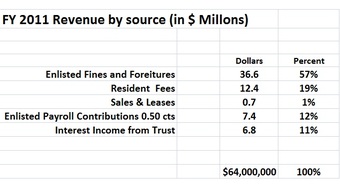
Budget
One of the uses of financial statements is as a budgeting tool, as in this example.
Other individuals and entities use financial statements too. For example:
- Prospective investors use financial statements to perform financial analysis, which is a key component in making investment decisions.
- A lending institution will examine the financial health of a person or organization and use the financial statement to decide whether or not to lend funds.
- Philanthropies may use financial statements of a non-profit as a component in determining where to donate funds.
- Government entities (tax authorities) need financial statements to ascertain the propriety and accuracy of taxes and other duties declared and paid by a company.
- Vendors who extend credit may use financial statements to assess the creditworthiness of the business.
- Employees also may use reports in making collective bargaining agreements
2.1.3: Limitations of Financial Statements
Financial statements can be limited by intentional manipulation, differences in accounting methods, and a sole focus on economic measures.
Learning Objective
Summarize the common limitations found in financial statements
Key Points
- One limitation of financial statements is that they are open to human interpretation and error, in some cases even intentional manipulation of figures to inflate economic performance.
- Another set of limitations of financial statements arises from different ways of accounting for activities across time periods and across companies, which can make comparisons difficult.
- Another limit to financial statements as a window into the creditworthiness or investment attractiveness of an entity is that financial statements focus solely on financial measures. Some argue for a “triple bottom line” including social and environmental measures.
Key Terms
- GAAP
-
An acronym for “Generally Accepted Accounting Principles.“ The standard framework of guidelines for financial accounting used in any given jurisdiction; generally known as accounting standards or standard accounting practice.
- audit
-
The verification of the financial statements of a legal entity intended to enhance the degree of confidence of intended users in the financial statements by providing reasonable assurance that the financial statements are presented fairly.
- corporate governance
-
The roles and relationships between a company’s management, its board, its shareholders and other stakeholders, and the goals for which the corporation is governed. Much of the contemporary interest in corporate governance is concerned with mitigation of the conflicts of interests and the nature and extent of accountability of people in the business.
Limitations of Financial Statements
The limitations of financial statements include inaccuracies due to intentional manipulation of figures; cross-time or cross-company comparison difficulties if statements are prepared with different accounting methods; and an incomplete record of a firm’s economic prospects, some argue, due to a sole focus on financial measures.
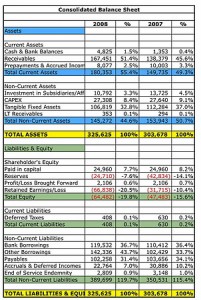
Consolidated financial statements
Financial statements can include a number of inaccuracies and limitations that affect the way a company can be viewed.
One limitation of financial statements is that they are open to human interpretation and error, in some cases even intentional manipulation of figures. In the United States, especially in the post-Enron era, there has been substantial concern about the accuracy of financial statements. High-profile cases in which management manipulated figures in financial statements to indicate inflated economic performance highlighted the need to review the effectiveness of accounting standards, auditing regulations, and corporate governance principles.
As a result, there has been renewed focus on the objectivity and independence of auditing firms. An audit of the financial statements of a public company is usually required for investment, financing, and tax purposes, and these are usually performed by independent accountants or auditing firms and included in the annual report. Additionally, in terms of corporate governance, managing officials like the CEO and CFO are personally liable for attesting that financial statements are not untrue or misleading, and making or certifying misleading financial statements exposes the people involved to substantial civil and criminal liability.
Another set of limitations of financial statements arises from different ways of accounting for activities across time periods and across companies. This can make it difficult to compare a company’s finances across time or to compare finances across companies. Different countries have developed their own accounting principles, making international comparisons of companies difficult. However, the Generally Accepted Accounting Principles (GAAP), a set of guidelines and rules, are one means by which uniformity and comparability between financial statements is improved. Recently there has been a push toward standardizing accounting rules made by the International Accounting Standards Board (IASB).
Another limit to financial statements as a window into the creditworthiness or investment attractiveness of an entity is that financial statements focus solely on financial measures of health. Even traditional investment analysis incorporates information outside of the financial statements to make organizational assessments. However, other methods such as full cost accounting (FCA) or true cost accounting (TCA) argue that an organization’s health cannot just be determined by its economic characteristics. Therefore, one needs to collect and present information about environmental, social, and economic costs and benefits (collectively known as the “triple bottom line”) to make an accurate evaluation.
2.2: The Income Statement
2.2.1: Elements of the Income Statement
The income statement, or profit and loss statement (P&L), reports a company’s revenue, expenses, and net income over a period of time.
Learning Objective
Construct a complete income statement
Key Points
- The income statement consists of revenues and expenses along with the resulting net income or loss over a period of time due to earning activities. The income statement shows investors and management if the firm made money during the period reported.
- The operating section of an income statement includes revenue and expenses. Revenue consists of cash inflows or other enhancements of assets of an entity, and expenses consist of cash outflows or other using-up of assets or incurring of liabilities.
- The non-operating section includes revenues and gains from non-primary business activities, items that are either unusual or infrequent, finance costs like interest expense, and income tax expense.
- The “bottom line” of an income statement is the net income that is calculated after subtracting the expenses from revenue. It is important to investors – also on a per share basis (as earnings per share, EPS) – as it represents the profit for the accounting period attributable to the shareholders.
Key Terms
- net income
-
Gross profit minus operating expenses and taxes.
- gross profit
-
The difference between net sales and the cost of goods sold.
- income statement
-
a calculation which shows the profit or loss of an accounting unit during a specific period of time, providing a summary of how the profit or loss is calculated from gross revenue and expenses
- income bond
-
a debt instrument where coupon payments are only made if the issuer can afford it
- statement of cash flows
-
a financial document that shows how changes in balance sheet accounts and income affect cash and cash equivalents, and breaks the analysis down to operating, investing, and financing activities
Elements of the Income Statement
The income statement is a financial statement that is used to help determine the past financial performance of the enterprise, predict future performance, and assess the capability of generating future cash flows . It is also known as the profit and loss statement (P&L), statement of operations, or statement of earnings.
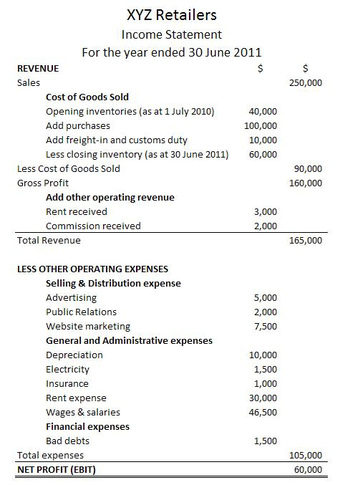
A Sample Income Statement
Expenses are listed on a company’s income statement.
The income statement consists of revenues (money received from the sale of products and services, before expenses are taken out, also known as the “top line”) and expenses, along with the resulting net income or loss over a period of time due to earning activities. Net income (the “bottom line”) is the result after all revenues and expenses have been accounted for. The income statement reflects a company’s performance over a period of time. This is in contrast to the balance sheet, which represents a single moment in time.
Methods for Constructing the Income Statement
The income statement can be prepared in one of two methods: single or multi-step.
The Single Step income statement totals revenues, then subtracts all expenses to find the bottom line.
The more complex Multi-Step income statement (as the name implies) takes several steps to find the bottom line. First, operating expenses are subtracted from gross profit. This yields income from operations. Then other revenues are added and other expenses are subtracted. This yields income before taxes. The final step is to deduct taxes, which finally produces the net income for the period measured.
Operating Revenues and Expenses
The operating section includes revenue and expenses. Revenue consists of cash inflows or other enhancements of the assets of an entity. It is often referred to as gross revenue or sales revenue. Expenses consist of cash outflows or other using-up of assets or incurrence of liabilities.
Elements of expenses include:
- Cost of Goods Sold (COGS): the direct costs attributable to goods produced and sold by a business. It includes items such as material costs and direct labor.
- Selling, General and Administrative Expenses (SG&A): combined payroll costs, except for what has been included as direct labor.
- Depreciation and amortization: charges with respect to fixed assets (depreciation) and intangible assets (amortization) that have been capitalized on the balance sheet for a specific accounting period.
- Research & Development (R&D): expenses included in research and development of products.
Non-operating Revenues and Expenses
The non-operating section includes revenues and gains from non- primary business activities (such as rent or patent income); expenses or losses not related to primary business operations (such as foreign exchange losses); gains that are either unusual or infrequent, but not both; finance costs (costs of borrowing, such as interest expense); and income tax expense.
In essence, if an activity is not a part of making or selling the products or services, but still affects the income of the business, it is a non-operating revenue or expense.
Reading the Income Statement
Certain items must be disclosed separately in the notes if it is material (significant). This could include items such as restructurings, discontinued operations, and disposals of investments or of property, plant and equipment. Irregular items are reported separately so that users can better predict future cash flows.
The “bottom line” of an income statement—often, literally the last line of the statement—is the net income that is calculated after subtracting the expenses from revenue. It is important to investors as it represents the profit for the year attributable to the shareholders. For companies with shareholders, earnings per share (EPS) are also an important metric and are required to be disclosed on the income statement.
2.2.2: Limitations of the Income Statement
Income statements have several limitations stemming from estimation difficulties, reporting error, and fraud.
Learning Objective
Demonstrate how the limitations of the income statement can influence valuation
Key Points
- Income statements include judgments and estimates, which mean that items that might be relevant but cannot be reliably measured are not reported and that some reported figures have a subjective component.
- With respect to accounting methods, one of the limitations of the income statement is that income is reported based on accounting rules and often does not reflect cash changing hands.
- Income statements can also be limited by fraud, such as earnings management, which occurs when managers use judgment in financial reporting to intentionally alter financial reports to show an artificial increase (or decrease) of revenues, profits, or earnings per share figures.
Key Terms
- LIFO
-
Method for accounting for inventory. LIFO stands for last-in, first-out, and assumes that the most recently produced items are recorded as sold first.
- FIFO
-
Method for for accounting for inventories. FIFO stands for first-in, first-out, and assumes that the oldest inventory items are recorded as sold first.
- matching principle
-
According to the principle, expenses are recognized when obligations are (1) incurred (usually when goods are transferred or services rendered, e.g. sold), and (2) offset against recognized revenues, which were generated from those expenses, no matter when cash is paid out. In cash accounting—in contrast—expenses are recognized when cash is paid out.
Income statements are a key component to valuation but have several limitations: items that might be relevant but cannot be reliably measured are not reported (such as brand loyalty); some figures depend on accounting methods used (for example, use of FIFO or LIFO accounting); and some numbers depend on judgments and estimates. In addition to these limitations, there are limitations stemming from the intentional manipulation of finances.
One of the limitations of the income statement is that income is reported based on accounting rules and often does not reflect cash changing hands. This could be due to the matching principle, which is the accounting principle that requires expenses to be matched to revenues and reported at the same time. Expenses incurred to produce a product are not reported in the income statement until that product is sold. Another common difference across income statements is the method used to calculate inventory, either FIFO or LIFO.
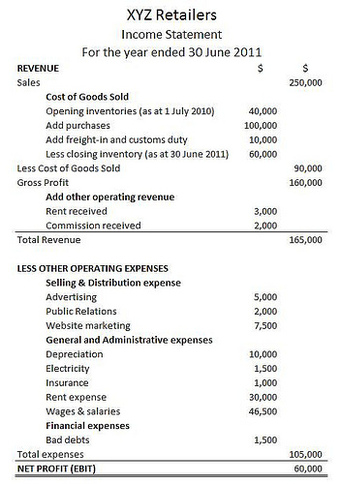
Income statement
Accounting for inventory can be done in different ways, leading to differences in statements.
In addition to good faith differences in interpretations and reporting of financial data in income statements, these financial statements can be limited by intentional misrepresentation. One example of this is earnings management, which occurs when managers use judgment in financial reporting and in structuring transactions to alter financial reports in a way that usually involves the artificial increase (or decrease) of revenues, profits, or earnings per share figures.
The goal with earnings management is to influence views about the finances of the firm. Aggressive earnings management is a form of fraud and differs from reporting error. Managers could seek to manage earnings for a number of reasons. For example, if a manager earns his or her bonus based on revenue levels at the end of December, there is an incentive to try to represent more revenues in December so as to increase the size of the bonus.
While it is relatively easy for an auditor to detect error, part of the difficulty in determining whether an error was intentional or accidental lies in the accepted recognition that calculations are estimates. It is therefore possible for legitimate business practices to develop into unacceptable financial reporting.
2.2.3: Effects of GAAP on the Income Statement
GAAP’s assumptions, principles, and constraints can affect income statements through temporary (timing) and permanent differences.
Learning Objective
Apply the four basic GAAP principles when preparing financial statements
Key Points
- Items that create temporary differences due to the recording requirements of GAAP include rent or other revenue collected in advance, estimated expenses, and deferred tax liabilities and assets.
- Also there are events, usually one-time events, which create “permanent differences,” such as GAAP recognizing as an expense an item that the IRS will not allow to be deducted.
- The four basic principles of GAAP can affect items on the income statement. These principles include the historical cost principle, revenue recognition principle, matching principle, and full disclosure principle.
Key Terms
- fair market value
-
An estimate of the market value of a property, based on what a knowledgeable, willing, and unpressured buyer would probably pay to a knowledgeable, willing, and unpressured seller in the market. An estimate of fair market value may be founded either on precedent or extrapolation but is subjective. Fair market value differs from other ways of determining value, such as intrinsic and imposed value.
- deferred
-
Of or pertaining to a value that is not realized until a future date, e.g. annuities, charges, taxes, income, either as an asset or liability.
Although most of the information on a company’s income tax return comes from the income statement, there often is a difference between pretax income and taxable income. These differences are due to the recording requirements of GAAP for financial accounting (usually following the matching principle and allowing for accruals of revenue and expenses) and the requirements of the IRS’s tax regulations for tax accounting (which are more oriented to cash).
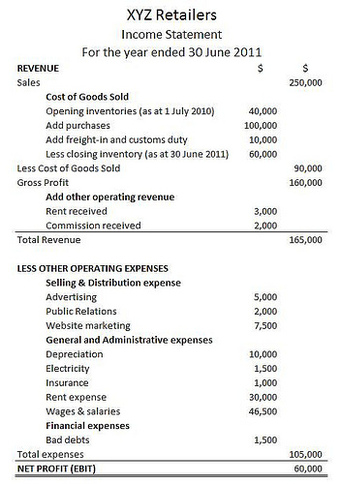
Income statement
GAAP and IRS accounting can differ.
Such timing differences between financial accounting and tax accounting create temporary differences. For example, rent or other revenue collected in advance, estimated expenses, and deferred tax liabilities and assets may create timing differences. Also, there are events, usually one time, which create “permanent differences,” such as GAAP, which recognizes as an expense an item that the IRS will not allow to be deducted.
To achieve basic objectives and implement fundamental qualities, GAAP has four basic principles:
- The historical cost principle: It requires companies to account and report based on acquisition costs rather than fair market value for most assets and liabilities.
- The revenue recognition principle. It requires companies to record when revenue is (1) realized or realizable and (2) earned, not when cash is received.
- The matching principle. This governs the matching of expenses and revenues, where expenses are recognized, not when the work is performed or when a product is produced, but when the work or the product actually makes its contribution to revenue.
- The full disclosure principle. This suggests that the amount and kinds of information disclosed should be decided based on a trade-off analysis, since a larger amount of information costs more to prepare and use. GAAP reporting also suggests that income statements should present financial figures that are objective, material, consistent, and conservative.
2.2.4: Noncash Items
Noncash items, such as depreciation and amortization, will affect differences between the income statement and cash flow statement.
Learning Objective
Identify noncash items that can affect the income statement
Key Points
- Noncash items should be added back in when analyzing income statements to determine cash flow because they do not contribute to the inflow or outflow of cash like other gains and expenses eventually do.
- Depreciation refers to the decrease in value of assets and the allocation of the cost of assets to periods in which the assets are used–for tangible assets, such as machinery.
- Amortization is a similar process to deprecation when applied to intangible assets, such as patents and trademarks.
Key Terms
- obsolescence
-
The state of being obsolete—no longer in use; gone into disuse; disused or neglected.
- amortization
-
The distribution of the cost of an intangible asset, such as an intellectual property right, over the projected useful life of the asset.
- depreciation
-
The measurement of the decline in value of assets. Not to be confused with impairment, which is the measurement of the unplanned, extraordinary decline in value of assets.
Noncash Items
Noncash items that are reported on an income statement will cause differences between the income statement and cash flow statement. Common noncash items are related to the investing and financing of assets and liabilities, and depreciation and amortization. When analyzing income statements to determine the true cash flow of a business, these items should be added back in because they do not contribute to inflow or outflow of cash like other gains and expenses.
Fixed assets, also known as a non-current asset or as property, plant, and equipment (PP&E), is an accounting term for assets and property. Unlike current assets such as cash accounts receivable, PP&E are not very liquid. PP&E are often considered fixed assets: they are expected to have relatively long life, and are not easily changed into another asset . These often receive a more favorable tax treatment than short-term assets in the form of depreciation allowances.

Machinery
Machinery is an example of a noncash asset.
Broadly speaking, depreciation is a way of accounting for the decreasing value of long-term assets over time. A machine bought in 2012, for example, will not be worth the same amount in 2022 because of things like wear-and-tear and obsolescence.
On a more detailed level, depreciation refers to two very different but related concepts: the decrease in the value of tangible assets (fair value depreciation) and the allocation of the cost of tangible assets to periods in which they are used (depreciation with the matching principle). The former affects values of businesses and entities. The latter affects net income.
In each period, long-term noncash assets accrue a depreciation expense that appears on the income statement. Depreciation expense does not require a current outlay of cash, but the cost of acquiring assets does. For example, an asset worth $100,000 in year 1 may have a depreciation expense of $10,000, so it appears as an asset worth $90,000 in year 2.
Amortization is a similar process to deprecation but is the term used when applied to intangible assets. Examples of intangible assets include copyrights, patents, and trademarks.
2.3: The Balance Sheet
2.3.1: Assets
Assets on a balance sheet are classified into current assets and non-current assets. Assets are on the left side of a balance sheet.
Learning Objective
Sketch the asset section of a balance sheet
Key Points
- The main categories of assets are usually listed first, and normally, in order of liquidity. On a balance sheet, assets will typically be classified into current assets and non-current (long-term) assets.
- Current assets are those assets which can either be converted to cash or used to pay current liabilities within 12 months. Current assets include cash and cash equivalents, short-term investments, accounts receivable, inventories and the portion of prepaid liabilities paid within a year.
- A non-current asset cannot easily be converted into cash. Non-current assets include property, plant and equipment (PPE), investment property, intangible assets, long-term financial assets, investments accounted for using the equity method, and biological assets.
Key Term
- liquidity
-
Availability of cash over short term: ability to service short-term debt.
The Balance Sheet
A standard company balance sheet has three parts: assets, liabilities and ownership equity. The main categories of assets are usually listed first, and normally, in order of liquidity. On the left side of a balance sheet, assets will typically be classified into current assets and non-current (long-term) assets.
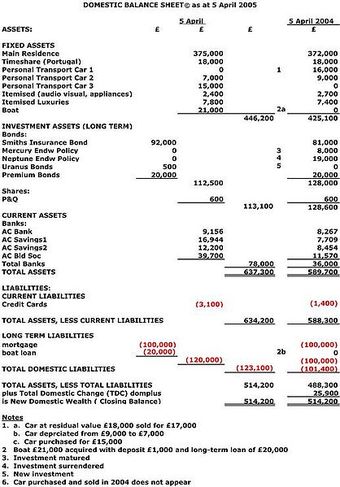
Balance Sheet
Sample Domestic Balance Sheet (DBS) to be referenced by Domestic Well-Being Accounting (DWBA)
Current Assets
A current asset on the balance sheet is an asset which can either be converted to cash or used to pay current liabilities within 12 months. Typical current assets include cash and cash equivalents, short-term investments, accounts receivable, inventories and the portion of prepaid liabilities which will be paid within a year.
Cash and cash equivalents are the most liquid assets found within the asset portion of a company’s balance sheet. Cash equivalents are assets that are readily convertible into cash, such as money market holdings, short-term government bonds or treasury bills, marketable securities and commercial papers. Cash equivalents are distinguished from other investments through their short-term existence; they mature within 3 months whereas short-term investments are 12 months or less, and long-term investments are any investments that mature in excess of 12 months.
Accounts receivable represents money owed by entities to the firm on the sale of products or services on credit. In most business entities, accounts receivable is typically executed by generating an invoice and either mailing or electronically delivering it to the customer, who, in turn, must pay it within an established timeframe, called credit terms or payment terms.
Most manufacturing organizations usually divide their inventory into:
- raw materials – materials and components scheduled for use in making a product,
- work in process (WIP) – materials and components that have began their transformation to finished goods,
- finished goods – goods ready for sale to customers, and
- goods for resale – returned goods that are salable.
A deferred expense or prepayment, prepaid expense (plural often prepaids), is an asset representing cash paid out to a counterpart for goods or services to be received in a later accounting period. For example, if a service contract is paid quarterly in advance, at the end of the first month of the period two months remain as a deferred expense. In the deferred expense, the early payment is accompanied by a related, recognized expense in the subsequent accounting period, and the same amount is deducted from the prepayment.
Non-current Assets
A non-current asset is a term used in accounting for assets and property which cannot easily be converted into cash. This can be compared with current assets such as cash or bank accounts, which are described as liquid assets. Non-current assets include property, plant and equipment (PPE), investment property (such as real estate held for investment purposes), intangible assets, long-term financial assets, investments accounted for by using the equity method, and biological assets, which are living plants or animals.
Property, plant, and equipment normally include items such as land and buildings, motor vehicles, furniture, office equipment, computers, fixtures and fittings, and plant and machinery. These often receive favorable tax treatment (depreciation allowance) over short-term assets.
Intangible assets are defined as identifiable, non-monetary assets that cannot be seen, touched or physically measured. They are created through time and effort, and are identifiable as a separate asset. There are two primary forms of intangibles – legal intangibles (such as trade secrets (e. g., customer lists), copyrights, patents, and trademarks) and competitive intangibles (such as knowledge activities (know-how, knowledge), collaboration activities, leverage activities, and structural activities). The intangible asset “goodwill” reflects the difference between the firm’s net assets and its market value; the amount is first recorded at time of acquisition. The additional value of the firm in excess of its net assets usually reflects the company’s reputation, talent pool, and other attributes that separate it from the competition. Goodwill must be tested for impairment on an annual basis and adjusted if the firm’s market value has changed.
Investments accounted for by using the equity method are 20-50% stake investments in other companies. The investor keeps such equities as an asset on the balance sheet. The investor’s proportional share of the associate company’s net income increases the investment (and a net loss decreases the investment), and proportional payment of dividends decreases it. In the investor’s income statement, the proportional share of the investee’s net income or net loss is reported as a single-line item.
2.3.2: Liabilities and Equity
The balance sheet contains details on company liabilities and owner’s equity.
Learning Objective
Apply the accounting equation to create a balance sheet
Key Points
- In financial accounting, a liability is defined as an obligation of an entity arising from past transactions or events, the settlement of which may result in the transfer or use of assets, provision of services or other yielding of economic benefits in the future.
- Equity is the residual claim or interest of the most junior class of investors in assets, after all liabilities are paid.
- The types of accounts and their description that comprise the owner’s equity depend on the nature of the entity and may include: Common stock, preferred stock, capital surplus, retained earnings, treasury stock, stock options and reserve.
Key Term
- Preferred Stock
-
Stock with a dividend, usually fixed, that is paid out of profits before any dividend can be paid on common stock. It also has priority to common stock in liquidation.
In financial accounting, a liability is defined as an obligation of an entity arising from past transactions or events, the settlement of which may result in the transfer or use of assets, provision of services or other yielding of economic benefits in the future. A liability is defined by the following characteristics:
- Any type of borrowing from persons or banks for improving a business or personal income that is payable during short or long time;
- A duty or responsibility to others that entails settlement by future transfer or use of assets, provision of services, or other transaction yielding an economic benefit, at a specified or determinable date, on occurrence of a specified event, or on demand;
- A duty or responsibility that obligates the entity to another, leaving it little or no discretion to avoid settlement; and,
- A transaction or event obligating the entity that has already occurred.
The accounting equation relates assets, liabilities, and owner’s equity: “” The accounting equation is the mathematical structure of the balance sheet.

Accounting equation
Assets = Liabilities + Owner’s Equity
In accounting and finance, equity is the residual claim or interest of the most junior class of investors in assets, after all liabilities are paid. If liability exceeds assets, negative equity exists. In an accounting context, shareholders’ equity (or stockholders’ equity, shareholders’ funds, shareholders’ capital, or similar terms) represents the remaining interest in assets of a company, spread among individual shareholders of common or preferred stock.
At the start of a business, owners put some funding into the business to finance operations. This creates a liability on the business in the shape of capital, as the business is a separate entity from its owners. Businesses can be considered, for accounting purposes, sums of liabilities and assets: this is the accounting equation. After liabilities have been accounted for, the positive remainder is deemed the owner’s interest in the business.
In financial accounting, owner’s equity consists of the net assets of an entity. Net assets is the difference between the total assets of the entity and all its liabilities. Equity appears on the balance sheet, one of the four primary financial statements.
The assets of an entity includes both tangible and intangible items, such as brand names and reputation or goodwill. The types of accounts and their description that comprise the owner’s equity depend on the nature of the entity and may include: Common stock, preferred stock, capital surplus, retained earnings, treasury stock, stock options and reserve.
The total changes to equity is calculated as follows:
Equity (end of year balance) = Equity (beginning of year balance) +/- changes to common or preferred stock and capital surplus +/- net income/loss (net profit/loss earned during the period) − dividends. Dividends are typically cash distributions of earnings to stockholders on hand and they are recorded as a reduction to the retained earnings account reported in the equity section.
2.3.3: Working Capital
Working capital is a financial metric which represents operating liquidity available to a business, organization and other entity.
Learning Objective
Discuss why working capital is an important metric for businesses.
Key Points
- Net working capital is calculated as current assets minus current liabilities.
- Current assets and current liabilities include three accounts which are of special importance: accounts receivable, accounts payable and inventories.
- The goal of working capital management is to ensure that the firm is able to continue its operations and that it has sufficient cash flow. The management of working capital involves managing inventories, accounts receivable and payable, and cash.
Key Terms
- deficit
-
the amount by which spending exceeds revenue
- operating liquidity
-
The ability of a company or individual to quickly convert assets to cash for the purpose of paying operating expenses.
Working capital (abbreviated WC) is a financial metric which represents operating liquidity available to a business, organization or other entity, including a governmental entity. Along with fixed assets, such as plant and equipment, working capital is considered a part of operating capital.
Net working capital is calculated as current assets minus current liabilities. It is a derivation of working capital, that is commonly used in valuation techniques such as discounted cash flows (DCFs). If current assets are less than current liabilities, an entity has a working capital deficiency, also called a working capital deficit. An increase in working capital indicates that the business has either increased current assets (that it has increased its receivables, or other current assets) or has decreased current liabilities – for example has paid off some short-term creditors.
Current assets and current liabilities include three accounts which are of special importance. These accounts represent the areas of the business where managers have the most direct impact: accounts receivable (current asset), inventories (current assets), and accounts payable (current liability). The current portion of debt (payable within 12 months) is critical, because it represents a short-term claim to current assets and is often secured by long-term assets. Common types of short-term debt are bank loans and lines of credit.
A company can be endowed with assets and profitability but short of liquidity if its assets cannot readily be converted into cash. Decisions relating to working capital and short-term financing are referred to as working capital management. These involve managing the relationship between a firm’s short-term assets and its short-term liabilities. The goal of working capital management is to ensure that the firm is able to continue its operations and that it has sufficient cash flow to satisfy both maturing short-term debt and upcoming operational expenses. The management of working capital involves managing inventories, accounts receivable and payable, and cash.
Inventory management is to identify the level of inventory which allows for uninterrupted production but reduces the investment in raw materials – and minimizes reordering costs – and hence, increases cash flow.
Debtors’ management involves identifying the appropriate credit policies, i.e. credit terms which will attract customers, such that any impact on cash flows and the cash conversion cycle will be offset by increased revenue and hence, return on capital.
Short-term financing requires identifying the appropriate source of financing, given the cash conversion cycle: the inventory is ideally financed by credit granted by the supplier; however, it may be necessary to utilize a bank loan (or overdraft).
Cash management involves identifying the cash balance which allows for the business to meet day-to-day expenses, but reduces cash holding costs.
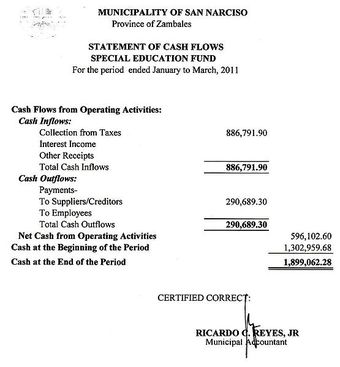
Statement of cash flows
The management of working capital involves managing inventories, accounts receivable and payable, and cash.
2.3.4: Liquidity
Liquidity, a business’s ability to pay obligations, can be assessed using various ratios: current ratio, quick ratio, etc.
Learning Objective
Calculate a company’s liquidity using a variety of methods.
Key Points
- Liquidity refers to a business’s ability to meet its payment obligations, in terms of possessing sufficient liquid assets, and to such assets themselves. For assets, liquidity is an asset’s ability to be sold without causing a significant movement in the price and with minimum loss of value.
- A standard company balance sheet has three parts: assets, liabilities and ownership equity. The main categories of assets are usually listed first, typically in order of liquidity.
- For a corporation with a published balance sheet there are various ratios used to calculate a measure of liquidity, namely the current ratio, the quick ratio, the operating cash flow ratio, and the liquidity ratio (acid test).
Key Terms
- liquidity ratio
-
measurement of the availability of cash to pay debt
- cash equivalents
-
A deferred expense or prepayment, prepaid expense, plural often prepaids, is an asset representing cash paid out to a counterpart for goods or services to be received in a later accounting period.
In accounting, liquidity (or accounting liquidity) is a measure of the ability of a debtor to pay his debts when they fall due. A standard company balance sheet has three parts: assets, liabilities and ownership equity. The main categories of assets are usually listed first, and typically in order of liquidity. Money, or cash, is the most liquid asset, and can be used immediately to perform economic actions like buying, selling, or paying debt, meeting immediate wants and needs. Next are cash equivalents, short-term investments, inventories, and prepaid expenses.
Liquidity also refers both to a business’s ability to meet its payment obligations, in terms of possessing sufficient liquid assets, and to such assets themselves. For assets themselves, liquidity is an asset’s ability to be sold without causing a significant movement in the price and with minimum loss of value.
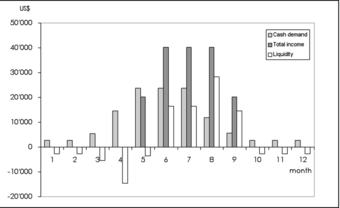
Liquidity
Monthly liquidity of an organic vegetable business
For a corporation with a published balance sheet, there are various ratios used to calculate a measure of liquidity. These include the following:
- The current ratio, which is the simplest measure and is calculated by dividing the total current assets by the total current liabilities. A value of over 100% is normal in a non-banking corporation. However, some current assets are more difficult to sell at full value in a hurry.
- The quick ratio, which is calculated by deducting inventories and prepayments from current assets and then dividing by current liabilities–this gives a measure of the ability to meet current liabilities from assets that can be readily sold.
- The operating cash flow ratio can be calculated by dividing the operating cash flow by current liabilities. This indicates the ability to service current debt from current income, rather than through asset sales.
- The liquidity ratio (acid test) is a ratio used to determine the liquidity of a business entity. Liquidity ratio expresses a company’s ability to repay short-term creditors out of its total cash. The liquidity ratio is the result of dividing the total cash by short-term borrowings. It shows the number of times short-term liabilities are covered by cash. If the value is greater than 1.00, it means fully covered. The formula is the following: LR = liquid assets / short-term liabilities.
2.3.5: Debt to Equity
The debt-to-equity ratio (D/E) indicates the relative proportion of shareholder’s equity and debt used to finance a company’s assets.
Learning Objective
Identify the different methods of calculating the debt to equity ratio.
Key Points
- The debt-to-equity ratio (D/E) is a financial ratio indicating the relative proportion of shareholders’ equity and debt used to finance a company’s assets. Closely related to leveraging, the ratio is also known as risk, gearing or leverage.
- Preferred stocks can be considered part of debt or equity. Attributing preferred shares to one or the other is partially a subjective decision.
- The formula of debt/ equity ratio: D/E = Debt (liabilities) / equity = Debt / (Assets – Debt) = (Assets – Equity) / Equity.
Key Term
- leverage
-
The use of borrowed funds with a contractually determined return to increase the ability of a business to invest and earn an expected higher return (usually at high risk).
Debt to Equity
The debt-to-equity ratio (D/E) is a financial ratio indicating the relative proportion of shareholders’ equity and debt used to finance a company’s assets. Closely related to leveraging, the ratio is also known as risk, gearing or leverage. The two components are often taken from the firm’s balance sheet or statement of financial position. However, the ratio may also be calculated using market values for both if the company’s debt and equity are publicly traded, or using a combination of book value for debt and market value for equity financially. “”
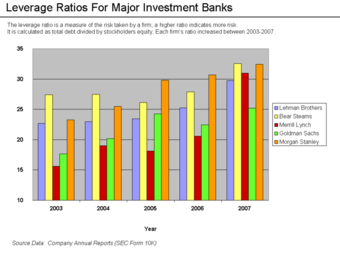
Leverage Ratios of Investment Banks
Each of the five largest investment banks took on greater risk leading up to the subprime crisis. This is summarized by their leverage ratio, which is the ratio of total debt to total equity. A higher ratio indicates more risk.
Preferred stocks can be considered part of debt or equity. Attributing preferred shares to one or the other is partially a subjective decision, but will also take into account the specific features of the preferred shares. When used to calculate a company’s financial leverage, the debt usually includes only the long term debt (LTD). Quoted ratios can even exclude the current portion of the LTD.
Financial analysts and stock market quotes will generally not include other types of liabilities, such as accounts payable, although some will make adjustments to include or exclude certain items from the formal financial statements. Adjustments are sometimes also made, for example, to exclude intangible assets, and this will affect the formal equity; debt to equity (dequity) will therefore also be affected.
The formula of debt/equity ratio: D/E = Debt (liabilities) / equity. Sometimes only interest-bearing long-term debt is used instead of total liabilities in the calculation.
A similar ratio is the ratio of debt-to-capital (D/C), where capital is the sum of debt and equity:D/C = total liabilities / total capital = debt / (debt + equity)
The relationship between D/E and D/C is: D/C = D/(D+E) = D/E / (1 + D/E)
The debt-to-total assets (D/A) is defined asD/A = total liabilities / total assets = debt / (debt + equity + non-financial liabilities)
On a balance sheet, the formal definition is that debt (liabilities) plus equity equals assets, or any equivalent reformulation. Both the formulas below are therefore identical: A = D + EE = A – D or D = A – E
Debt to equity can also be reformulated in terms of assets or debt: D/E = D /(A – D) = (A – E) / E
2.3.6: Market Value vs. Book Value
Book value is the price paid for a particular asset, while market value is the price at which you could presently sell the same asset.
Learning Objective
Distinguish between market value and book value.
Key Points
- Market value is the price at which an asset would trade in a competitive auction setting.
- Book value or carrying value is the value of an asset according to its balance sheet account balance. For assets, the value is based on the original cost of the asset less any depreciation, amortization or impairment costs made against the asset.
- In many cases, the carrying value of an asset and its market value will differ greatly. However, they are interrelated.
Key Term
- amortization
-
The distribution of the cost of an intangible asset, such as an intellectual property right, over the projected useful life of the asset.
Market value is the price at which an asset would trade in a competitive auction setting. Market value is often used interchangeably with open market value, fair value, or fair market value. International Valuation Standards defines market value as “the estimated amount for which a property should exchange on the date of valuation between a willing buyer and a willing seller in an arm’s-length transaction after proper marketing wherein the parties had each acted knowledgeably, prudently, and without compulsion. “
In accounting, book value or carrying value is the value of an asset according to its balance sheet account balance. For assets, the value is based on the original cost of the asset less any depreciation, amortization, or impairment costs made against the asset. An asset’s initial book value is its its acquisition cost or the sum of allowable costs expended to put it into use. Assets such as buildings, land, and equipment are valued based on their acquisition cost, which includes the actual cash price of the asset plus certain costs tied to the purchase of the asset, such as broker fees. The book value is different from market value, as it can be higher or lower depending on the asset in question and the accounting practices that affect book value, such as depreciation, amortization and impairment. In many cases, the carrying value of an asset and its market value will differ greatly. If the asset is valued on the balance at market value, then its book value is equal to the market value.

Depreciation methods which are essential in calculating book value
4 Depreciation methods (1. Straight-Line method, (2. Double-Declining Balance method, (3. Sum-of-the-Years’ Digits method, (4.Productive output method)
Ways of measuring the value of assets on the balance sheet include: historical cost, market value or lower of cost or market. Historical cost is typically the purchase price of the asset or the sum of certain costs expended to put the asset into use. Market value is the asset’s worth if it were to be exchanged in the open market in an arm’s length transaction; it can also be derived based on the asset’s present value of the expected cash flows it will generate. Certain assets are disclosed at lower of cost or market in order to conform to accounting’s conservatism principle, which stresses that assets should never be overstated.
2.3.7: Limitations of the Balance Sheet
The three limitations to balance sheets are assets being recorded at historical cost, use of estimates, and the omission of valuable non-monetary assets.
Learning Objective
Critique the balance sheet
Key Points
- Balance sheets do not show true value of assets. Historical cost is criticized for its inaccuracy since it may not reflect current market valuation.
- Some of the current assets are valued on an estimated basis, so the balance sheet is not in a position to reflect the true financial position of the business.
- The balance sheet can not reflect those assets which cannot be expressed in monetary terms, such as skill, intelligence, honesty, and loyalty of workers.
Key Terms
- carrying value
-
In accounting, book value or carrying value is the value of an asset according to its balance sheet account balance. For assets, the value is based on the original cost of the asset less any depreciation, amortization or Impairment costs made against the asset.
- Fixed assets
-
Fixed assets, also known as non-current assets or property, plant, and equipment (PP&E), is a term used in accounting for assets and property that cannot easily be converted into cash. This can be compared with current assets, such as cash or bank accounts, which are described as liquid assets. In most cases, only tangible assets are referred to as fixed.
Limitations of the Balance Sheet
In financial accounting, a balance sheet or statement of financial position is a summary of the financial balances of a sole proprietorship, business partnership, corporation, or other business organization, such as an LLC or an LLP. Assets, liabilities and ownership equity are listed as of a specific date, such as the end of its financial year. A balance sheet is often described as a “snapshot of a company’s financial condition. ” Of the four basic financial statements, the balance sheet is the only statement which applies to a single point in time of a business’ calendar year. There are three primary limitations to balance sheets, including the fact that they are recorded at historical cost, the use of estimates, and the omission of valuable things, such as intelligence.
Fixed assets are shown in the balance sheet at historical cost less depreciation up to date. Depreciation affects the carrying value of an asset on the balance sheet. The historical cost will equal the carrying value only if there has been no change recorded in the value of the asset since acquisition. Therefore, the balance sheet does not show true value of assets. Historical cost is criticized for its inaccuracy since it may not reflect current market valuation.

Four depreciation methods
Different methods of depreciation affect the carrying value of an asset on balance sheets.
Some of the current assets are valued on estimated basis, so the balance sheet is not in a position to reflect the true financial position of the business. Intangible assets like goodwill are shown in the balance sheet at imaginary figures, which may bear no relationship to the market value. The International Accounting Standards Board (IASB) offers some guidance (IAS 38) as to how intangible assets should be accounted for in financial statements. In general, legal intangibles that are developed internally are not recognized, and legal intangibles that are purchased from third parties are recognized. Therefore, there is a disconnect–goodwill from acquisitions can be booked, since it is derived from a market or purchase valuation. However, similar internal spending cannot be booked, although it will be recognized by investors who compare a company’s market value with its book value.
Finally, the balance sheet can not reflect those assets which cannot be expressed in monetary terms, such as skill, intelligence, honesty, and loyalty of workers.
2.4: Tax Considerations
2.4.1: Corporate Taxes
Corporate taxes are levied on the income of various entities, stemming from their business operations.
Learning Objective
Identify how each type of business association is taxed.
Key Points
- Legal forms of corporations include sole proprietorships, partnerships, C corporations, S corporations, and LLCs.
- The type of corporation chosen will determine such factors as liability and taxation on the entity.
- Taxable income for a corporation is defined as all gross income (sales plus other income minus cost of goods sold and tax exempt income) less allowable tax deductions and tax credits.
Key Term
- jurisdiction
-
the limits or territory within which authority may be exercised
Corporate Taxes
Income taxes in the United States are an enormous and complex issue. Corporate taxes are especially complicated because of the inherent complexities of corporations themselves. Corporations may be taxed on their incomes, property, or their very existence. The types and rates of taxes vary depending on the jurisdiction in which the corporation is organized or acts. Maryland, for example, imposes a tax on corporations organized within its borders based on the number of shares of capital stock they issue.
Legal Forms of Corporations
Corporate taxation differs depending upon the legal form of the corporation. Which legal form to take is driven by the objectives of the company, but taxation also plays a vital role. Tax law contains built-in trade-offs for each corporate form, and companies often must give up some liability protection or flexibility.
Sole Proprietorship
A sole proprietorship is a business entity that is owned and run by a single individual. There is no legal distinction between the owner and the business. They are one in the same for tax purposes. The individual reports all income and expenses for the business on his or her personal income tax statement. In other words, the business is not taxed as a separate entity.
There is no method for sheltering tax in a sole proprietorship. Earnings are taxed regardless if they are actually distributed. In addition, the individual is held liable for the actions of the business, meaning claimants can pursue the personal property of the individual should solvency issues arise.
Partnership
A partnership is a business entity with two or more owners. For tax purposes, partnerships are treated similarly to a sole proprietorship – the owners pay tax on their “distributive share” of the business’s taxable income. The partners must agree on how the income of the business will be allocated. Partners are jointly liable for the operations of the business. Thus, one partner may pursue one or any number of other partners in the case of personal damages or losses.
C Corporation
A C corporation refers to any corporation that is taxed separately from its owners. Although vastly outnumbered by sole proprietorships and partnerships, most of the largest companies in the U.S. are C corporations. Owners of C corporations are personally protected from any liability of the company – an idea known as the corporate veil. In return, the earnings of a C corporation are taxed both on the entity level and the individual level.
S Corporation
The S corporation is a hybrid entity wherein the income, deductions and tax credits of the business are taxed at the shareholder level as opposed to the entity level. However, owners enjoy the same limited liability awarded to C corporations. In exchange for this luxury, rules are placed on the types of corporations that can elect S status:
- The corporation must have only one class of stock.
- It must be a domestic corporation (owned by U.S. citizens).
- It must not have more than 100 shareholders (spouses are considered to be one shareholder).
- Shareholders generally cannot include corporations or partnerships (certain trusts, estates and tax-exempt corporations are permitted).
- Profits and losses must be allocated to shareholders proportionately to each one’s interest in the business.
Limited Liability Company (LLC)
An LLC, like an S corporation, is a hybrid entity having certain characteristics of both a corporation and a partnership or sole proprietorship. The primary characteristic an LLC shares with a corporation is limited liability, and the primary characteristic it shares with a partnership is taxation on the ownership level. It differs from an S corporation in that there are no restrictions on the number or types of shareholders. It is actually a type of unincorporated association rather than a corporation.
Taxable Income
In the United States, taxable income for a corporation is defined as all gross income (sales plus other income minus cost of goods sold and tax exempt income) less allowable tax deductions and tax credits. This income is taxed at a specified corporate tax rate. This rate varies by jurisdiction and is generally the same for different types of income. Some systems have graduated tax rates – corporations with lower levels of income pay a lower rate of tax – or impose tax at different rates for different types of corporations.
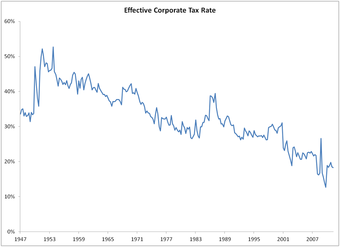
US Corporate Tax Rates
This graph shows the effect of corporate tax rates in the U.S. from 1947 through 2012.
In the US, federal rates range from 15% to 35%. States charge rates ranging from 0% to 10%, deductible in computing federal taxable income. Some cities charge rates up to 9%, also deductible in computing Federal taxable income. Corporations are also subject to property tax, payroll tax, withholding tax, excise tax, customs duties and value added tax. However, these are rarely referred to as “corporate tax.”
2.4.2: Tax Deductions
A tax deduction is a reduction of the amount of income subject to tax.
Learning Objective
Identify deductions associated with carrying on a trade or business
Key Points
- Business expenses are those that are incurred in order to generate profit for a company, such as cost of goods sold.
- Ordinary expenses, such as interest paid on debt, are typically deductible as long as they are appropriate to the nature of the business, the sort expected to help produce income, and are not lavish and extravagant.
- In a progressive tax system, the marginal tax rate must be used in order to calculate the after-tax cost of a deductible expense.
- While a deduction is a reduction of the level of taxable income, a tax credit is a sum deducted from the total amount of tax owed.
Key Term
- capital gains
-
Profit that results from a disposition of a capital asset, such as stock, bond, or real estate due to arbitrage.
Example
- A company’s marginal tax rate is 35%. What is the after-tax cost of a $1,000 of deductible expense? After-tax cost = 1,000 x (1-0.35), so after-tax cost = 650
Tax Deductions
A tax deduction is a sum that can be removed from tax calculations. Specifically, it is a reduction of the income subject to tax. Often these deductions are subject to limitations or conditions. Nearly all jurisdictions that tax business income allow tax deductions for expenses incurred in trading or carrying on the trade or business. However, to be deducted, the expenses must be incurred in furthering the business, such as it must contribute to profit.
Deduction of Expenses
Expenses incurred in order to generate profit for a company are referred to as business expenses. These can be categorized into cost of goods sold and ordinary expenses–also knowns as trading or necessary expenses.
Cost of Goods Sold
Nearly all income tax systems allow a deduction for cost of goods sold. This can be considered an expense or simply a reduction in gross income, which is the starting point for determining Federal and state income tax. Several complexities must be factored in when determining cost of goods sold, including:
- assigning costs to particular goods when specific identification is not feasible;
- attributing common costs, such as factory burden, to particular goods;
- determining when costs are recognized;
- recognizing costs of goods that will not be sold or have declined in value.
Ordinary Expenses
According to tax law, the United States allows as a deduction “all the ordinary and necessary expenses paid or incurred during the taxable year in carrying on any trade or business…” Generally, this business must be regular, continuous, substantial, and entered into with an expectation of profit. Ordinary and necessary expenses tend to be those that are appropriate to the nature of the business, the sort expected to help produce income and promote the business, and those that are not lavish and extravagant.
An example of an ordinary expense is interest paid on debt, or interest expense incurred by a corporation in carrying out its trading activities. Such an expense comes with limitations, though, such as limiting the amount of deductible intrest that can be paid to related parties.
Non-Business Expenses
Expenses incurred from holding assets expected to produce income may also be deductible. For example, a deduction may be allowed for loss on sale, exchange, or abandonment of both business and non-business income producing assets. In the United States, a loss on non-business assets is considered a capital loss and deduction of the loss is limited to capital gains.
Marginal Tax Rate
Corporate taxes in the United States are considered to be progressive. That is to say, taxes are charged at a higher rate as income grows. To fully understand the effect of tax deductions, we must consider the marginal tax rate, which is the rate of tax paid on the next or last unit of currency of taxable income. The marginal tax rate is dependent upon a jurisdiction’s tax structure, usually referred to as tax brackets. To determine the after-tax cost of a deductible expense, we simply multiply the cost by one minus the appropriate marginal tax rate .

Marginal Income Tax Rates
This graph plots the marginal income tax rates for the top tax bracket in the US from 1913 to 2009.
Deductions Versus Credits
Tax deductions and tax credits are often incorrectly equated. While a deduction is a reduction of the level of taxable income, a tax credit is a sum deducted from the total amount of tax owed. It is a dollar-for-dollar tax saving. For example, a tax credit of $1,000 reduced taxes owed by $1,000, regardless of the marginal tax rate. A tax credit may be granted in recognition of taxes already paid, as a subsidy, or to encourage investment or other behaviors.
2.4.3: Depreciation
Depreciation is the allocation of expenses associated with assets that contribute to operations over several periods.
Learning Objective
Describe the effect depreciation has on calculating a company’s tax burden
Key Points
- To determine depreciation expense, the useful life of an asset under depreciation is estimated in time-units. Then the corresponding depreciation rate is calculated that will extinguish the value of the asset from the books when the estimated useful life ends.
- The straight-line method of depreciation reduces the book value of an asset by the same amount each period.
- The declining balance method of depreciation provides for a higher depreciation expense in the first year of an asset’s life and gradually decreases expenses in subsequent years.
- Activity depreciation methods are not based on time but on a level of activity, such as miles driven or cycle counts.
- Depreciation allows a company to properly identify the amount of income it generates in a given period.
Key Terms
- amortize
-
To wipe out (a debt, liability etc. ) gradually or in installments.
- salvage value
-
The estimated value of an asset at the end of its useful life.
Example
- The overall cost for a company’s new piece of machinery is 100,000. The equipment is assumed to have a salvage value at the end of it’s life of 10,000. The useful life of the equipment is expected to be 10 years. If straight-line depreciation is used, what will be the annual depreciation expense? Depreciation = (100,000-10,000) / 10 Depreciation = $9,000
Depreciation
Many tax systems require that the cost of items likely to produce future benefits be capitalized. Such assets include property and capital equipment that represent a commitment of resources over several periods. In accounting, the profits (net income) from an activity must be reduced by the costs associated with that activity. When an asset will be used in operations for several periods, tax systems often allow the allocation of the costs to periods in which the assets are used. In the U.S., this allocation is known as depreciation expense. It is important to reasonably estimate the useful life of the asset under depreciation in time-units. Then it is important to calculate the corresponding depreciation rate that will result in extinguishing the value of the asset from the books when the estimated useful life ends. There are several methods for achieving this goal.
Straight-Line Method
The straight-line method of depreciation reduces the book value of an asset by the same amount each period. This amount is determined by dividing the total value of the asset, less its salvage value, by the number of periods in its useful life. This amount is then deducted from income in each applicable period. Straight-line depreciation is the simplest and most-often-used technique .

Straight-Line Depreciation
Annual depreciation expense is equal to the original cost of the asset minus its salvage value, divided by the useful life of the asset.
The economic reasoning behind the straight-line method involves the acceptance that depreciation is an approximation of the rate at which an asset transfers value to the operations of a business. As a result, we should use the most economical, or simplest, method to calculate and incorporate its costs.
Declining Balance Method
The declining balance method of depreciation provides for a higher depreciation expense in the first year of an asset’s life and gradually decreases expenses in subsequent years. This may be a more realistic reflection of the actual expected benefit from the use of the asset because many assets are most useful when they are new. Under this method, the annual depreciation expense is found by multiplying book value of the asset each year by a fixed rate. Since this book value will differ from year to year, the annual depreciation expense will subsequently differ. The most commonly used rate is double the straight-line rate. Since the declining balance method will never fully amortize the original cost of the asset, the salvage value is not considered in determining the annual depreciation.
Activity Depreciation Methods
Activity depreciation methods are not based on time, but on a level of activity. When the asset is acquired, its life is estimated in terms of this level of activity. This could be miles driven for a vehicle or a cycle count for a machine. Each year, the depreciation expense is calculated by multiplying the rate by the actual activity level.
Effect of Depreciation on Taxes
Depreciation expense affects net income in each period of an asset’s useful life. Therefore, it can be deducted from taxes owed in each of these periods. In other words, depreciation allows a company to properly identify the amount of income it generates in a given period. As with all expenses, a dollar of taxes that a company can defer until later is a dollar that can be used in profit generating operations today.
2.4.4: Individual Taxes
The U.S. federal, state and local governments levy taxes on individuals based on income, property, estate transfers, and/or sales transactions.
Learning Objective
Describe each type of tax that can be imposed on an individual
Key Points
- A direct tax is one imposed upon an individual person or on property, as opposed to an indirect tax that is imposed upon a transaction.
- Income tax is levied on the total income of the individual, less deductions and credits.
- Sales tax is levied on the state level on retail sale, lease, and rental of many goods, as well as some services.
- Property tax is levied on interests in real property (land, buildings, and permanent improvements).
- Estate tax is an excise tax levied on the right to pass property at death.
Key Term
- filing status
-
A status defining the type of tax return form an individual will use, which is based on marital status and family situation.
Individual Taxes
In the United States, there are an assortment of federal, state, local, and special purpose taxes that are imposed by such jurisdictions on individuals in order to finance government operations. These taxes may be imposed on the same income, property, or activity, often without offset of one tax against another. Taxes may be based on property, income, transactions, importation of goods, business activity, or a variety of factors, and are generally imposed on the type of taxpayer for whom such tax base is relevant.
Direct Versus Indirect Taxes
Individual taxes can generally be defined as either direct or indirect. A direct tax is one imposed upon an individual person or on property, as opposed to a tax imposed upon a transaction. In U.S. constitutional law, direct taxes refer to poll taxes and property taxes, which are based on simple existence or ownership. Indirect taxes, such as sales or value-added tax, are imposed only when a taxable transaction occurs. People have the freedom to engage in or refrain from such transactions, whereas a direct tax is typically imposed upon an individual in an unconditional manner.
Individual Tax Categories

Federal Tax Receipts
This chart depicts the level of tax received by the United States federal government from each source in 2010.
Income Tax
Personal income tax is generally the largest source of tax revenue in the United States. Taxes based on income are imposed at the federal, most state, and some local levels. Income tax is levied on the total income of the individual, less deductions, reducing an individual’s taxable income, and credits, a dollar-for-dollar reduction of total tax liability. The tax system allows for personal exemptions, as well as certain “itemized deductions,” including:
- Medical expenses (over 7.5% of adjusted gross income)
- State and local income and property taxes
- Interest expense on certain home loans
- Gifts of money or property to qualifying charitable organizations, subject to certain maximum limitations
- Losses on non-income-producing property due to casualty/theft
- Contribution to certain retirement or health savings plans
- Certain educational expenses
Income tax is often collected on a pay-as-you-earn basis (i.e., witholding taxes from wages). Small corrections are usually made after the end of the tax year. These corrections take one of two forms: payments to the government for taxpayers who have not paid enough during the tax year; and government tax refunds for those who have overpaid.
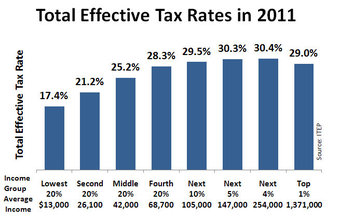
Total Effective Tax Rates
This graph shows the total effective tax rates for each earning class in 2011.
Federal and many state income tax rates are graduated or progressive–they are higher (graduated) at higher levels of income. The income level at which various tax rates apply for individuals varies by filing status. The income level at which each rate starts generally is higher, therefore, tax is lower for married couples filing a joint return or single individuals filing as head of household. Individuals are subject to federal graduated tax rates from 10% to 35%. State income tax rates vary from 1% to 16%, including local income tax where applicable.
Payroll Tax
Payroll taxes are imposed on employers and employees and on various compensation bases. These include income tax witholding, social security and medicare taxes, and unemployment taxes.
Sales Tax
Sales tax is an indirect tax levied on the state level, including taxes on retail sale, lease and rental of goods, as well as some services. Many cities, counties, transit authorities, and special purpose districts impose an additional local sales tax. Sales tax is calculated as the purchase price times the appropriate tax rate. Tax rates vary widely by jurisdiction from less than 1% to over 10%. Nearly all jurisdictions provide numerous categories of goods and services that are exempt from sales tax or taxed at a reduced rate.
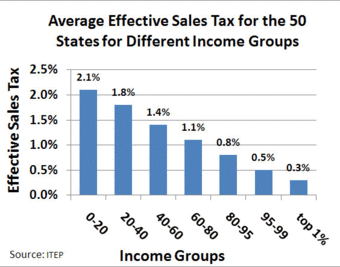
Sales Tax Rates
This graph shows the effective sales tax rates for the 50 states.
In addition to sales tax, excise taxes are imposed at the federal and state levels on a goods, including alcohol, tobacco, tires, gasoline, diesel fuel, coal, firearms, telephone service, air transportation, unregistered bonds, etc.
Property Tax
Most jurisdictions below the state level impose a tax on interests in real property (land, buildings, and permanent improvements). Property tax is based on fair market value the subject property. The amount of tax is determined annually based on the market value of each property on a particular date. The tax is computed as the determined market value times an assessment ratio times the tax rate.
Estate and Gift Tax
The estate tax is an excise tax levied on the right to pass property at death. It is imposed on the estate, not the beneficiary. Gift taxes are levied on the giver (donor) of property where the property is transferred for less than adequate consideration. The Federal gift tax is computed based on cumulative taxable gifts, and is reduced by prior gift taxes paid. The Federal estate tax is computed on the sum of taxable estate and taxable gifts, and is reduced by prior gift taxes paid. These taxes are computed as the taxable amount times a graduated tax rate (up to 35%). Taxable values of estates and gifts are the fair market value.
2.5: The Statement of Cash Flows
2.5.1: Cash Flow from Operations
The operating cash flows refers to all cash flows that have to do with the actual operations of the business, such as selling products.
Learning Objective
Distinguish events that would affect the operating section of the cash flow statement from all of the business’s other transaction
Key Points
- Operating cash flows refers to the cash a company generates from the revenues it brings in, excluding costs associated with long-term investment on capital items or investment in securities (these are investing or financing activities).
- GAAP and IFRS vary in their categorization of many cash flows, such as paying dividends. Some activities that are operating cash flows under one system are financing or investing in another.
- Major operating activities such as manufacturing products or selling a product may appear on the income statement but not on the cash flow statement, because cash has not yet changed hands.
Key Terms
- GAAP
-
Generally Accepted Accounting Principles refer to the standard framework of guidelines, conventions, and rules accountants are expected to follow in recording, summarizing, and preparing financial statements in any given jurisdiction.
- IFRS
-
International Financial Reporting Standards. The major accounting standards system used outside of the United States.
The operating cash flows component of the cash flow statement refers to all cash flows that have to do with the actual operations of the business. It refers to the amount of cash a company generates from the revenues it brings in, excluding costs associated with long-term investment on capital items or investment in securities (these are investing or financing activities). Essentially, it is the difference between the cash generated from customers and the cash paid to suppliers.
Cash flows from operating activities can be calculated and disclosed on the cash flow statement using the direct or indirect method. The direct method shows the cash inflows and outflows affecting all current asset and liability accounts, which largely make up most of the current operations of the entity. Those preparers that use the direct method must also provide operating cash flows under the indirect method. The indirect method is a reconciliation of the period’s net income to arrive at cash flows from operations; changes in current asset and liability accounts are added or subtracted from net income based on whether the change increased or decreased cash. The indirect method must be disclosed in the cash flow statement to comply with U.S. accounting standards, or GAAP.

US GAAP vs. IFRS Cash Flow Classification
Some transactions may be classified as different types of cash flows under GAAP and IFRS accounting standards.
One major difference between GAAP and IFRS is how interest paid is categorized. Under GAAP, a loan payment would have to be broken down into two parts: the payment on principal (financing) and the payment of interest (operating). Under IFRS, it is possible to categorize both as financing cash flows.
All of the major operating cash flows, however, are classified the same way under GAAP and IFRS. The most noticeable cash inflow is cash paid by customers. Cash from customers is not necessarily the same as revenue, though. For example, if a company makes all of its sales by extending credit to customers, it will have generated revenues but not cash flows from customers. It is only when the company collects cash from customers that it has a cash flow.
Significant cash outflows are salaries paid to employees and purchases of supplies. Just as with sales, salaries, and the purchase of supplies may appear on the income statement before appearing on the cash flow statement. Operating cash flows, like financing and investing cash flows, are only accrued when cash actually changes hands, not when the deal is made.
2.5.2: Cash Flow from Investing
Cash flow from investing results from activities related to the purchase or sale of assets or investments made by the company.
Learning Objective
Distinguish investing activities that affect a company’s cash flow statement from the business’s other transactions
Key Points
- Assets included in investment activity include land, buildings, and equipment.
- Receiving dividends from another company’s stock is an investing activity, although paying dividends on a company’s own stock is not.
- An investing activity only appears on the cash flow statement if there is an immediate exchange of cash.
Key Terms
- investing activities
-
actions where money is put into something with the expectation of gain, usually over a longer term
- purchase return
-
merchandise given back to the seller from the buyer after the sale in return for a refund
- investing activity
-
An activity that causes changes in non-current assets or involves a return on investment.
- merger
-
The legal union of two or more corporations into a single entity, typically assets and liabilities being assumed by the buying party.
One of the components of the cash flow statement is the cash flow from investing . An investing activity is anything that has to do with changes in non-current assets — including property and equipment, and investment of cash into shares of stock, foreign currency, or government bonds — and return on investment — including dividends from investment in other entities and gains from sale of non-current assets. These activities are represented in the investing income part of the income statement.
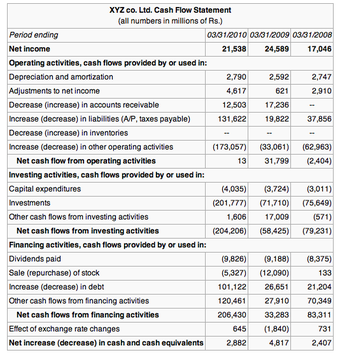
Cash Flow Statement
Example of cash flow statement (indirect method)
It is important to note that investing activity does not concern cash from outside investors, such as bondholders or shareholders. For example, a company may decide to pay out a dividend. A dividend is often thought of as a payment to those who invested in the company by buying its stock. However, this cash flow is not representative of an investing activity on the part of the company. The investing activity was undertaken by the shareholder. Therefore, paying out a dividend is a financing activity.
Some examples of investment activity from the company’s perspective would include:
- Cash outflow from the purchase of an asset (land, building, equipment, etc.).
- Cash inflow from the sale of an asset.
- Cash outflow from the acquisition of another company.
- Cash inflow resulting from a merger.
- Cash inflow resulting dividends paid on stock owned in another company.
It is important to remember that, as with all cash flows, an investing activity only appears on the cash flow statement if there is an immediate exchange of cash. Therefore, extending credit to a customer (accounts receivable) is an investing activity, but it only appears on the cash flow statement when the customer pays off their debt.
2.5.3: Cash Flow from Financing
Cash flows from financing activities arise from the borrowing, repaying, or raising of money.
Learning Objective
Distinguish financing activities that affect a company’s cash flow statement from all of the business’s other transactions
Key Points
- Financing activities can be seen in changes in non-current liabilities and in changes in equity in the change-in-equity statement.
- A positive financing cash flow could be really great for a company (it just went issued stock at a great price) or could be due to the company having to take out loans to stay out of bankruptcy.
- Issuing credit is not a financing activity though taking on credit is. Like all cash flows, such activities only appear on the cash flow statement when the exchange of money actually takes place.
Key Terms
- financing activities
-
actions where money is flowing between the company and investors in the company, such as banks and shareholders
- financing
-
A transaction that provides funds for a business.
Financing Activities
One of the three main components of the cash flow statement is cash flow from financing. In this context, financing concerns the borrowing, repaying, or raising of money. This could be from the issuance of shares , buying back shares, paying dividends, or borrowing cash. Financing activities can be seen in changes in non-current liabilities and in changes in equity in the change-in-equity statement.

NYSE
The cash from issuing stocks in a market such as the New York Stock Exchange is positive financing cash flow.
On the liability side, a company may take out a loan. Everything concerning the loan is a financing activity. Receiving the money is a positive cash flow because cash is flowing into the company, while each individual payment is a negative cash flow.
However, when a company makes a loan (by extending credit to a customer, for example), it is not partaking in a financing activity. Extending credit is an investing activity, so all cash flows related to that loan fall under cash flows from investing activities, not financing activities.
As is the case with operating and investing activities, not all financing activities impact the cash flow statement — only those that involve the exchange of cash do. For example, a company may issue a discount which is a financing expense. However, because no cash changes hands, the discount does not appear on the cash flow statement.
Overall, positive cash flow could mean a company has just raised cash via a stock issuance or the company borrowed money to pay its obligations, therefore avoiding late payments or even bankruptcy. Regardless, the cash flow statement is an important part of analyzing a company’s financial health, but is not the whole story.
2.5.4: Interpreting Overall Cash Flow
Having positive and large cash flow is a good sign for any business, though does not by itself mean the business will be successful.
Learning Objective
Explain the significance of each component of the Cash Flow Statement
Key Points
- The three types of cash flow are cash from from operations, investing, and financing.
- Having positive cash flows is important because it means that the company has at least some liquidity and may be solvent.
- A positive cash flow does not guarantee that the company can pay all of its bills, just as a negative cash flow does not mean that it will miss its payments.
- When preparing the statement of cash flows, analysts must focus on changes in account balances on the balance sheet.
- Cash flows from operating activities are essential to helping analysts assess the company’s ability to meet ongoing funding requirements, contribute to long-term projects and pay a dividend.
- Analysis of cash flow from investing activities focuses on ratios when assessing a company’s ability to meet future expansion requirements.
- The free cash flow is useful when analysts want to see how much cash can be extracted from a company without causing issues to its day to day operations.
Key Terms
- cash flow
-
The sum of cash revenues and expenditures over a period of time.
- free cash flow
-
net income plus depreciation and amortization, less changes in working capital, less capital expenditure
What is a Cash Flow Statement?
In financial accounting, a cash flow statement (also known as statement of cash flows or funds flow statement) is a financial statement that shows how changes in balance sheet accounts and income affect cash and cash equivalents. The cash flow statement, as the name suggests, provides a picture of how much cash is flowing in and out of the business during the fiscal year.
The cash flow is widely believed to be the most important of the three financial statements because it is useful in determining whether a company will be able to pay its bills and make the necessary investments. A company may look really great based on the balance sheet and income statement, but if it doesn’t have enough cash to pay its suppliers, creditors, and employees, it will go out of business. A positive cash flow means that more cash is coming into the company than going out, and a negative cash flow means the opposite.
Relationship to Other Financial Statements
When preparing the cash flow statement, one must analyze the balance sheet and income statement for the coinciding period. If the accrual basis of accounting is being utilized, accounts must be examined for their cash components. Analysts must focus on changes in account balances on the balance sheet. General rules for this process are as follows.
- Transactions that result in an increase in assets will always result in a decrease in cash flow.
- Transactions that result in a decrease in assets will always result in an increase in cash flow.
- Transactions that result in an increase in liabilities will always result in an increase in cash flow.
- Transactions that result in a decrease in liabilities will always result in a decrease in cash flow
Interpretation
An analyst looking at the cash flow statement will first care about whether the company has a net positive cash flow. Having a positive cash flow is important because it means that the company has at least some liquidity and may be solvent.
Regardless of whether the net cash flow is positive or negative, an analyst will want to know where the cash is coming from or going to . The three types of cash flows (operating, investing, and financing) will all be broken down into their various components and then summed. The company may have a positive cash flow from operations, but a negative cash flow from investing and financing. This sheds important insight into how the company is making or losing money.
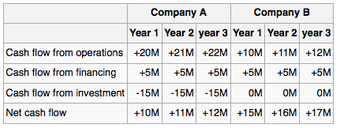
Cash Flow Comparison
Company B has a higher yearly cash flow. However, Company A is actually earning more cash by its core activities and has already spent 45 million dollars in long-term investments, of which revenues will show up after three years.
The analyst will continue breaking down the cash flow statement in this manner, diving deeper and deeper into the specific factors that affect the cash flow. For example, cash flows from operating activities provide feedback on a company’s ability to generate income from internal sources. Thus, these cash flows are essential to helping analysts assess the company’s ability to meet ongoing funding requirements, contribute to long-term projects and pay a dividend.
Analysis of cash flow from investing activities focuses on ratios when assessing a company’s ability to meet future expansion requirements. One such ratio is that for capital acquisitions:
Capital Acquisitions Ratio = cash flow from operating activities / cash paid for property, plant and equipment
This sphere of cash flows also can be used to assess how much cash is available after meeting direct shareholder obligations and capital expenditures necessary to maintain existing capacity.
Free Cash Flows
Free cash flow is a way of looking at a business’s cash flow to see what is available for distribution among all the securities holders of a corporate entity. This may be useful when analysts want to see how much cash can be extracted from a company without causing issues to its day to day operations.
The free cash flow can be calculated in a number of different ways depending on audience and what accounting information is available. A common definition is to take the earnings before interest and taxes, add any depreciation and amortization, then subtract any changes in working capital and capital expenditure.
The free cash flow takes into account the consumption of capital goods and the increases required in working capital. For example in a growing company with a 30 day collection period for receivables, a 30 day payment period for purchases, and a weekly payroll, it will require more and more working capital to finance its operations because of the time lag for receivables even though the total profits has increased.
Free cash flow measures the ease with which businesses can grow and pay dividends to shareholders. Even profitable businesses may have negative cash flows. Their requirement for increased financing will result in increased financing cost reducing future income.
2.6: Other Statements
2.6.1: The Statement of Equity
The statement of equity explains the changes of the company’s equity throughout the reporting period.
Learning Objective
Analyze a company’s statement of equity and retained earnings
Key Points
- The statement breaks down changes in the owners’ interest in the organization. Line items typically include profits or losses from operations, dividends paid, issue or redemption of stock, and any other items charged or credited to retained earnings.
- Owners’ equity = assets − liabilities.
- The statement of equity uses information from the income statement and provides information to the balance sheet.
- Ending retained earnings = beginning retained earnings − dividends paid + net income.
Key Term
- retained earnings
-
The portion of net income that is retained by the corporation rather than distributed to its owners as dividends.
The statement of equity (and similarly the equity statement, statement of owner’s equity for a single proprietorship, statement of partner’s equity for a partnership, and statement of retained earnings and stockholders’ equity for a corporation) are basic financial statements.
These statements explain the changes of the company’s equity throughout the reporting period. They break down changes in the owners’ interest in the organization, and in the application of retained profit or surplus from one accounting period to the next. Line items typically include profits or losses from operations, dividends paid, issue or redemption of stock, and any other items charged or credited to retained earnings.
The statements are expected by generally accepted accounting principles (GAAP) and explain the owners’ equity and retained earnings shown on the balance sheet, where: owners’ equity = assets − liabilities.
A retained earnings statement is required by the U.S. GAAP whenever comparative balance sheets and income statements are presented . It may appear in the balance sheet, in a combined income statement and changes in retained earnings statement, or as a separate schedule. Therefore, the statement of retained earnings uses information from the income statement and provides information to the balance sheet.

The Statement of Retained Earnings and Stockholders’ Equity
The statement of retained earnings uses information from the income statement and provides information to the balance sheet.
Retained earnings are part of the balance sheet under “stockholders equity (shareholders’ equity)” and is mostly affected by net income earned during a period of time by the company minus any dividends paid to the company’s owners and stockholders. The retained earnings account on the balance sheet is said to represent an “accumulation of earnings” since net profits and losses are added / subtracted from the account from period to period.
Retained earnings are part of the statement of changes in equity. The general equation can be expressed as following: ending retained earnings = beginning retained earnings − dividends paid + net income
2.6.2: Depreciation
Depreciation refers to the allocation of the cost of assets to periods in which the assets are used.
Learning Objective
Calculate depreciation expense using different methods
Key Points
- Depreciation refers to the allocation of the cost of assets to periods in which the assets are used (depreciation with the matching principle).
- Generally this involves four criteria: cost of the asset, expected salvage value (residual value of the asset), estimated useful life of the asset, and a method of apportioning the cost over such life.
- There are several methods for calculating depreciation, generally based on either the passage of time or the level of activity of the asset: straight-line depreciation, accelerated depreciation methods, activity depreciation methods, sum-of-years’ digits method, and units-of-production method.
Key Term
- salvage value
-
The estimated value of an asset at the end of its useful life.
Depreciation
Depreciation refers to two very different but related concepts: the decrease in value of assets (fair value depreciation) and the allocation of the cost of assets to periods in which the assets are used (depreciation with the matching principle). The former affects values of businesses and entities. The latter affects net income.
Generally the cost is allocated, as a depreciation expense, among the periods in which the asset is expected to be used. Such expense is recognized by businesses for financial reporting and tax purposes. Methods of computing depreciation may vary by asset for the same business. Several standard methods of computing depreciation expense may be used, such as fixed percentage, straight line, and declining balance methods. Depreciation expense generally begins when the asset is placed in service. Depreciation is generally recognized under historical cost systems of accounting. Generally this involves four criteria: cost of the asset, expected salvage value (residual value of the asset), estimated useful life of the asset, and a method of apportioning the cost over such life.
Calculating Depreciation
There are several methods for calculating depreciation, generally based on either the passage of time or the level of activity or use of the asset.
1. Straight-line depreciation is the simplest and most often used technique, in which the company estimates the salvage value of the asset at the end of the period during which it will be used to generate revenue (useful life). The company will then expense a portion of original cost in equal increments over that period. The salvage value (residual value or scrap value) is an estimate of the value of the asset at the time it will be sold or disposed of.

Depreciation
This is the formula used to calculate straight-line depreciation.
2. Depreciation methods that provide for a higher depreciation charge in the first year of an asset’s life and gradually decrease charges in subsequent years are called accelerated depreciation methods. This may be a more realistic reflection of an asset’s actual expected benefit from the use of the asset: many assets are most useful when they are new. One popular accelerated method is the declining-balance method. Under this method the book value is multiplied by a fixed rate. The most common rate used is double the straight-line rate: Annual Depreciation = Depreciation Rate * Book Value at Beginning of Year.
3. Activity depreciation methods are not based on time, but on a level of activity. This could be miles driven for a vehicle, or a cycle count for a machine. When the asset is acquired, its life is estimated in terms of this level of activity. Each year, the depreciation expense is then calculated by multiplying the rate by the actual activity level.
4. Sum-of-years’ digits is a depreciation method that results in a more accelerated write-off than straight line, but less than the declining-balance method. Under this method, annual depreciation is determined by multiplying the depreciable cost by a schedule of fractions.
- depreciable cost = original cost − salvage value
- book value = original cost − accumulated depreciation
5. Under the units-of-production method, the useful life of the asset is expressed in terms of the total number of units expected to be produced.

Depreciation
This is the units-of-production method for calculating depreciation.
2.6.3: Free Cash Flow
Free cash flow (FCF) is cash flow available for distribution among all the securities holders of an organization.
Learning Objective
Calculate free cash flow using all four methods.
Key Points
- There are four different methods for calculating free cash flows.
- Free cash flow measures the ease with which businesses can grow and pay dividends to shareholders.
- Net income and free cash flows are different. Some investors prefer using free cash flow instead of net income to measure a company’s financial performance because free cash flow is more difficult to manipulate than net income.
Key Terms
- net working capital
-
current assets minus current liabilities
- capital expenditure
-
Funds spent by a company to acquire or upgrade a long-term asset.
- amortization
-
The distribution of the cost of an intangible asset, such as an intellectual property right, over the projected useful life of the asset.
In corporate finance, free cash flow (FCF) is cash flow available for distribution among all the security holders of an organization. They include equity holders, debt holders, preferred stock holders, convertible security holders, and so on. There are four different methods for calculating free cash flows.
1. Free cash flows = EBIT x (1 – Tax rate) + Depreciation & Amortization – Changes in Working Capital – Capital Expenditure
2. Free cash flows = Net profit + Interest expense – Net Capital Expenditure (CAPEX) – Net change in Working Capital – Tax shield on Interest Expense
Where Net Capital Expenditure (CAPEX) = Capex – Depreciation & Amortization and Tax Shield = Net Interest Expense X Effective Tax Rate
3. When Profit after Tax and Debit/Equity ratio (d) is available,
Free cash flows = Profit after Tax – Changes in Capital Expenditure x (1-d) + Depreciation & Amortization x (1-d) – Changes in Working Capital x (1-d)
4. Cash flows from operations = Earnings before Interest and Tax x (1-Tax rate) + Depreciation & Amortization – Changes in Working Capital
Free cash flows = Cash flows from operations – Capital Expenditure “”
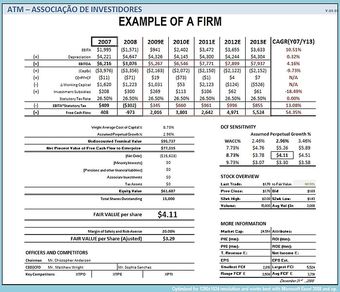
Free Cash Flow
An example of calculating free cash flow.
Free cash flow measures the ease with which businesses can grow and pay dividends to shareholders. Even profitable businesses may have negative cash flows. Their requirement for increased financing will result in increased financing cost reducing future income.
There are two differences between net income and free cash flow. The first is the accounting for the consumption of capital goods. The net income measure uses depreciation, while the free cash flow measure uses last period’s net capital purchases. The second difference is that the free cash flow measurement deducts increases in net working capital, where the net income approach does not. Some investors prefer using free cash flow instead of net income to measure a company’s financial performance because free cash flow is more difficult to manipulate than net income.
2.6.4: MVA and EVA
MVA = PV (EVAs); MVA is the difference between current market value and investors’ capital., and EVA is an estimate of a firm’s economic profit.
Learning Objective
Explain the calculation and results of a business’s MVA and EVA
Key Points
- Market Value Added (MVA) is the difference between the current market value of a firm and the capital contributed by investors.
- Economic Value Added or EVA, is an estimate of a firm’s economic profit – being the value created in excess of the required return of the company’s investors (being shareholders and debt holders).
- The firm’s market value added, or MVA, is the discounted sum (present value) of all future expected economic value added: MVA = Present Value of a series of EVA values.
Key Term
- NOPAT
-
NOPAT (net operating profit after tax) is profits derived from a company’s operations after cash taxes but before financing costs and non-cash bookkeeping entries. It is the total pool of profits available to provide a cash return to those who provide capital to the firm.
Market Value Added
Market Value Added (MVA) is the difference between the current market value of a firm and the capital contributed by investors.
If the MVA is positive, the firm has added value. If it is negative, the firm has deminished value. The amount of value added needs to be greater than the firm’s investors could have achieved investing in the market portfolio, adjusted for the leverage (beta coefficient) of the firm relative to the market. The formula for MVA is:

MVA
Calculation of MVA
where: MVA is market value added, V is the market value of the firm, including the value of the firm’s equity and debt, and K is the capital invested in the firm.
Economic Value Added
In corporate finance, Economic Value Added or EVA, is an estimate of a firm’s economic profit – being the value created in excess of the required return of the company’s investors (being shareholders and debt holders). Quite simply, EVA is the profit earned by the firm, less the cost of financing the firm’s capital. The idea is that value is created when the return on the firm’s economic capital employed is greater than the cost of that capital.
EVA is net operating profit after taxes (or NOPAT) less a capital charge, the latter being the product of the cost of capital and the economic capital.
The basic formula is: EVA = (r – c) * K = NOPAT – c * K
where r is the return on investment capital (ROIC); c is the weighted average of cost of capital (WACC); K is the economic capital employed; NOPAT is the net operating profit after tax.
The firm’s market value added, or MVA, is the discounted sum (present value) of all future expected economic value added: MVA = Present Value of a series of EVA values.

MVA and EVA
MVA is the present value of a series of EVA values.
More enlightening is that, since MVA = NPV of Free cash flow (FCF) it follows, therefore, that the NPV of FCF = PV of EVA since after all, EVA is simply the re-arrangement of the FCF formula.
Chapter 1: Introduction to the Field and Goals of Financial Management
1.1: Introducing Finance
1.1.1: Defining Finance
Finance is the study of fund management and asset allocation over time.
Learning Objective
Explain the importance of time to the discipline of finance
Key Points
- The two main drivers of finance are the time value of money and risk.
- Since the value of assets changes over time, finance seeks to ensure the change is beneficial for the organization or individual.
- Financial professionals generally operate in an environment of uncertainty where they must make forecasts about future events.
Key Terms
- debtor
-
A person or firm that owes money, one in debt, or one who owes a debt.
- asset
-
Something or someone of any value; any portion of one’s property or effects so considered.
- investment
-
A placement of capital in expectation of deriving income or profit from its use.
Overview
Finance is the study of fund management and asset allocation over time. Funds consist of money and other assets. There are many different types of finance, but all are fundamentally concerned with studying how best to allocate assets in different conditions over time.
Importance of Time
The underlying driver behind all of finance is time. There are two reasons why time is so important to finance:
- Time value of money: For a number of reasons, money today is worth more than the same amount of money in the future. For example, you would rather have $100 today than $100 in 10 years – the money is worth more to you now than it would be in the distant future. We will explore this concept in greater depth later on.
- Risk: Making an investment does not guarantee a return. When a bank makes a loan, they’re not sure the debtor will pay it back. There is a risk that the person will just take the money and run, the debtor will file for bankruptcy, or, for dozens of other reasons, the bank will not get the money they lent back.
The field of finance, however, embraces time. Finance says, “Since I know assets change value over time, how do I use that to cause my assets to change value in the direction I want? How do I manage assets so that they’re worth more in the future than they are today? “
Challenges in Finance
Figuring out what to do with assets is sometimes easy: all of the variables are known, and there is clearly an option that is better than all the others. However, most of the time, this is not the case. Finance generally operates with a lot of uncertainty. As a result, companies hire entire departments of people to help them figure out which option is best .

Walmart CFO
Charles Holley, the Chief Financial Officer (CFO) of Wal-Mart, is in charge of making sure all of Wal-Mart’s assets are allocated as optimally as possible.
1.1.2: Comparing the Fields of Finance, Economics, and Accounting
Finance, economics, and accounting are business subjects with many similarities and differences; each is a distinct field of study.
Learning Objective
Recognize how finance, economics and accounting overlap.
Key Points
- Finance is the study of how to optimally allocate assets. Finance is fundamentally a forward looking field, concerned with what an asset will be worth in the future.
- Economics is the social science that analyzes the production, distribution, and consumption of goods and services.
- Accounting is the process of communicating financial information about a business. Accounting is fundamentally a backward-looking field.
Key Term
- return
-
Gain or loss from an investment.
Finance, economics, and accounting are business subjects with many similarities and differences. While they influence each other, each is a distinct field of study.
Finance
Finance is the study of how to optimally allocate assets—how individuals and organizations should invest assets in order to get the highest possible return given changing conditions over time. Finance is fundamentally a forward looking field, concerned with what an asset will be worth in the future.
Economics
Economics is a social science that analyzes the production, distribution, and consumption of goods and services. It focuses on how economic agents (people, businesses, and government) interact and make decisions. Economics is fundamentally the study of cause and effect. It tries to figure out how one variable affects economic agents or the economy as a whole.
Accounting
Accounting focuses on communicating a businesses’ financial information. Accounting is fundamentally a backward-looking field, concerned with what has already happened financially and what position that leaves the company in today.
If accounting is called the language of business, then the financial statements that accountants prepare are the words . Statements are created under a standardized set of accounting laws, which allows one to easily compare and contrast companies. This indicates how financially healthy a company is.
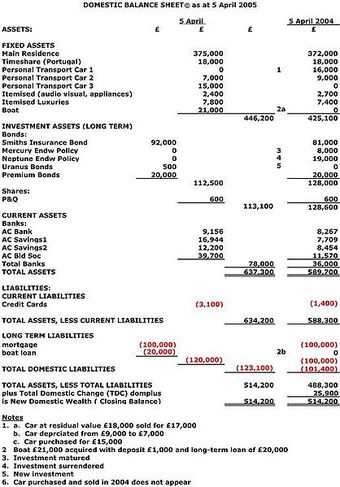
Balance Sheet
The balance sheet is one of the three main financial statements. The other two are the cash flow statement and the income statement.
Overlap
Finance, economics, and accounting overlap in a lot of areas. For example, an investor will use accounting to see whether a company has shown past financial success and to predict what the company will look like in the future. Part of that prediction incorporates economics. The investor wants to know what the overall economy will look like in the future and wants to know how the company will interact with its competitors. The investor can use finance to figure out what his or her investment will be worth in the future.
There are few strong delineators between finance, economics and accounting. All three fields intermingle and influence one another. It is almost impossible to have a strong grasp of one without at least a basic understanding of the other two.
1.1.3: Role of Finance in an Organization
The primary role of corporate finance is to determine how best to maximize shareholder value.
Learning Objective
Define the role of finance in an organization
Key Points
- Maximizing shareholder value can be done over the long-term or the short-term, so the job of the finance department is to determine how best to do both. Sometimes, the goals may appear to contradict each other.
- The finance department is devoted to the task of figuring out how to allocate assets for the overarching goal of maximizing shareholder value. They must ensure that the right assets are in the right place at the right time.
- The finance department must also manage the company’s liabilities so that all projects are financed in an optimal way without taking on too much risk.
Key Terms
- liability
-
An obligation, debt or responsibility owed to someone.
- asset
-
Something or someone of any value; any portion of one’s property or effects so considered.
- shareholder
-
One who owns shares of stock.
Corporate finance is the area of finance dealing with monetary decisions that business enterprises make. When finance is talked about in the context of business decisions, it is called corporate finance (technically, corporate finance deals only with corporations, while managerial finance deals with all types of companies, but we will use the terms interchangeably). There are other branches of finance such as personal finance (individuals taking care of their money) and public finance (the finances of the government).
The primary goal of corporate finance is to maximize shareholder value. Maximizing shareholder value can be done over the long-term or the short-term, so the job of the finance department is to determine how best to do both. Sometimes, the goals may appear to be in competition with one another. For example, a company can choose to pay dividends (a small payment to each person who owns a stock of a company), which increases short-term shareholder wealth. However, paying dividends means that the money is not being invested in long-term investments, which may cause the stock price to increase more in the future, and thereby increasing long-term shareholder wealth.
The technique behind maximizing shareholder value is the management of assets. This means that the finance department figures out how to best invest its money.
For example, a company could have two proposals from the R&D department to develop different products, but only enough money to fund one . The finance department will project out the future revenues and costs of each product and figure out which one, if either, is worth the money.

iPod Touch
Apple used financial analysis to decide to fund the development of the iPod. The money allocated development could not be used for another project, but the finance department determined the iPod was the best option.
Also, the finance department will determine when a company should take on a liability. For example, suppose both projects are absolute home-runs, but the company still only has enough money to fund one. The finance department will figure out if the company should borrow money so that it can fund both.
The role of finance in an organization is to make sure that money is at the right place at the right time. A company wants to have enough money to pay its bills, but also wants to invest so that it can grow in the future. The finance department is devoted to the task of figuring out how to allocate assets to do so, for the overarching goal of maximizing shareholder value.
1.1.4: Types of Financial Decisions: Investment and Financing
Investment and financing decisions boil down to how to spend money and how to borrow money.
Learning Objective
Identify the criteria a corporation must use when making a financial decision
Key Points
- The primary goal of both investment and financing decisions is to maximize shareholder value.
- Investment decisions revolve around how to best allocate capital to maximize their value.
- Financing decisions revolve around how to pay for investments and expenses. Companies can use existing capital, borrow, or sell equity.
Key Terms
- equity
-
Ownership, especially in terms of net monetary value, of a business.
- expected return
-
Considering the magnitude and likelihood of exogenous events, the yield that an investor predicts s/he will earn on average.
- financing
-
A transaction that provides funds for a business.
There are two fundamental types of financial decisions that the finance team needs to make in a business: investment and financing. The two decisions boil down to how to spend money and how to borrow money. Recall that the overall goal of financial decisions is to maximize shareholder value, so every decision must be put in that context.
Investment
An investment decision revolves around spending capital on assets that will yield the highest return for the company over a desired time period. In other words, the decision is about what to buy so that the company will gain the most value.
To do so, the company needs to find a balance between its short-term and long-term goals. In the very short-term, a company needs money to pay its bills, but keeping all of its cash means that it isn’t investing in things that will help it grow in the future. On the other end of the spectrum is a purely long-term view. A company that invests all of its money will maximize its long-term growth prospects, but if it doesn’t hold enough cash, it can’t pay its bills and will go out of business soon. Companies thus need to find the right mix between long-term and short-term investment.
The investment decision also concerns what specific investments to make. Since there is no guarantee of a return for most investments, the finance department must determine an expected return. This return is not guaranteed, but is the average return on an investment if it were to be made many times.
The investments must meet three main criteria:
- It must maximize the value of the firm, after considering the amount of risk the company is comfortable with (risk aversion).
- It must be financed appropriately (we will talk more about this shortly).
- If there is no investment opportunity that fills (1) and (2), the cash must be returned to shareholder in order to maximize shareholder value.
Financing
All functions of a company need to be paid for one way or another. It is up to the finance department to figure out how to pay for them through the process of financing.
There are two ways to finance an investment: using a company’s own money or by raising money from external funders. Each has its advantages and disadvantages.
There are two ways to raise money from external funders: by taking on debt or selling equity. Taking on debt is the same as taking on a loan. The loan has to be paid back with interest, which is the cost of borrowing. Selling equity is essentially selling part of your company . When a company goes public, for example, they decide to sell their company to the public instead of to private investors. Going public entails selling stocks which represent owning a small part of the company. The company is selling itself to the public in return for money.

NYSE
If a company chooses to finance an investment by selling equity, they may issue stocks on an exchange like the New York Stock Exchange
Every investment can be financed through company money or from external funders. It is the financing decision process that determines the optimal way to finance the investment.
1.1.5: Functions of Corporate Finance
Corporate finance utilizes tools and analysis to make sound financial business decisions.
Learning Objective
Describe the role of finance in corporation
Key Points
- The finance group is in charge of budgeting. It will look for the optimal allocation of assets across all business functions.
- Corporate finance decides how best to finance projects. The department can either use existing internal funds, borrow money, or sell equity.
- The finance group must balance both short- and long-term company goals, though the overarching goal is to maximize shareholder value.
Key Terms
- investment
-
A placement of capital in expectation of deriving income or profit from its use.
- finance
-
To provide or obtain funding for a transaction or undertaking; to back; to support.
Corporate finance deals with monetary decisions that business enterprises make and the tools and analysis utilized to make the decisions. Corporate finance is concerned primarily with making investment and financing decisions; that is, making sure that money is being used in the best way.
The corporate finance department of a company is in charge of budgeting. Management must allocate limited resources between competing opportunities; since a dollar cannot be used for more than one project at once, it is a challenge to determine how much money should be allocated to each part of the business.
In determining how to allocate money, the finance group must also figure out where the money will be best utilized. This requires valuing projects and business functions. A large element of finance is deciding how exactly to value a project. There are a number of variables – inflation, expected revenues, expected costs, length of time required – that are all incorporated into the valuation process. Finding the true value of a project is often wrought with uncertainty, but without an accurate valuation, a company may allocate its resources sub-optimally.
The corporate finance department must also determine how to finance projects. A company can finance a project by using either internal funds (money the company already has), borrowing, or selling equity. Each option carries a certain cost that can be quantified. It is the job of the finance department to make sure that the overall cost isn’t too high and that the company has an optimal mix of all three strategies.
One public job function of corporate finance is determining whether or not the company pays a dividend, and if so, how much. The company has a responsibility to maximize shareholder value, but that can be achieved in multiple ways. Paying a dividend puts cash directly in the hands of shareholders, increasing shareholder value. However, paying a dividend means that money is not being reinvested in the company. If a company doesn’t pay a dividend and instead chooses to reinvest the money, the value of the company will presumably increase, in turn increasing shareholder value. The finance department determines which option maximizes shareholder value.
Lastly, the finance department must also ensure that there is a good balance between long- and short-term goals. The company must have enough assets to cover short-term costs, referred to as working capital management, and enough invested to ensure the company has long-term growth .

Factory
Purchasing new machinery requires a valuation of all equipment, an accurate idea of the total cost over time, and a way to finance the purchase while leaving enough cash for other upcoming costs.
1.1.6: Overview of the Role of Financial Manager
The financial manager is responsible for budgeting, projecting cash flows, and determining how to invest and finance projects.
Learning Objective
Describe the role and skills of a financial manager
Key Points
- The finance manager is responsible for knowing how much the product is expected to cost and how much revenue it is expected to earn so that s/he can invest the appropriate amount in the product.
- The finance manager uses a number of tools, such as setting the cost of capital (the cost of money over time, which will be explored in further depth later on) to determine the cost of financing.
- The financial manager must not just be an expert at financial projections; s/he also must have a grasp of the accounting systems in place and the strategy of the business over the coming years.
- The head of the financial department is the chief financial officer (CFO) who is responsible for all financial decisions and reporting done in the company.
Key Term
- capital
-
Money and wealth; the means to acquire goods and services, especially in a non-barter system.
The Role of the Financial Manager
The role of a financial manager is a complex one, requiring both an understanding of how the business functions as a whole and specialized financial knowledge. The head of the financial operations is called the chief financial officer (CFO).
The structure of the company varies, but a financial manager is responsible for the same general things across the board. The manager is responsible for managing the budget. This involves allocating money to different projects and segments so that the business can continue operating, but the best projects get the necessary funding.
The manager is responsible for figuring out the financial projections for the business. The development of a new product, for example, requires an investment of capital over time. The finance manager is responsible for knowing how much the product is expected to cost and how much revenue it is expected to earn so that s/he can invest the appropriate amount in the product. This is a lot tougher than it sounds because there is no accurate financial data for the future. The finance manager will use data analyses and educated guesses to approximate the value, but it’s extremely rare that s/he can be 100% sure of the future cash flows.
Figuring out the value of an operation is one thing, but it is another thing to figure out if it’s worth financing. There is a cost to investing money, either the opportunity cost of not investing it elsewhere, the cost of borrowing money, or the cost of selling equity. The finance manager uses a number of tools, such as setting the cost of capital (the cost of money over time, which will be explored in further depth later on) to determine the cost of financing.
At the same time that this is going on, the financial manager must also ensure that the business has enough cash to pay upcoming financial obligations without hoarding assets that could otherwise be invested. This is a delicate dance between short-term and long-term responsibilities.
The CFO is the head of the financial department and is responsible for all of the same things as his/her subordinates, but is also the person who has to sign off that all of the company’s financial statements are accurate. S/he is also responsible for financial planning and record-keeping, as well as financial reporting to higher management.
The financial manager is not just an expert at financial projections, s/he must also have a grasp of the accounting systems in place and the strategy of the business over the coming years .

Collaboration
The finance manager must collaborate across business functions in order to determine how to best allocate and manage assets.
1.1.7: Reasons to Study Finance
Finance is relevant to all business functions, the macroeconomy, and personal finances.
Learning Objective
List the reasons why a person would want to study finance
Key Points
- Finance plays an involved role in the health of the overall economy, which impacts everyone, regardless of whether or not they have studied finance.
- Like companies, individuals are faced with investment and financing decisions. Having a firm grasp of finance will help individuals make those decisions.
- All businesses functions deal with finance because they need to be able to make the financial argument for the funding of their projects and to manage their budgets.
Key Term
- leverage
-
The use of borrowed funds with a contractually determined return to increase the ability of a business to invest and earn an expected higher return (usually at high risk).
The study of finance often feels a lot narrower than it really is. There is a lot of talk of issuing bonds or pricing projects which belies how relevant finance is to everyday life, regardless of whether or not you have any desire of working in finance.
Understanding the Economic Environment
Finance plays an involved role in the health of the overall economy, which impacts everyone, regardless of whether or not they have studied finance. The field of finance explains why the 2008 recession occurred; it is the reason why people care about how the stock market is doing each day ; and it articulates why businesses and governments make some of the decisions they do.
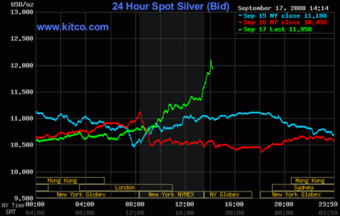
Random Walk
Stock market cannot be predicted.
Finance plays a role in many of the stories in the news every day, which means that those who understand finance have a better grasp on how the events of the world affect them.
Personal Finances
Each person will also have to manage his or her own personal finances. Like corporations, individuals are faced with investment and financing decisions. In order to invest, individuals must be able to do the same projections and valuations as companies in order to determine the best investment for their needs. Individuals cannot sell equity like corporations, but they can choose to either dip into their savings or take out loans. Many take on debt in the form of student loans, mortgages, or through their credit cards; being able to properly compare options to leverage is just as important for individuals as it is for companies.
Application to Business
Of course, finance is an important field of study for those who have a desire of working in finance or accounting. Finance is heavily used in jobs ranging from investment banker to CFO to venture capitalist.
However, finance is not segmented from the other functions in business. Every job from marketing to engineering has to be able to manage a budget and make a business case that it should get funding for a project.
This is especially true higher up in the organizational hierarchy: managers, directors, and vice presidents need to be able to articulate why their departments should get financial support from the company.
Finance is a field of both hard analytical skill and personal judgement. There are set processes and theories for determining which financial option is best, but in the real world, it is rare to have all of the information needed to be absolutely certain about what to do. Finance develops strong analytical skills, but also the degree of finesse required to operate in an environment of uncertainty.
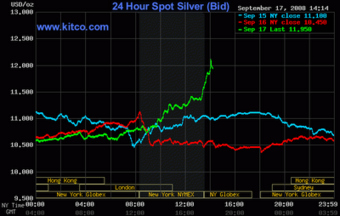
Silver Bid Chart
Finance helps explain what trends in silver bids mean, but more importantly, why people care about them (even those not trading silver).
1.2: Goals of Financial Management
1.2.1: Valuation
Valuation, a goal of financial management, often relies on fundamental analysis of financial statements.
Learning Objective
Describe the valuation process
Key Points
- In finance, valuation is the process of estimating what something is worth. Valuation is used to for a variety of purposes: the purchase or sale of a business, appraisal to resolve disputes, managerial decisions of how to allocate business resources, and many other business and legal purposes.
- Valuation often relies on fundamental financial statement analysis using tools such as discounted cash flow or net present value. As such, an accurate valuation, especially of privately owned companies, largely depends on the reliability of the firm’s historic financial information.
- Not only do managers want to keep reliable financial statements so that they can know the value of their own businesses, but they also want to manage finances well to enhance the value of their businesses to potential buyers, creditors, or investors.
Key Terms
- financial statement
-
A formal record of all relevant financial information of a business, person, or other entity, presented in a structured and standardized manner to allow easy understanding.
- fundamental analysis
-
An analysis of a business with the goal of financial projections in terms of income statement, financial statements and health, management and competitive advantages, and competitors and markets.
- valuation
-
The process of estimating the market value of a financial asset or liability.
Introduction
Financial management focuses on the practical significance of financial numbers. It asks: what do the figures mean? Sound financial management creates value and organizational agility through the allocation of scarce resources among competing business opportunities. It is an aid to the implementation and monitoring of business strategies and helps achieve business objectives. There are several goals of financial management, one of which is valuation .

Valuation
Valuation is, for some, one of the goals of financial management.
Valuation
In finance, valuation is the process of estimating what something is worth. Valuation often relies on fundamental analysis (of financial statements) of the project, business, or firm, using tools such as discounted cash flow or net present value. As such, an accurate valuation, especially of privately owned companies, largely depends on the reliability of the firm’s historic financial information. Items that are usually valued are a financial asset or liability. Valuations can be done on assets (for example, investments in marketable securities such as stocks, options, business enterprises, or intangible assets such as patents and trademarks) or on liabilities (e.g., bonds issued by a company).
Valuation is used to determine the price financial market participants are willing to pay or receive to buy or sell a business. In addition to estimating the selling price of a business, the same valuation tools are often used by business appraisers to resolve disputes related to estate and gift taxation, divorce litigation, allocate business purchase price among business assets, establishing a formula for estimating the value of partners’ ownership interest for buy-sell agreements, and many other business and legal purposes. Therefore, not only do managers want to keep reliable financial statements so that they can know the value of their own businesses, but they also want to manage finances well to enhance the value of their businesses to potential buyers, creditors, or investors.
1.2.2: Maximizing Shareholder and Market Value
A goal of financial management can be to maximize shareholder wealth by paying dividends and/or causing the market value to increase.
Learning Objective
Describe the relationship between shareholder value and market value
Key Points
- One interpretation of proper financial management is that the agents are oriented toward the benefit of the principals, shareholders, and in increasing their wealth by paying dividends and/or causing the stock price or market value to increase.
- The idea of maximizing market value is related to the idea of maximizing shareholder value, as market value is the price at which an asset would trade in a competitive auction setting; for example, returning value to the shareholders if they decide to sell shares or if the firm decides to sell.
- There are many different models of corporate governance around the world. These differ according to the variety of capitalism in which they are embedded. The Anglo-American (US and UK) “model” tends to emphasize the interests of shareholders.
- The sole concentration on shareholder value has been criticized, for concern that a management decision can maximize shareholder value while lowering the welfare of other stakeholders. Additionally, short-term focus on shareholder value can be detrimental to long-term shareholder value.
Key Terms
- shareholder
-
One who owns shares of stock.
- market value
-
The total value of the company as traded in the market. Calculated by multiplying the number of shares outstanding by the price per share.
- principal
-
One who directs another (the agent) to act on one′s behalf.
Introduction
Financial management is concerned with financial matters for the practical significance of the numbers, asking: what do the figures mean? There are several goals of financial management, one of which is maximizing shareholder and market value .

Money to Shareholders
Maximizing shareholder and market value is, for some, one of the goals of financial management.
Maximizing Shareholder Value
The idea of maximizing shareholder value comes from interpretations of the role of corporate governance. Corporate governance involves regulatory and market mechanisms and the roles and relationships between a company’s management, its board, its shareholders, other stakeholders, and the goals by which the corporation is governed.
In large firms where there is a separation of ownership and management and no controlling shareholder, the principal–agent issue arises between upper-management (the “agent”) and shareholders (the “principals”). The danger arises that, rather than overseeing management on behalf of shareholders, the board of directors may become insulated from shareholders and beholden to management.
Thus, one interpretation of proper financial management is that the agents are oriented toward the benefit of the principals – shareholders – in increasing their wealth by paying dividends and/or causing the stock price or market value to increase.
Maximizing Market Value
The idea of maximizing market value is related to the idea of maximizing shareholder value, as market value is the price at which an asset would trade in a competitive auction setting; for example, returning value to the shareholders if they decide to sell shares or if the firm decides to sell.
There are many different models of corporate governance around the world. These differ according to the variety of capitalism in which they are embedded. The Anglo-American (US and UK) “model” tends to emphasize the interests of shareholders.
The sole concentration on shareholder value has been widely criticized, particularly after the late-2000s financial crisis, where attention has risen to the concern that a management decision can maximize shareholder value while lowering the welfare of other stakeholders. Additionally, short-term focus on shareholder value can be detrimental to long-term shareholder value.
1.2.3: Maximizing Value Without Harming Stakeholders
A goal of financial management can be to maximize value without harming stakeholders, the diverse set of parties affected by the business.
Learning Objective
Explain how maximizing value for shareholders can harm the business’s other stakeholders
Key Points
- Stakeholders are those who are affected by an organization’s activities. The stakeholders can be internal or external to the firm and some will be involved directly in economic transactions with the business, while others will not.
- Owners, employees, customers, suppliers, trade unions, the government, local communities, and the environment can be considered stakeholders. Because of the potential breadth of the term, there are different views on whom to include in stakeholder considerations.
- Debate is ongoing about whether firms should be managed for shareholder value maximization or also with stakeholders in mind. While the Anglo-American “model” tends to emphasize shareholders, some European countries formally recognize other stakeholders in corporate governance decisions.
- Some proponents of stakeholder considerations argue that attention to other stakeholders is intimitely intertwined with market value and can enhance outcomes for all stakeholders. Others argue that value should be maximized without harming stakeholders.
Key Terms
- market value
-
The total value of the company as traded in the market. Calculated by multiplying the number of shares outstanding by the price per share.
- stakeholder
-
A person or organisation with a legitimate interest in a given situation, action or enterprise.
Introduction
Professionals in financial management are concerned with the practical significance of the numbers that appear in financial documents. Given a set of information about certain financial behavior, they ask, what do the figures mean? There are several goals of financial management, one of which is maximizing value without harming shareholders.
The Stakeholder Concept
The stakeholder concept is associated with the concept of corporate governance. Corporate governance involves regulatory and market mechanisms and the relationships that exist between a company’s management, its board, its shareholders, other stakeholders, and the goals for which the corporation is governed. Stakeholders are those who are affected by an organization’s activities. The stakeholders can be internal, like owners or employees. They can also be external, like customers, suppliers, the government, local communities, and the environment . Some stakeholders are involved directly in economic transactions with the business. Others are either affected by, or able to affect, an organization’s actions without directly engaging in an economic exchange with the business (for example, trade unions, communities, activist groups, etc). Because of the breadth of the term stakeholder, there are different views as to whom should be included in stakeholder considerations.

Environment as stakeholder
The environment can be seen as a stakeholder. Maximizing value without harming stakeholders is, for some, one of the goals of financial management.
Stakeholders vs. Shareholders
In the field of corporate governance and corporate responsibility, a major debate is currently occurring about whether a firm or company should make decisions chiefly to maximize value for shareholders, or if a company has obligations to other types of stakeholders. This increased after the financial crisis of the late 2000s, when concerns deepened about the potential of companies to lower the welfare of other stakeholders while maximizing their shareholder value. While the Anglo-American (US and UK) business “model” tends to emphasize the interests of shareholders over other implicated parties, some European countries formally recognize other stakeholders in corporate governance decisions.
Some people who argue that businesses should consider other stakeholders, like the government or the environment, argue that an attention to these types of stakeholders is intimately intwined with market value. They also argue that a holistic view can enhance general outcomes for all the stakeholders that are involved. Still others argue that stakeholders, even if they are not considered in business decisions, should at the very least not suffer harm, and that businesses should maximize value only if they can do so without generating harm.
1.3: Trends and Issues in Finance
1.3.1: Current Issues in Finance
Current issues in finance include the economic and regulatory impacts of the financial crisis and the growth of new types of finance.
Learning Objective
Discuss events and trends in finance during the early 21st century
Key Points
- The financial crisis of 2007–2008 caused the near-total collapse of many large financial institutions, the bailout of banks by national governments, and downturns in stock markets around the world.
- Following the financial crisis, various regulatory reforms were passed in the United States, and European regulators introduced Basel III regulations for banks.
- There are various growing areas of finance, including microfinance, crowdfunding, algorithmic trading, and impact investing.
Key Terms
- bailout
-
a rescue, especially a financial rescue
- crowdfunding
-
funding by many individuals pooling their money together for a common goal, usually via the Internet
Financial crisis and regulation
The financial crisis of 2007–2008 caused the near-total collapse of many large financial institutions, the bailout of banks by national governments, and downturns in stock markets around the world. The financial institution crisis hit its peak in late 2008. Several major institutions failed, were acquired under duress, or were subject to government takeover, including Lehman Brothers, Citigroup, Fannie Mae, and Freddie Mac, among several others.The crisis rapidly developed and spread into global economic shock, resulting in a number of European bank failures, economic crises in Iceland, declines in various stock indexes, and large reductions in the market value of equities and commodities. A currency crisis followed, with investors transferring vast capital resources into stronger currencies. In many areas in the United States, the housing market also suffered, resulting in significant numbers of foreclosures. The crisis played a significant role in the failure of key businesses, declines in consumer wealth, prolonged unemployment, and a downturn in economic activity in the United States. It also led to a global recession and a sovereign debt crisis in Europe.
Critics of the financial crisis have argued that the regulatory framework did not keep pace with rapid innovation in financial markets and have asked for increased regulation and enforcement. Various regulatory reforms have been passed in the United States, and European regulators introduced Basel III regulations for banks.
Growing areas of business
Microfinance is the provision of a wide range of financial services, including savings accounts, to the poor. Microcredit is a part of microfinance and involves the extension of very small loans (microloans) to impoverished borrowers, often with the goal of supporting entrepreneurship and/or alleviating poverty.
Peer-to-peer lending over the Internet is another growing development in the financial sector, to which the principles of microcredit have also been applied in attempting to address poverty as well as various non-poverty-related issues. Such efforts include crowdfunding , a term describing the collective effort of individuals who network and pool their resources to support charities initiated by other people or organizations. The rules for crowdfunding are still being developed, and the Securities Exchange Commission has yet to set rules in place for equity crowdfunding campaigns involving unaccredited investors for private companies.

Crowds
One of the newer trends in finance is “crowdfunding. “
Algorithmic trading, now widely used by pension funds, mutual funds, and other institutional traders, is the use of electronic platforms to enter trading orders with an algorithm that calculates aspects such as timing, price, and quantity. Proponents have argued that algorithmic trading substantially improves market liquidity,while critics argue that this type of trading is opaque– a “black box”– and may contribute substantially to market volatility.
The growing field of impact investing refers to investments made based on the practice of assessing not only the financial return on an investment, but also its social and environmental impacts.
1.3.2: Employment in Finance
The financial sector is a large field offering many different types of employment for a broad range of organizations that manage money.
Learning Objective
Identify jobs that require a background in finance
Key Points
- The financial sector is a large field offering many different types of employment. Financial services encompasses a broad range of organizations that manage money, including banks, credit unions, credit card companies, insurers, stock brokerages, and investment funds.
- Financial analysts may work for government investment funds, mutual fund companies, hedge funds, private equity investors, and investment banks. Similarly, credit analysts work in a variety of institutions to assess the creditworthiness of firms, governments, or individuals for loans.
- In insurance, there are insurance brokers and underwriters as well as actuaries and a host of other positions such as insurance claims investigators and agents. Intermediaries exist not just in the insurance business but also as stockbrokers that assist investors in buying and selling shares.
- Finance professionals may also work in public finance, for local or national governments, or in corporate finance. Growth in microfinance and microcredit has also opened up employment opportunities in small-unit finance both in the US and abroad.
- Sophisticated mathematical and technological developments have also advanced the field of quantitative analysis for those who work in investment management, risk management, derivatives pricing, algorithmic trading, and other area that require the application of mathematics in finance.
- Financial employees can come from a variety of backgrounds. Many financial analysis and management positions require some kind of training in finance, accounting, economics, mathematics, engineering, or another quantitative field.
Key Terms
- credit
-
A privilege of delayed payment extended to a buyer or borrower on the seller’s or lender’s belief that what is given will be repaid.
- underwriter
-
An entity which markets newly issued securities
- bank
-
An institution where one can place and borrow money and take care of financial affairs.
The financial sector is a large field offering many different types of employment. Financial services encompasses a broad range of organizations that manage money, including banks, credit unions, credit card companies, insurers, consumer finance companies, stock brokerages, investment funds, some government sponsored enterprises, and other financial institutions, including peer-to-peer lending platforms.
In banking, employees may serve the range of roles needed to run banks, from tellers to financial planners and underwriters to wealth managers. Workers may be employed in a variety of functions by credit card issuers, such as customer service, foreign exchange service, high-profile trading, and airport currency exchangers. Financial analysts may work for government investment funds, mutual fund companies, hedge funds, private equity investors, and investment banks. Credit analysts work in a variety of institutions to assess the creditworthiness of firms, governments, or individuals for loans. In insurance, there are insurance brokers and underwriters as well as actuaries and a host of other positions such as insurance claims investigators and agents.
Intermediaries exist not just in the insurance business. Stockbrokers, for instance, assist investors in buying and selling shares. There are also investors called venture capitalists and angel investors. Finance professionals may also work in public finance, for local or national governments, or in corporate finance.
Growth in microfinance and microcredit has also opened up employment opportunities in finance both in the US and abroad . Sophisticated mathematical and technological developments have also advanced the field of quantitative analysis for those who work in investment management, risk management, derivatives pricing, algorithmic trading, and other areas that require the application of mathematics in finance.

Muhammad Yunus
Muhammad Yunus is a banker who grew a field in microcredit and microfinance, opening up new types of financial employment.
Financial employees can come from a variety of backgrounds. Many financial analysis and management positions require some kind of training in finance, accounting, economics, mathematics, engineering, or another quantitative field. There are Masters degrees in Finance and Business as well as certifications such as the widely recognized Chartered Financial Analyst certification and accountancy qualifications such as the Certified Public Accountant.
1.4: Ethics: An Overview
1.4.1: Defining Ethics
Ethics are the set of moral principles that guide a person’s behavior.
Learning Objective
Define ethics and how it applies to organizations
Key Points
- Ethical behavior is based on written and unwritten codes of principles and values held in society.
- Ethics reflect beliefs about what is right, what is wrong, what is just, what is unjust, what is good, and what is bad in terms of human behavior.
- Ethical principles and values serve as a guide to behavior on a personal level, within professions, and at the organizational level.
Key Terms
- behavior
-
The way a living creature acts.
- ethics
-
The study of principles relating to right and wrong conduct.
- values
-
A collection of guiding principles; what one deems to be correct, important, and desirable in life, especially regarding personal conduct.
Ethics are the set of moral principles that guide a person’s behavior. These morals are shaped by social norms, cultural practices, and religious influences. Ethics reflect beliefs about what is right, what is wrong, what is just, what is unjust, what is good, and what is bad in terms of human behavior. They serve as a compass to direct how people should behave toward each other, understand and fulfill their obligations to society, and live their lives.
While ethical beliefs are held by individuals, they can also be reflected in the values, practices, and policies that shape the choices made by decision makers on behalf of their organizations. The phrases business ethics and corporate ethics are often used to describe the application of ethical values to business activities. Ethics applies to all aspects of conduct and is relevant to the actions of individuals, groups, and organizations.
In addition to individual ethics and corporate ethics there are professional ethics. Professionals such as managers, lawyers, and accountants are individuals who exercise specialized knowledge and skills when providing services to customers or to the public. By virtue of their profession, they have obligations to those they serve. For example, lawyers must hold client conversations confidential and accountants must display the highest levels of honest and integrity in their record keeping and financial analysis. Professional organizations, such as the American Medical Association, and licensing authorities, such as state governments, set and enforce ethical standards.
Example
The concept of corporate social responsibility emphasizes ethical behavior in that it requires organizations to understand, identify, and eliminate unethical economic, environmental, and social behaviors.
1.4.2: Ethics Training
Moral reasoning is the process in which an individual tries to determine what is right and what is wrong.
Learning Objective
Explain the role of ethical moral reasoning in the business environment
Key Points
- There are four components of moral behavior: moral sensitivity, moral judgment, moral motivation, and moral character.
- To make moral assessments, one must first know what an action is intended to accomplish and what its possible consequences will be on others.
- Studies have uncovered four skill sets that play a decisive role in the exercise of moral expertise: moral imagination, moral creativity, reasonableness, and perseverance.
Key Terms
- goodwill
-
The ability of an individual or business to exert influence within a community, club, market, or another type of group, without having to resort to the use of an asset (such as money or property).
- ethics
-
The study of principles relating to right and wrong conduct.
Moral reasoning is the process in which an individual tries to determine the difference between what is right and what is wrong in a personal situation by using logic. To make such an assessment, one must first know what an action is intended to accomplish and what its possible consequences will be on others. People use moral reasoning in an attempt to do the right thing. People are frequently faced with moral choices, such as whether to lie to avoid hurting someone’s feelings, or whether to take an action that will benefit some while harming others. Such judgements are made by considering the objective and the likely consequences of an action. Moral reasoning is the consideration of the factors relevant to making these types of assessments.
According to consultant Lynn W. Swaner, moral behavior has four components:
- Moral sensitivity, which is “the ability to see an ethical dilemma, including how our actions will affect others.”
- Moral judgment, which is “the ability to reason correctly about what ‘ought’ to be done in a specific situation.”
- Moral motivation, which is “a personal commitment to moral action, accepting responsibility for the outcome.”
- Moral character, which is a “courageous persistence in spite of fatigue or temptations to take the easy way out.”
The ability to think through moral issues and dilemmas, then, requires an awareness of a set of moral and ethical values; the capacity to think objectively and rationally about what may be an emotional issue; the willingness to take a stand for what is right, even in the face of opposition; and the fortitude and resilience to maintain one’s ethical and moral standards.
Realizing good conduct, being an effective moral agent, and bringing values into one’s work, all require skills in addition to a moral inclination. Studies have uncovered four skill sets that play a decisive role in the exercise of moral expertise.
- Moral imagination: The ability to see the situation through the eyes of others. Moral imagination achieves a balance between becoming lost in the perspectives of others and failing to leave one’s own perspective. Adam Smith terms this balance “proportionality,” which we can achieve in empathy.
- Moral creativity: Moral creativity is closely related to moral imagination, but it centers on the ability to frame a situation in different ways.
- Reasonableness: Reasonableness balances openness to the views of others with commitment to moral values and other important goals. That is, a reasonable person is open, but not to the extent where he is willing to believe just anything and/or fails to keep fundamental commitments.
- Perseverance: Perseverance is the ability to decide on a moral plan of action and then to adapt to any barriers that arise in order to continue working toward that goal.
Example
William LeMesseur designed the Citicorp Building in New York. When a student identified a critical design flaw in the building during a routine class exercise, LeMesseur responded not by shooting the messenger but by developing an intricate and effective plan for correcting the problem before it resulted in drastic real-world consequences.
1.4.3: Culture and Ethics
Culture reflects the moral values and ethical norms governing how people should behave and interact with others.
Learning Objective
Explain the role of culture in shaping moral and ethical behavior
Key Points
- Culture refers to the outlook, attitudes, values, goals, and practices shared by a group, organization, or society.
- Interpretation of what is moral is influenced by cultural norms, and different cultures can have different beliefs about what is right and wrong.
- According to the theory of cultural relativism, there is no singular truth on which to base ethical or moral behavior, as our interpretations of truths are influenced by our own culture.
Key Terms
- norms
-
Rules or laws that govern a group’s or a society’s behaviors.
- moral relativism
-
Refers to any of several philosophical positions concerned with the differences in moral judgments among different people and across different cultures.
- ethnocentric
-
Of the idea or belief that one’s own culture is more important than, or superior to, other cultures.
Culture describes a collective way of life, or way of doing things. It is the sum of attitudes, values, goals, and practices shared by individuals in a group, organization, or society. Cultures vary over time periods, between countries and geographic regions, and among groups and organizations. Culture reflects the moral and ethical beliefs and standards that speak to how people should behave and interact with others.

Cultural map of the world
This diagram attempts to plot different countries by the importance of different types of values. One axis represents traditional values to secular-rational values, while the other axis accounts for survival values and self-expression values. Different groups of countries can be grouped into certain categories, such as Catholic Europe, English speaking, and Ex-Communist.
Cultural norms are the shared, sanctioned, and integrated systems of beliefs and practices that are passed down through generations and characterize a cultural group. Norms cultivate reliable guidelines for daily living and contribute to the health and well-being of a culture. They act as prescriptions for correct and moral behavior, lend meaning and coherence to life, and provide a means of achieving a sense of integrity, safety, and belonging. These normative beliefs, together with related cultural values and rituals, impose a sense of order and control on aspects of life that might otherwise appear chaotic or unpredictable.
This is where culture intersects with ethics. Since interpretations of what is moral are influenced by cultural norms, the possibility exists that what is ethical to one group will not be considered so by someone living in a different culture. According to cultural relativists this means that there is no singular truth on which to base ethical or moral behavior for all time and geographic space, as our interpretations of truths are influenced by our own culture. This approach is in contrast to universalism, which holds the position that moral values are the same for everyone. Cultural relativists consider this to be an ethnocentric view, as the universal set of values proposed by universalists are based on their set of values. Cultural relativism is also considered more tolerant than universalism because, if there is no basis for making moral judgments between cultures, then cultures have to be tolerant of each other.
Example
The French and Americans have different views on whistle-blowing. Compared to the French, American companies consider it to be a natural part of business. So natural, in fact, that they set up anonymous hotlines. The French, on the other hand, tend to view whistle-blowing as undermining solidarity among coworkers.
1.4.4: The Manager’s Role in Ethical Conduct
Employees can more easily make ethical decisions that promote a company’s values when their personal values match the company’s norms.
Learning Objective
Explain the role of personal values in influencing behavior in organizations
Key Points
- Personal values provide an internal reference for what is good, beneficial, important, useful, beautiful, desirable, and constructive.
- Personal values take on greater meaning in adulthood as they are meant to influence how we carry out our responsibilities to others.
- To make ethical and moral choices, one needs to have a clear understanding of one’s personal values.
Key Terms
- value
-
A standard by which an individual determines what is good or desirable; a measure of relative worth or importance.
- norms
-
According to sociologists, social norms are the laws that govern society’s behaviors.
Personal values provide an internal reference for what is good, beneficial, important, useful, beautiful, desirable, and constructive. Over time, the public expression of personal values has laid the foundations of law, custom, and tradition. Personal values in this way exist in relation to cultural values, either in agreement with or divergent from prevailing norms.
Personal values are developed in many different ways:
- The most important influence on our values comes from the families we grow up with. The family is responsible for teaching children what is right and wrong long before there are other influences. It is thus said that a child is a reflection of his or her parents.
- Teachers and classmates help shape the values of children during the school years.
- Religion (or a lack thereof) also plays a role in teaching children values.
Personal values take on greater meaning in adulthood as they are meant to influence how we carry out our responsibilities to others. This is true in the workplace, especially for managers and leaders, who are charged with overseeing resources for the benefit of others. Because of their authority structures, social norms, and cultures, organizations can have a powerful influence on their employees. Employers do their best to hire individuals who match match well with the organization’s norms and values. In this way they seek to promote their standards of ethical behavior.
Conversely, conflicts can occur between an individual’s moral values and what she perceives to be those of others in their organization. Since moral judgments are based on the analysis of the consequences of behavior, they involve interpretations and assessments. One might be asked to do something that violates a personal belief but is considered appropriate by others. To make ethical and moral choices, one needs to have a clear understanding of one’s personal values. Without that awareness, it can be difficult to justify a decision on ethical or moral grounds in a way that others would find persuasive.
Example
If you value equal rights for all and you go to work for an organization that treats its managers much better than it does its workers, you may form the attitude that the company is an unfair place to work; consequently, you may not produce well or may even leave the company. It is likely that if the company had a more egalitarian policy, your attitude and behaviors would have been more positive.
1.4.5: Blurring Ethical Lines
Ethical decisions involve judgments of facts and situations that are subject to interpretation and other influences.
Learning Objective
Analyze the gray areas of ethical expectations within the context of corporate decision making and ethical business practice
Key Points
- Identifying the ethical choice can be difficult, since many situations are ambiguous and facts are subject to interpretation.
- In organizations, employees can look to the code of ethics or the statement of values for guidance about how to handle ethical gray areas.
- Individual ethical judgement can be clouded by rationalizations to justify one’s actions.
Key Terms
- business ethics
-
The branch of ethics that examines questions of moral right and wrong arising in the context of business practice or theory.
- norms
-
According to sociologists, social norms are the laws that govern society’s behaviors.
Law and ethics are not the same thing. Both exist to influence behavior, but complying with the law is mandatory, while adhering to an ethical code is voluntary. Laws define what is permissible, while ethics speak to what is right, good, and just. Lawyers and judges are responsible for clarifying the meaning of a law when there is ambiguity or when a matter is subject to interpretation. Where ethics are concerned, that responsibility lies with each individual. In organizations, employees can look to the code of ethics or the statement of values for guidance about how to handle ethical gray areas.
Even when an individual has a clear sense of right and wrong, or good and bad, it can be difficult to know what is ethical in a given situation. Ethical choices involve judgment because they involve weighing the potential consequences of one’s actions for other people. One analyzes ethical issues by asking questions such as: What could happen? How likely is it happen? What might the harm be? Who might be hurt? The answers are not always clear cut.
Individual judgments can be influenced, even clouded, by a number of factors. A study by Professor Robert Prentice suggests that self-image can influence an individual’s decision-making process, making him or her feel justified in taking shortcuts or doing things that could be seen as ethically questionable. In addition, there are times when people believe that the ends justify the means. In other words, if the result of an action is good, then it is okay if the action itself is unethical.
There is a saying that a good person is one who does good deeds when no one is looking. The same goes with ethical decisions. People who are ethical follow their beliefs even when they believe no one will find out about what they have done. In many cases of ethical breaches in organizations, those who acted unethically likely believed that they wouldn’t be discovered. Others may have thought that if the issues were discovered, the actions wouldn’t be traced back to them. They had the opportunity to be ethical but chose not to be.
Business Ethics Around the Globe
Social norms aren’t identical in different countries, and ethical standards can vary as well. A business may operate in a country that permits actions that would be considered unethical under that business’s ethical code. How will employees working in that country handle that situation, especially if something that could be considered unethical in one place is actually thought to be important to business success in the other? For instance, in some cultures it is customary for business partners and customers to be invited to weddings, with the expectation that guests will give a cash gift to the bride and groom. A company might consider the gift an unethical bribe in exchange for a customer’s business, yet it may be essential to enter a new market. Adhering to ethical standards in such instances can be difficult.

This way to ethics
Ethical decisions are not always clear-cut.
Example
American companies are often criticized for the treatment of workers who produce their products in China. However, rules concerning the rights of workers are much more relaxed in China than in the United States. Does an American company have the right to order factory owners in China to change their way of doing business? That is one example of an ethical gray area in today’s globalized economy.
1.5: Types of Business Organizations
1.5.1: Overview of Organizational Structure
Business organizations can be structured in various ways, both as legal entities and in terms of internal management processes.
Learning Objective
Select the appropriate organizational structure for a business after reviewing a its key characteristics
Key Points
- From a legal structure perspective, many business structures require a form of incorporation to register the business as a legal entity. The business entity’s type, its geographic span of operations, risk profile, and other factors are issues to consider when choosing what entity type to use.
- There are various forms of organizational structures from a corporate law perspective, including sole proprietorships, cooperatives, partnerships, limited liability companies, and corporations.
- One of the issues dividing the different organizational structures is that of liability. With sole proprietorships and some forms of partnership, owners can be personally liable for business losses, meaning their personal assets are not protected against the claims of creditors.
- Internally, organizations can also be structured differently, in terms of the groupings of organizational relationships and the characteristics of management. Some common structures are the functional, divisional, matrix, team, network, and modular structures.
- Independent from their legal and internal structures, organizations can also operate differently. For example, hybrid organizations, which may fall under various legal categories, can mix elements, value systems and logics of action from the private, public, and voluntary sectors.
Key Terms
- liability
-
An obligation, debt or responsibility owed to someone.
- incorporate
-
To form into a legal company.
- hierarchy
-
Any group of objects ranked so that every one but the topmost is subordinate to a specified one above it.
Organizational Structure
Business organizations can be structured in various ways, depending on their standing as legal entities, internal structure, and management processes .

Organizational chart
A military organizational chart
Pre-bureaucratic structures
Pre-bureaucratic (entrepreneurial) structures lack standardization of tasks. This structure is most common in smaller organizations and is best used to solve simple tasks. The structure is totally centralized and appears like a hierarchy. The strategic leader makes all key decisions and most communication is done by one-on-one conversations. It is particularly useful for new (entrepreneurial) business as it enables the founder to control growth and development.
Bureaucratic structures
Weber said that the fully developed bureaucratic mechanism compares with other organizations exactly as does the machine compare with the non-mechanical modes of production. Precision, speed, unambiguity…strict subordination, reduction of friction and of material and personal costs are raised to the optimum point in the strictly bureaucratic administration. Bureaucratic structures have a certain degree of standardization. They are better suited for more complex or larger scale organizations, usually adopting a tall structure. The tension between bureaucratic structures and non-bureaucratic is echoed in Burns and Stalker’s distinction between mechanistic and organic structures.
Functional structure
Employees within the functional divisions of an organization tend to perform a specialized set of tasks; for instance, the engineering department is staffed only with software engineers. This leads to operational efficiencies within that group. However, it could also lead to a lack of communication between the functional groups within an organization, making the organization slow and inflexible. As a whole, a functional organization is best suited as a producer of standardized goods and services at large volume and low cost.
Divisional structure
Also called a “product structure,” the divisional structure groups each organizational function into a division. Each division within a divisional structure contains all the necessary resources and functions within it. Divisions can be categorized by different points of view. One might make distinctions on a geographical basis (a US division and an EU division, for example) or on product/service basis (different products for different customers, households, or companies). In another example, an automobile company with a divisional structure might have one division for SUVs, another division for subcompact cars, and another for sedans.
Matrix structure
The matrix structure groups employees by both function and product. This structure can combine the best of both separate structures. A matrix organization frequently uses teams of employees to accomplish work, in order to take advantage of strengths and make up for weaknesses of functional and decentralized forms. An example would be a company that produces two products, “product a” and “product b. ” Using the matrix structure, this company would organize functions within the company as follows: “product a” sales department, “product a” customer service department, “product a” accounting department, “product b” sales department, “product b” customer service department, “product b” accounting department. Matrix structure is amongst the purest of organizational structures – a simple lattice emulating order and regularity demonstrated in nature.
Legal considerations
In the US and elsewhere, many business structures require a form of incorporation to register the business as a legal entity. The owner files articles of incorporation with the secretary of state’s office for the particular jurisdiction. The organization may also hold meetings, select a board of directors, adopt bylaws, and report on a regular basis. The business entity’s type, its geographic span of operations, risk profile, and other factors are issues to consider when choosing what entity type to use, in what jurisdiction to incorporate, how the articles should be drafted, and if a stock form should be used.
Business perspective
There are various forms of organizational structures from a business perspective, including sole proprietorships, cooperatives, partnerships, limited liability companies, and corporations. All of these structures are for profit, but there are also non-profit corporations and other structures. The differences in structures can depend on the number of entrepreneurs or owners involved, and the different tax treatments. One of the issues dividing forms is that of liability. With sole proprietorships and some forms of partnership, owners can be personally liable for business losses, meaning their personal assets are not protected against the claims of creditors. These organizational structures are also not separate entities from the owners/entrepreneurs, unlike a corporation.
Organizational behavior
Internally, organizations can also be structured differently, in terms of the groupings of organizational relationships and the characteristics of management. Some common structures are the functional, divisional, matrix, team, network, and modular structures.
Independent from their legal and internal structures, organizations can also behave differently. For example, hybrid organizations, which may fall under various legal categories, can mix elements, value systems, and logics of action from the private, public, and voluntary sectors.
1.5.2: Pros and Cons of Sole Proprietorship
The sole proprietorship structure has the benefit of simplicity and control but the drawback of unlimited liability.
Learning Objective
Describe the key characteristics of a sole proprietorship
Key Points
- The sole proprietorship is a type of business structure open to businesses run and owned by one entrepreneur.
- A large advantage of the sole proprietorship structure is its ease. The sole proprietorship structure does not require filing of articles of incorporation, regular meetings, or election of a board. A sole proprietor also files taxes as personal income.
- The other side of this process is the structure’s main disadvantage: there is no separation between the entrepreneur and the business. This means the sole proprietor is personally liable for business losses. Also, if the proprietor dies, the business ceases to exist.
Key Terms
- proprietor
-
An owner
- entrepreneur
-
A person who organizes and operates a business venture and assumes much of the associated risk.
Overview of Business Structures
Business organizations can be structured in two major ways, namely, in terms of their structures as legal entities and also in terms of the internal structure and management processes. The sole proprietorship is one type of business structure from a legal status perspective. It is a structure open to businesses run and owned by one entrepreneur.

Sole Proprietors
Small businesses are often structured as sole proprietorships.
Sole Proprietorship: Pros and Cons
A large advantage of the sole proprietorship structure is its ease of filing incorporation and tax documents as well as having uninterrupted control of the business. The sole proprietorship is one type of business structure in the US that does not require formal incorporation, meaning that sole proprietors do not need to formally file articles of incorporation, hold regular meetings, or elect an advising or directing board. This simplicity is also reflected in tax treatment, as a sole proprietor files taxes as personal income. Sole proprietors also have control over the aspects of their business without the involvement of elected board members.
On the flip side, the sole proprietorship has one main disadvantage: there is no separation between the entrepreneur and the business. With sole proprietorships, like some forms of partnership, owners can be personally liable for business losses, meaning their personal assets are not protected against the claims of creditors. The sole proprietorship is not a separate entity from the owner/entrepreneur, unlike a corporation. As a result, if the proprietor dies, the business ceases to exist. Because the enterprise rests exclusively on one person, it often has difficulty raising long-term capital.
1.5.3: Pros and Cons of a Partnership
The partnership structure has the benefit of simplicity and control but the drawback of personal liability for the partnership’s activities.
Learning Objective
Describe the legal pros and cons of a partnership
Key Points
- The partnership is a type of business structure open to businesses run and owned by two or more entrepreneurs.
- A large advantage of the partnership structure is its ease, in terms of filing and tax treatment. A general partnership can be started with no special formalities. The partners are taxed individually on their share of the partnership’s profits.
- The structure’s main disadvantage is that partnership owners can be personally liable for business losses. The partnership is not a separate entity from the owners/entrepreneurs, unlike a corporation.
- Types of partnership beyond the general partnership have developed to mitigate some of the disadvantages of the structure. Limited partnerships and limited liability partnerships are two examples.
Key Terms
- liability
-
An obligation, debt or responsibility owed to someone.
- partnership
-
An association of two or more people to conduct a business,
Business Organization Types
Business organizations can be structured in various ways, in terms of their structures as legal entities and also in terms of the internal structure and management processes. The partnership is one type of business structure. The partnership is the next simplest business structure after the sole proprietorship. Because sole proprietors can only have one owner, the partnership is the simplest structure open to collaborative ownership .

Partnership
The partnership is the simplest structure open to collaborative ownership.
Partnership: Pros and Cons
A large advantage of the partnership structure is its ease in filing and tax treatment. With a general partnership, two or more people can start a business as co-owners with no special formalities, directly controlling the partnership and making binding decisions with a simple majority vote. The partners are taxed individually on their share of the partnership’s profits. By default, profits are shared equally among the partners. However, a partnership agreement will almost invariably expressly provide for the manner in which profits and losses are to be shared.
The structure’s main disadvantage is similar to the sole proprietorship. Owners can be personally liable for business losses in some forms of partnership, meaning their personal assets are not protected against the claims of creditors. The partnership is not a separate entity from the owners/entrepreneurs, unlike a corporation. This means that the partnership structure is only as good as the partnership at the relational level. If the mutual consent to form a partnership breaks down, the partnership breaks down as well; partnerships are considered to be an aggregate of their partners rather than a separate entity.
There has been debate in most states as to whether a partnership should remain aggregate or be allowed to become a business entity with a separate continuing legal personality. Types of partnership beyond the general partnership have developed to mitigate some of the disadvantages of the structure. Limited partnerships allow limited liability for some partners who have no management authority, and in some cases (depending on the jurisdiction) limited liability partnerships provide for limited liability for all partners.
1.5.4: Pros and Cons of a Corporation
The corporate structure is less simple to found and maintain but has the advantages of limited liability and perpetual life.
Learning Objective
Distinguish the corporate entity from other types of business organizations
Key Points
- Compared to sole proprietorships and partnerships, the corporation is more complicated to found and maintain, one of its disadvantages. The incorporator must file articles of incorporation as well as hold an organizational meeting to elect a board of directors.
- The structure also generally requires the maintenance of at least annual reporting, including annual financial statements and other data.
- One of the most favorable advantages of the corporate structure is the protection of personal assets of stockholders, directors, and officers. They are limited in liability to the amount they have invested in the corporation.
- Also, because the corporation is an entity separate from its owners, ownership is easily transferable. Similarly, the corporation does not cease to exist with the death of shareholders, directors, or officers of the corporation.
Key Terms
- liability
-
An obligation, debt or responsibility owed to someone.
- incorporate
-
To form into a legal company.
Business organizations can be structured in various ways, in terms of their structures as legal entities and also in terms of the internal structure and management processes. The corporation is one type of business structure.

Exxon Mobil Corporation
One of the world’s largest companies by revenue, it is structured as a corporation.
Corporation: Cons
Compared to other business structures, such as sole proprietorships and partnerships, the corporation is less simple to found and maintain, one of its disadvantages. The incorporator must file articles of incorporation with the secretary of state’s office in the state in which it will be incorporated, as well as hold an organizational meeting to elect a board of directors. The structure also generally requires the maintenance of at least annual reporting. In many jurisdictions corporations, whose shareholders benefit from limited liability, are required to publish annual financial statements and other data, so that creditors who do business with the corporation are able to assess the creditworthiness of the corporation and cannot enforce claims against shareholders. Shareholders, therefore, experience some loss of privacy in return for limited liability. There is also the issue of double taxation, wherein the corporation is taxed on its profits and shareholders are also taxed on their earnings.
Corporation: Pros
One of the most favorable advantages of the corporate structure is the protection of personal assets. Stockholders, directors, and officers of a corporation are typically not liable for the company’s debts and obligations. They are limited in liability to the amount they have invested in the corporation. This limited liability also makes financing more attractive from a risk perspective. Also, because the corporation is an entity separate from its owners, ownership is easily transferable. Similarly, the corporation does not cease to exist with the death of shareholders, directors, or officers of the corporation. Another benefit of the corporate structure is that, in the United States, corporations are generally taxed at a lower rate than are individuals.
Best of Both Worlds: The S Corporation
S corporations are merely corporations that elect to pass corporate income, losses, deductions, and credit through to their shareholders for federal tax purposes. S status combines the legal environment of standard corporations with U.S. federal income taxation similar to that of partnerships. As with partnerships, the income, deductions, and tax credits of an S corporation flow through to shareholders annually, regardless of whether distributions are made. Thus, income is taxed at the shareholder level and not at the corporate level. Payments to S shareholders by the corporation are distributed tax-free to the extent that the distributed earnings were previously taxed. Also, certain corporate penalty taxes (e.g., accumulated earnings tax, personal holding company tax) and the alternative minimum tax do not apply to an S corporation.
1.6: Corporate Governance
1.6.1: Defining Corporate Governance
Corporate governance is the system by which companies are directed and controlled.
Learning Objective
Identify the five major categories of financial disclosures
Key Points
- In contemporary business corporations, the main external stakeholder groups are shareholders, debtholders, trade creditors, suppliers, customers, and communities affected by the corporation’s activities. Internal stakeholders are the board of directors, executives, and other employees.
- Ways of mitigating or preventing these conflicts of interests include the processes, customs, policies, laws, and institutions which have impact on the way a company is controlled.
- A related but separate thread of discussion focuses on the impact of a corporate governance system on economic efficiency, with a strong emphasis on shareholders’ welfare.
- Principles of corporate governance include rights and equitable treatment of shareholders, interests of other stakeholders, role and responsibilities of the board, integrity and ethical behavior, and disclosure and transparency.
Key Terms
- Auditing
-
The general definition of an audit is an evaluation of a person, organization, system, process, enterprise, project or product. The term most commonly refers to audits in accounting, but similar concepts also exist in project management, quality management, water management, and energy conservation.
- stakeholders
-
A corporate stakeholder is that which can affect or be affected by the actions of the business as a whole.
Example
- For example, companies quoted on the London, Toronto, and Australian Stock Exchanges formally need not follow the recommendations of their respective codes. However, they must disclose whether they follow the recommendations in those documents and, where not, they should provide explanations concerning divergent practices. Such disclosure requirements exert a significant pressure on listed companies for compliance.
What is Corporate Governance?
Corporate governance is the system by which companies are directed and controlled. It involves regulatory and market mechanisms; the roles and relationships between a company’s management, its board, its shareholders, and other stakeholders; and the goals for which the corporation is governed. In contemporary business corporations, the main external stakeholder groups are shareholders, debtholders, trade creditors, suppliers, customers, and communities affected by the corporation’s activities. Internal stakeholders are the board of directors, executives, and other employees .

Redisigning corporate governance
Corporate governance deals with the conflicts of interests in a company.
Much of the contemporary interest in corporate governance is concerned with mitigation of the conflicts of interests between stakeholders. Ways of mitigating or preventing these conflicts of interests include the processes, customs, policies, laws, and institutions which have impact on the way a company is controlled. An important theme of corporate governance is the nature and extent of accountability of people in the business.
A related but separate thread of discussion focuses on the impact of a corporate governance system on economic efficiency, with a strong emphasis on shareholders’ welfare. In large firms where there is a separation of ownership and management and no controlling shareholder, the principal–agent issue arises between upper-management (the “agent”) which may have very different interests, and by definition considerably more information, than shareholders (the “principals”). Rather than overseeing management on behalf of shareholders, the board of directors may become insulated from shareholders and beholden to management. This aspect is particularly present in contemporary public debates and developments in regulatory policy.
Principles Of Corporate Governance
Contemporary discussions of corporate governance tend to refer to principles raised in three documents released since 1990: The Cadbury Report (UK, 1992), the Principles of Corporate Governance (OECD, 1998 and 2004), the Sarbanes-Oxley Act of 2002 (US, 2002). The Cadbury and OECD reports present general principals around which businesses are expected to operate to assure proper governance. The Sarbanes-Oxley Act, informally referred to as Sarbox or Sox, is an attempt by the federal government in the United States to legislate several of the principles recommended in the Cadbury and OECD reports.
Rights and Equitable Treatment Of Shareholders
Organizations should respect the rights of shareholders and help shareholders to exercise those rights. They can help shareholders exercise their rights by openly and effectively communicating information and by encouraging shareholders to participate in general meetings.
Interests Of Other Stakeholders
Organizations should recognize that they have legal, contractual, social, and market driven obligations to non-shareholder stakeholders, such as employees, investors, creditors, suppliers, local communities, customers, and policy makers.
Role and Responsibilities Of the Board
The board needs sufficient relevant skills and understanding to review and challenge management performance. It also needs adequate size and appropriate levels of independence and commitment.
Integrity and Ethical Behavior
Integrity should be a fundamental requirement in choosing corporate officers and board members. Organizations should develop a code of conduct for their directors and executives that promotes ethical and responsible decision making.
Disclosure and Transparency
Organizations should clarify and make publicly known the roles and responsibilities of board and management to provide stakeholders with a level of accountability. They should also implement procedures to independently verify and safeguard the integrity of the company’s financial reporting. Disclosure of material matters concerning the organization should be timely and balanced to ensure that all investors have access to clear, factual information.
Codes and Guidelines
Corporate governance principles and codes have been developed in different countries and issued from stock exchanges, corporations, institutional investors, or associations (institutes) of directors and managers with the support of governments and international organizations. As a rule, compliance with these governance recommendations is not mandated by law, although the codes linked to stock exchange listing requirements may have a coercive effect.
One of the most influential guidelines has been the OECD Principles of Corporate Governance—published in 1999 and revised in 2004. The OECD guidelines are often referenced by countries developing local codes or guidelines. Building on the work of the OECD, other international organizations, private sector associations, and more than 20 national corporate governance codes formed the United Nations Intergovernmental Working Group of Experts on International Standards of Accounting and Reporting (ISAR) to produce their Guidance on Good Practices in Corporate Governance Disclosure. This internationally agreed benchmark consists of more than fifty distinct disclosure items across five broad categories:
- Auditing
- Board and management structure and process
- Corporate responsibility and compliance
- Financial transparency and information disclosure
- Ownership structure and exercise of control rights
Most codes are largely voluntary. An issue raised in the U.S. since the 2005 Disney decision is the degree to which companies manage their governance responsibilities. In other words, do they merely try to supersede the legal threshold? Or should they create governance guidelines that ascend to the level of best practice?
1.6.2: Sarbanes–Oxley Act of 2002
The Sarbanes–Oxley Act is a US federal law enhancing standards for all US public company boards, management and public accounting firms.
Learning Objective
Describe the new responsibilities imposed on a corporation by Sarbanes-Oxley
Key Points
- As a result of SOX, top management must now individually certify the accuracy of financial information.
- SOX increased the independence of outside auditors who review the accuracy of corporate financial statements, and increased the oversight role of boards of directors.
- SOX was enacted as a reaction to a number of major corporate and accounting scandals.
- The Sarbanes–Oxley Act includes Auditor Independence, Corporate Responsibility, Enhanced Financial Disclosures, Analyst Conflicts of Interest, Commission Resources and Authority, Corporate and Criminal Fraud Accountability, Corporate Tax Returns, and Corporate Fraud Accountability. .
Key Terms
- conflicts of interest
-
A conflict of interest (COI) occurs when an individual or organization is involved in multiple interests, one of which could possibly corrupt the motivation for an act in the other.
- external auditor
-
An external auditor is an audit professional who performs an audit in accordance with specific laws or rules on the financial statements of a company, government entity, other legal entity or organization, and who is independent of the entity being audited.
Example
- Section 302 requires that the company’s “principal officers” (typically the Chief Executive Officer and Chief Financial Officer) certify and approve the integrity of their company financial reports quarterly.
The Sarbanes–Oxley Act
The Sarbanes–Oxley Act of 2002 is a United States federal law that set new or enhanced standards for all U.S. public company boards, management and public accounting firms. The act is also known as the “Public Company Accounting Reform and Investor Protection Act” (in the Senate) and “Corporate and Auditing Accountability and Responsibility Act” (in the House). It’s more commonly called Sarbanes–Oxley, Sarbox or SOX; it is named after sponsors U.S. Senator Paul Sarbanes (D-MD) and U.S. Representative Michael G. Oxley (R-OH). As a result of SOX, top management must now individually certify the accuracy of financial information. In addition, penalties for fraudulent financial activity are much more severe. Also, SOX increased the oversight role of boards of directors while also increasing the independence of outside auditors who review the accuracy of corporate financial statements.

Sarbanes-Oxley Act
SOX is a United States federal law that set new or enhanced standards for all U.S. public company boards, management and public accounting firms.
The bill was enacted as a reaction to major corporate and accounting scandals affecting Enron, Tyco International and others. These scandals, which cost investors billions of dollars, shook public confidence in the nation’s securities markets.
Debate continues over the perceived benefits and costs of SOX. Opponents of the bill claim it has reduced America’s international competitive edge against foreign financial service providers, saying it introduced an overly complex regulatory environment into U.S. financial markets. Proponents of the measure say that SOX has improved the confidence of fund managers and other investors with regard to the veracity of corporate financial statements.
Public Company Accounting Oversight Board (PCAOB)
Title I consists of nine sections and establishes the Public Company Accounting Oversight Board, providing independent oversight of public accounting firms. It also creates a central oversight board tasked with registering auditors, defining the specific processes for compliance audits, inspecting conduct and quality control, and enforcing compliance.
Auditor Independence
Title II consists of nine sections and establishes standards for external auditor independence. It also addresses new auditor approval requirements, audit partner rotation and auditor reporting requirements. It restricts auditing companies from providing non-audit services (e.g., consulting) for the same clients.
Corporate Responsibility
Title III consists of eight sections mandating that senior executives take individual responsibility for the accuracy and completeness of corporate financial reports. It defines the interaction of external auditors and corporate audit committees, and specifies the responsibility of corporate officers for the accuracy and validity of corporate financial reports.
Enhanced Financial Disclosures
Title IV consists of nine sections. It describes enhanced reporting requirements for financial transactions, including off-balance-sheet transactions, pro-forma figures and stock transactions of corporate officers. It requires internal controls for assuring the accuracy of financial reports and disclosures, and mandates both audits and reports on those controls.
Analyst Conflicts of Interest
Title V consists of only one section, which includes measures designed to help restore investor confidence in reporting of securities analysts. It defines the codes of conduct for securities analysts and requires disclosure of knowable conflicts of interest.
Commission Resources and Authority
Title VI consists of four sections and defines practices to restore investor confidence in securities analysts. It also defines the SEC’s authority to censure securities professionals from practice and defines conditions under which a person can be barred from practicing as a broker, advisor, or dealer.
Studies and Reports
Title VII consists of five sections and requires the Comptroller General and the SEC to perform various studies and report their findings. Studies include the effects of consolidation of public accounting firms and role of credit rating agencies in the operation of securities markets.
Corporate and Criminal Fraud Accountability
Title VIII consists of seven sections and is also referred to as the “Corporate and Criminal Fraud Accountability Act of 2002. ” It describes specific criminal penalties for manipulation, destruction or alteration of financial records, or other interference with investigations, while also providing certain protections for whistleblowers.
White Collar Crime Penalty Enhancement
Title IX consists of six sections. This section increases the criminal penalties associated with white-collar crimes and conspiracies. It recommends stronger sentencing guidelines and specifically adds failure to certify corporate financial reports as a criminal offense.
Corporate Tax Returns
Title X consists of one section. Section 1001 states that the Chief Executive Officer should sign the company tax return.
Corporate Fraud Accountability
Title XI consists of seven sections. Section 1101 recommends a name for this title as “Corporate Fraud Accountability Act of 2002. ” It identifies corporate fraud and records tampering as criminal offenses and joins those offenses to specific penalties. It also revises sentencing guidelines and strengthens their penalties.
1.7: Agency and Conflicts of Interest
1.7.1: Defining Agency Conflicts
Agency conflicts can occur when the incentives of the agent do not align with those of the principal.
Learning Objective
Explain how agency conflicts can influence corporate governance
Key Points
- The agency view of the corporation posits that the decision rights (control) of the corporation are entrusted to the manager to act in shareholders’ interests. Control systems in corporate governance can help align managers’ incentives with those of shareholders and other stakeholders.
- The principal–agent problem concerns the difficulties in motivating one party (the “agent”), to act on behalf of another (the “principal”). The two parties have different interests and asymmetric information. Moral hazard and conflict of interest may thus arise.
- The deviation from the principal’s interest by the agent is called “agency costs. ” Agency costs mainly arise due to contracting costs and the divergence of control, separation of ownership and control, and the different objectives (rather than shareholder maximization) of the managers.
- Much recent interest in corporate governance is concerned with mitigation of the conflicts of interests between stakeholders. These occur when an individual or organization is involved in multiple interests that may lead to conflicts in their ability to act in the best interest of one party.
Key Terms
- moral hazard
-
The prospect that a party insulated from risk may behave differently from the way it would behave if it were fully exposed to the risk.
- agent
-
One who acts for, or in the place of, another (the principal), by authority from him; one intrusted with the business of another; a substitute; a deputy; a factor.
- principal
-
One who directs another (the agent) to act on one′s behalf.
The agency view of the corporation posits that the decision rights (control) of the corporation are entrusted to the manager to act in shareholders’ (and other parties’) interests. Partly as a result of this separation, corporate governance mechanisms include a system of controls intended to help align managers’ incentives with those of shareholders and other stakeholders.
The principal–agent problem or agency dilemma, developed in economic theory, concerns the difficulties in motivating one party (the “agent”), to act on behalf of another (the “principal”). The two parties have different interests and asymmetric information (the agent having more information), such that the principal cannot directly ensure that the agents are always acting in its (the principals’) best interests, particularly when activities that are useful to the principal are costly to the agent, and where elements of what the agent does are costly for the principal to observe. Moral hazard and conflict of interest (COI) may thus arise .

Conflict of Interest
Principal-agent problems – which arise when managers act on the behalf of a firm and its investors – include potential conflicts of interest.
The deviation from the principal’s interest by the agent is called “agency costs. ” Agency costs mainly arise due to contracting costs and the divergence of control, separation of ownership and control, and the different objectives (rather than shareholder maximization) of the managers. When a firm has debt, conflicts of interest can also arise between stockholders and bondholders, leading to agency costs on the firm. Examples of agency costs include that borne by shareholders (the principal), when corporate management (the agent) buys other companies to expand its power instead of maximizing the value of the corporation’s worth; or by the constituents of a politician’s district (the principal) when the politician (the agent) passes legislation helpful to large contributors to their campaign rather than helpful to voters.
Much of the contemporary interest in corporate governance is concerned with mitigation of the conflicts of interests between stakeholders. A conflict of interest occurs when an individual or organization is involved in multiple interests that may lead to conflicts in their ability to act in the best interest of one party. In addition to conflicts of interest between managers, shareholders, and bondholders, conflicts of interest can also occur among other stakeholders of a company, such as the board of directors, employees, government, suppliers, and customers. COI is sometimes termed “competition of interest” rather than “conflict”, emphasizing a connotation of natural competition between valid interests rather than violent conflict. At other times, conflicts of interest are confused with cases that might better be termed “corruption”, such as bribe-taking or fraud.
1.7.2: Managers, Shareholders, and Bondholders
Three parties key to the corporation’s functioning are managers, shareholders, and bondholders, each of which can have different interests.
Learning Objective
Describe the reasons why there may be agency costs in an organization
Key Points
- Three parties key to the functioning of the corporation are the managers, shareholders, and bondholders. While managers control the corporation and make strategic decisions, shareholders are owners, and bondholders are creditors.
- While all three parties have an interest, whether direct or indirect, in the financial performance of the corporation, each of the three parties has different rights and rewards, for example voting rights and forms of financial return.
- Shareholders, managers, and bondholders have different objectives. For example, shareholders have an incentive to take riskier projects than bondholders do and may prefer that the company pay more out in dividends. Managers may also be shareholders or prefer risk-averse, empire-building projects.
Key Terms
- bond
-
A documentary obligation to pay a sum or to perform a contract; a debenture.
- dividend
-
A pro rata payment of money by a company to its shareholders, usually made periodically (e.g., quarterly or annually).
- moral hazard
-
The prospect that a party insulated from risk may behave differently from the way it would behave if it were fully exposed to the risk.
The agency view of the corporation posits that the decision rights (control) of the corporation are entrusted to the manager to act in shareholders’ and other stakeholders’ interests. Partly as a result of this separation, corporate governance mechanisms include a system of controls intended to help align managers’ incentives with those of shareholders and other stakeholders.
The deviation from the principal’s interest by the agent is called ‘agency costs. ‘ Agency costs mainly arise due to contracting costs and the divergence of control, separation of ownership and control and the different objectives of the managers and other stakeholders. Three parties key to the functioning of the corporation are the managers, shareholders, and bondholders. These three parties have different interests and asymmetric information, such that the principals cannot directly ensure that the agents are always acting in its (the principals’) best interests. Moral hazard and conflict of interest may arise.

Working on Assignments
While managers control the corporation and make strategic decisions, shareholders are owners, and bondholders are creditors. While all three parties have an interest, whether direct or indirect, in the financial performance of the corporation, each of the three parties has different rights and rewards, for example voting rights and forms of financial return. Shareholders, managers, and bondholders have different objectives. For example, stockholders have an incentive to take riskier projects than bondholders do, as bondholders are more interested in strategies that will increase the chances of getting their investment back. Shareholders also prefer that the company pay more out in dividends than bondholders would like. Managers may also be shareholders and reap the profits of more risky strategies or may prefer risk-averse empire-building projects.
1.7.3: Conflicts Between Managers and Shareholders
Agency costs mainly occur when ownership is separated, or when managers have objectives other than shareholder value maximization.
Learning Objective
Discuss different examples of a conflict of interest between managers and shareholders
Key Points
- The agency view of the corporation suggests that the decision rights of the corporation should be entrusted to a manager to act in shareholders’ interests. Agency costs mainly occur when ownership is separated, or when managers have objectives other than shareholder value maximization.
- Typically, the CEO and other top executives are responsible for making decisions about high-level policy and strategy. Shareholders, on the other hand, are individuals or institutions that legally own shares of corporation stock. Shareholders typically concede control rights to managers.
- There are various conflicts of interest that can impact manager’s decisions to act in shareholders’ interests. Management may, for example, buy other companies to expand power. Venturing onto fraud, they may even manipulate financial figures to optimize bonuses and stock-price-related options.
- Contemporary discussions of corporate governance argue that corporations should respect the rights of shareholders and help shareholders to exercise those rights. Disclosure and transparency are intimately intertwined with these goals.
Key Term
- shareholder
-
One who owns shares of stock.
The “agency view” of corporations argues that the decisions rights (or control) of a corporation should be entrusted to a manager, so that the manager can act in the interest of shareholders . Partly as a result of this, mechanisms of corporate governance include a system of controls that are intended to align the incentives of managers with those of shareholders.

Two Businessmen Having a Discussion
These two businessmen could represent a manager and shareholder discussing the operation of the business.
The term “agency costs” refers to instances when an agent’s behavior has deviated from a principal’s interest. In this case, the principal would be the shareholder. These types of costs mainly arise because of contracting costs, or because individual managers might only possess partial control of corporation behavior. They also arise when managers have personal objectives that are different from the goal of maximizing shareholder profit.
Typically, the CEO and other top executives are responsible for making decisions about high-level policy and strategy. Shareholders, on the other hand, are individuals or institutions that legally own shares of stock in a corporation. Typically, these people have the right to sell those shares, to vote on directors nominated by various boards, and many other privileges. This being said, shareholders usually concede most of their control rights to managers.
While attempting to benefit shareholders, managers often encounter conflicts of interest. For example, a manager might engage in self-dealing, entering into transactions that benefit themselves over shareholders. Managers might also purchase other companies to expand individual power, or spend money on wasteful pet projects, instead of working to maximize the value of corporation stock. Venturing onto fraud, they may even manipulate financial figures to optimize bonuses and stock-price-related benefits.
The chief goal of current corporate governance is to eliminate instances when shareholders have conflicts of interest with one another. Another important goal is to evaluate whether a corporate governance system hampers or improves the efficiency of an organization. Research of this type is particularly focused on how corporate governance impacts the welfare of shareholders. After the high-profile collapse of a number of large corporations in the past two decades, several of which involved accounting fraud, there has been a renewed public interest in how modern corporations practice governance, particularly regarding accounting.
Advocates of governance typically encourage corporations to respect shareholder rights, and to help shareholders learn how and where to exercise those rights. Disclosure and transparency are intertwined with these goals.
1.7.4: Conflicts of Interest Between Shareholders and Bondholders
The shareholders and bondholders have different rights and returns, leading to potential conflicts of interest.
Learning Objective
Describe the conflict of interest between a company’s shareholders and its bondholders
Key Points
- The shareholders are individuals or institutions that legally own shares of stock in the corporation, while the bondholders are the firm’s creditors. The two parties have different relationships to the company, accompanied by different rights and financial returns.
- Stockholders have an incentive to take riskier projects than bondholders do. Other conflicts of interest can stem from the fact that bonds often have a defined term, or maturity, after which the bond is redeemed, whereas stocks may be outstanding indefinitely but can also be sold at any point.
- Bondholders may put contracts in place prohibiting management from taking on very risky projects or may raise the interest rate demanded, increasing the cost of capital for the company. Conversely, shareholder preferences–for example for riskier growth strategies–can adversely impact bondholders.
Key Terms
- shareholder
-
One who owns shares of stock.
- bond
-
A documentary obligation to pay a sum or to perform a contract; a debenture.
- maturity
-
Date when payment is due.
The agency view of the corporation posits that the decision rights (control) of the corporation are entrusted to the manager (the agent) to act in the principals’ interests.
The deviation from the principals’ interests by the agent is called ‘agency costs’, which are often described as existing between managers and shareholders; but conflicts of interest can also exist between shareholders and bondholders.
The shareholders are individuals or institutions that legally own shares of stock in the corporation, while the bondholders are the firm’s creditors. The two parties have different relationships to the company, accompanied by different rights and financial returns. For example, stockholders have an incentive to take riskier projects than bondholders do , as bondholders are more interested in strategies that will increase the chances of getting their investment back. Shareholders also prefer that the company pay more out in dividends than bondholders would like. Shareholders have voting rights at general meetings, while bondholders do not. If there is no profit, the shareholder does not receive a dividend, while interest is paid to debenture-holders regardless of whether or not a profit has been made. Other conflicts of interest can stem from the fact that bonds often have a defined term, or maturity, after which the bond is redeemed, whereas stocks may be outstanding indefinitely but can also be sold at any point.

Wall Street bull
The bull on Wall Street is an iconic image of the New York Stock Exchange.
Because bondholders know this, they may create ex-ante contracts prohibiting the management from taking on very risky projects that might arise, or they may raise the interest rate demanded, increasing the cost of capital for the company. For example, loan covenants can be put in place to control the risk profile of a loan, requiring the borrower to fulfill certain conditions or forbidding the borrower from undertaking certain actions as a condition of the loan. This can negatively impact the shareholders. Conversely, shareholder preferences–as for example riskier strategies for growth–can adversely impact bondholders.
1.8: Asset Classes
1.8.1: Cash
Cash, the most liquid asset, refers to physical currency such as banknotes and coins.
Learning Objective
Distinguish cash and cash equivalents from other types of assets
Key Points
- Cash refers to physical currency such as banknotes and coins.
- Cash has now become a very small part of the money supply.
- A business operating entirely in cash can measure its profits by withdrawing the entire bank balance at the end of the period, plus any cash in hand.
- Cash and cash equivalents are the most liquid assets found within the asset portion of a company’s balance sheet.
Key Terms
- socio-economic
-
Social economics refers broadly to the use of economics in the study of society.
- money supply
-
In economics, the money supply or money stock is the total amount of monetary assets available in an economy at a specific time.
Cash
In common language, cash refers to physical currency such as banknotes and coins.
In bookkeeping and finance, cash refers to current assets comprising currency or currency equivalents that can be accessed immediately or near-immediately (as in the case of money market accounts). Cash is viewed either as a reserve for payments, in case of a structural or incidental negative cash flow, or as a way to avoid a downturn in financial markets.

Cash
Cash has now become a very small part of the money supply. Its remaining role is to provide a form of currency storage and payment for those who do not wish to take part in other systems, and prefer to make small payments conveniently and promptly. This latter method, however, is being replaced more and more frequently by electronic payment systems.
A business operating entirely in cash can measure its profits by withdrawing the entire bank balance at the end of the period, plus any cash in hand. However, many businesses are not paid immediately; they build up inventories of goods and they acquire buildings and equipment. In other words, because businesses have assets, they cannot immediately turn them into cash at the end of each period. Often, these businesses owe money to suppliers and to tax authorities, and the proprietors do not withdraw all their original capital and profits at the end of each period. This means that businesses also have liabilities. Cash and cash equivalents can be used to pay the short-term debt of a company.
Cash and cash equivalents
Cash and cash equivalents are the most liquid assets found within the asset portion of a company’s balance sheet. Cash equivalents are assets that are readily convertible into cash, such as money market holdings, short-term government bonds or treasury bills, marketable securities, and commercial paper. Cash equivalents are distinguished from other investments through their short-term existence; they mature within 3 months, whereas short-term investments take 12 months or less and long-term investments take longer than 12 months. Cash equivalent investments should also have an insignificant risk of change in value: for example, common stock cannot be considered a cash equivalent, but preferred stock acquired shortly before its redemption date can.
Money
Money is any object or record that is generally accepted as payment for goods and services and repayment of debts in a given socio-economic context or country. The main functions of money can be defined as follows: a medium of exchange; a unit of account; a store of value; and occasionally, in the past, a standard of deferred payment. Any kind of object or secure verifiable record that fulfills these functions can serve as money.
Banknote
A banknote (often known as a bill, paper money, or simply a note) is a type of negotiable instrument known as a promissory note, made by a bank, payable to the bearer on demand. When banknotes were first introduced, they were, in effect, a promise to pay the bearer in coins, but gradually became a substitute for the coins and a form of money in their own right.
1.8.2: Debt
A debt is an obligation owed by one party (the debtor) to a second party (the creditor).
Learning Objective
Classify different types of debt based on its characteristics
Key Points
- A debt is created when a creditor agrees to lend a sum of assets to a debtor. Debt is usually granted with expected repayment.
- The various types of debt can generally be categorized into: 1) secured and unsecured debt, 2) private and public debt, 3) syndicated and bilateral debt, and 4) other types of debt that display one or more of the characteristics noted above.
- Debt allows people and organizations to do things that they would otherwise not be able, or allowed, to do.
Key Term
- TIPS
-
Treasury Inflation-Protected Securities (or TIPS) are the inflation-indexed bonds issued by the U.S. Treasury. The principal is adjusted to the Consumer Price Index (CPI), the commonly used measure of inflation. When the CPI rises, the principal adjusts upward. If the index falls, the principal adjusts downwards.
Debt
A debt is an obligation owed by one party (the debtor) to a second party (the creditor). Debt usually refers to assets granted by the creditor to the debtor, but the term can also be used metaphorically to cover moral obligations and other interactions not based on economic value.
A debt is created when a creditor agrees to lend a sum of assets to a debtor. Debt is usually granted with expected repayment. In modern society, this typically includes repayment of the original sum, plus interest.
In finance, debt is a means of using anticipated future purchasing power in the present before it has actually been earned. Some companies and corporations use debt as a part of their overall corporate finance strategy.
Debt allows people and organizations to do things that they would otherwise not be able, or allowed, to do. People in industrialized nations commonly use it to purchase houses, cars, and many other things too expensive to buy with cash on hand. Companies also use debt in many ways to leverage the investment made in their assets, by “leveraging” the return on their equity. This leverage, the proportion of debt to equity, is considered important in determining the riskiness of an investment–the more debt per equity, the riskier. For both companies and individuals, this increased risk can lead to poor results, as the cost of servicing the debt can grow beyond the ability to pay due to either external events (income loss) or internal difficulties (poor management of resources).
Types of debt
A company uses various kinds of debt to finance its operations. The various types of debt can generally be categorized into:
1) secured and unsecured debt
A debt obligation is considered secured if creditors have recourse to the assets of the company on a proprietary basis or otherwise ahead of general claims against the company. Unsecured debt comprises financial obligations, where creditors do not have recourse to the assets of the borrower to satisfy their claims.
2) private and public debt
Private debt involves bank-loan type obligations, whether senior or mezzanine. Public debt is a general definition covering all the financial instruments that are freely tradeable on a public exchange or over the counter, with few if any restrictions.
3) syndicated and bilateral debt
A syndicated loan is a loan that is granted to companies that wish to borrow more money than any single lender is prepared to risk in a single loan, an amount usually in the many millions of dollars. In such a case, a syndicate of banks can each agree to put forward a portion of the principal sum. Loan syndication is a risk management tool that allows the lead banks underwriting the debt to reduce their risk and free up lending capacity.
4) other types of debt
A bond is a debt security issued by certain institutions such as companies and governments. A bond entitles the holder to repayment of the principal sum, plus interest. Bonds are issued to investors in a marketplace when an institution wishes to borrow money. Bonds have a fixed lifetime, usually a number of years. Some long-term bonds, can last over 30 years, though they are less common. At the end of the bond’s life the money should be repaid in full. Interest may be added to the end payment or can be paid in regular installments (known as coupons) during the life of the bond. Bonds may be traded in the bond markets and are widely used as relatively safe investments in comparison to equity.
Borrowing and repayment arrangements linked to inflation-indexed units of account are possible and are used in some countries. For example, the US government issues two types of inflation-indexed bonds, Treasury Inflation-Protected Securities (TIPS) and I-bonds. Inflation-indexed debt is one of the safest forms of investment available, since the only major source of risk – that of inflation – is eliminated. A number of other governments issue similar bonds, with some doing so for many years before the US government. In countries with consistently high inflation, ordinary borrowings at banks may also be inflation indexed.

Treasury Bills
Treasury bills are one kind of debt issued by the U.S. Treasury.
1.8.3: Stocks
The capital stock (or stock) of a business entity represents the original capital paid into or invested in the business by its founders.
Learning Objective
Distinguish between preferred and common shares of stock
Key Points
- The capital stock (or stock) of a business entity represents the original capital paid into or invested in the business by its founders. It serves as a security for the creditors of a business since it cannot be withdrawn to the detriment of the creditors.
- Stock typically takes the form of shares of either common stock or preferred stock.
- As a unit of ownership, common stock typically carries voting rights that can be exercised in corporate decisions; Preferred stock differs from common stock in that it typically does not carry voting rights but is legally entitled to receive a certain level of dividend payments before any dividends can be issued to other shareholders.
- In general, the shares of a company may be transferred from shareholders to other parties by sale or other mechanisms, unless prohibited.
Key Term
- Initial public offering
-
An initial public offering (IPO) or stock market launch is a type of public offering where shares of stock in a company are sold to the general public, on a securities exchange, for the first time.
Example
- Preferred stock usually comes with a letter designation at the end of the security; for example, Berkshire-Hathaway Class “B” shares sell under stock ticker BRK.B whereas Class “A” shares of ORION DHC, Inc will sell under ticker OODHA until the company drops the “A” creating ticker OODH for its “Common” shares only designation.
Stock
The capital stock (or stock) of a business entity represents the original capital paid into or invested in the business by its founders. It serves as a security for the creditors of a business since it cannot be withdrawn to the detriment of the creditors. Stock is different from the property and the assets of a business which may fluctuate in quantity and value.
The stock of a business is divided into multiple shares, the total of which must be stated at the time of business formation. Given the total amount of money invested in the business, a share has a certain declared face value, commonly known as the par value of a share. The par value is the de minimis (minimum) amount of money that a business may issue and sell shares for in many jurisdictions and it is the value represented as capital in the accounting of the business. In other jurisdictions, however, shares may not have an associated par value at all. Such stock is often called non-par stock. Shares represent a fraction of ownership in a business. A business may declare different types (classes) of shares, each having distinctive ownership rules, privileges, or share values.
Types of stock
Stock typically takes the form of shares of either common stock or preferred stock.
- As a unit of ownership, common stock typically carries voting rights that can be exercised in corporate decisions.
- Preferred stock differs from common stock in that it typically does not carry voting rights but is legally entitled to receive a certain level of dividend payments before any dividends can be issued to other shareholders.
- Convertible preferred stock is preferred stock that includes an option for the holder to convert the preferred shares into a fixed number of common shares, usually any time after a predetermined date. Shares of such stock are called “convertible preferred shares”.
New equity issues may have specific legal clauses attached that differentiate them from previous issues of the issuer. Some shares of common stock may be issued without the typical voting rights, for instance, or some shares may have special rights unique to them and issued only to certain parties. Often, new issues that have not been registered with a securities governing body may be restricted from resale for certain periods of time.
Preferred stock may be hybrid by having the qualities of bonds of fixed returns and common stock voting rights. They also have preference in the payment of dividends over common stock and also have been given preference at the time of liquidation over common stock. They have other features of accumulation in dividend. In addition, preferred stock usually comes with a letter designation at the end of the security. This extra letter does not mean that any exclusive rights exist for the shareholders but it does let investors know that the shares are considered for such, however, these rights or privileges may change based on the decisions made by the underlying company.
Application
The owners of a private company may want additional capital to invest in new projects within the company. They may also simply wish to reduce their holding, freeing up capital for their own private use. They can achieve these goals by selling shares in the company to the general public, through a sale on a stock exchange. This process is called an initial public offering, or IPO.
By selling shares they can sell part or all of the company to many part-owners. The purchase of one share entitles the owner of that share to literally share in the ownership of the company, a fraction of the decision-making power, and potentially a fraction of the profits, which the company may issue as dividends.
Trading
In general, the shares of a company may be transferred from shareholders to other parties by sale or other mechanisms, unless prohibited. Most jurisdictions have established laws and regulations governing such transfers, particularly if the issuer is a publicly traded entity.
The desire of stockholders to trade their shares has led to the establishment of stock exchanges, organizations which provide marketplaces for trading shares and other derivatives and financial products. Today, stock traders are usually represented by a stockbroker who buys and sells shares of a wide range of companies on such exchanges. A company may list its shares on an exchange by meeting and maintaining the listing requirements of a particular stock exchange. In the United States, through the intermarket trading system, stocks listed on one exchange can often also be traded on other participating exchanges, including electronic communication networks (ECNs), such as Archipelago or Instinet.

Stock Market Prices
Stock prices vary according to supply and demand for the stocks in question.
1.9: Financial Markets
1.9.1: Types of Financial Markets
Financial markets are of many types, including general and specialized; capital and money; and primary and secondary.
Learning Objective
Describe different types of financial markets
Key Points
- A financial market is an aggregate of possible buyers and sellers of financial securities, commodities, and other fungible items, as well as the transactions between them.
- The term “financial markets” is often used to refer solely to the markets that are used to raise finance: for long-term finance, capital markets are used; for short-term finance (maturity up to one year), money markets are used.
- Stock markets and bond markets are two types of capital markets that provide financing through the issuing of shares of stock or the issuing of bonds, respectively. A key division within the capital markets is between the primary markets and secondary markets.
- While capital markets and money markets constitute the narrower definition of financial markets, other markets, such as derivatives and currency markets, are often included in the more general sense of the word.
Key Terms
- derivative
-
A financial instrument whose value depends on the valuation of an underlying asset; such as a warrant, an option, etc.
- maturity
-
Date when payment is due.
- capital
-
Money and wealth; the means to acquire goods and services, especially in a non-barter system.
- fungible
-
Able to be substituted for something of equal value or utility; interchangeable, exchangeable, replaceable
A financial market is an aggregate of possible buyers and sellers of financial securities, commodities, and other fungible items, as well as the transactions between them. Examples of financial markets include capital markets, derivative markets, money markets, and currency markets. There are many different ways to divide and classify financial markets: for example, into general markets and specialized markets, capital markets and money markets, and primary and secondary markets.
Within the financial sector, the term “financial markets” is often used to refer solely to the markets that are used to raise finance:
- for long-term finance, capital markets are used
- for short-term finance (maturity up to one year), money markets are used.
Stock markets and bond markets are two types of capital markets that provide financing through the issuing of shares of stock and the issuing of bonds, respectively. A key division within the capital markets is between the primary markets and secondary markets. Newly formed (issued) securities are bought or sold in primary markets, such as during initial public offerings. Secondary markets are for the secondary trade of securities, providing a continuous and regular market for the buying and selling of securities.

The New York Stock Exchange
The New York Stock Exchange (NYSE) is an exchange enabling a financial market.
While capital markets and money markets constitute the narrower definition of financial markets, other markets are often included in the more general sense of the word. The derivatives market is the financial market for derivatives– financial instruments like futures contracts or options– which are derived from other forms of assets. Currency markets, enabled by foreign exchange (or forex) markets enable currency conversion and determine the relative value of world currencies.
1.9.2: Role of Financial Markets in Capital Allocation
One of the main functions of financial markets is to allocate capital, matching those who have capital to those who need it.
Learning Objective
Explain how financial markets allocates capital
Key Points
- One of the main functions of financial markets is to allocate capital. Capital markets especially facilitate the raising of capital while money markets facilitate the transfer of liquidity, in both cases matching those who have capital to those who need it.
- Financial markets attract funds from investors and channel them to enterprises that use that capital to finance their operations and achieve growth, from startup phases to expansion–even much later in the firm’s life.
- Without financial markets, borrowers would have difficulty finding lenders themselves. Intermediaries such as banks help in this process. Bank deposits are a simple way in which capital is allocated from a pool of savers to businesses that want to deploy it.
- More complex transactions than a simple bank deposit require markets where lenders and their agents can meet borrowers and their agents, and where existing instruments can be resold. One example being a stock exchange.
Key Terms
- exchange
-
A place for conducting trading.
- capital
-
Money and wealth; the means to acquire goods and services, especially in a non-barter system.
- liquidity
-
Availability of cash over short term: ability to service short-term debt.
Introduction
A financial market is an aggregate of possible buyers and sellers of financial securities, commodities, and other fungible items and the transactions between them . Within the financial sector, the term “financial markets” is often used to refer just to the markets that are used to raise finance: the capital markets for long-term finance and the money markets for short-term finance (maturity up to one year).

Frankfurt Bond Market
The Frankfurt Bond Market is an example of a financial market that allocates capital.
Allocating Capital
One of the main functions of financial markets is to allocate capital. Capital markets especially facilitate the raising of capital while money markets facilitate the transfer of liquidity, matching those who have capital to those who need it. Financial markets attract funds from investors and channel them to enterprises that use that capital to finance their operations and achieve growth, from start-up phases to expansion–even much later in the firm’s life. Money markets allow firms to borrow funds on a short-term basis, while capital markets allow corporations to gain long-term funding to support expansion.
Funds borrowed from the money markets are typically used for general operating expenses, to cover brief periods of illiquidity. When a company borrows from the primary capital markets, often the purpose is to invest in additional physical capital goods, which will be used to help increase its income. Financial capital is money used by entrepreneurs and businesses to buy what they need to make their products or provide their services. It can take many months or years before the investment generates sufficient return to pay back its cost, and hence the finance is long-term. Long-term capital can come in the form of shared capital, mortgage loans, and venture capital, among other types.
Without financial markets, borrowers would have difficulty finding lenders themselves. Intermediaries such as banks help in this process. Banks take deposits from those who have money to save. Many individuals are not aware that they are lenders providing capital, but many do lend money at least indirectly, for example when they put money in a savings account or contribute to a pension. Intermediaries like banks can then lend money from this pool of deposited money in the form of loans to those who seek to borrow. More complex transactions than a simple bank deposit require markets where lenders and their agents can meet borrowers and their agents, and where existing borrowing or lending commitments can be sold on to other parties. One example is the stock exchange, where a company can raise money by selling ownership shares to investors and its existing shares can be bought or sold.
1.9.3: Role of Financial Markets in Providing Feedback to Management
Financial markets can provide feedback to management by showing signals of the demand to supply funds to that enterprise.
Learning Objective
Describe how financial markets can provide feedback to a company’s management
Key Points
- Financial markets function through the interaction of buyers and sellers that determine the price of traded assets. Financial markets provide a sign for the allocation of funds in the economy based on the demand and supply through the mechanism called the price discovery process.
- Management often has imperfect information about its own business. One way in which managers try to gain feedback on their business is by conducting market research. Financial markets can also provide feedback.
- These various audiences can provide feedback to management, such as when the stock price rises or declines. However, given that the stock market is prone to oscillation, this feedback can vary in its usefulness for managers making decisions.
- More complex transactions than a simple bank deposit require markets where lenders and their agents can meet borrowers and their agents, and where existing instruments can be resold, an example being a stock exchange.
Key Term
- feedback
-
Critical assessment on information produced
Market Role in Providing Feedback to Management
Management often has imperfect information about its own business, especially its business’ value in the outside world . One way in which managers try to gain feedback on their business is by conducting market research to discover what people want, need, or believe. Once that research is completed, it can be used to determine how to market various products.

Feedback to Management
Here a group may be providing feedback to management. This can be done at a much larger scale today.
Financial markets can also provide feedback, demonstrating how potential shareholders view the financial value of one company as compared to its competitors. For example, investors who hold shares in multiple firms in a sector may have more information about the prospects in that sector than the manager of one firm in that sector. In economics and contract theory, information asymmetry deals with the study of decisions in transactions where one party has more or better information than the other, creating an imbalance of power. Financial economists have applied information asymmetry in studies of differentially informed financial market participants (insiders, stock analysts, investors, among others).
These various audiences can provide feedback to management, such as when the stock price rises or declines. That said, the stock market is an example of a system prone to oscillation. It is governed by positive and negative feedback resulting from the cognitive and emotional factors among market participants. This may be the result of data-based fundamental analysis or more sentiment-based analysis, meaning that the feedback from the stock market can vary in its usefulness for mangers making short-term and long-term decisions.
1.9.4: Trends in Markets
A market trend is a putative tendency of a financial market to move in a particular direction over time.
Learning Objective
Define different types of market trends
Key Points
- The terms bull market and bear market describe upward and downward market trends, respectively, and can be used to describe either the market as a whole or specific sectors and securities.
- A secular market trend is a long-term trend that lasts 5 to 25 years and consists of a series of primary trends.
- A primary trend has broad support throughout the entire market and lasts for a year or more.
- There are also trends in new ways of transacting in financial markets, for example electronic trading innovations. Algorithmic trading allows trading orders to be entered with an algorithm deciding on aspects of the order. Stock market data systems have also changed drastically over the years.
- Additionally, new markets are emerging, such as private secondary markets allowing trading of unregistered and private company securities.
Key Term
- putative
-
Commonly believed or deemed to be the case; accepted by supposition rather than as a result of proof.
Trends in Markets
A market trend is a putative tendency of a financial market to move in a particular direction over time. These trends are classified as secular for long-term frames, primary for medium-term frames, and secondary for short-term frames. Traders identify market trends using technical analysis, a framework which characterizes market trends as predictable price tendencies when price reaches support and resistance levels, varying over time.
The terms bull market and bear market describe upward and downward market trends, respectively, and can be used to describe either the market as a whole or specific sectors and securities .

Bull and Bear.
The bull and bear represent the two major forms of market trend.
Secular Market Trend
A secular market trend is a long-term trend that lasts 5 to 25 years and consists of a series of primary trends. A secular bear market consists of smaller bull markets and larger bear markets, while a secular bull market consists of larger bull markets and smaller bear markets.
In a secular bull market, the prevailing trend is “bullish” or upward-moving. The United States stock market was described as being in a secular bull market from about 1983 to 2000, with brief upsets including the crash of 1987 and the dot-com bust of 2000 to 2002.
In a secular bear market, the prevailing trend is “bearish” or downward-moving. An example of a secular bear market was seen in gold during the period between January 1980 to June 1999, culminating with the Brown Bottom. During this period, the nominal gold price fell from a high of $850/oz ($30/g) to a low of $253/oz ($9/g), and became part of the Great Commodities Depression.
Primary Market Trend
A primary trend has broad support throughout the entire market and lasts for a year or more.
Bull Market
A bull market is associated with increasing investor confidence, and increased investing in anticipation of future price increases. A bullish trend in the stock market often begins before the general economy shows clear signs of recovery.
Bear Market
A bear market is a general decline in the stock market over a period of time. It is a transition from high investor optimism to widespread investor fear and pessimism. According to The Vanguard Group, “While there’s no agreed-upon definition of a bear market, one generally accepted measure is a price decline of 20% or more over at least a two-month period. “
Market Top
A market top (or market high) is usually not a dramatic event. The market has simply reached the highest point that it will for some time. A decline then follows, usually gradually at first and later with more rapidity. William J. O’Neil and company reported that since the 1950s, a market top is characterized by three to five distribution days in a major market index occurring within a relatively short period of time. Distribution is a decline in price with higher volume than the preceding session.
Market Bottom
A market bottom is a trend reversal, the end of a market downturn, and precedes the beginning of an upward moving trend (bull market).
It is very difficult to identify a bottom while it is occurring. The upturn following a decline is often short-lived and prices might resume their decline. This would bring a loss for the investor who purchased stock during a misperceived or “false” market bottom.
Chapter 38: Immigration Economics
38.1: Introduction to Immigration Economics
38.1.1: Dimensionalizing Immigration: Numbers of Immigrants around the World
Annually, millions of people around the world decide to emigrate to another country, and this rate is expected to increase over time.
Learning Objective
Describe trends of global immigration
Key Points
- It is predicted that immigration rates will continue to increase over time. A 2012 Gallup survey determined that nearly 640 million adults would want to immigrate if they had the chance to.
- In 2005, the United Nations reported that there were nearly 191 million international immigrants worldwide; about 3% of the world population. In 2006, Europe, the United States, and Asia were found to host the largest number of immigrants at 70 million, 45 million, and 25 million, respectively.
- Regional factors contribute to immigrants selecting a specific host country. The prospects for employment, wage rate, standard of living, and immigration laws all contribute the immigrants’ decision of where to relocate.
Key Term
- immigration
-
The act of coming into a country for the purpose of permanent residence.
Immigration
Immigration is defined as the movement of people from their home country or region to another country, of which they are not native, to live. There are specific economic factors that contribute to immigration, including the desire to obtain higher wage rates, improve the standard of living, have better job opportunities, and gain an education. Non-economic factors are also significant and include leaving a home country due to persecution, ethnic cleansing, genocide, war, natural disasters, and political control (for example, dictatorship). Throughout history, with improved transportation and technology, immigration has become increasingly common worldwide. Immigration numbers impact both the home country and the host country.
Immigration Statistics
In 2005, the United Nations reported that there were nearly 191 million international immigrants worldwide, which accounted for about 3% of the world population . This represented an increase in the number of immigrants by about 26 million since 1990. It is estimated that 60% of the immigrants moved to developed countries.

Country Immigrant Populations in 2005
The darker the color, the higher the percent immigrants in the population. The darkest blue indicates more than 50% of the population are immigrants. There is no data for countries in grey.
In 2006, the International Organization for Migration estimated the number of immigrants to be more than 200 million globally. Europe, the United States, and Asia were found to host the largest number of immigrants at 70 million, 45 million, and 25 million.
Moreover, it is predicted that immigration rates will continue to increase over time . A 2012 survey that was conducted by Gallup determined that nearly 640 million adults would want to immigrate if they had the chance. About one quarter of those surveyed (23%, or 150 million adults) stated that they would choose to immigrate to the United States. Seven percent (45 million adults) stated that they would choose to immigrate to the United Kingdom. Other top countries listed in the survey included Canada, France, Saudi Arabia, Australia, Germany, and Spain.

Net Immigration Rate
This graph shows the worldwide net immigration rate in 2011. The blue shows positive rates, the orange is negative, green is stable, and gray represents no data available. It is predicted that global immigration rates will continue to increase in the future.
Regional Factors for Immigration
Regional factors contribute to immigrants’ selection of a specific host country. The prospects for employment, wage rate, standard of living, and immigration laws all contribute to relocation decisions. Examples of immigration patterns in certain countries help to illustrate how specific factors influence immigration numbers worldwide.
- Europe: Immigrants helped to rebuild and repopulate Europe after World War II. In 2005 Europe experienced an overall net gain of 1.8 million people from immigration. This accounted for almost 85% of Europe’s total population growth that year. In 2010, according to Eurostat, there were 47.3 million immigrants living throughout Europe, which accounted for 9.4% of the total population; Germany, France, the United Kingdom, Spain, Italy, and the Netherlands experienced the highest immigration rates.
- Japan: Japan had strict immigration policies, but in the early 1990’s, issues such as low birth rates and an aging work force caused the country to reevaluate its laws. It is estimated that the number of foreign residents living in Japan in 2008 was more than 2.2 million. The largest groups of immigrants were from Korea, China, and Brazil.
- Mexico: Mexico does experience large numbers of immigrants crossing over the Guatemalan border, but many of these individuals enter illegally and get deported. There were an estimated 200,000 undocumented immigrants in Mexico in 2005 alone. Mexico is also the leading country for migrants moving to the United States. The tighter immigration laws have made immigrating to the U.S. from Mexico very challenging. Many Mexican immigrants enter and live in the U.S. illegally.
- United States: Factors that influence immigration to the U.S. include family reunification, employment opportunities, and humanitarian needs. When President Bill Clinton was in office, the U.S. Commission on Immigration Reform sought to limit legal immigration to about 550,000 people a year. Immigration has remained a heavily debated issue since then. U.S. borders have tightened in recent years to help control illegal immigration. It was documented in 2010 that 1 million immigrants obtained legal permanent resident status for that year.
38.1.2: Impact of Immigration on the Immigrant
Immigrants move to another country with the intent to improve their life; however, immigration presents both benefits and challenges for immigrants.
Learning Objective
Assess the impact that immigration has on immigrants
Key Points
- Some reasons immigrants choose to leave their home countries include economic issues, political issues, family reunification, or natural disasters. Economic reasons include seeking higher wages, better employment opportunities, a higher standard of living, and educational opportunities.
- No matter the reasons behind an immigration decision, immigration provides the immigrant with a new start on life and more growth opportunities than were previously available.
- One of the initial challenges faced by immigrants is the cost of immigrating. However, the majority of challenges associated with immigration deal with assimilating into life in the host country.
- One of the initial challenges faced by immigrants is the cost of immigrating. It is not uncommon for immigrants to liquidate their assets, potentially at a substantial loss, to be able to afford to move.
- The majority of challenges associated with immigration deal with assimilating into life in the host country.
Key Term
- immigrant
-
A person who comes to a country from another country in order to permanently settle in the new country.
Immigration
Immigration involves the movement of people from their home country to a host country or region, to which they are not native, to live. There are many reasons why immigrants choose to leave their home countries, including economic issues, political issues, family reunification, and natural disasters. In general, no matter what the reasoning is, immigrants move to another country to improve their life. Immigration presents both benefits and challenges for immigrants.
Benefits of Immigration
There are many benefits associated with immigration. Primarily, immigrants choose to leave their home country in order to improve their quality of life. Economic reasons for immigrating include seeking higher wage rates, better employment opportunities, a higher standard of living, and educational opportunities . It is also common for immigrants to leave their home country to escape from poverty, religious persecution, oppression, ethnic cleansing, genocide, wars, or a political structure (e.g. repressive dictatorship). No matter what the reasoning is behind immigration, it provides the immigrant with a new start on life and more growth opportunities than were previously available. Success in a new country is not guaranteed and often requires hard work and sacrifices, but many immigrants are willing to take risks for the possibility of a better future for themselves.

Immigration
This picture shows a group of North African immigrants on a boat near the island of Sicily. When most immigrants choose to leave their home country, the intent is to move in order to obtain a higher quality of life in the host country.
Challenges of Immigration
One of the initial challenges faced by immigrants is the cost of immigrating. Many immigrants are seeking better economic conditions in a new country, so the cost of moving can be substantial for them. It is not uncommon for immigrants to liquidate their assets, potentially at a substantial loss, to be able to afford to move. Also, during immigration many individuals are without work and must find work once they get settled.
The majority of challenges associated with immigration deal with assimilating into life in the host country. Many immigrants take low wage jobs until they can adjust to society, gain housing, and obtain an education. Immigrants must learn a new way of life and become familiar with the language and laws of the host country. While many immigrants leave their home country to escape persecution, it is possible that they could face discrimination or even racism in the host country. The process of immigrating is not easy, but for many individuals staying in their home country does not provide them with a promising future. Most immigrants are willing to take risks and work hard to build a solid future even though the process can be challenging.
38.1.3: Impact of Immigration on the Host and Home Country Economies
Immigration has both positive and negative effects on the host and home countries including population totals, employment, and production.
Learning Objective
Explain how immigration impacts the host country and the home country of immigrants
Key Points
- People immigrate for many reasons, some of which include economic or political reasons, family reunification, natural disasters, or the desire to change one’s surroundings.
- Immigration can represent an expansion of the supply of labor in the host country.
- Host countries are faced with a variety of challenges due to immigration including population surges, support services, employment, and national security.
- Reasons to immigrate can include the standard of living not being high enough, the value of wages being low, a slow job market, or a lack of educational opportunities.
- In the long run, large amounts of immigration will weaken the home country by decreasing the population, the level of production, and economic spending.
Key Terms
- immigration
-
The act of coming into a country for the purpose of permanent residence.
- assimilate
-
To absorb a group of people into a community.
Immigration
Immigration involves the movement of people from their home country to a host country, of which they are not native, to settle and live. People immigrate for many reasons; some of which include economic or political reasons, family reunification, natural disasters, or the desire to change one’s surroundings.
In 2006, the International Organization for Migration estimated the number of foreign migrants worldwide to be more than 200 million. Europe, North America, and Asia host the largest number of immigrants totaling 70 million, 45 million, and 25 million in 2005, respectively .

Immigration Rates
This map shows the migration rates worldwide in 2011. The blue countries experienced positive rates, orange indicates negative rates, green shows stable rates, and the gray shows where no data was available. Immigration involves individuals moving from their home country to live in a non-native country. In 2005, Europe, the United States, and Asia had the highest levels of immigration worldwide.
Impacts on the Host Country
A host country experiences both advantages and challenges as a result of immigration. At certain times throughout history, larger migrations have taken place which created huge population surges. The higher population numbers placed strain on the infrastructure and services within the host country. When immigrants move to a new country, they are faced with many unknowns, including finding employment and housing, as well as adjusting to new laws, cultural norms, and possibly a new language. It can be a challenge for a host country to assimilate immigrants into society and provide the necessary support.
Immigration does cause an increase in the labor force. This can impact great quantities of them if the immigrants are generally the same type of worker (e.g. low-skilled) and immigrate in large enough numbers so as to significantly expand the supply of labor.
Immigration is still a heavily debated topic in many host countries. Some believe that immigration brings many advantages to a country both for the economy and society as a whole. Others believe that high immigration numbers threaten national identity, increase dependence on welfare, and threaten national security (through illegal immigration or terrorism). Another argument is that high immigration rates cheapens labor. Empirically, research has shown this may be partially true. The Brookings Institute found that from 1980 to 2007, immigration only caused a 2.3% depression in the wages of the host country. The Center for Immigration Studies found a 3.7% depression in wages during 1980 to 2000.
Impacts on the Home Country
The home country also faces specific challenges in regards to immigration. In many cases, immigrants move to another country to provide positive changes for their future. Reasons to immigrate can include the standard of living not being high enough, the value of wages being too low, a slow job market, or a lack of educational opportunities. A home country must analyze immigration statistics to determine and address why citizens are moving to other countries. In the long-run, large amounts of immigration will weaken the home country by decreasing the population, the level of production, and economic spending. If a country is losing citizens due to economic reasons, the situation will not improve until economic changes are made.
At times, citizens of a country may leave because of non-economic reasons such as religious persecution, ethnic cleansing, genocide, war, or to escape the government (for example, a dictatorship). In these cases, it is not uncommon for the citizens to return to the home country at some point once the threat is no longer present. While a citizen is living in another country, if they receive an education and create a solid life, their individual success can also be beneficial to the home country, if they use their acquired skills to make a difference. Many individuals do not forget their home country and continue to support family members financially through the income from the country they migrate to.
Chapter 37: Agriculture Economics
37.1: Introduction to the Agriculture Economics
37.1.1: The Agricultural Market Landscape
The agricultural market landscape is the economic system that produces, distributes, and consumes agricultural products and services.
Learning Objective
Outline the evolution of the agriculture market over time
Key Points
- The history of agriculture is complex, spanning back thousands of years across a wide variety of different geographic regions, climates, cultures, and technological approaches.
- The roots of agriculture are derived over 10,000 years ago, with tribes executing forest gardening alongside the domestication of animals in the Fertile Crescent region.
- As population expanded dramatically over time (see, so did the efficiency of agriculture economics. This began with agricultural improvements such as the hoe and is represented today with genetic engineering, robotics, irrigatiion, etc.
- This rapid expansion coupled with the essential role of food in our society has generated a field of economics solely dedicated to observing and predicting trends within the agriculture market landscape.
- Interesting trends in the agricultural market pertain to the decrease in cost for the actual farming aspects and an increase in costs for the distribution and sales system (particularly in the U.S.). This is largely a result of technological progress.
Key Term
- Agricultural Economics
-
The study of the production, distribution, and consumption of goods and services related to food.
Agriculture, in many ways, has been the fundamental economic industry throughout history. The production and exchange of food laid the groundwork for all bartering, making it likely to be the oldest market in history. The production of food in modern times in developed nations is oddly taken for granted, as surpluses tend to define the market in pursuit of providing options.
Developing nations view agriculture quite differently, where famines and low yield years can dramatically affect the overall food supply in a given region. Due to the critical importance of food production, the agricultural market landscape is one of the most studied and evolved economic segments.
The History of Agriculture
The history of agriculture is complex, spanning back thousands of years across a wide variety of different geographic regions, climates, cultures, and technological approaches. Over 10,000 years ago, tribes began executing forest gardening. This evolved in the Fertile Crescent region into the domestication of animals (i.e. cattle, sheep, goats, pigs), growing of wheat and barley in Jordan Valley and the growth of cereal in Syria (all still about 10,000 years ago).
As population expanded dramatically over time (see ), so did the efficiency of agriculture economics. This began with agricultural improvements such as the hoe and the plow (2500 B.C.), irrigation via canals, and biological pest control as early as the bronze and iron ages. This evolved further in the middle ages with the advent of fertilizers, three field techniques, draft horses, and improved international exchange. Indeed, until the Industrial Revolution (18th and 19th centuries) the vast majority of the human population labored long hard days to generate enough food to feed the masses.

Human Population Growth
This chart illustrates the way in which human population growth evolved over time, underlining the difficulty in maintaining supplies to fill the needs of such a large population.
The modern era of farming is increasingly defined by selective breeding, crop rotation, economies of scale, electronic machinery, genetic modification, pesticides, and a host of other solutions that have rapidly expanded the overall potential capacity in farming.
Agricultural Economics
This rapid expansion coupled with the essential role of food in our society has generated a field of economics solely dedicated to observing and predicting trends within the agriculture market landscape. Basic macro and micro-economic principles apply to farming, as do the existence of externalities such as climate change and nutritional health. Agricultural economics is defined as the economic system that produces, distributes, and consumes agricultural products and services. This represents a large interconnected supply chain on a global scale.
Interesting trends in the agricultural market pertain to the decrease in cost for the actual farming aspects and an increase in costs for the distribution and sales system (particularly in the U.S.). This is largely a result of technological progress greatly reducing the need for human labor in the production of agricultural goods, weighting the costs more heavily on the human resources side of the equation.
The politics and economics of agriculture are also relevant issues on the global scale. US agricultural subsidies have had a large impact on international trade flows. The subsidies make US agricultural products artificially cheap, too cheap for developing nations to compete with. Developing nations, which may rely more heavily on agriculture in their economy than developed nations, argue that the US should reduce its agriculture subsidies. This tension is perhaps the biggest cause of the failure of the Doha Round, a World Trade Organization push for more open global trade, to make any progress since its initiation in 2001.
37.1.2: Subsidies and Income Supports
An agricultural subsidy is a government grant paid to incumbents in the industry to reduce costs and influence the supply of commodities.
Learning Objective
Analyze the positive and negative affects of subsidies on agricultural economics.
Key Points
- Subsidized goods generally include wheat, corn, barley, oats, sorghum, milk, rice, peanuts, tobacco, soybean, cotton, lamb, beef, chicken and pork.
- Another, less direct, form of subsidy is in the taxing system for consumers. Consumers are not charged tax on food goods and clothes, which are considered necessities and thus should be provided at the lowest costs possible.
- In the context of international trade, government assistance in industry provides an unfair competitive advantage for those companies receiving the support.
- Overall, while subsidies are largely a good thing and enable individuals to buy the necessities, there are clear cut downsides to subsidies as well.
- Overall, while subsidies are largely a good thing and enable individuals to buy the necessities, there are clear cut downsides to subsidies as well. Politics must find a way to mitigate the negative externalities.
Key Terms
- externalities
-
Impacts, positive or negative, on any party not involved in a given economic transaction or act.
- subsidy
-
Government assistance to a business or economic sector.
When governments want to ensure their citizens have access to healthy foods at reasonable prices, a variety of governmental supports are provided to the industry to ensure it maintains low costs of production and high output. This is generally in the form of subsidy and income supports, which alleviate some competitive dynamics and operating expenses to maintain reasonable price points in the market economically.
Subsidies
An agricultural subsidy is defined as a government grant paid to farmers to supplement income and influence the overall cost and supply of certain commodities. In this industry, subsidized goods generally include wheat, corn, barley, oats, sorghum, milk, rice, peanuts, tobacco, soybean, cotton, lamb, beef, chicken and pork. illustrates the governmental priorities, based upon subsidies provided, for specific agricultural goods in the United States. These subsidies play a large role in enabling higher supply at lower price points, supporting the domestic agricultural industry.

Agriculture Subsidies in the U.S. (2005)
This chart illustrates the governmental priorities, based upon subsidies provided, for specific agriculture goods in the United States.
Another, less direct, form of subsidy is in the taxing system for consumers. Consumers are not charged tax on food goods and clothes, which are considered necessities and thus should be provided at the lowest costs possible. These consumer-based subsidies are another governmental attempt to enable citizens in the country to purchase basic food stuffs required to survive. Food stamps are a similar concept, used to empower low income individuals and ensure they have access to these basic foods as well (food stamps are often limited to milk, eggs, bread and other core foods).
Impacts of Subsidies
While these subsidies above are designed to have a positive effect on consumers looking to purchase foods, there are externalities to this process that can have a damaging affect on other groups:
- Global Effects: While domestic subsidies are good for driving up production domestically, it suppresses competition in the context of international trade. Government assistance in an industry is argued to provide an unfair competitive advantage for those companies, artificially lowering their costs of production, sometimes below the feasible level for countries (especially developing nations) not receiving these supports.
- Developing Nations: A complement to the above discussion is the effect on poverty and developing nations without the infrastructure to provide subsidies for their own farmers. The International Food Policy Research Institute has estimated a total loss of economic growth in developing nations at $24 billion in 2003, all of which translate to lost income for individuals who desperately need it.
- Nutrition: Another interesting side effect of subsidies and the artificially reduced price of food is obesity and overeating. Some argue that these low prices provide the incentive to buy more food than is necessary, and this over consumption has resulted in a highly unhealthy culture (particularly in the U.S.).
- Environmental Implications: As food prices reduce distribution increases, thus driving an environmental externality which already existed even further. The cost, environmentally, of transporting a high quantity of agricultural goods across the globe has resulted in high degrees of pollution and waste.
Overall, while subsidies are largely a good thing and enable individuals to buy the necessities, there are clear cut downsides to subsidies as well. Politics must find a way to mitigate the negative consequences while increasing the positive effects, allowing for balanced and healthy consumption across all demographics.
37.1.3: Price Supports
Price supports are subsidies or price controls used by the government to artificially increase or decrease prices in the agriculture market.
Learning Objective
Assess the way in which price controls affect supply, demand, and equilibrium pricing in agricultural economics.
Key Points
- Governments enact a variety of price controls on the agriculture business, both in the U.S. and abroad, to ensure desired supply and prices for specific necessities.
- Price supports are defined as subsidies or price controls that are leveraged by the government to artificially increase or decrease prices, and alter the supply consumed/quantity demanded by individuals within the system.
- The government may artificially increase prices through purchasing a portion of the consumer surplus or artificially increase quantity through offering subsidies to producers. This allows the government control over the established equilibrium in agriculture.
- The United States currently pays out around $20 billion annually to farmers and producers in agriculture in the form of subsidies via farm bills in order to artificially reduce prices and shift the supply curve.
- The subsidies provide a price floor (or a minimum price in which farmers can be reimbursed for certain products). This is a significant economic policy of price control to ensure farmers have proper incentive and revenues to continue to produce.
Key Terms
- Price support
-
A subsidy or a price control with the intended effect of keeping the market price of a good higher or the quantity consumer higher within a market.
- Subsidies
-
Financial support or assistance, such as a grant.
The agriculture industry is a critical component of any national economy because it represents both a substantial portion of gross domestic product and it is a core necessity for citizens within the system. Due to the fact that these goods are necessities, it is also important to keep in mind the way in which supply and demand would operate if there was a limited supply (required for survival, and thus potential demand upsides could be boundless). Due to these factors, governments enact a variety of price controls on the agriculture business, both in the U.S. and abroad.
Defining Price Supports
Price supports are defined as subsidies or price controls that are leveraged by the government to artificially increase or decrease prices, and thus alter the supply consumed/quantity demanded by individuals within the system. Understanding the effects of subsidies and price controls is critical in industries with a high degree of government involvement, and agriculture is one of the most affected industries.
is simply a supply and demand curve that demonstrates the consumer surplus and producer surplus opportunities in basic supply and demand chart. In this scenario, without external governmental intervention, the price equilibrium will remain in the center of the graph. However, the government may implement price supports that artificially consume some of the consumer surplus (in , this is 200 units). This drives the price upwards to $6 per unit despite the fact that the consumer is not gaining additional quantity (it is artificial quantity, as purchased by the government).
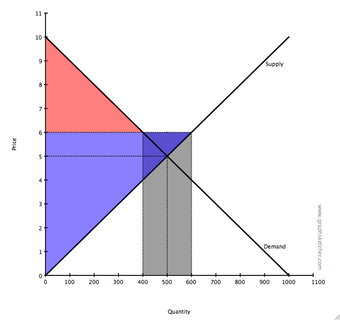
Consumer Surplus with Price Support
This graph is a complement to the first graph. It demonstrates the effect of implementing a price support on a basic supply and demand chart. The overall consumption will decrease as the government buys up consumer surplus. This demonstrates a price control on behalf of the government.
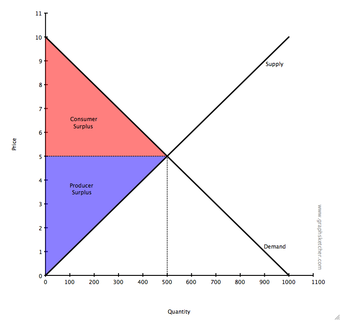
Consumer Surplus
This chart, in conjunction with the one below, illustrates the way in which price supports can alter supply and overall consumption. It demonstrates the consumer surplus and producer surplus opportunities on a basic supply and demand chart.
This can happen in reverse as well in the form of subsidies. Subsidies are the reduction of costs for producers, generally in the form of governmental grants provided to suppliers. In this scenario, prices are artificially reduced, allowing for an outward shift of the supply curve along the demand line, which creates a higher amount of consumption by consumers as a result of the reduced price. This is illustrated in , where the governmental subsidy allows for increased consumption power on behalf of the consumers in that market.
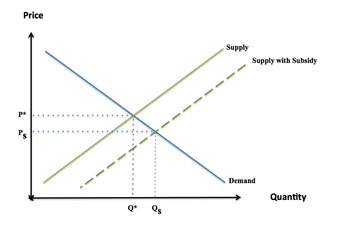
Subsidies and Supply
This chart shows how subsidies and price controls affect supply and demand. A subsidy, as illustrated here, will reduce the price and extend the overall supply demanded and consumed by individuals within the system. This is the most relevant chart to agricultural economics specifically.
Applying Price Supports to Agricultural Economics
The United States currently pays out around $20 billion annually to farmers and producers in agriculture in the form of subsidies via farm bills in order to artificially reduce prices and shift the supply curve outward to ensure the overall supply in the market is high enough to satisfy all prospective consumers. It is important to note how dramatically the recipients of farming subsidies have changed over time in the United States. In 1925, there were around 6,000,000 small farms of which 25% of the nation resided. By 1997, 72% of farm sales come from 157,000 large farms and only 2% of the U.S. population resides there. This is an interesting economic factor in farm subsidies, as these subsidies are largely going to corporations of substantial size, as opposed to small farmers.
The subsidies provide a price floor (or a minimum price in which farmers can be reimbursed for certain products). This is a significant economic policy of price control to ensure farmers have proper incentive and revenues to continue to produce at the level of goods desired by the U.S. government. Agricultural economics is a highly complicated market as a result of these price supports and controls, particularly from the perspective of subsidization and price control.
37.1.4: Supply Reduction
Agricultural aggregate supply can be reduced through external capacity potential or governmental interventions.
Learning Objective
Identify factors resulting in global reductions in agricultural supply levels.
Key Points
- Government policy has a large impact on the agriculture market, usually in the form of subsidies and price ceilings, by controlling the overall supply and demand equilibrium points in the market.
- Governments may reduce supply through utilizing quotas (limiting imports) or providing foreign aid (actively reducing domestic demand).
- Environmental concerns have also been widely cited as a reductive influence on the agriculture market. Global warming (increased average temperatures) has demonstrated a negative effect on overall plant yield for certain products.
- Other concerns reducing supply revolve around dramatic soil damage due to short-term yield increasing strategies, growing immunity to pesticides, loss of rural space for farming (due to urbanization), and availability of clean water for irrigation.
Key Terms
- Dumping
-
Selling goods at less than their normal price, especially in the export market as a means of securing a monopoly.
- Quotas
-
A restriction on the import of a good to a specific quantity.
Agricultural economics is largely bound by concepts of climate and overall world food producing capacity (i.e. farmlands and infrastructure), while simultaneously being enabled by government policy, technological advances, and the continued growth of developing nations. Understanding the reductions in aggregate supply in this industry, as a result of governmental policy or economic limits, is a critical component in understanding agricultural economics. We will look at both the governmental components and the climatic/aggregate demand components contributing to overall supply in this industry.
Governmental Policy
Government policy has a large impact on the agriculture market. Both subsidies and price ceilings are common and affect the overall supply and demand equilibrium points in the market. Governmental policy to reduce supply also exists and is executed often from a global trade perspective. One of the largest risks in this industry, due to the high degree of subsidization, is ‘dumping. ‘ Dumping is the process of selling undervalued goods in another market, upsetting price points and equilibrium. In this scenario, government policies may set quotas, or import limits, to reduce supply.
A second reduction in supply that is quite common in developed nations is utilizing surplus for foreign aid. Many developing nations lack the requisites to generate the appropriate supply of agriculture to feed the population. In this scenario, the leveraging of the surplus in one country can benefit the other country via aid, and in turn correct the supply/demand equilibrium in the donating country to the desired level.
Climate Change
Environmental concerns have also been widely cited as a reductive influence on the agriculture market. Global warming has been slowly increasing temperatures as the ozone layer erodes due to a variety of pollutants, altering the ecosystem averages outside of the evolutionary environment in which many agricultural products historically grew. Climate changes means a different growing environment for plants, which are not used to it. illustrates the reduction in yield as a result of altering climatic environments. Shifts in climate drastically reduce aggregate supply.
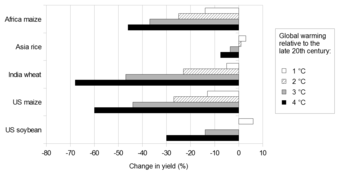
Climate Change Affecting Agriculture
This chart illustrates the reduction in yield as a result of altering climatic environments. Essentially, deviations outside of the normal temperature ranges drastically reduce aggregate supply.
Other concerns revolve around dramatic soil damage due to short-term yield increasing strategies, growing immunity to pesticides, loss of rural space for farming (due to urbanization), and availability of clean water for irrigation. All of these factors may reduce the aggregate supply and thus drive up prices. demonstrates rising food prices, perhaps from a number of the supply reduction factors discussed in this atom (or potentially unidentified factors). Controlling supply is a critical component of ensuring everyone has access to affordable food, and maintaining our ecosystem will clearly play a critical role in the years ahead.
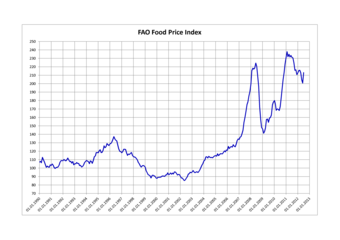
Food Price Increases Over Time
Food prices over time, particularly in recent years, are demonstrating a trend upwards that may reflect a reduction in overall efficiency of agricultural production or reductions in supply.
37.1.5: Evaluating Policies
Agriculture requires a vast support system and a great deal of oversight, addressing industry threats and utilizing policy-based tools.
Learning Objective
Evaluate the economics of agriculture policies.
Key Points
- The political frame of the agriculture market is complex, with a wide range of critical concerns that need to be addressed both domestically and internationally.
- Concerns to keep in mind revolve around the international markets, bio-security, infrastructure, technology, water, and resource allocation to enable effective agricultural markets.
- Governments can use import quotas, subsidies, price floors, price ceilings, and aid to control their domestic market supply, demand, and equilibrium price point.
- Combining the issues above with tools provided, the agricultural business can change dramatically as a result of the concerns and activities of the respective government in a given economy.
Key Terms
- infrastructure
-
The basic facilities, services, and installations needed for the functioning of a community or society.
- Biosecurity
-
The protection of plants and animals against harm from disease or from human exploitation.
The political frame of the agriculture market is hugely complex, with a wide range of critical concerns that need to be addressed both domestically and internationally. Agricultural policy differs from nation to nation, but has a number of key questions and considerations that occur across the board. The purpose of this atom is to outline the various trends in agricultural economic policy, and how these governmental policies can be evaluated for efficacy in their respective markets.
Policy Concerns
Agriculture requires a vast support system and a great deal of oversight, as the consumption of grown foods poses a huge safety threat alongside a critical need for the health and survival of a civilization. Below is a list of core questions to keep in mind when evaluating agricultural policy:
- Biosecurity: The ability of a country to consistently provide enough food for its citizens is a major concern. Pests and diseases are a significant threat to yield rates and must be closely observed and regulated.
- International Trading Environment: Global agricultural trade is a complex issue, with quality control, pricing (dumping), and import/export tariffs. The dangers of biosecurity, or lack thereof, in particular are quite stringent.
- Infrastructure: Transporting goods, irrigation facilities, land utilization, and a variety of other logistics concerns are required by the government to enable effective economic trade (domestically and internationally).
- Technology: This is a critical driving force in increasing yield and lowering costs in the agriculture business. Enabling technological progress is a critical investment and something governments must provide incentives for.
- Water:Access to clean, potable water is a basic necessity to which not everyone has access.Effective sewage systems for irrigation and effective water treatment for sanitation are a required input, and must be provided via governmental centralized infrastructure.
- Resource Access: Ensuring access to land and biodiversity is another important component to a successful agricultural industry. Protection of environmental land and the overall ecosystem is an important policy consideration.
Policy Tools
With the above concerns in mind, it is also useful to understand some of the tools leveraged by governments to enable this industry:
- Subsidies: The government can utilize subsidies to reduce price points and increase the overall supply within a system . The use of subsidies in developed nations has been a major point of international contention, since they may force developing nations out of the global agriculture market.
- Price Floors/Ceilings: Price floors provide a minimum price point for a given product while price ceilings create a maximum price point. These are used to ensure appropriate pricing in a given industry (see ), and are often used in agriculture to control price points.
- Import Quotas: Policy makers often implement quotas in agriculture to retain more control over prices and protect domestic incumbents. Quotas, like other forms of trade protection, benefit the local industry.
- Aid: When aggregate supply is too high in a home country or there is a crisis in another, governments can provide their surplus to nations in need of food. This is both a way to provide utilitarian value while reducing aggregate supply.
Combining the issues above with tools provided, the agricultural business can change dramatically as a result of the concerns and activities of the respective government in a given economy. This is useful in controlling food prices, reducing waste, enabling efficiency and avoiding biosecurity issues.
Chapter 36: Natural Resource Economics
36.1: Introduction to Natural Resource Economics
36.1.1: Types of Natural Resources
Natural resource economics focuses on the supply, demand, and allocation of the Earth’s natural resources.
Learning Objective
Analyze natural resource economics and explain the types of natural resources that exist.
Key Points
- Natural resource economics focuses on the supply, demand, and allocation of the Earth’s natural resources.
- Every man-made product in an economy is composed of natural resources to some degree.
- Natural resources can be classified as potential, actual, reserve, or stock resources based on their stage of development.
- Natural resources are either renewable or non-renewable depending on whether or not they replenish naturally.
- Natural resource utilization is regulated through the use of taxes and permits. The government and individual states determine how resources must be used and they monitor the availability and status of the resources.
Key Terms
- Renewable
-
Sustainable; able to be regrown or renewed; having an ongoing or continuous source of supply; not finite.
- natural resource
-
Any source of wealth that occurs naturally, especially minerals, fossil fuels, timber, etc.
- depletion
-
The consumption of a resource faster than it can be replenished.
Natural Resource Economics
Natural resource economics focuses on the supply, demand, and allocation of the Earth’s natural resources. It’s goal is to gain a better understanding of the role of natural resources in the economy. Learning about the role of natural resources allows for the development of more sustainable methods to manage resources and make sure that they are maintained for future generations.The goal of natural resource economics is to develop an efficient economy that is sustainable in the long-run .

Importance of the Environment
This diagram illustrates how society and the economy are subsets of the environment. It is not possible for societal and economic systems to exist independently from the environment. For this reason, natural resource economics focuses on understanding the role of natural resources in the economy in order to develop a sufficient and sustainable economy that protects natural resources.
Types of Natural Resources
Natural resources are derived from the environment. Some of the resources are essential to survival, while others merely satisfy societal wants. Every man-made product in an economy is composed of natural resources to some degree.
There are numerous ways to classify the types of natural resources, they include the source of origin, the state of development, and the renewability of the resources.
In terms of the source of origin, natural resources can be divided into the following types:
- Biotic: these resources come from living and organic material, such as forests and animals, and include the materials that can be obtained them. Biotic natural resources also include fossil fuels such as coal and petroleum which are formed from organic matter that has decayed.
- Abiotic: these resources come from non-living and non-organic material. Examples of these resources include land, fresh water, air, and heavy metals (gold, iron, copper, silver, etc.).
Natural resources can also be categorized based on their stage of development including:
- Potential resources: these are resources that exist in a region and may be used in the future. For example, if a country has petroleum in sedimentary rocks, it is a potential resource until it is actually drilled out of the rock and put to use.
- Actual resources: these are resources that have been surveyed, their quantity and quality has been determined, and they are currently being used. The development of actual resources is dependent on technology.
- Reserve resources: this is the part of an actual resource that can be developed profitably in the future.
- Stock resources: these are resources that have been surveyed, but cannot be used due a lack of technology. An example of a stock resource is hydrogen.
Natural resources are also classified based on their renewability:
- Renewable natural resources: these are resources that can be replenished. Examples of renewable resources include sunlight, air, and wind . They are available continuously and their quantity is not noticeably affected by human consumption. However, renewable resources do not have a rapid recovery rate and are susceptible to depletion if they are overused.
- Non-renewable natural resources: these resources form extremely slow and do not naturally form in the environment. A resource is considered to be non-renewable when their rate of consumption exceeds the rate of recovery. Examples of non-renewable natural resources are minerals and fossil fuels.
There is constant worldwide debate regarding the allocation of natural resources. The discussions are centered around the issues of increased scarcity (resource depletion) and the exportation of natural resources as a basis for many economies (especially developed nations). The vast majority of natural resources are exhaustible which means they are available in a limited quantity and can be used up if they are not managed correctly. Natural resource economics aims to study resources in order to prevent depletion.
Natural resource utilization is regulated through the use of taxes and permits. The government and individual states determine how resources must be used and they monitor the availability and status of the resources. An example of natural resource protection is the Clean Air Act. The act was designed in 1963 to control air pollution on a national level. Regulations were established to protect the public from airborne contaminants that are hazardous to human health. The act has been revised over the years to continue to protect the quality of the air and health of the public in the United States.

Wind
Wind is an example of a renewable natural resource. It occurs naturally in the environment and has the ability to replenish itself. It has also been used as a form of energy development through wind turbines.
36.1.2: Basic Economics of Natural Resources
Natural resource economics focuses on the supply, demand, and allocation of the Earth’s natural resources to create a more efficient economy.
Learning Objective
Explain basic natural resource economics
Key Points
- As a field of academic research, natural resource economics addresses the connections and interdependence between human economies and natural ecosystems.
- By studying natural resources, economists learn how to develop more sustainable methods of managing resources to ensure that they are maintained for future generations.
- Natural resource economics is studied on an academic level, and the findings are used to shape and direct policy-making for environmental issues. These issues include resource extraction, depletion, protection, and management.
- Natural resource economics findings impact policies for environmental work including issues such as extraction, depletion, protection, and management.
Key Terms
- natural resource
-
Any source of wealth that occurs naturally, especially minerals, fossil fuels, timber, etc.
- sustainable
-
Able to be sustained for an indefinite period without damaging the environment, or without depleting a resource.
Natural Resource Economics
Natural resource economics focuses on the supply, demand, and allocation of the Earth’s natural resources. The main objective of natural resource economics is to gain a better understanding of the role of natural resources in the economy. By studying natural resources, economists learn how to develop more sustainable methods of managing resources to ensure that they are maintained for future generations. Economists study how economic and natural systems interact in order to develop an efficient economy.
As a field of academic research, natural resource economics addresses the connections and interdependence between human economies and natural ecosystems. The focus is how to operate an economy within the ecological constraints of the earth’s natural resources .

Natural Resource Economics
This diagram illustrates that society and the economy are subsets of the environment. It is not possible for social and economic systems to exist independently from the environment. Natural resource economics focuses on the demand, supply, and allocation of natural resources to increase sustainability.
Areas of Study
Economists study the commercial and recreational use and exploitation of resources. Traditionally, natural resource economics focused on fishery, forestry, and mineral models. However, in recent years many more topics have become increasingly important, including air, water, and the global climate. Natural resource economics is studied on an academic level, and the findings are used to shape and direct policy-making for environmental issues.
Examples of areas of study in natural resource economics include:
- welfare theory
- pollution control
- resource exhaustibility
- environmental management
- resource extraction
- non-market valuation
- environmental policy
Additionally, research topics of natural resource economists can include topics such as the environmental impacts of agriculture, transportation and urbanization, land use in poor and industrialized countries, international trade and the environment, and climate change.
Impact of Natural Resource Economics
The findings of natural resource economists are used by governments and organizations to better understand how to efficiently use and sustain natural resources. The findings are used to gain insight into the following environmental areas:
- Extraction: the process of withdrawing resources from nature. Extractive industries are a basis for the primary sector of the economy. The extraction of natural resources substantially increases a country’s wealth. Economists study extraction rates to make sure that resources are not depleted. Also, if resources are extracted too quickly, the sudden inflow of money can cause inflation. Economists seek to maintain a sense of balance within extraction industries.
- Depletion: the using up of natural resources, which is considered to be a global sustainable development issue. Many governments and organizations have become increasingly involved in preserving natural resources. Economists provide data to determine how to balance the needs of societies now and preserve resources for the future.
- Protection: the preservation of natural resources for the future. The findings of economists help governments and organization develop measures of protection to sustain natural resources. Protection policies state the necessary actions internationally, nationally, and individually that must take place to control natural resource depletion that is a result of human activity.
- Management: the use of natural resources taking into account economic, environmental, and social concerns. This process deals with managing natural resources such as land, water, soil, plants, and animals. Particular focus is placed on how the preservation of natural resources impacts the quality of life now and for future generations.
36.1.3: Externalities and Impacts on Resource Allocation
Production and use of resources can have a positive or negative effect on the allocation of the natural resources.
Learning Objective
Examine externalities and how they the impact resource allocation of natural resources.
Key Points
- An externality is a cost or benefit that affects a party who did not choose to incur the cost or benefit.
- A negative externality, also called the external cost, imposes a negative effect on a third party.
- When external costs are present, the market equilibrium use of natural resources is inefficient because the social benefit is less than the social cost. In other words, society would have been better off if fewer natural resources had been used.
- Positive externalities, also referred to as external benefits, imposes a positive effect on a third party.
- Assuming that natural resources are used and also sustained, the external benefits of goods produced by natural resources impacts the majority of the public in a positive way.
Key Term
- externality
-
An impact, positive or negative, on any party not involved in a given economic transaction or act.
Resource Allocation
Resource allocation is division of goods for the use of production within the economy. The needs and wants of society as well as industries impact what is produced. Suppliers focus on producing the varieties of goods and services that will yield the greatest satisfaction to consumers. In the long run, externalities directly impact resource allocation. It must be determined whether the production, as well as the process of production, creates more benefits that costs for the producers, consumers, and society as a whole.
Externalities
An externality is a cost or benefit that affects a party who did not choose to incur the cost or benefit. In regards to natural resources, production and use of resources can have a positive or negative effect on the allocation of the resources.
External Costs
A negative externality, also called the external cost, imposes a negative effect on a third party to an economic transaction. Many negative externalities impact natural resources negatively because of the environmental consequences of production and use. For example, air pollution from factories and vehicles can cause damage to crops . Likewise, water pollution has a negative impact of plants and animals.

Negative externality
Air pollution from vehicles is an example of a negative externality. It affects other than those who drive the vehicle and those who sell the gas.
In the case of negative externalities, the marginal private cost of consuming a good is less than the marginal social or public cost. The marginal social benefit should equal the marginal social cost (i.e. production should only be increased when the marginal social benefit exceeds the marginal social cost). When external costs are present, the use of natural resources is inefficient because the social benefit is less than the social cost. In other words, society and the natural resources involved would have been better off if the natural resources had not been used at all.
Developed countries use more natural resources and must enact sustainable development plan for the use of resources. Human needs must be met, but the environment and natural resources must be preserved. Examples of resource depletion include mining, petroleum extraction, fishing, forestry, and agriculture.
External Benefits
Positive externalities, also referred to as external benefits, impose a positive effect on a third party. An example of a positive externality is when crops are pollinated by bees from a neighboring bee farm. In order to achieve the socially optimal equilibrium, the marginal social benefit should equal the marginal social cost (i.e. production should be increased as long as the marginal social benefit exceeds the marginal social cost). Assuming that natural resources are used and also sustained, the external benefits of goods produced by natural resources impacts the majority of the public in a positive way.
